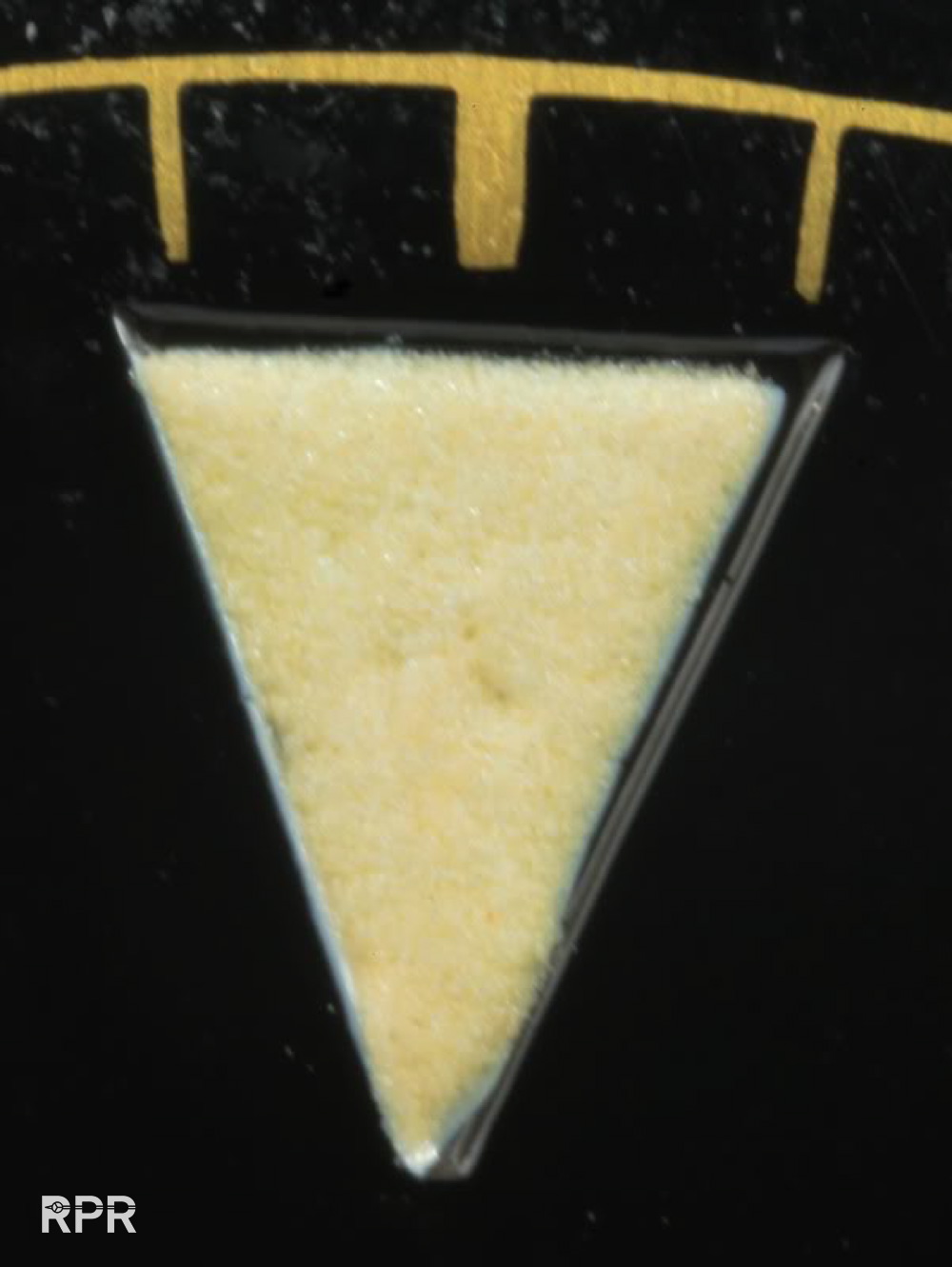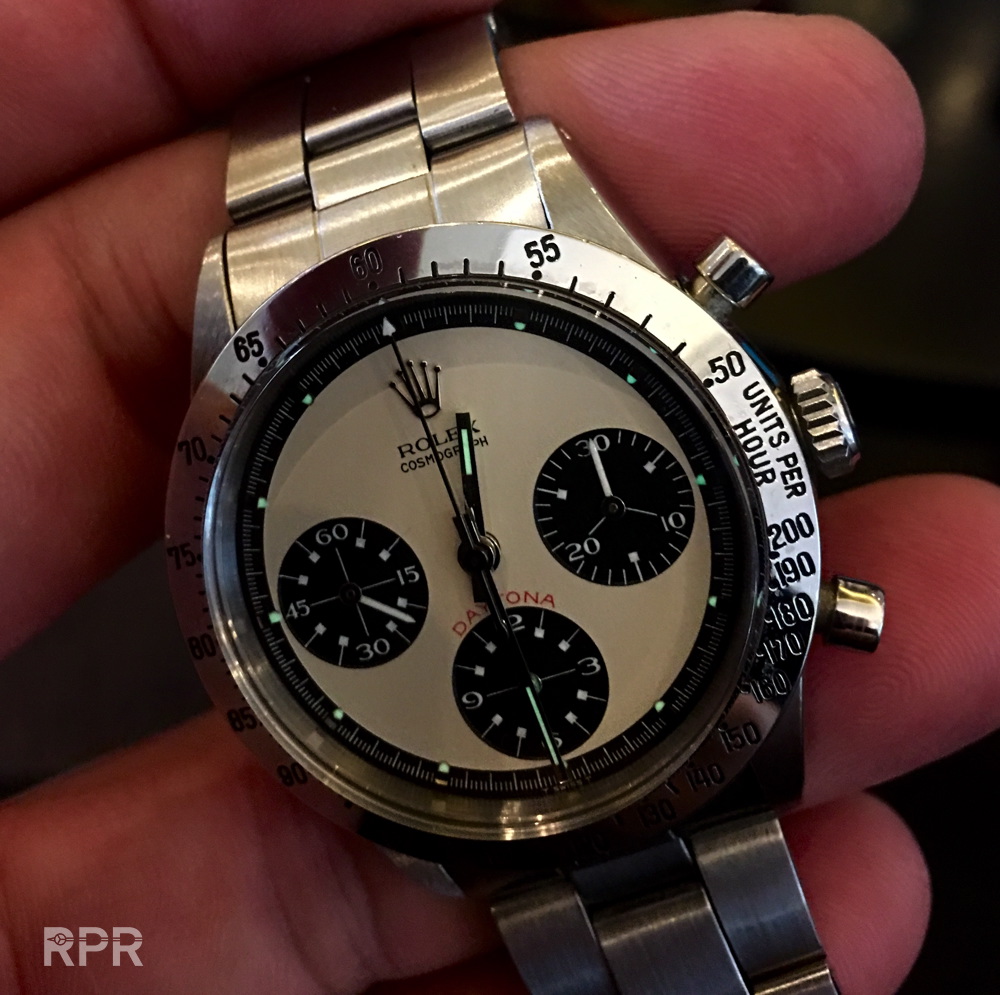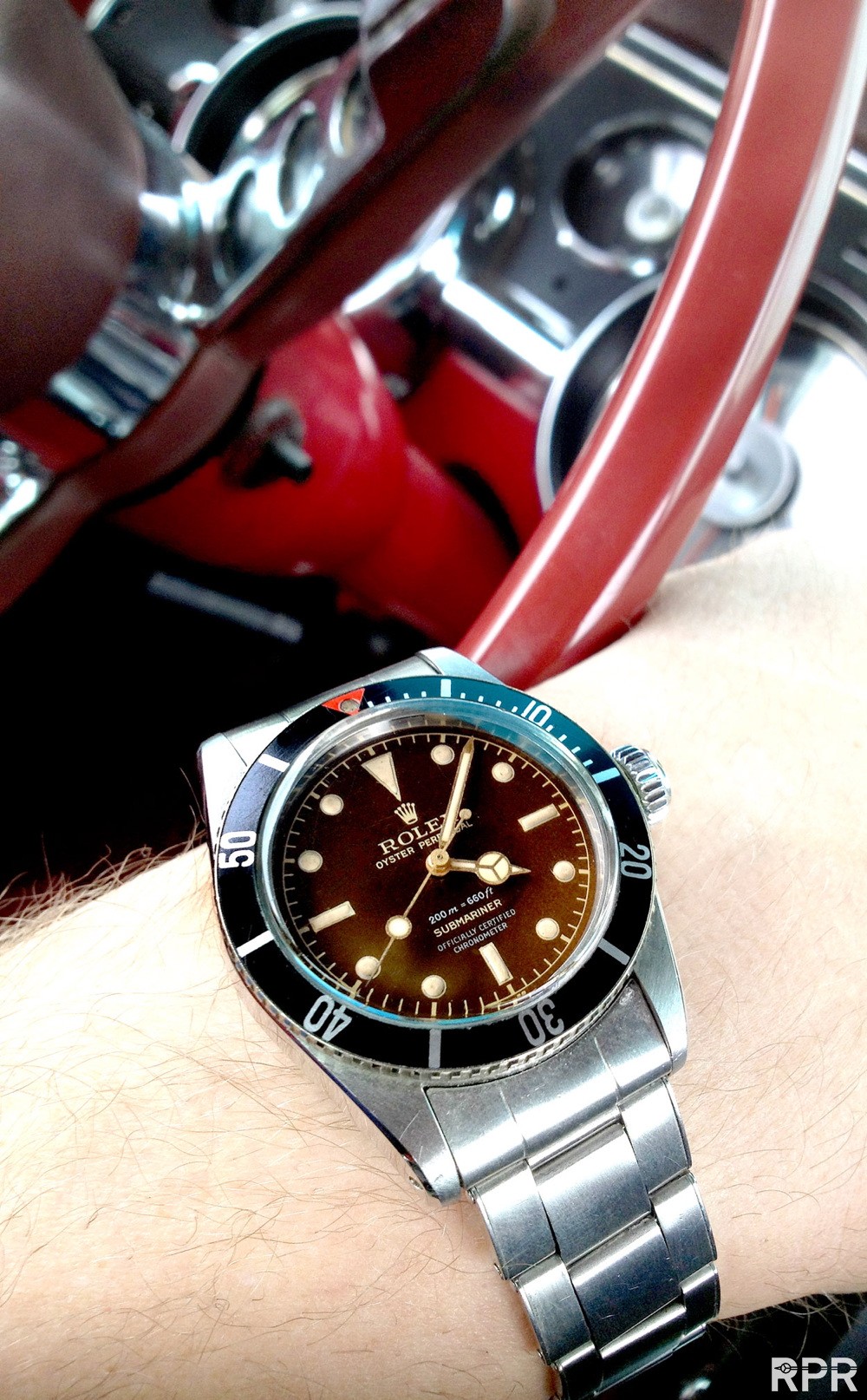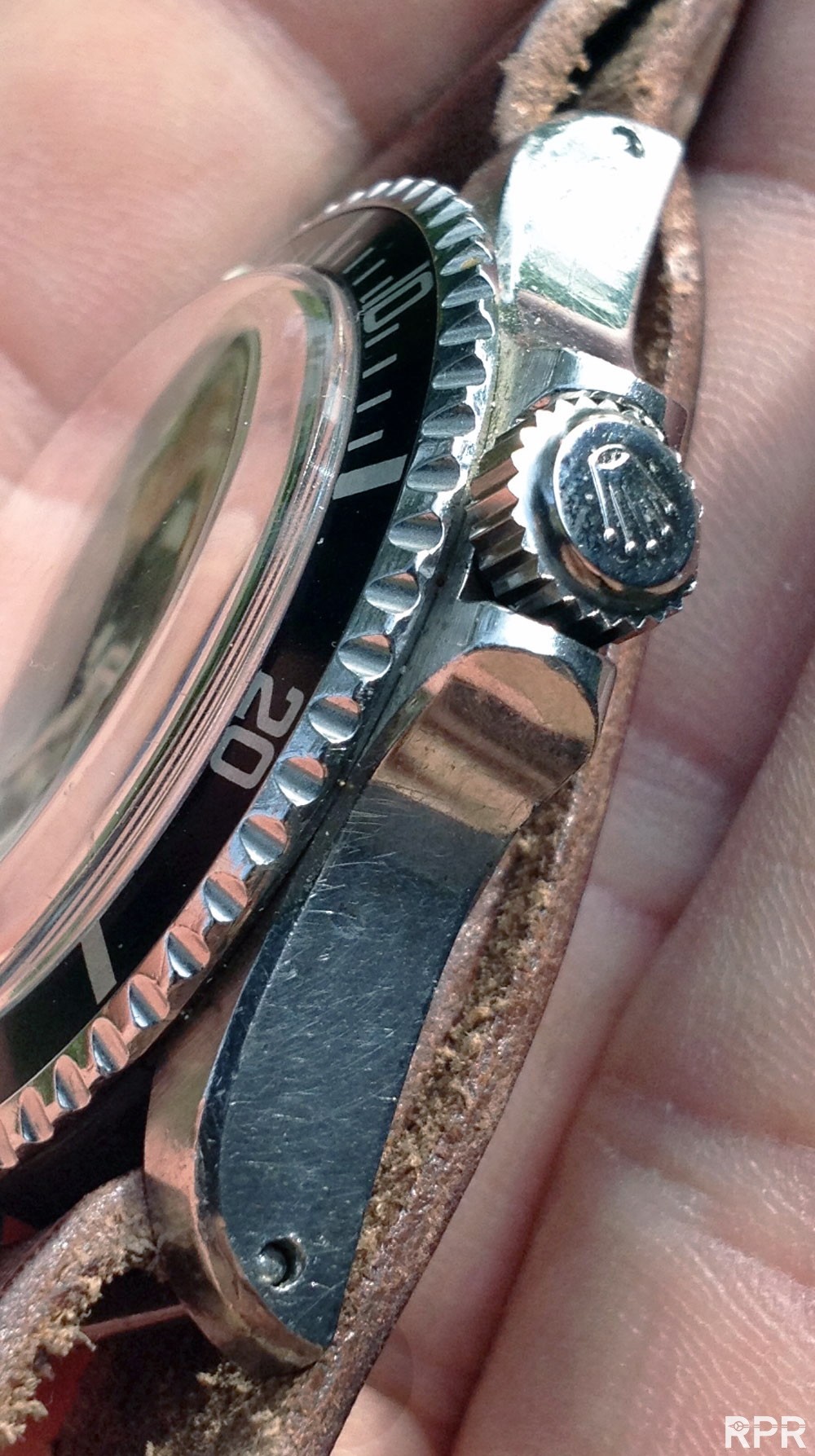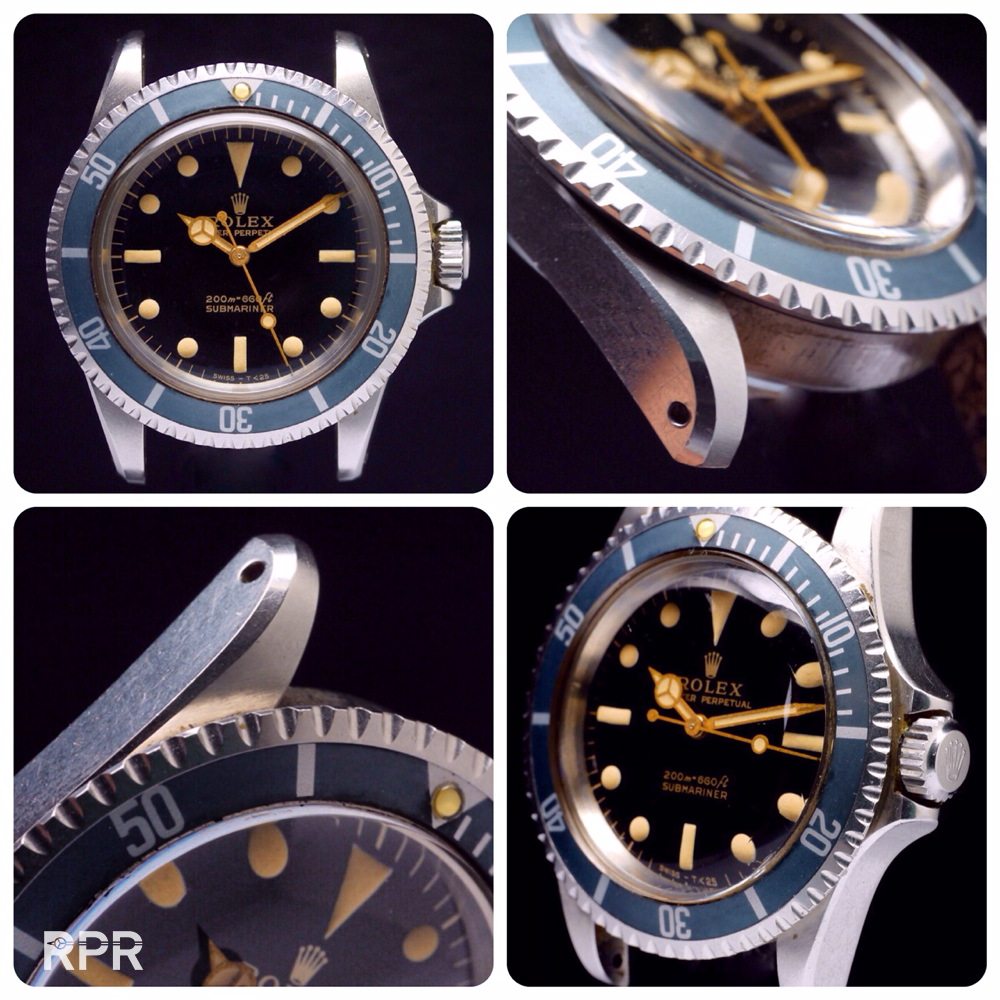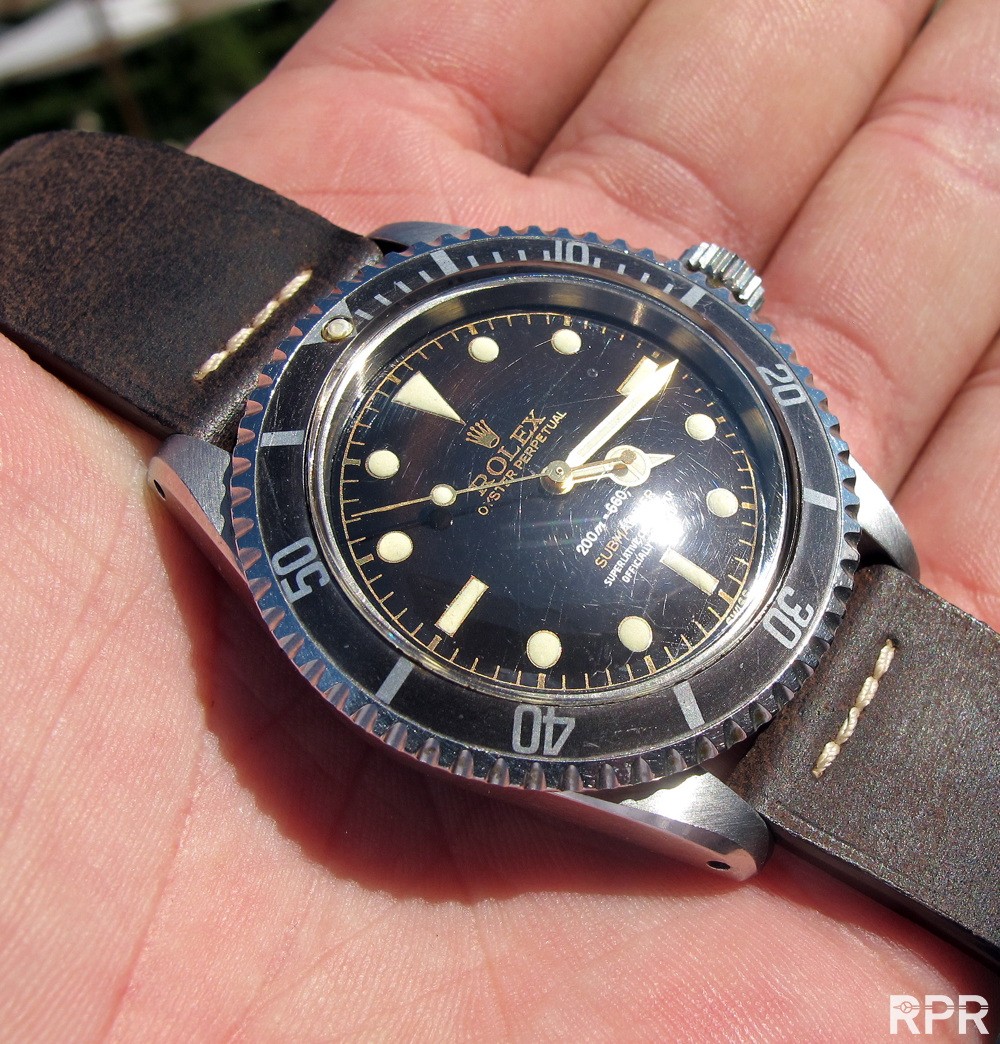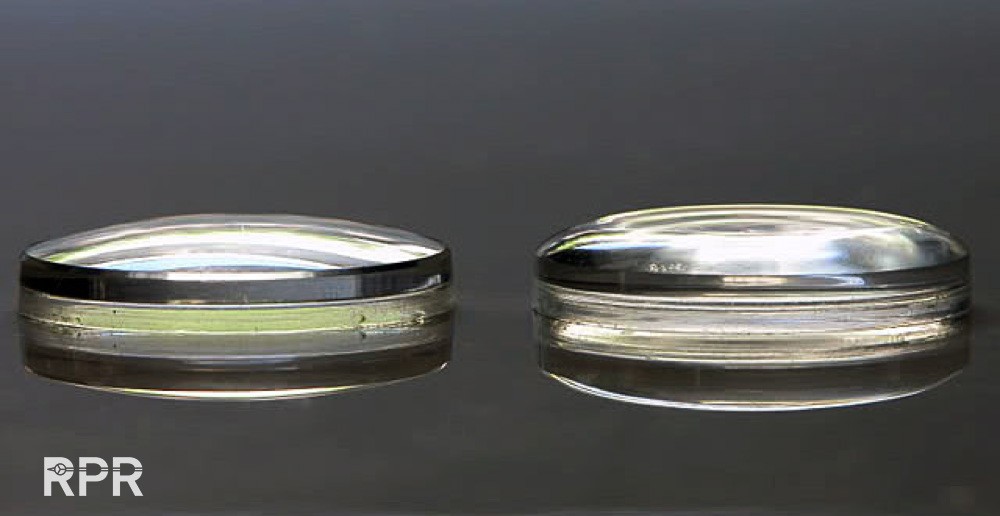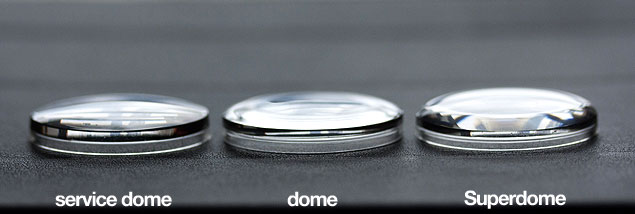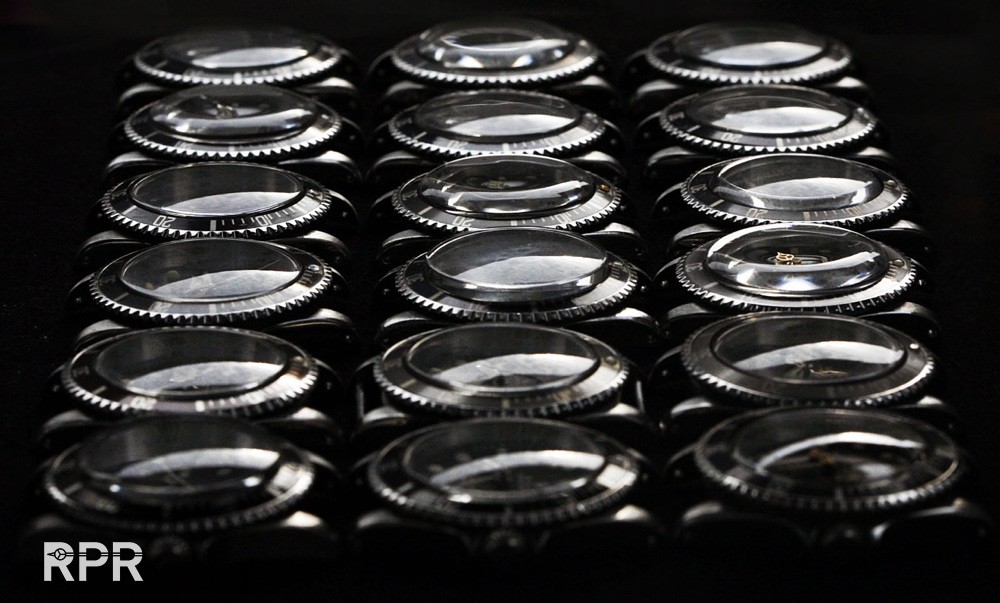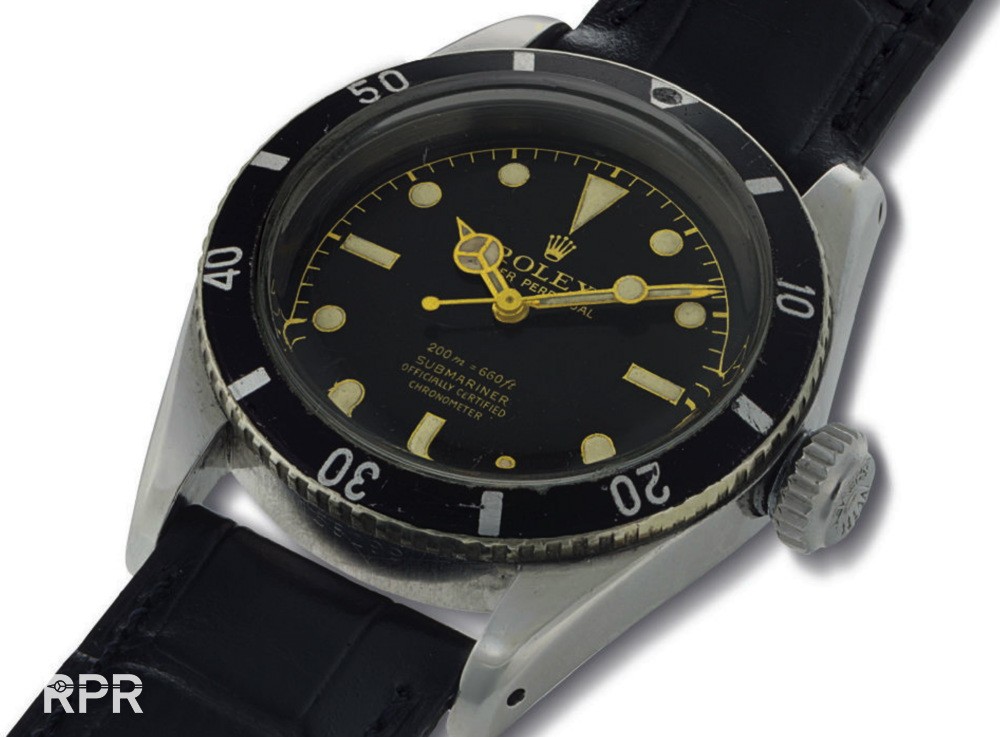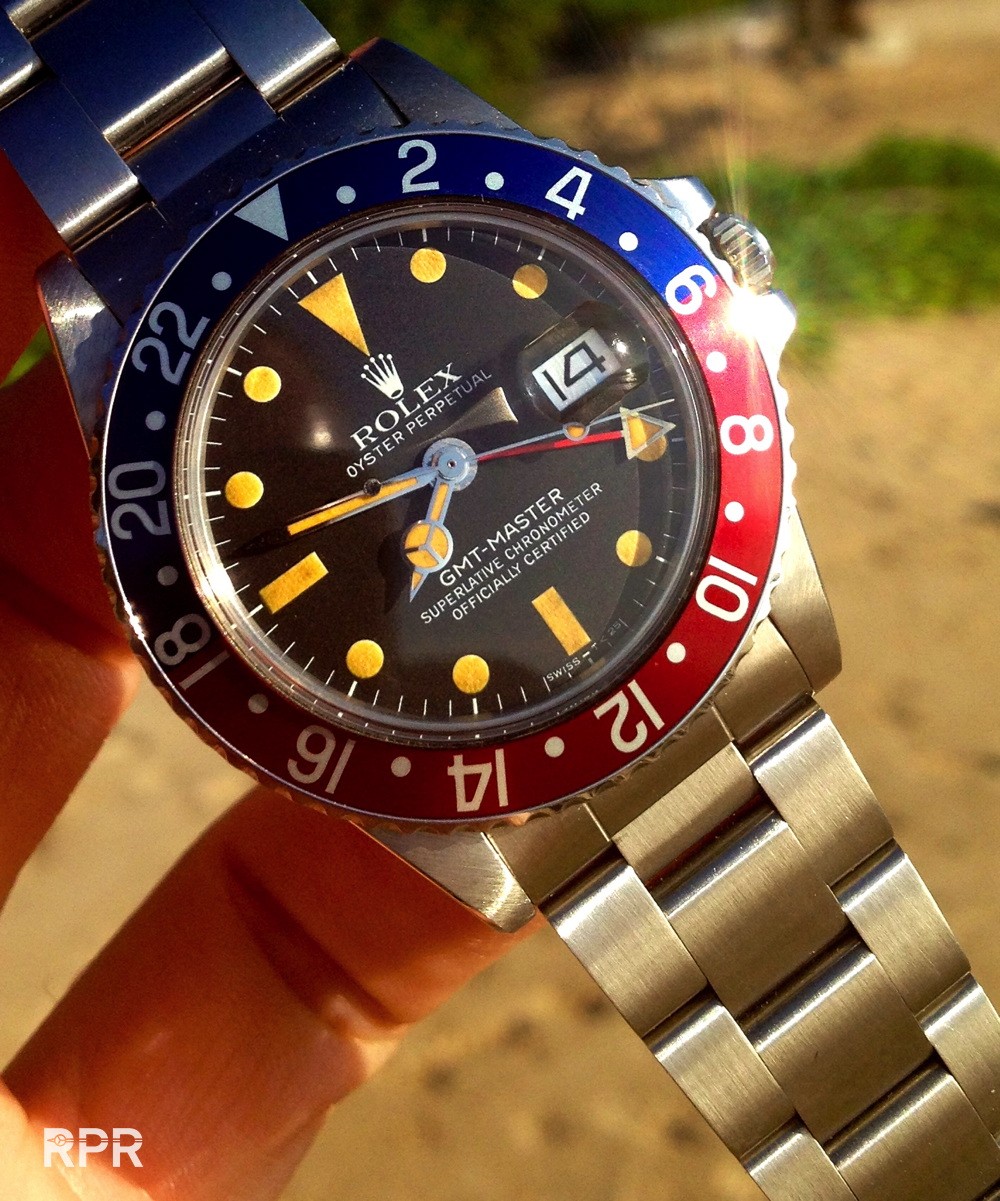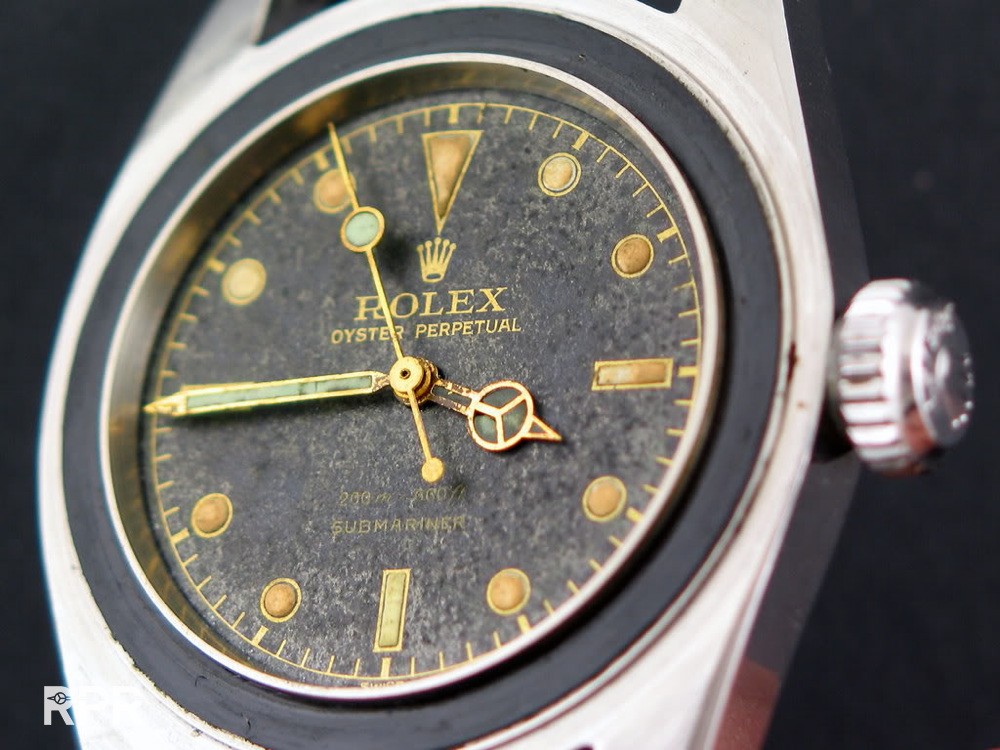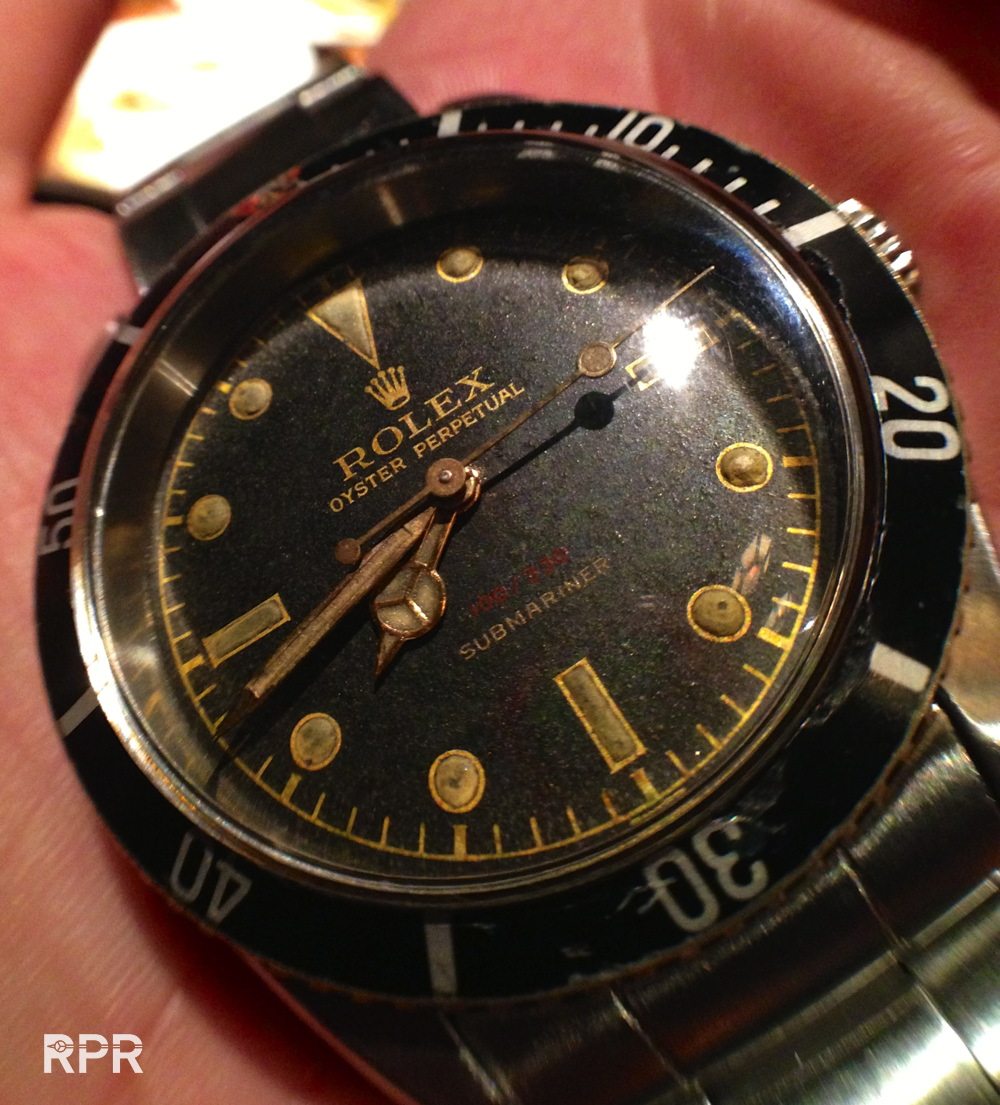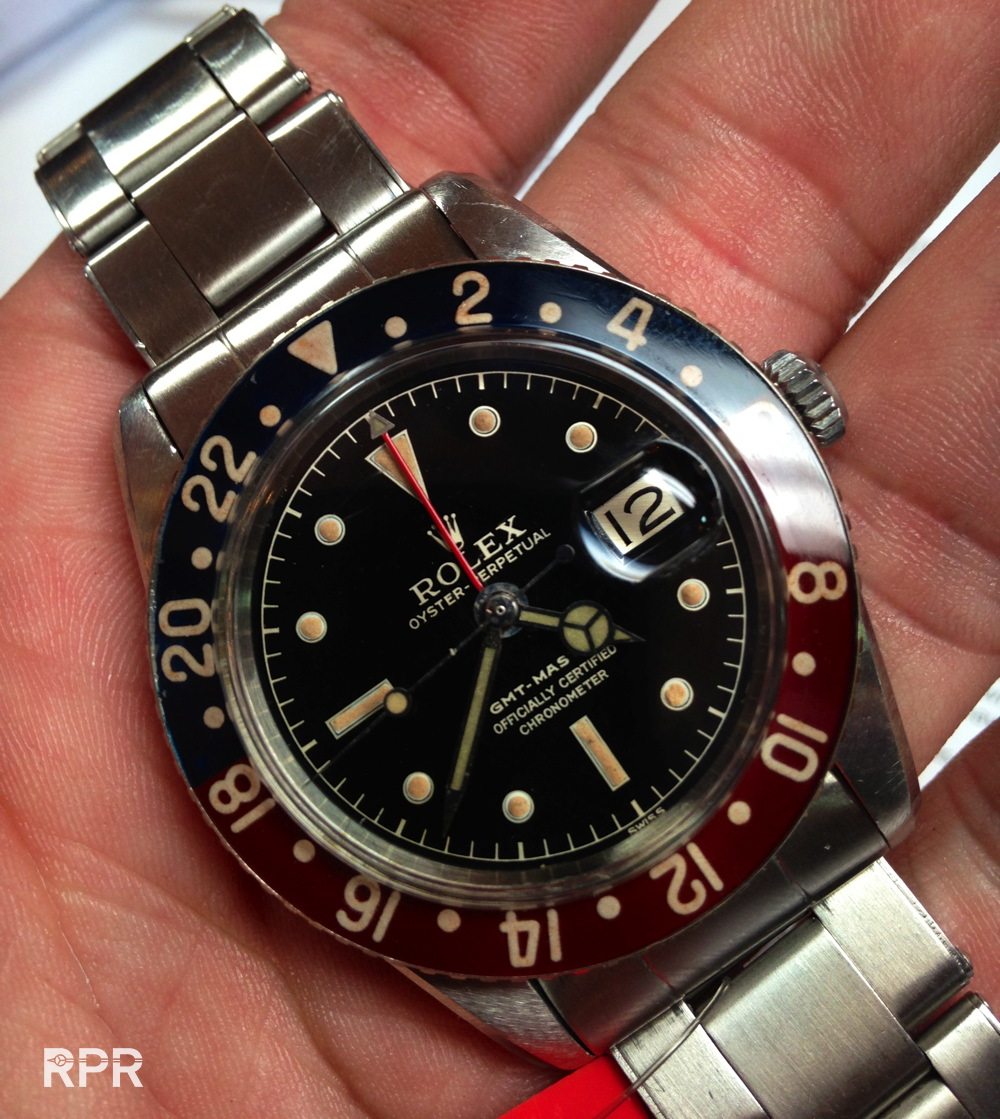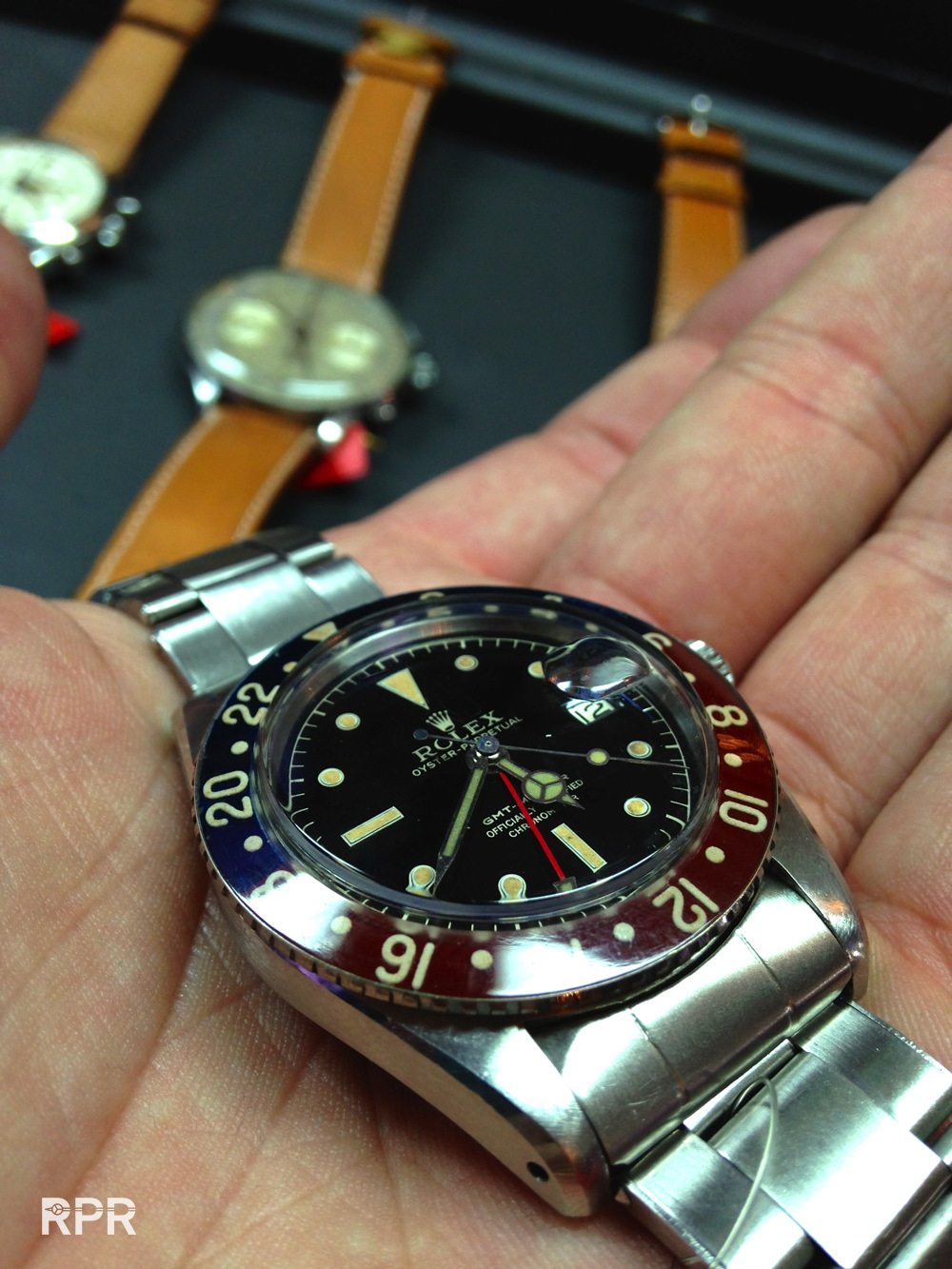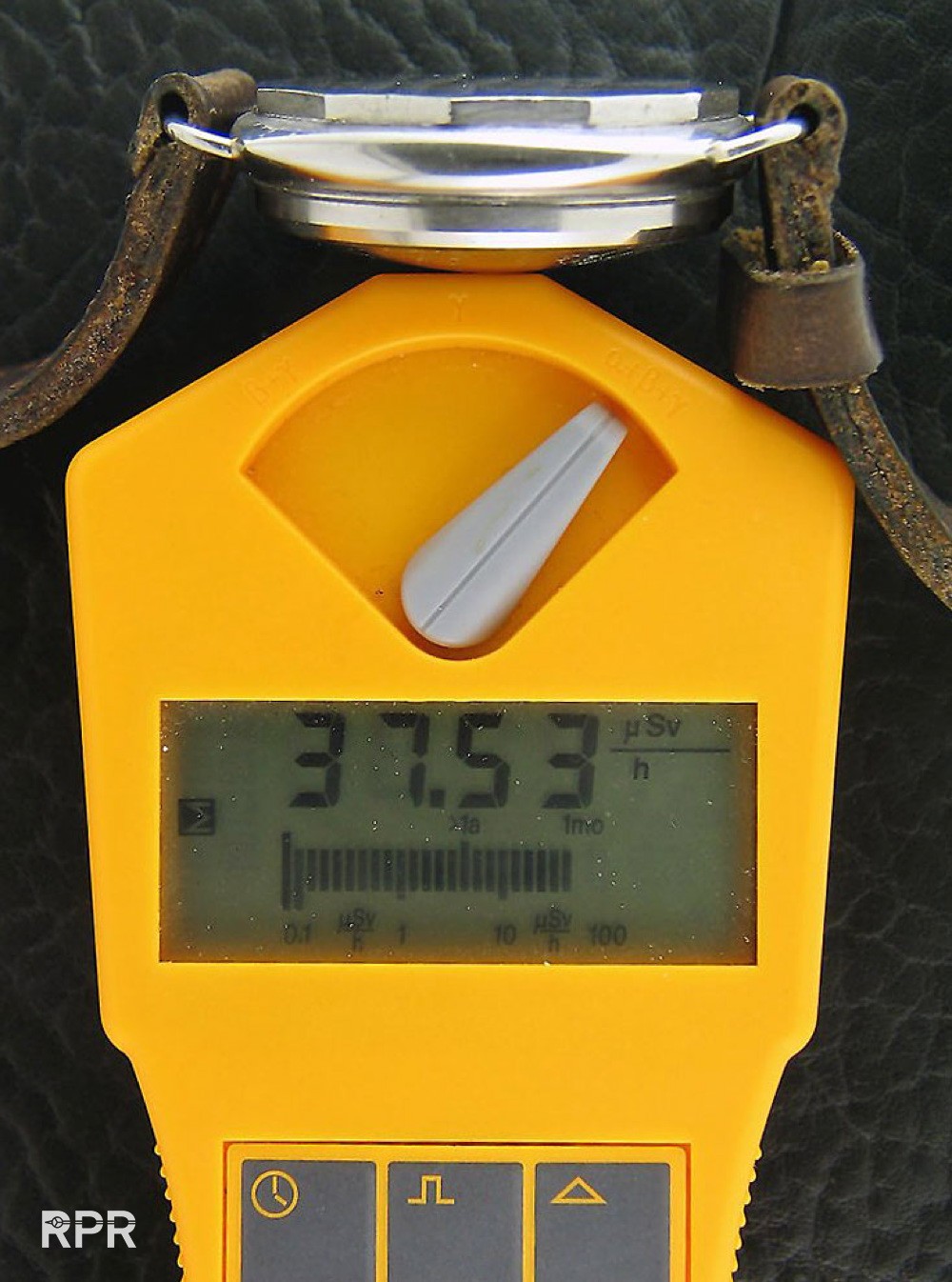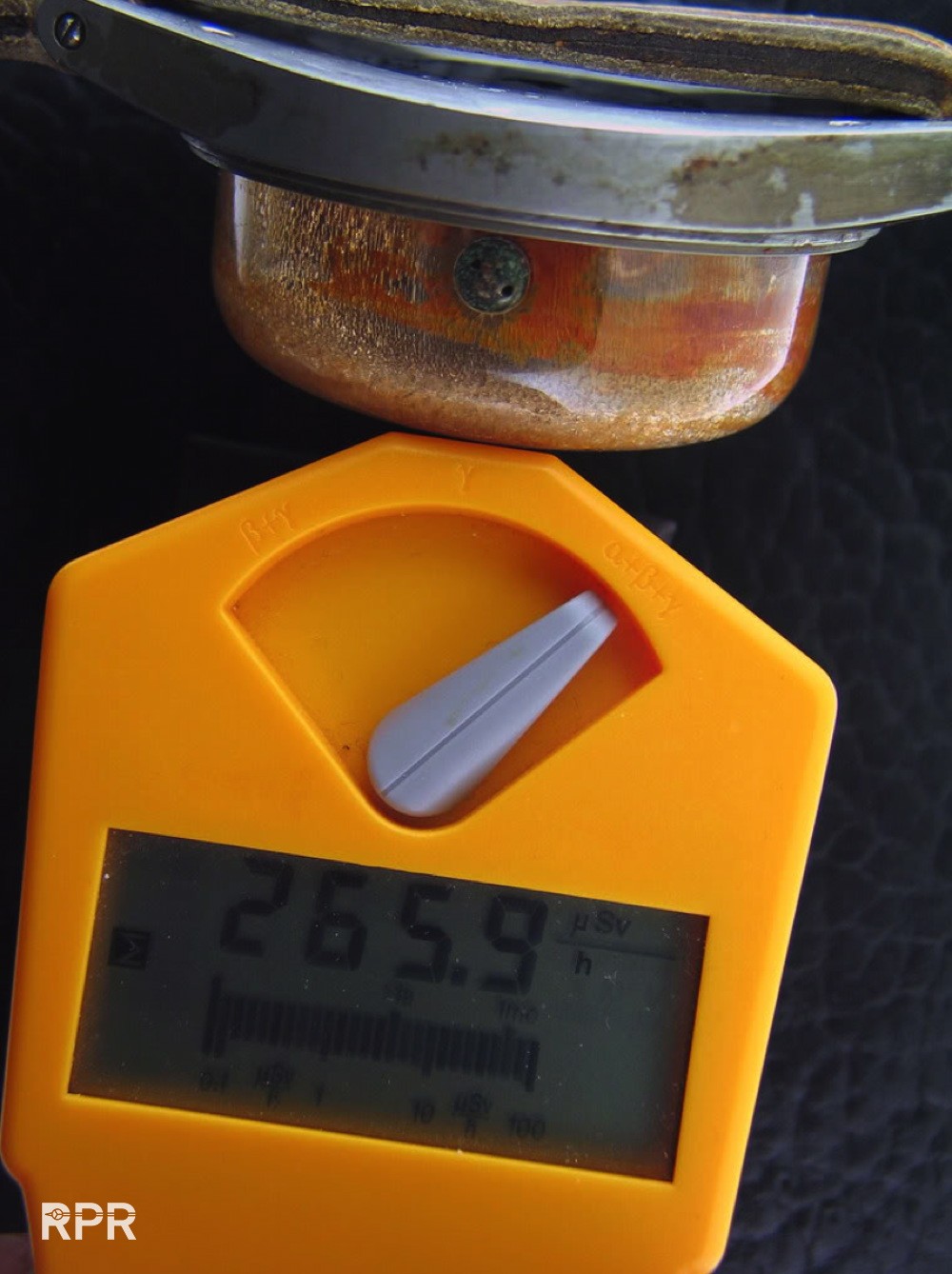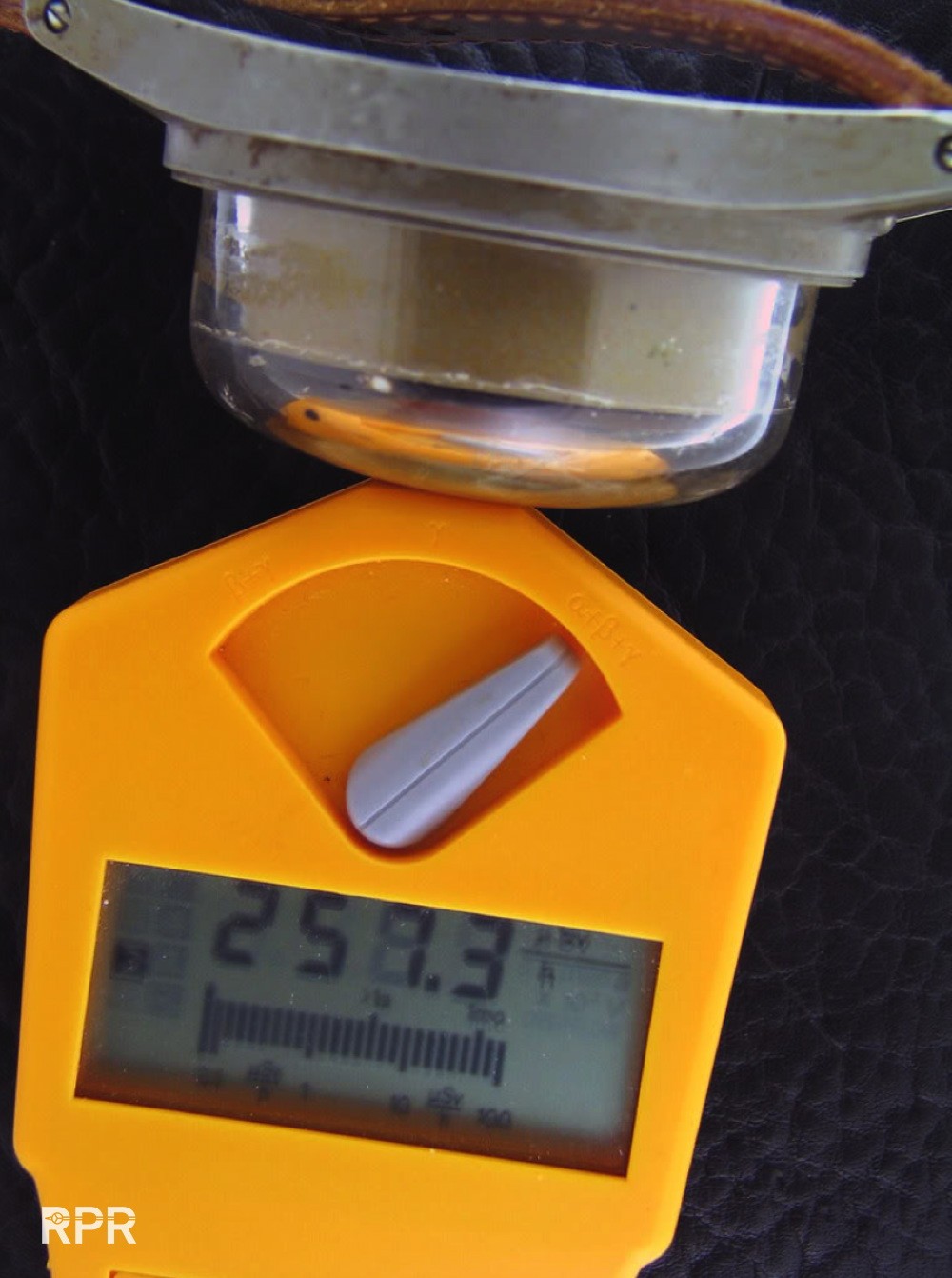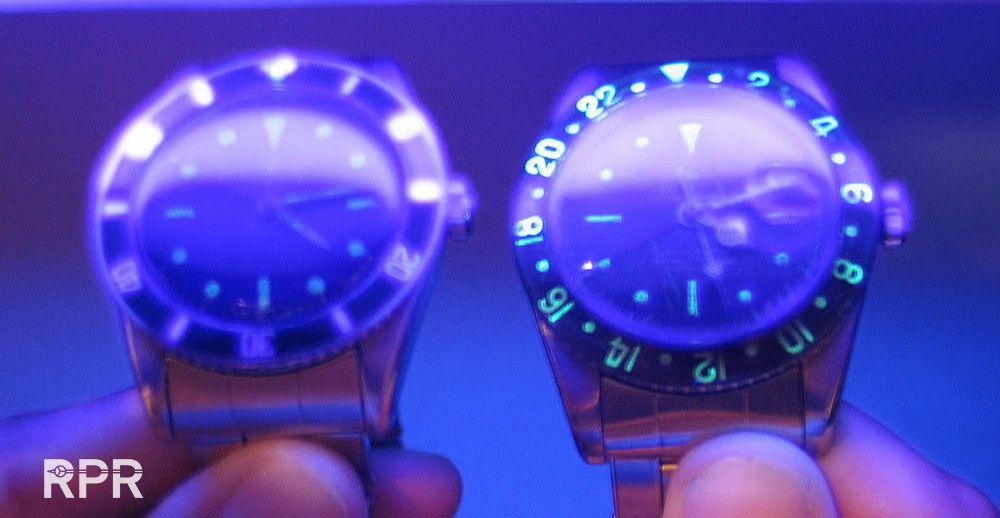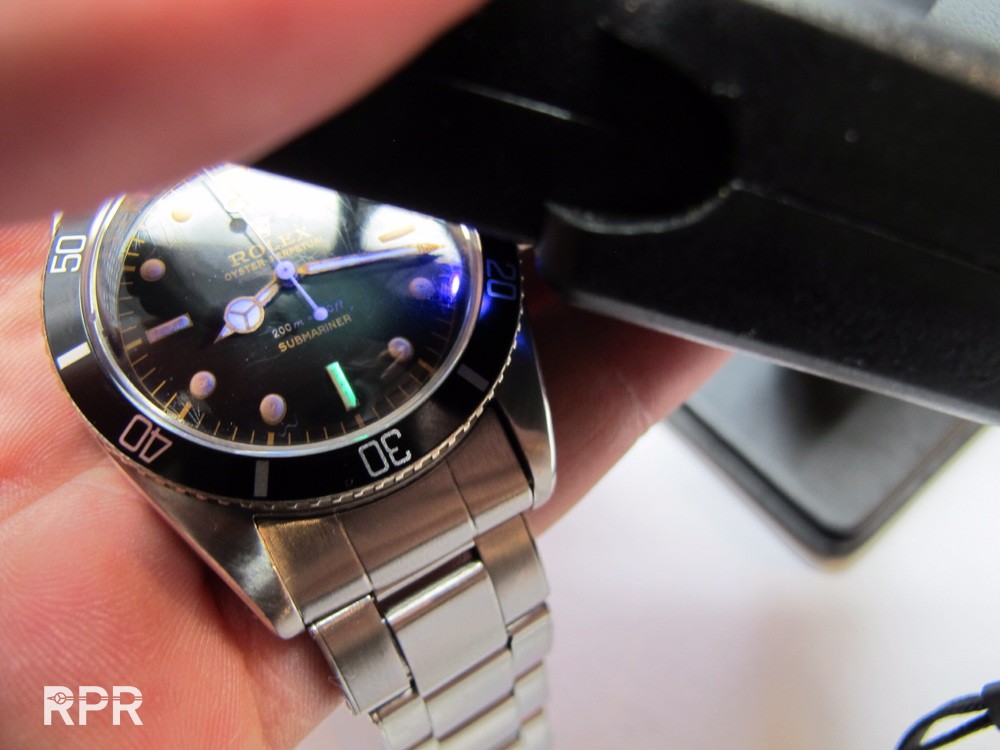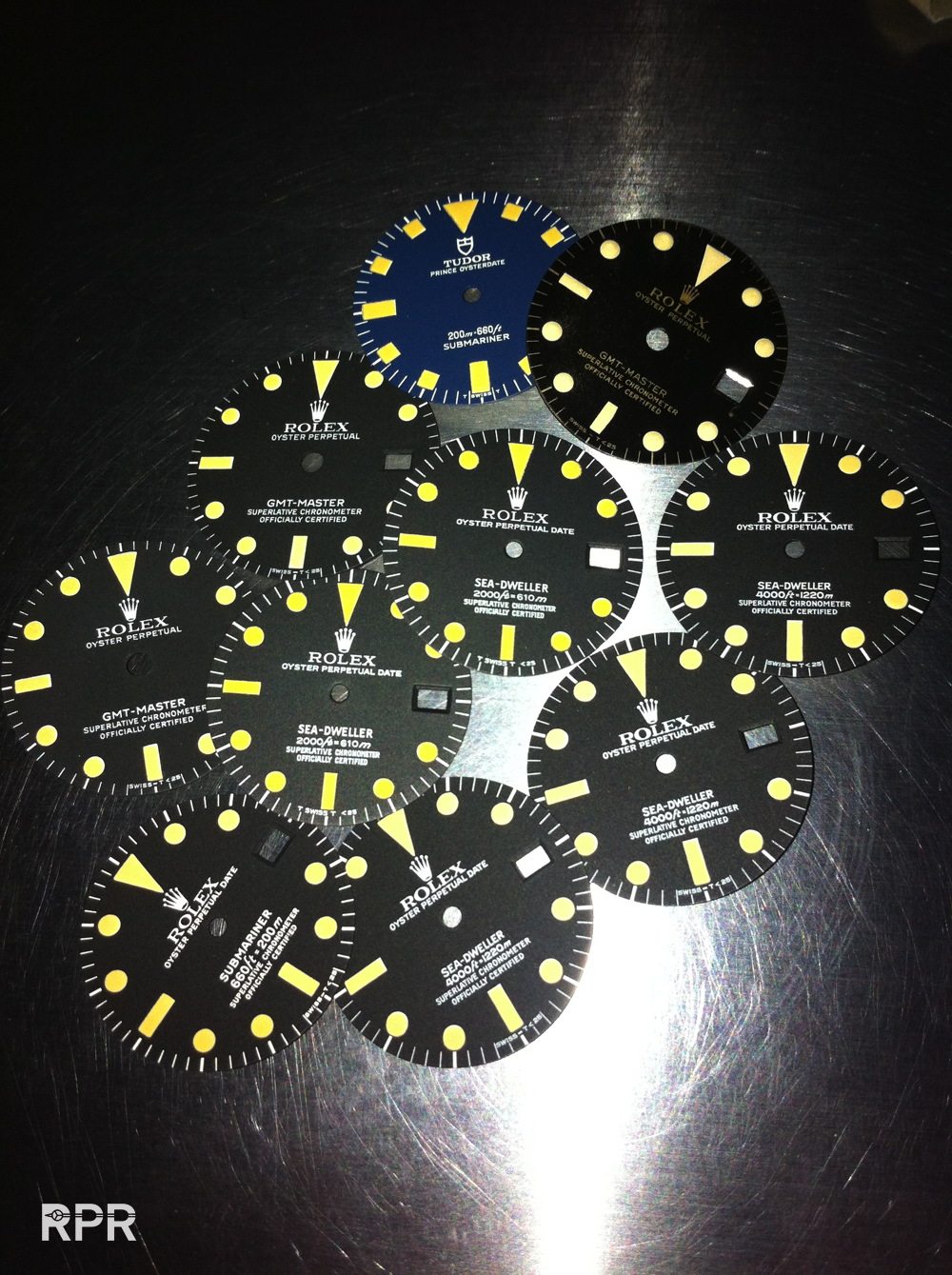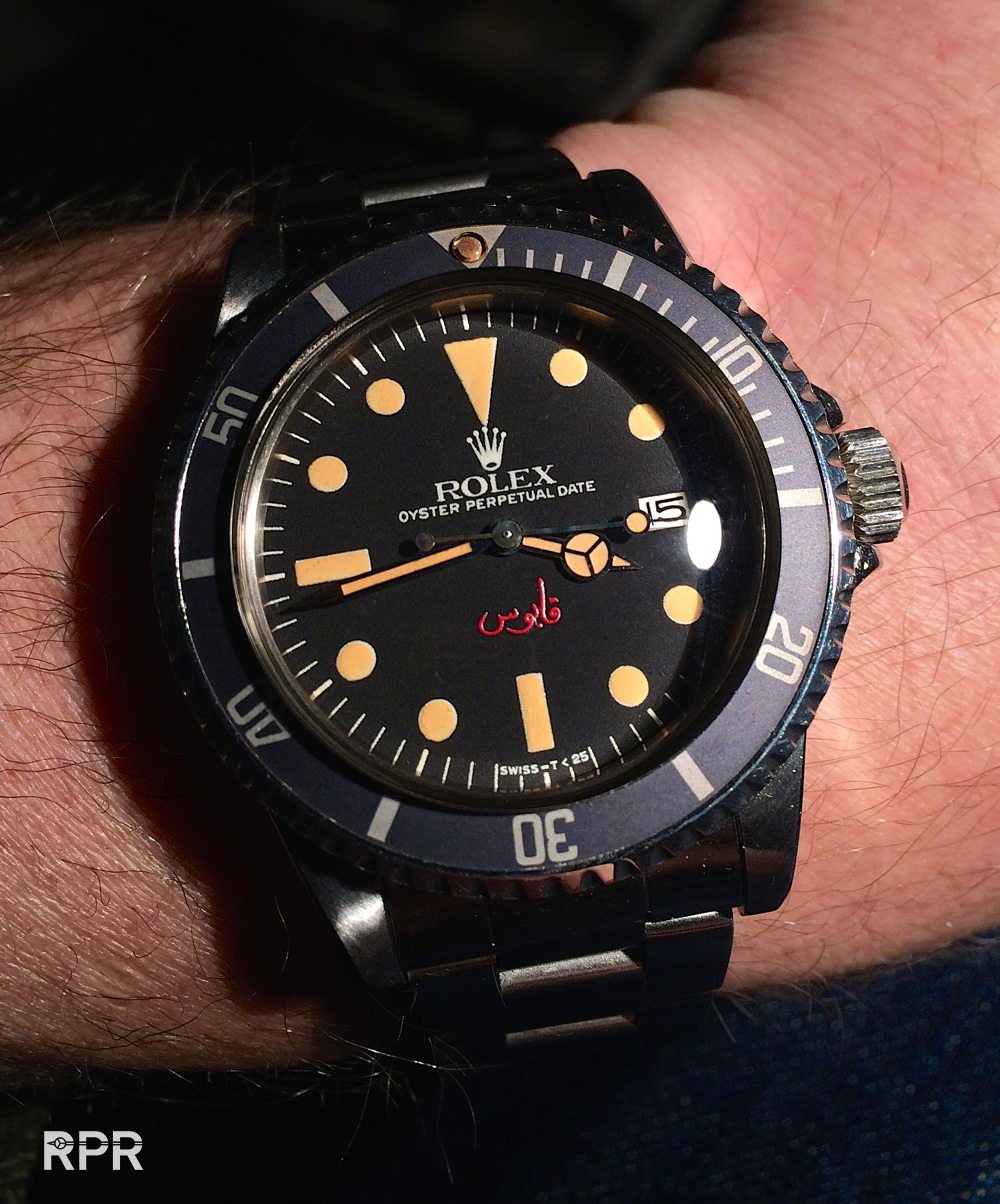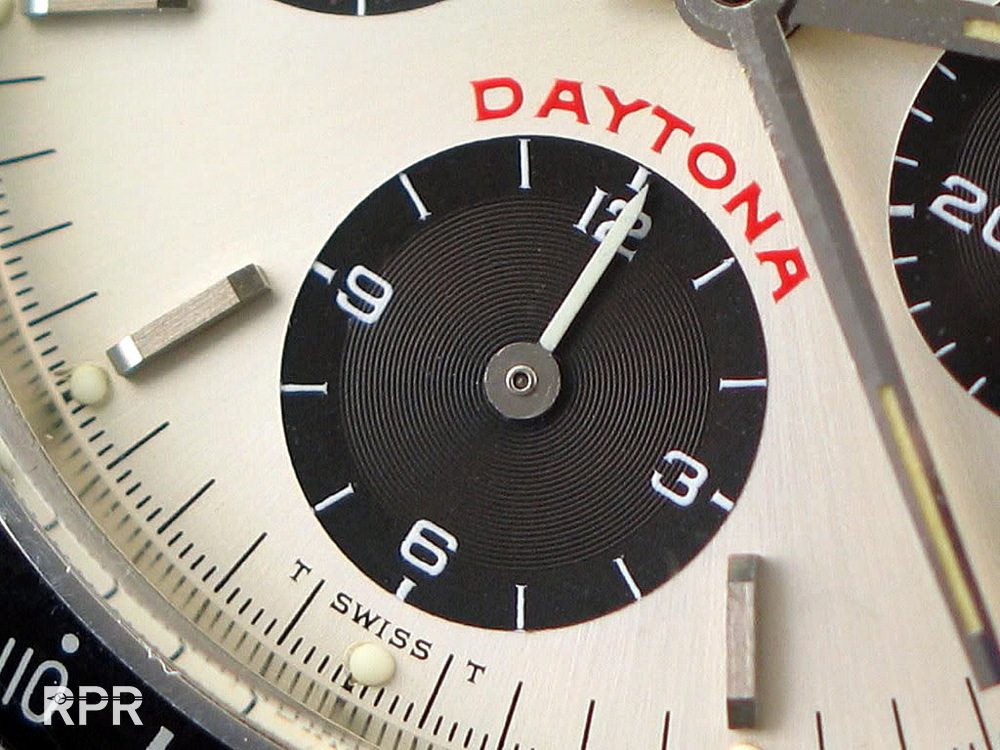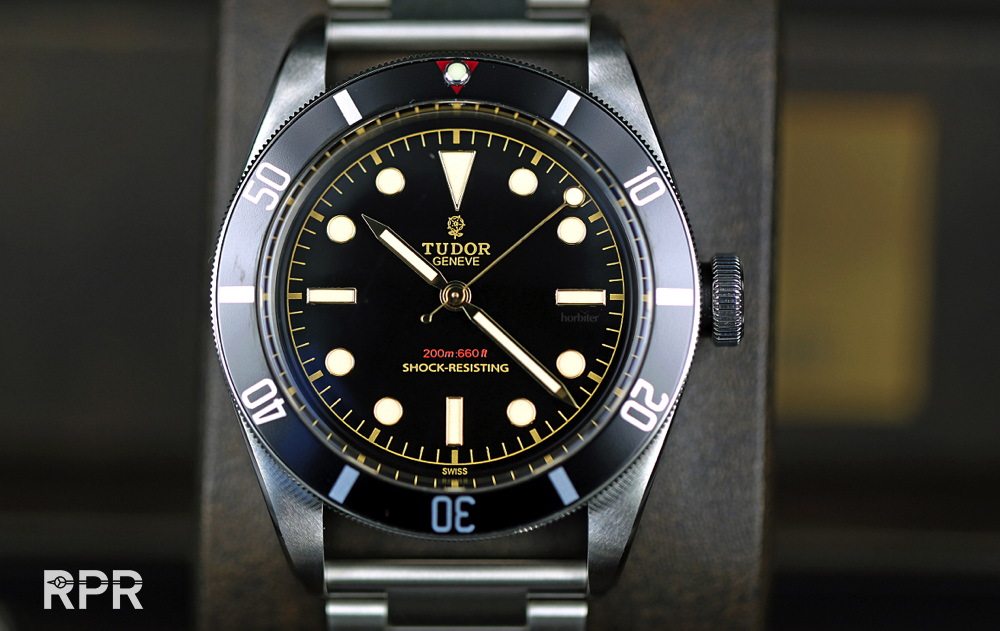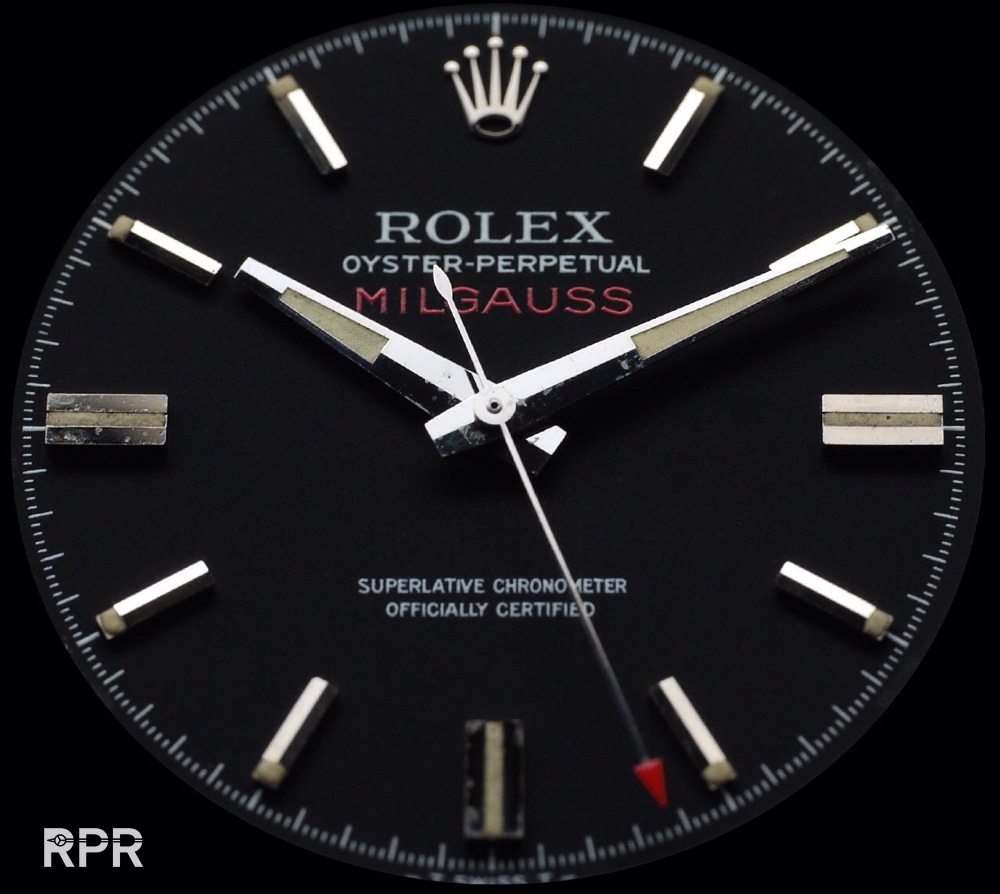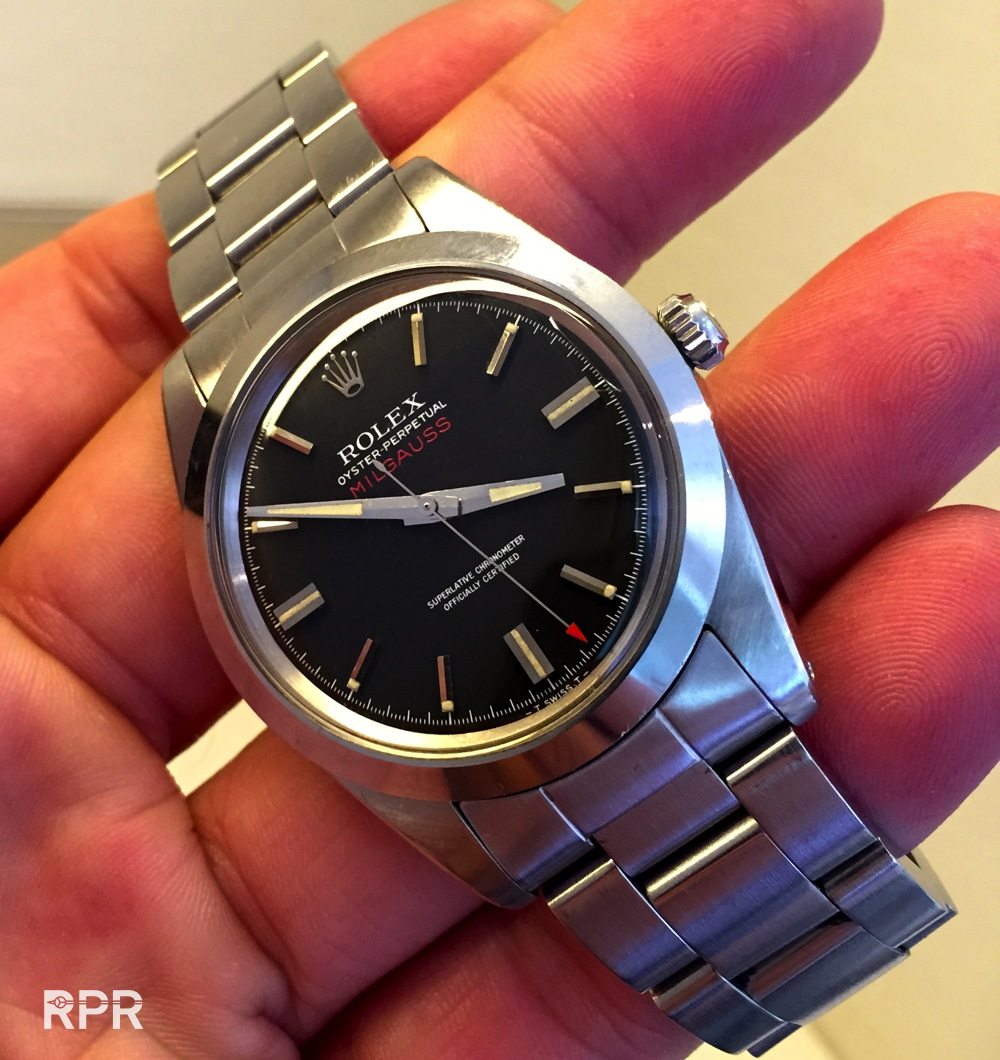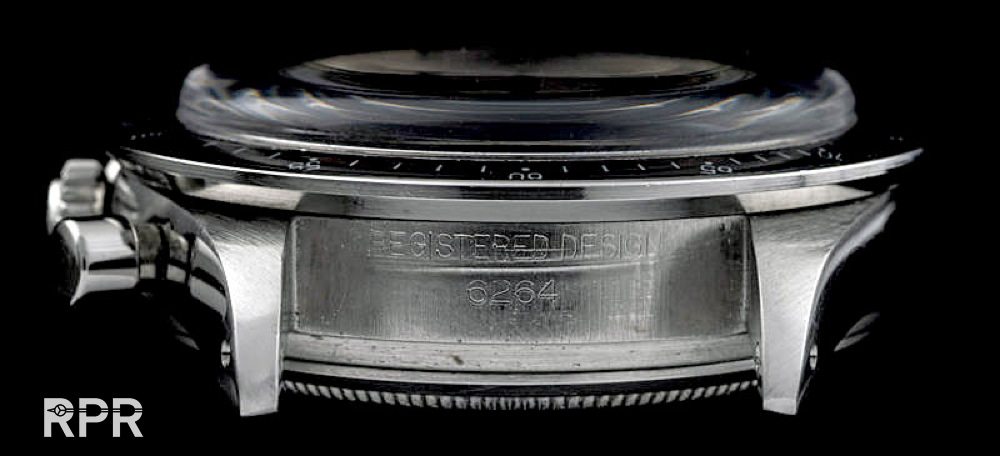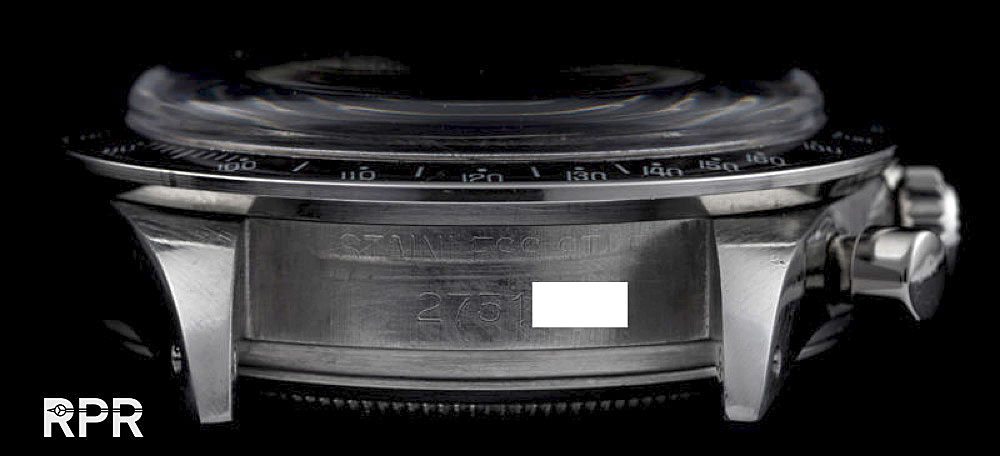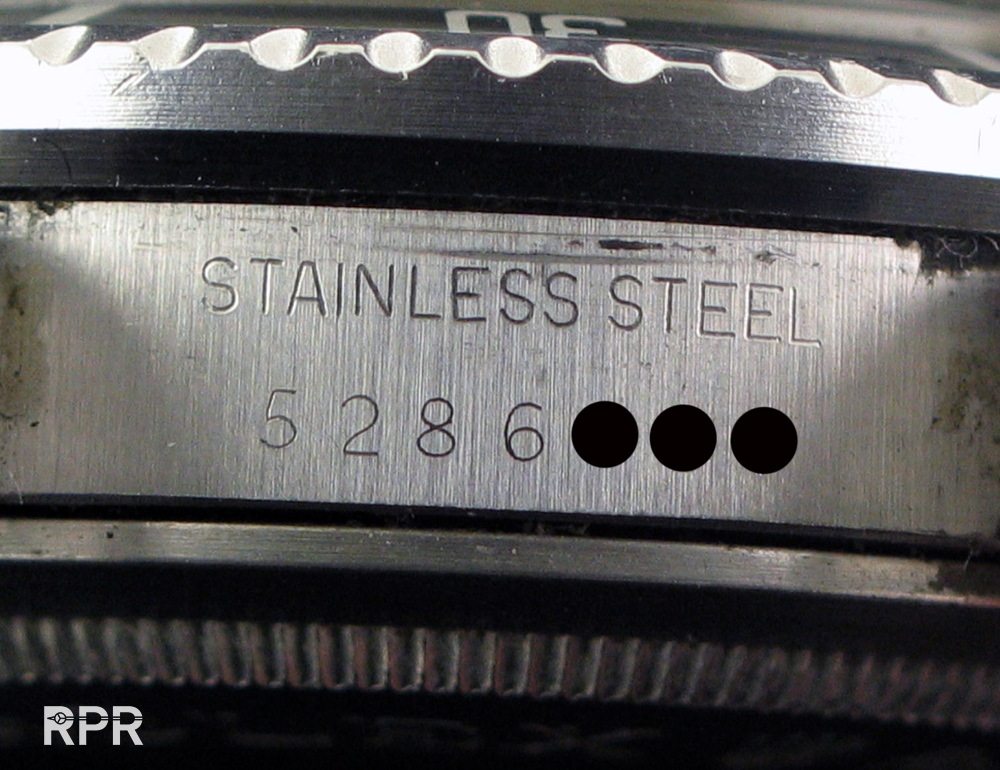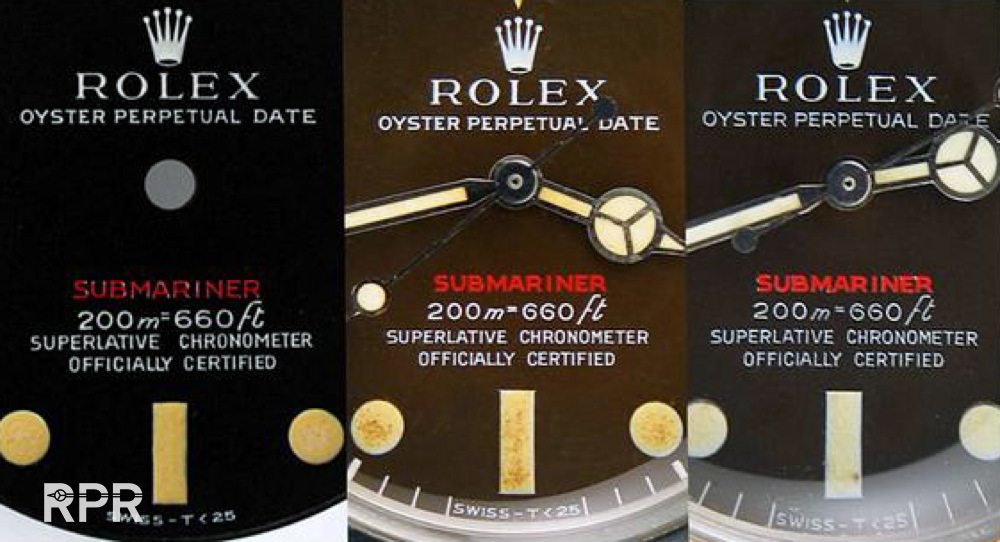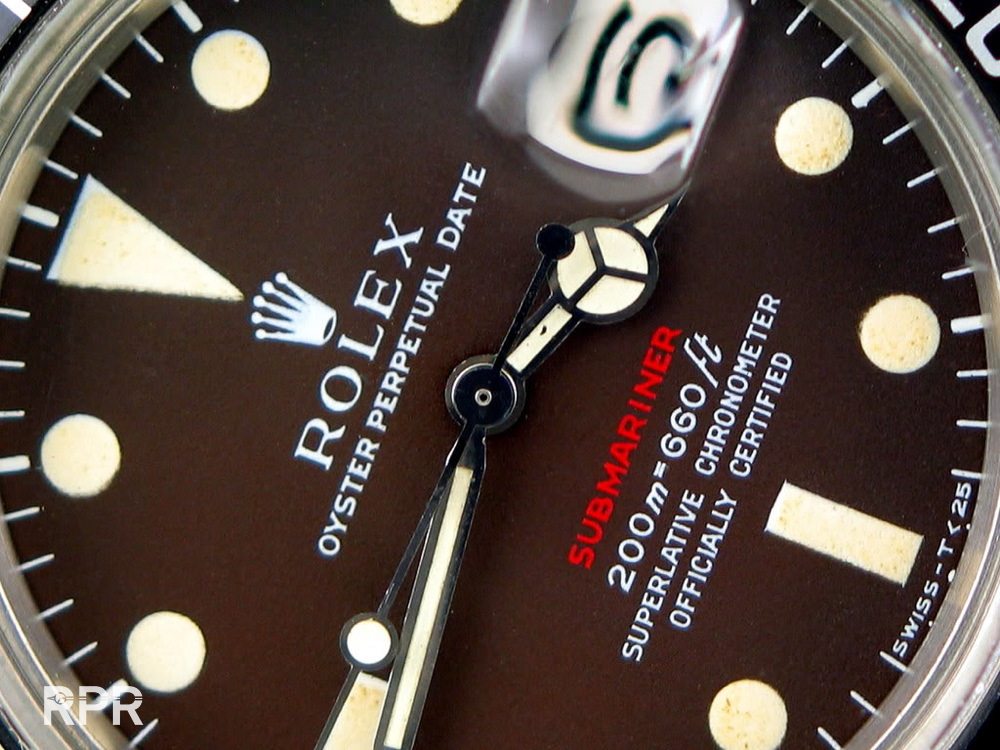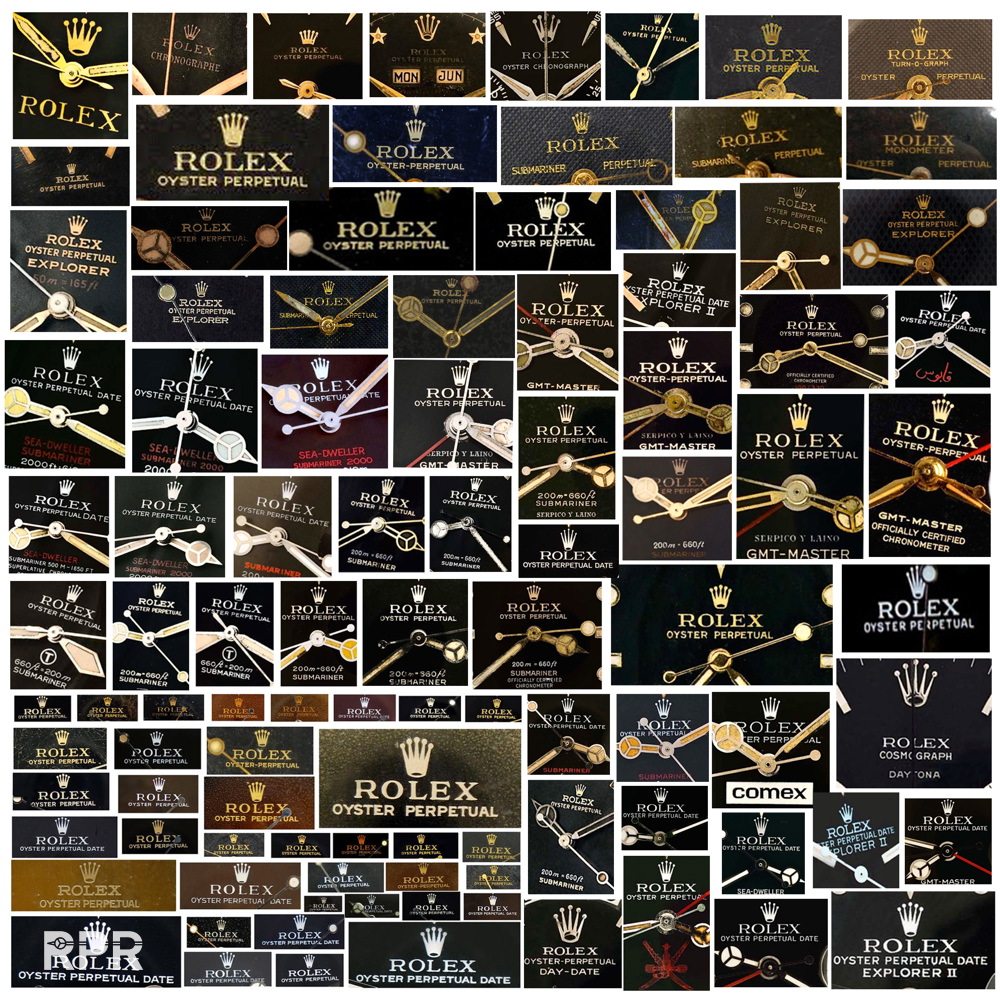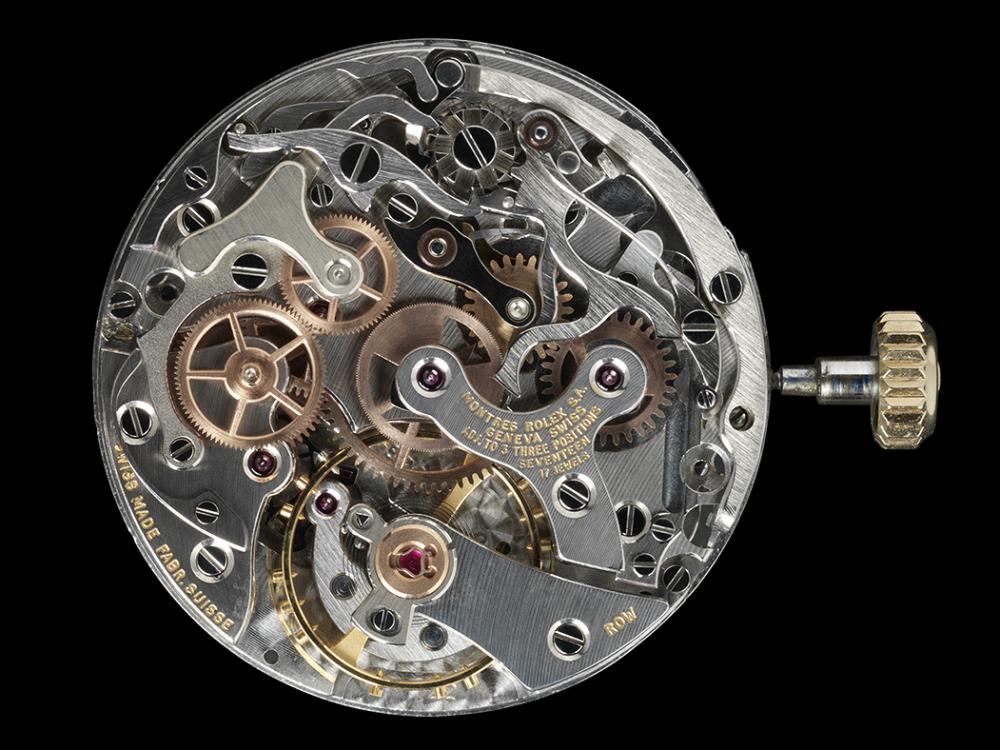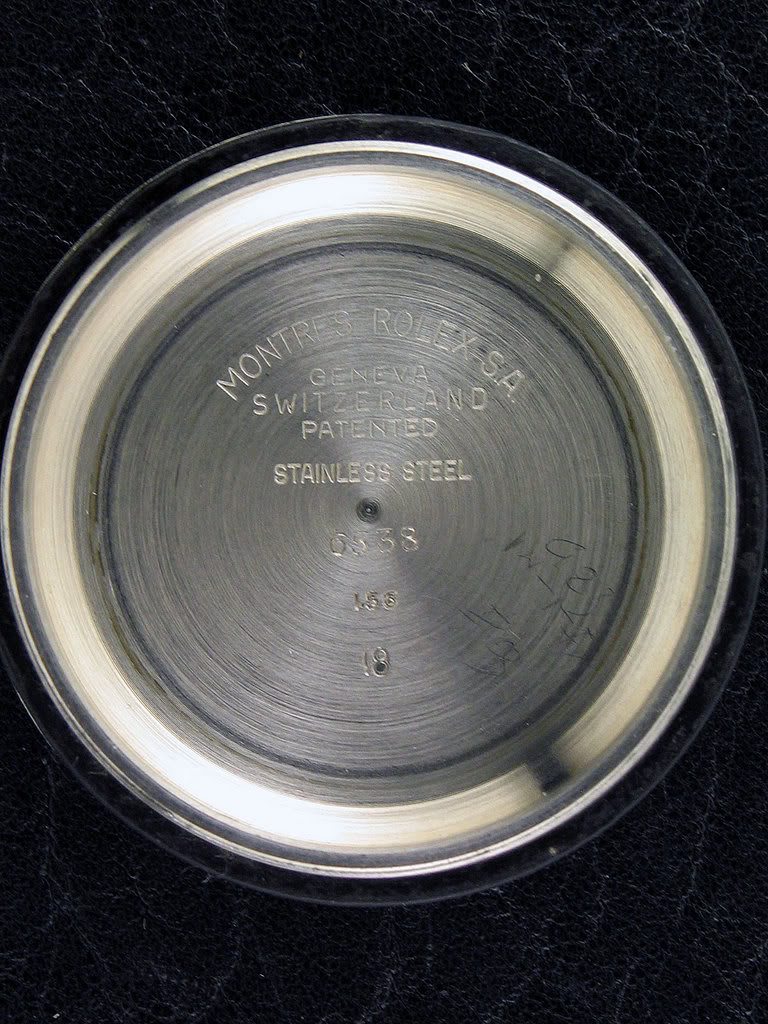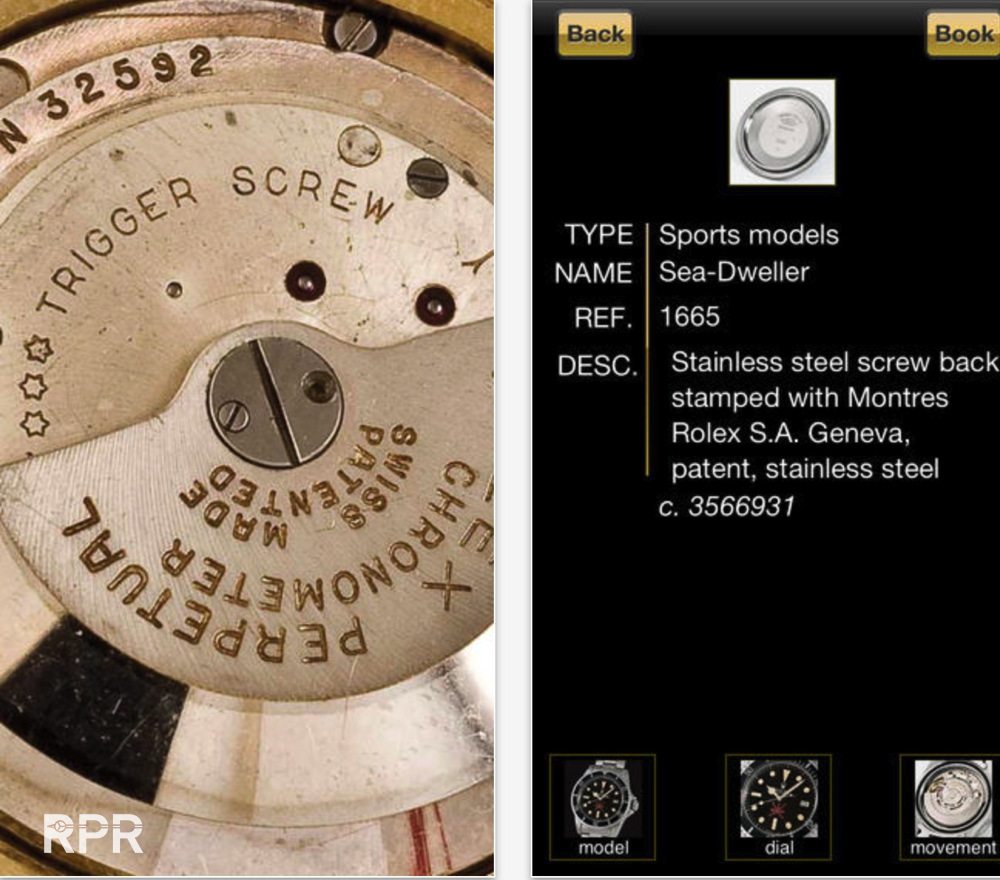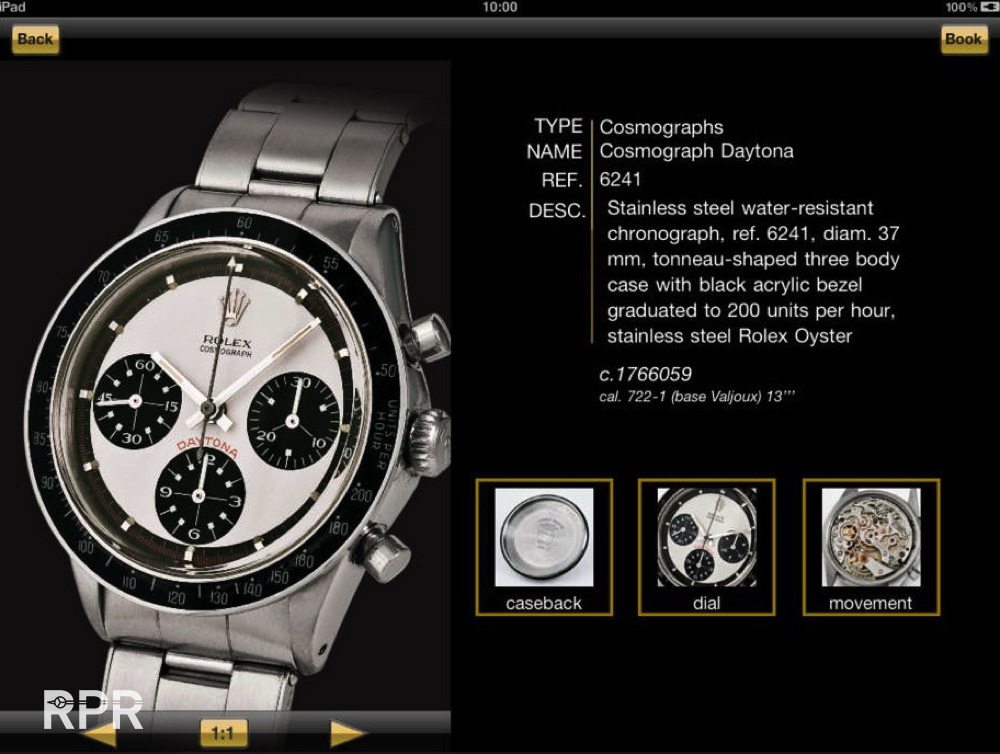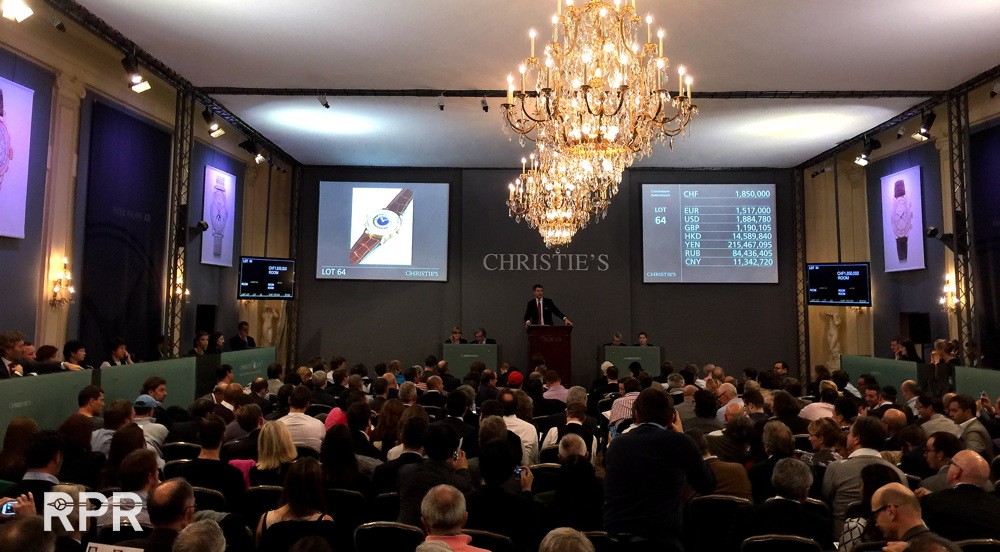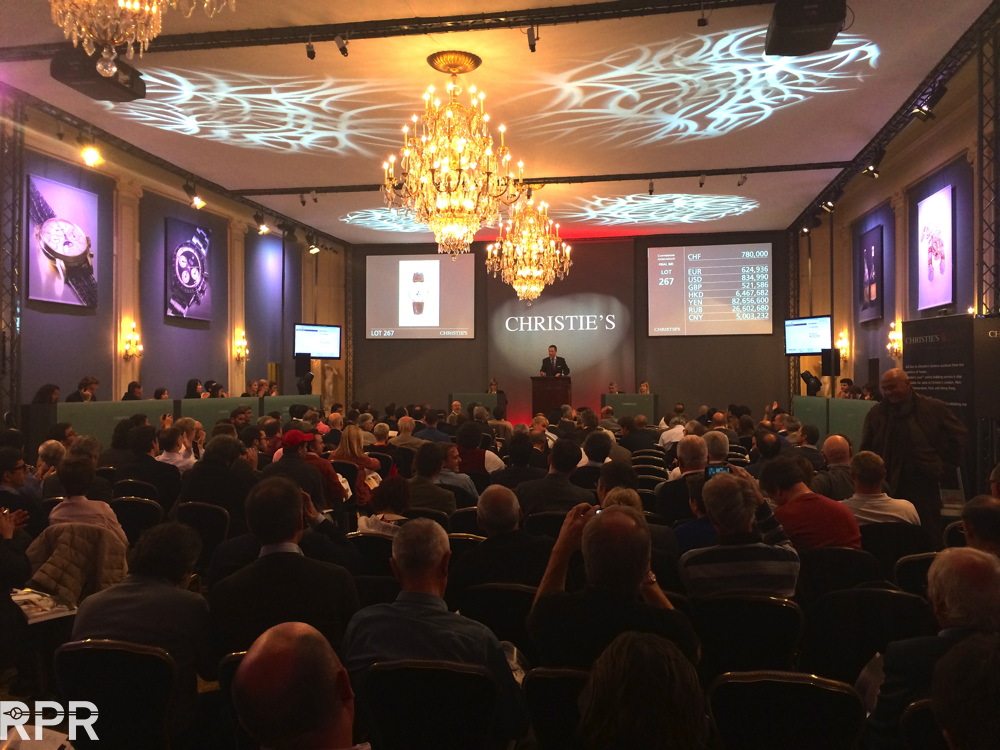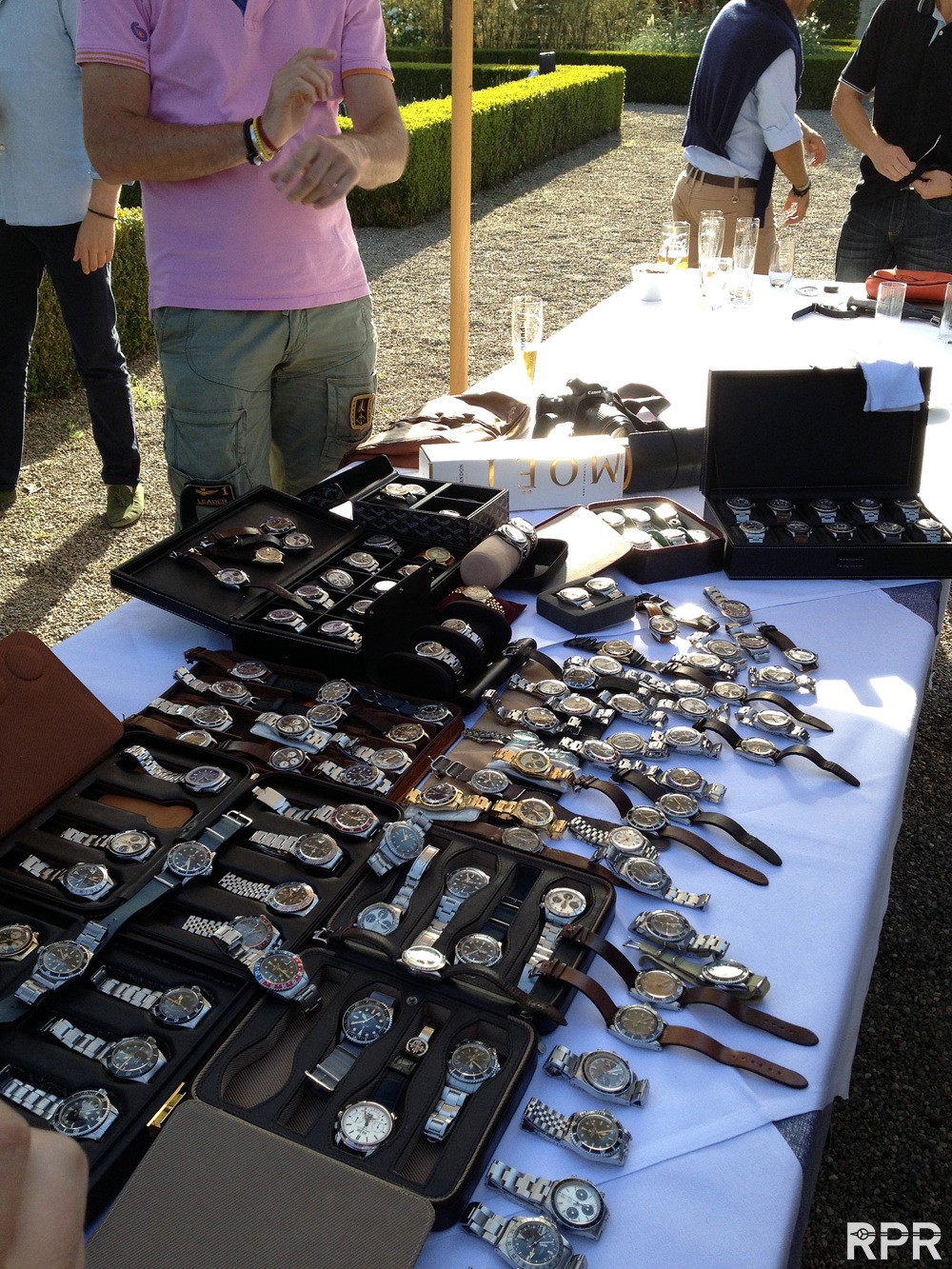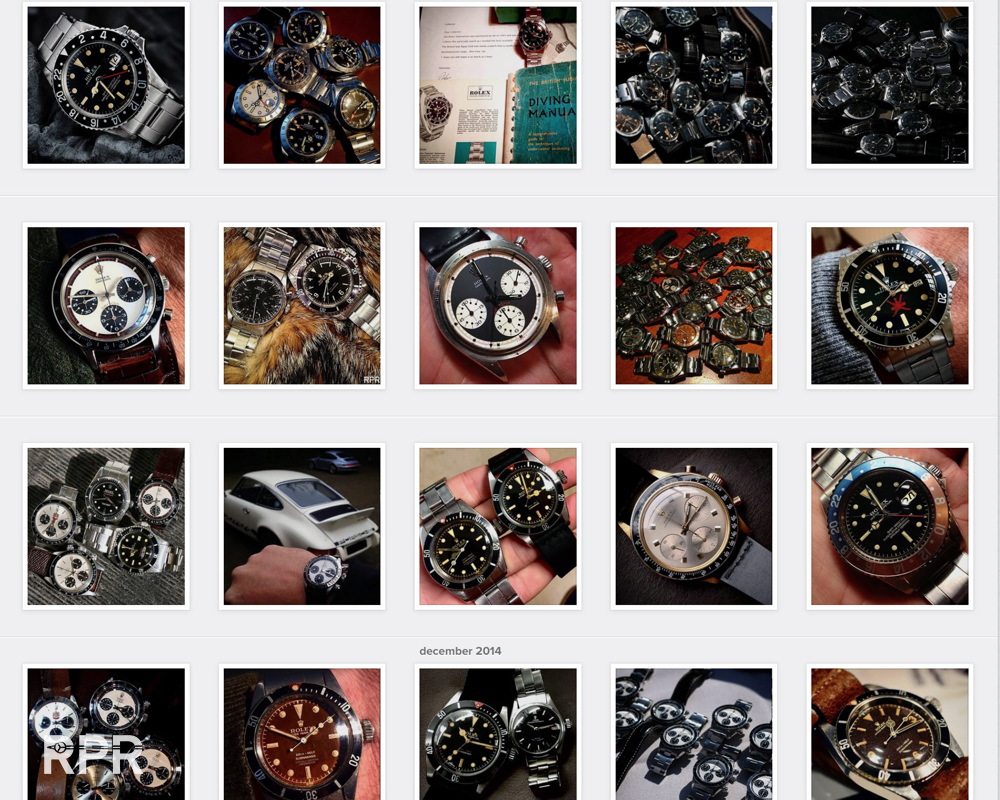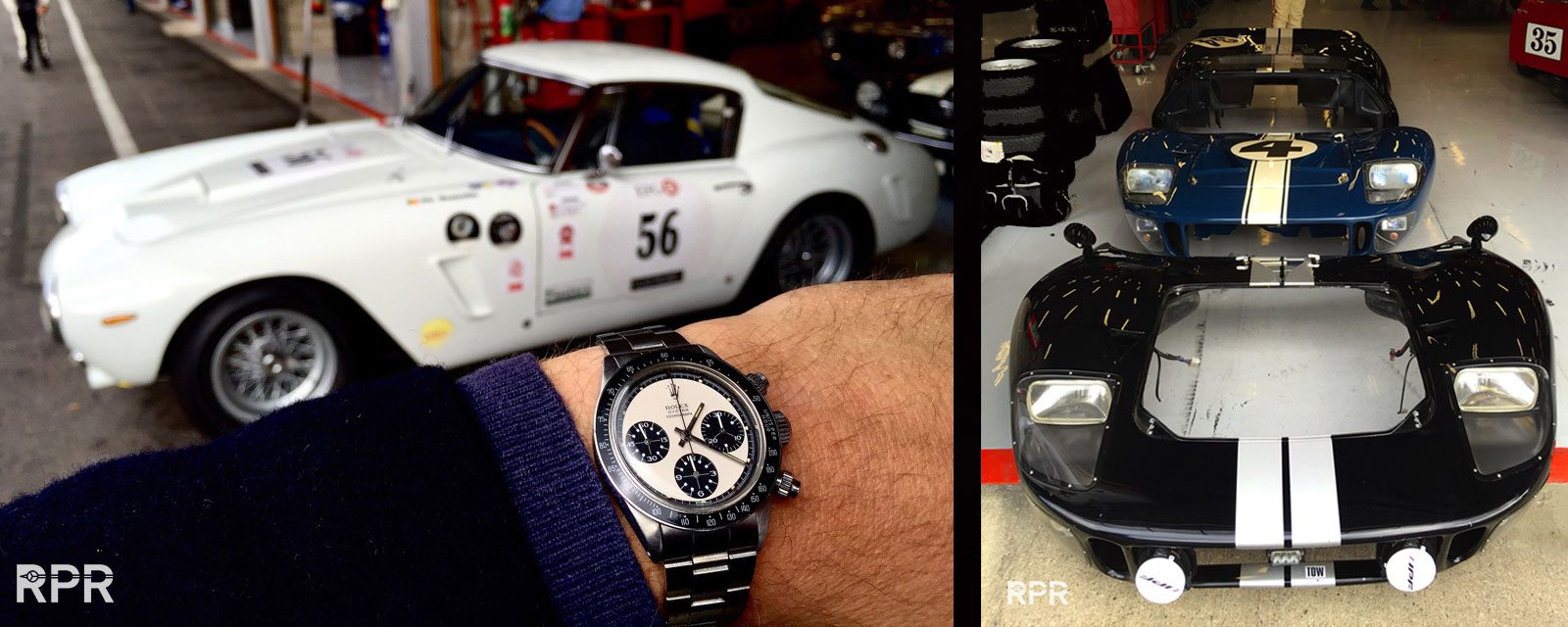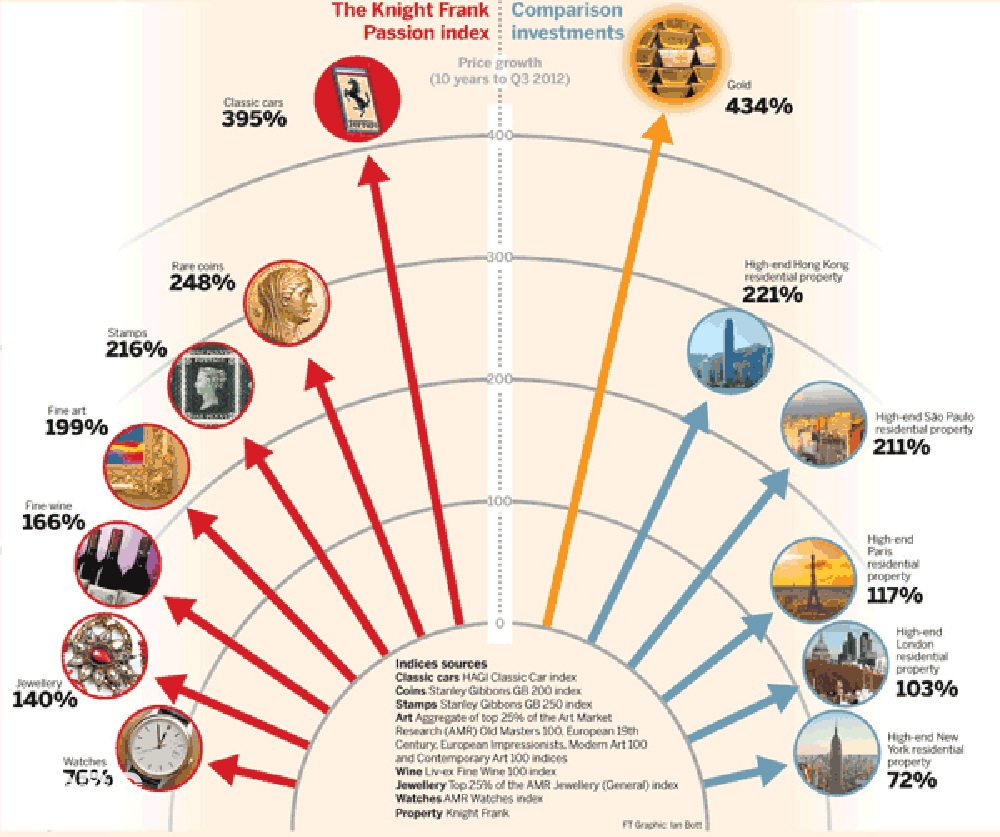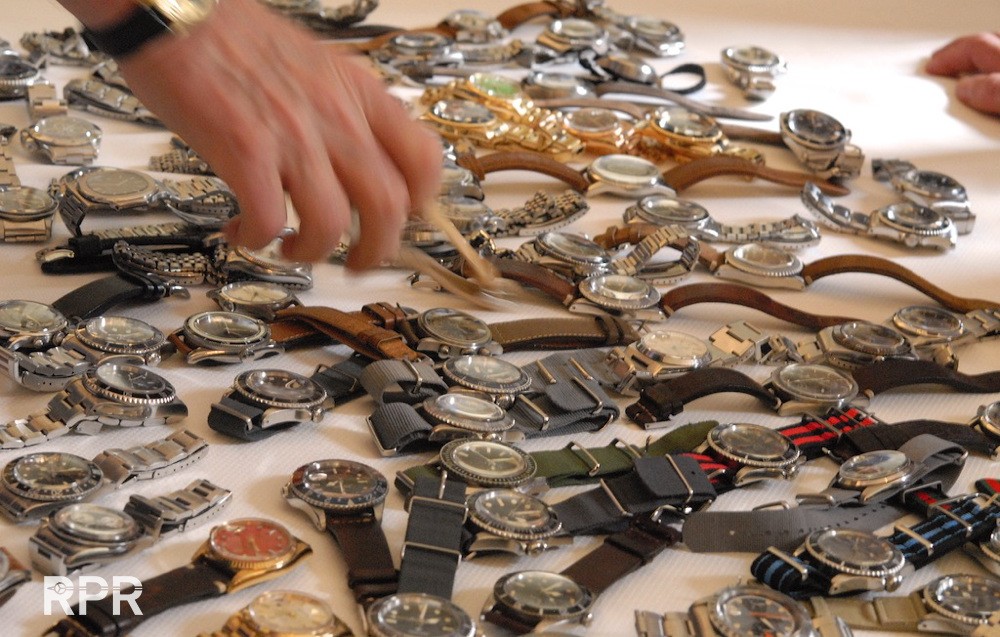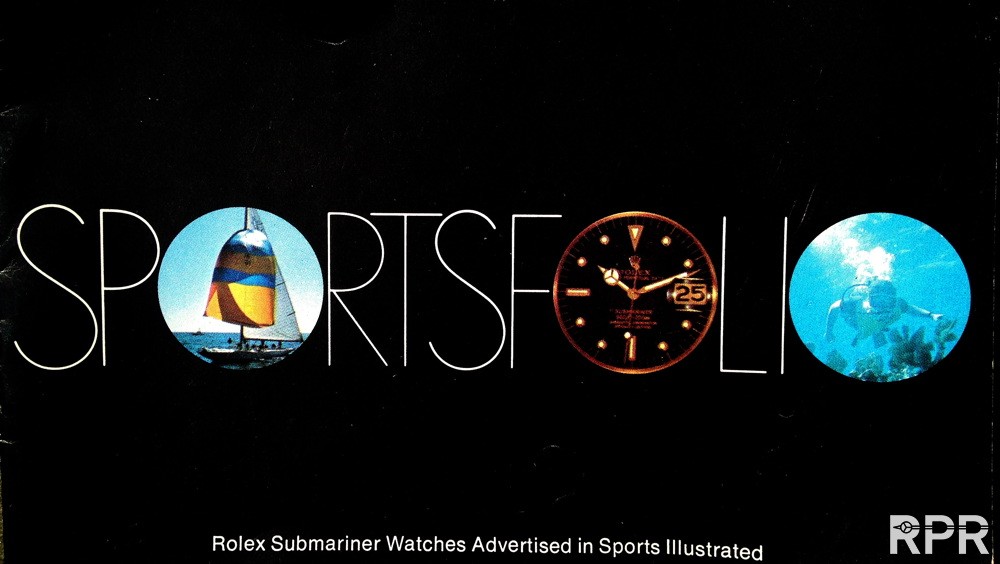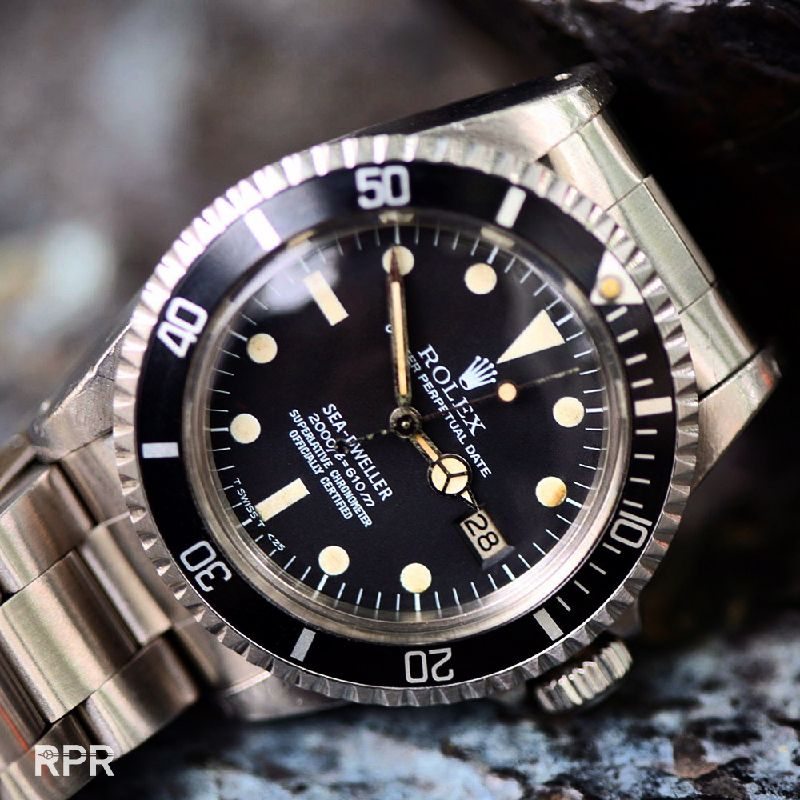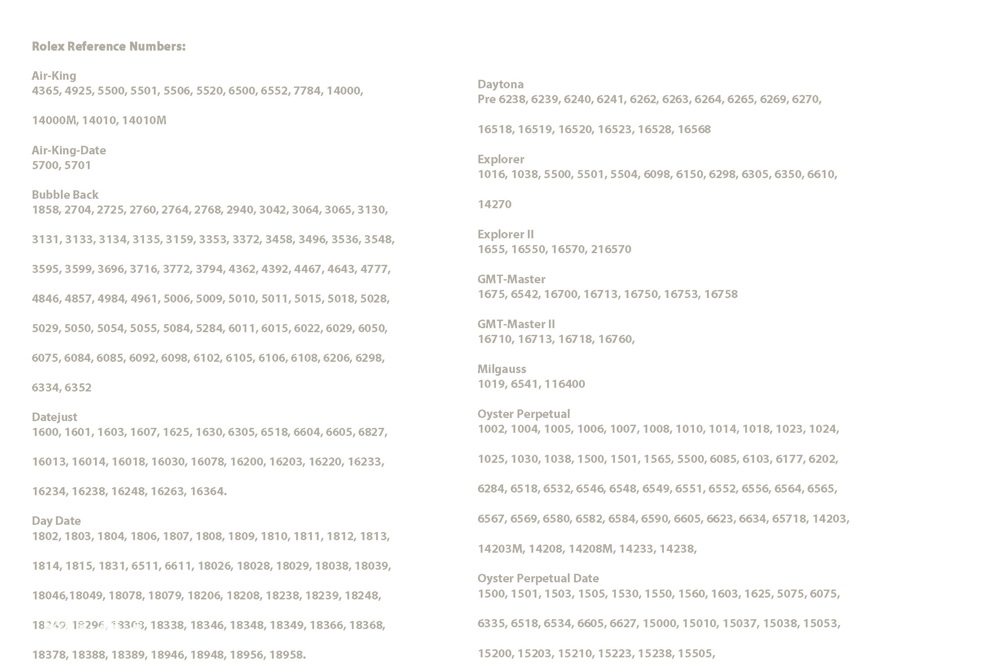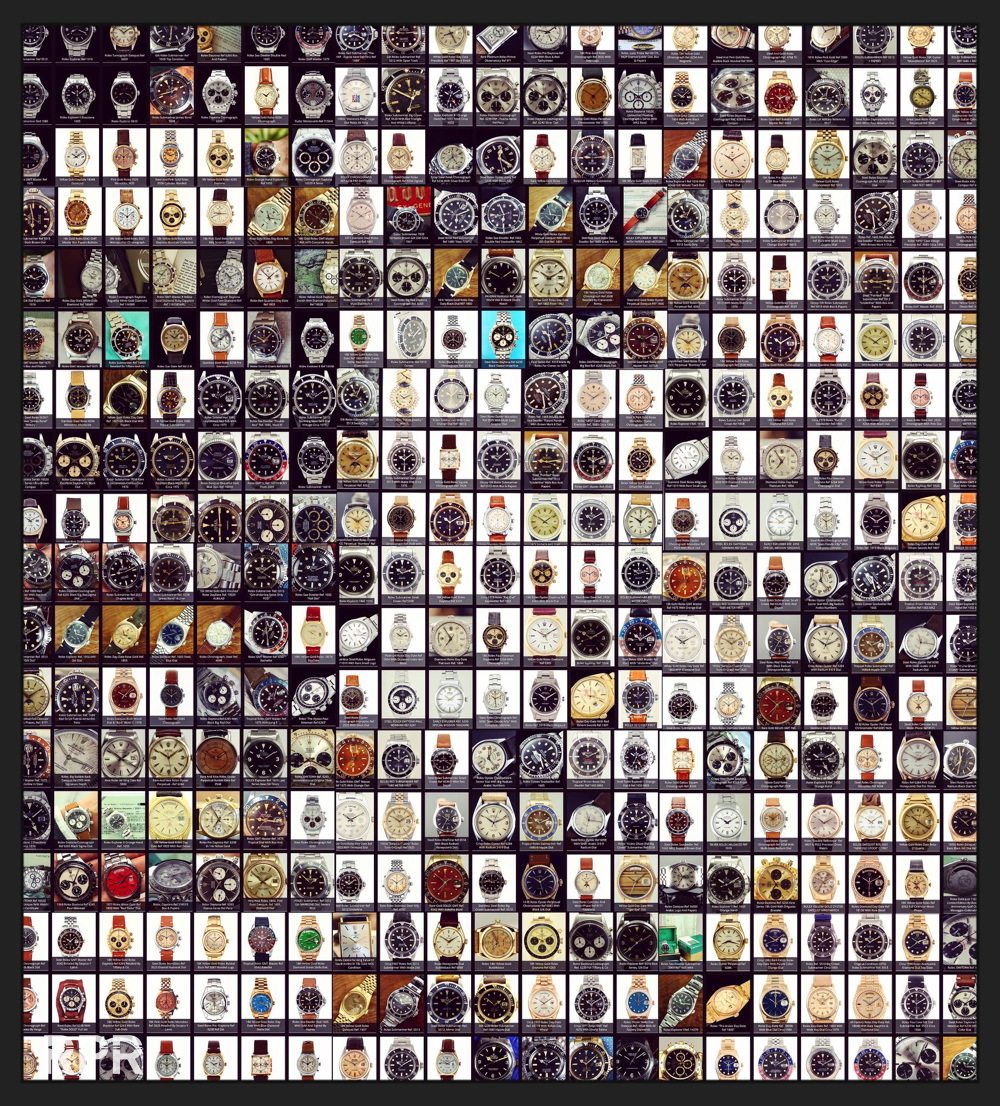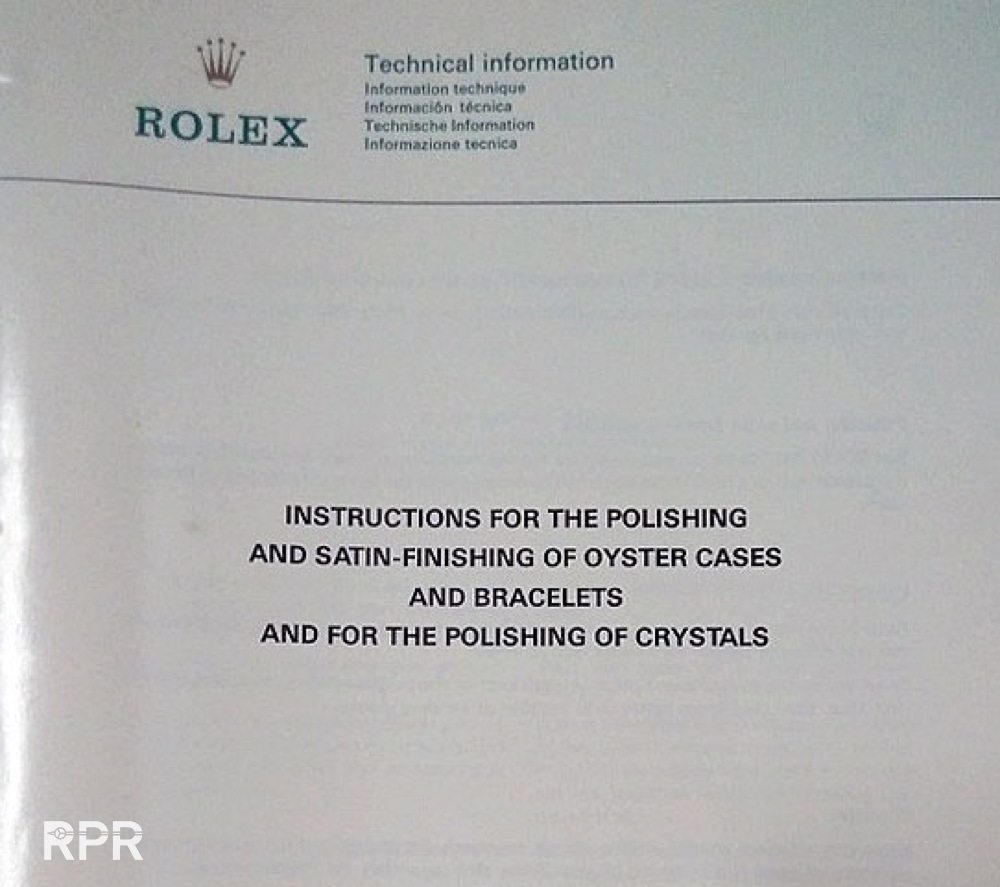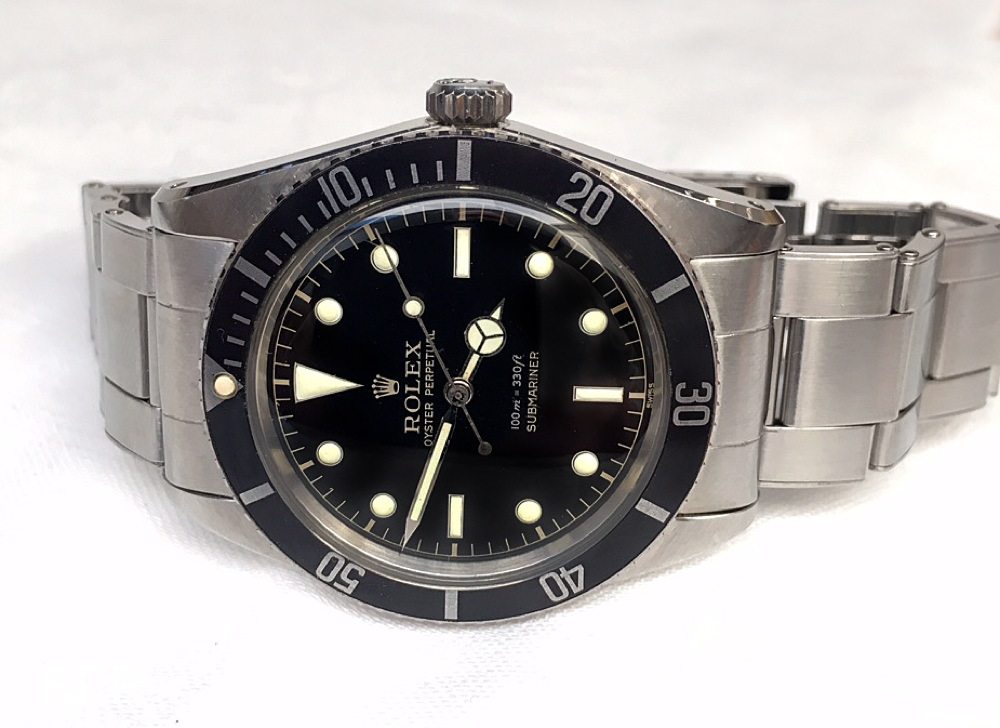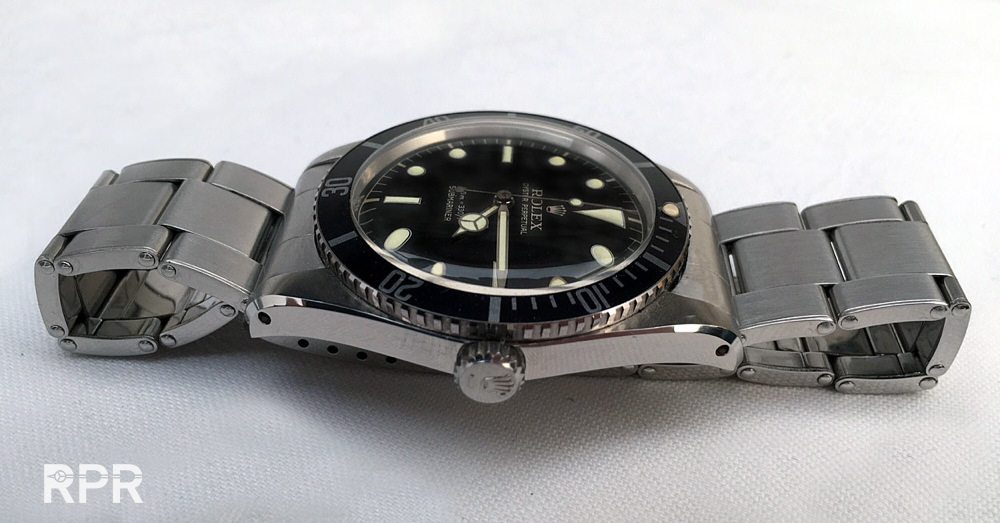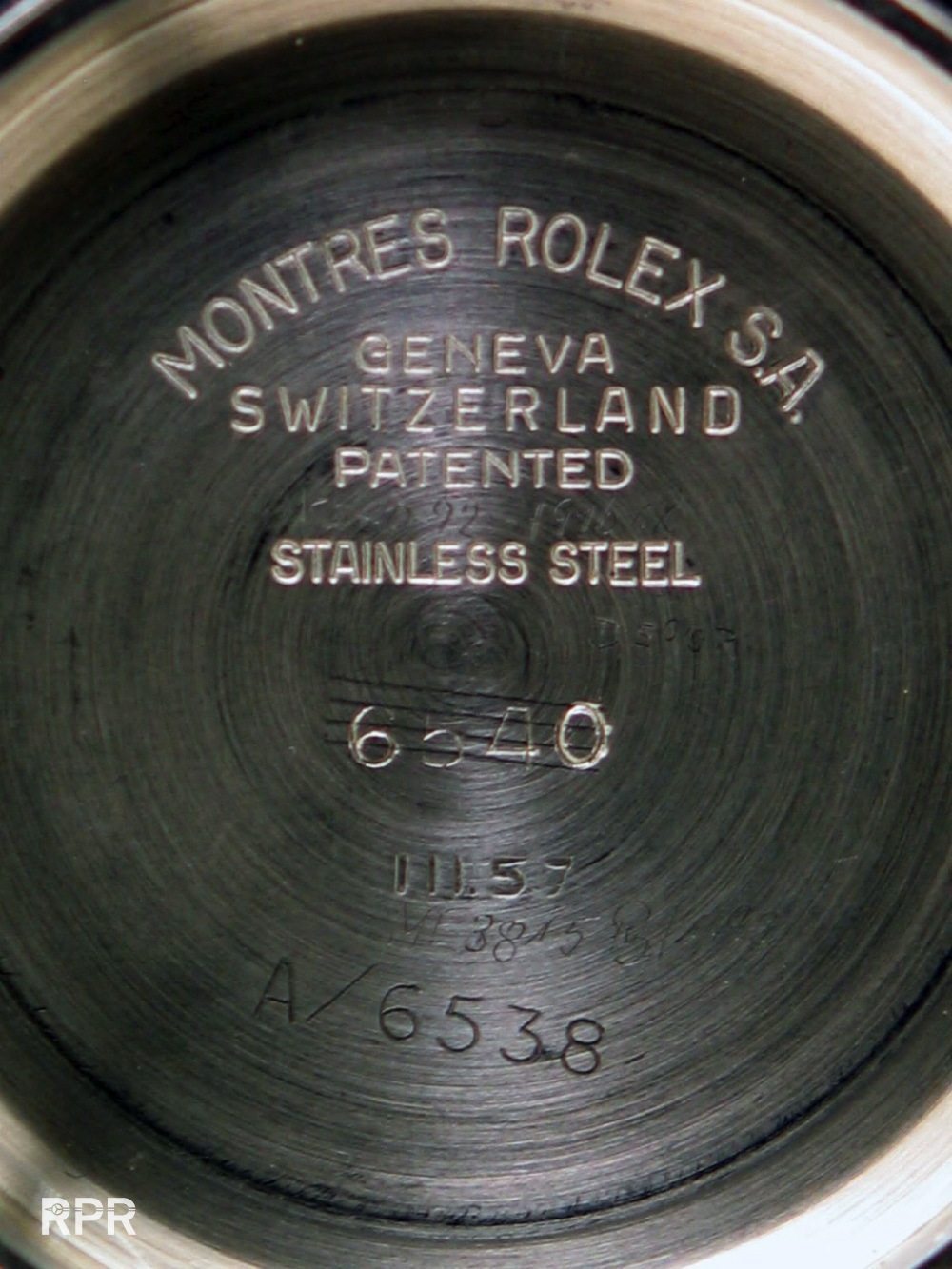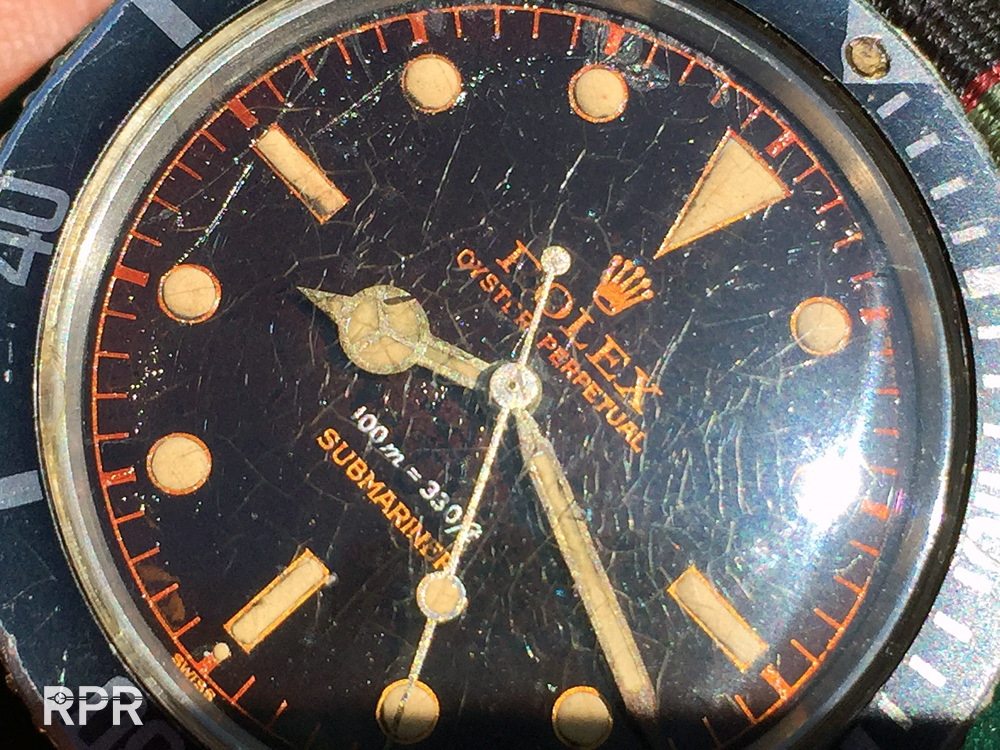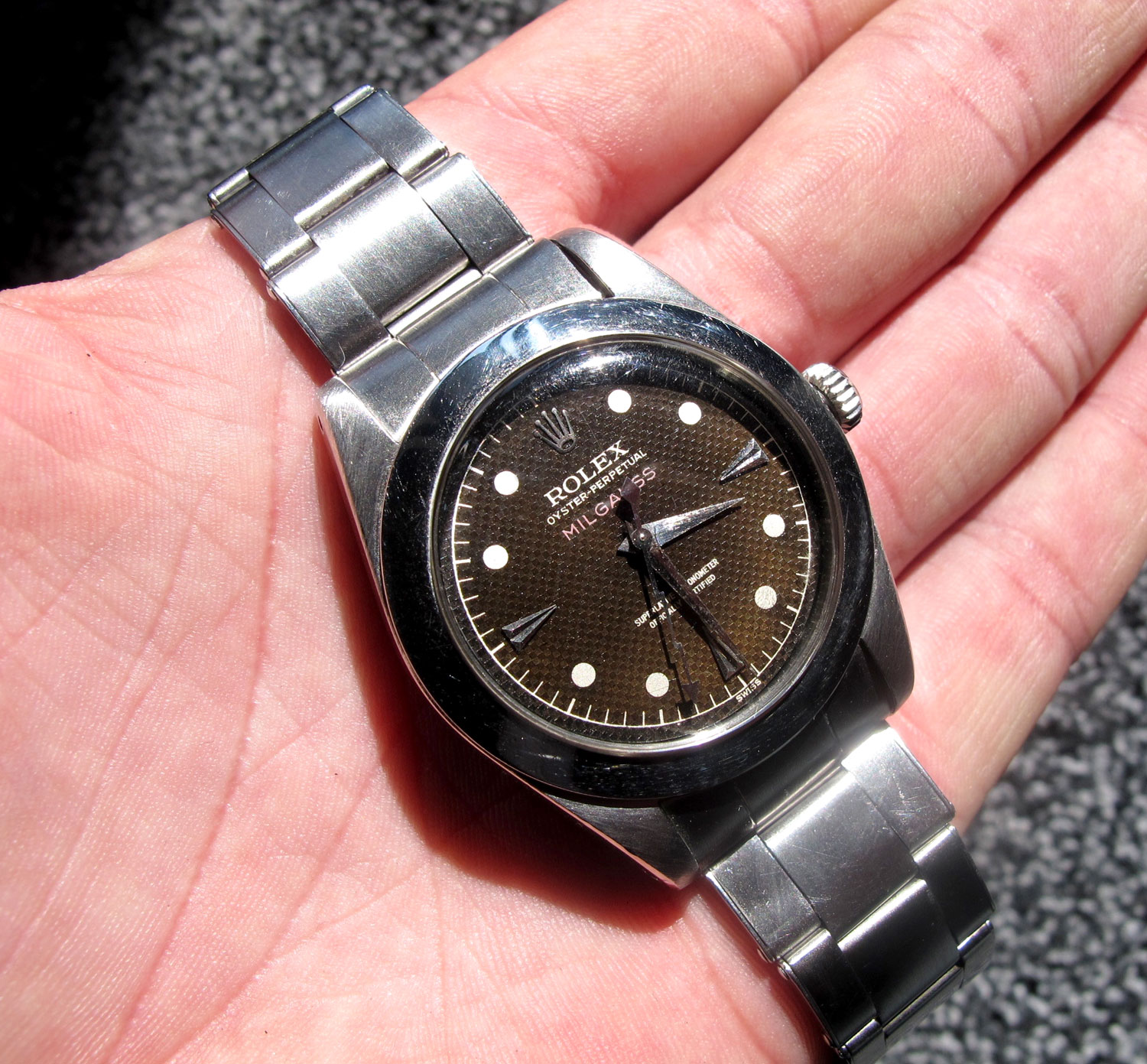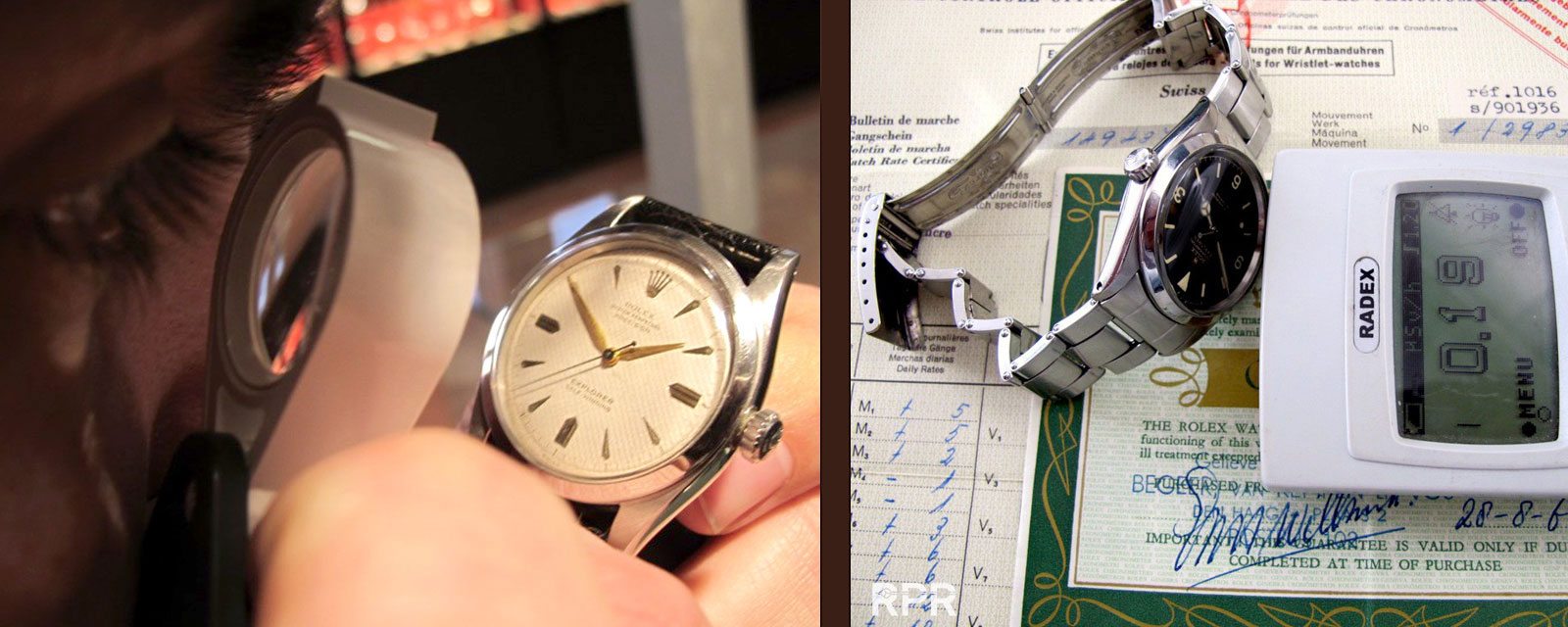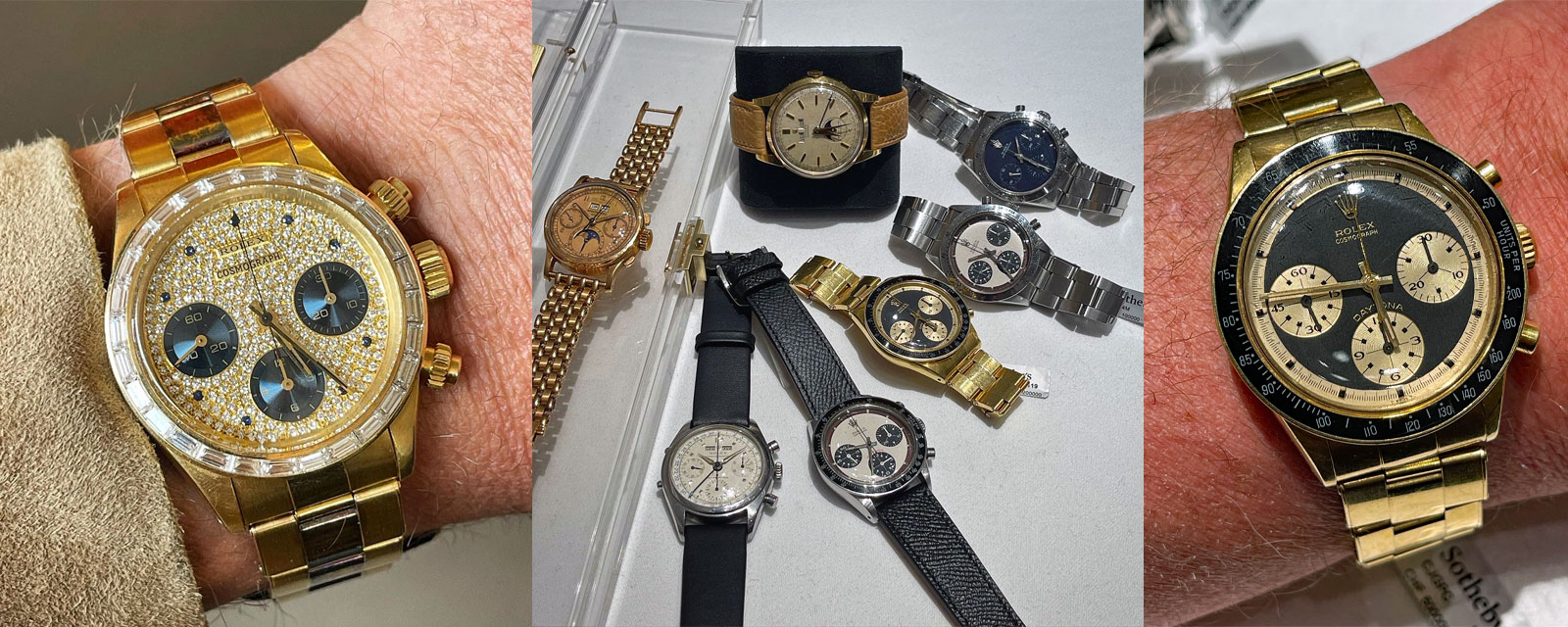The Vintage Rolex Buyer’s Guide by Philipp Stahl.

So far close to 1 million unique visitors have read my “Vintage Rolex Buyer’s Guide”. In average it took you 5 minutes each to read my Rolex collectors tutorial. Thats’ 5 million FREE minutes of vintage Rolex Education!
Do you want to learn to buy vintage Rolex safely? Then start now with my extensive “Vintage Rolex Buyer’s Guide” thats free for you to study here online. But be prepared, this is a LONG article that will take some of your time to digest!
I noticed yet again that even seasoned collectors ask me on a regular basis obvious advise about the originality of their vintage Rolex. In a constantly developing market, where fine and honest quality has gone mad price-wise during the auctions, I wanted to add a basic guidance for you how to determine the originality of a vintage Rolex and make all details better understandable for any watch collector who is serious about his hobby. The main question I always ask myself to determine originality is what has been done to the watch during it’s life: Wear wise, service wise and dealer wise.
To complete my earlier RPR post: A brief introduction into the world of vintage Rolex and Patek Philippe collecting I now like to add my vintage Rolex Buyers Guidance to analyze original vintage Rolex – or any kind of vintage watch brand in general. After I’ve spend like 25 years looking at a watch face, case and movement, studying what has happened to it (swapped original parts? restored? serviced with later parts?) during its life, comparing & discussing them on specialized watch forums like VRF, I think it’s now become time to share some of my experience. I will further develop and update this post in the near future but felt like starting to share the most necessary information already with you.
I want to discuss the following important issues around collecting watches:
- So what does “all original mean in the watchword?
- What is “Rolex Catalogue style”?
- Why is the “matching all over patina” so important?
- What do I mean with the highly important „moisture meter” cq “condition meter” ? –> Check also: “The Evolution of Rolex Luminous”
- Analyzing the dial, untouched case polish, hallmarks and movement. –> Check also: “The importance of the vintage Rolex dial“
- What I mean with period correct swapped parts.
- Explaining true tropical dials.
- Warning for fake – counterfeit parts. –> Check also: “High quality Fake vintage Rolex dials”
- Analyzing some vintage Rolex examples.
- Provenance of your watch.
- Conclusion and useful links.
- Checklist to determine your vintage Rolex condition. Check the RPR article here
Below you see a original ‘iced” plastic crystal on a early Rolex Explorer that chanced transparency due to the radium dust… 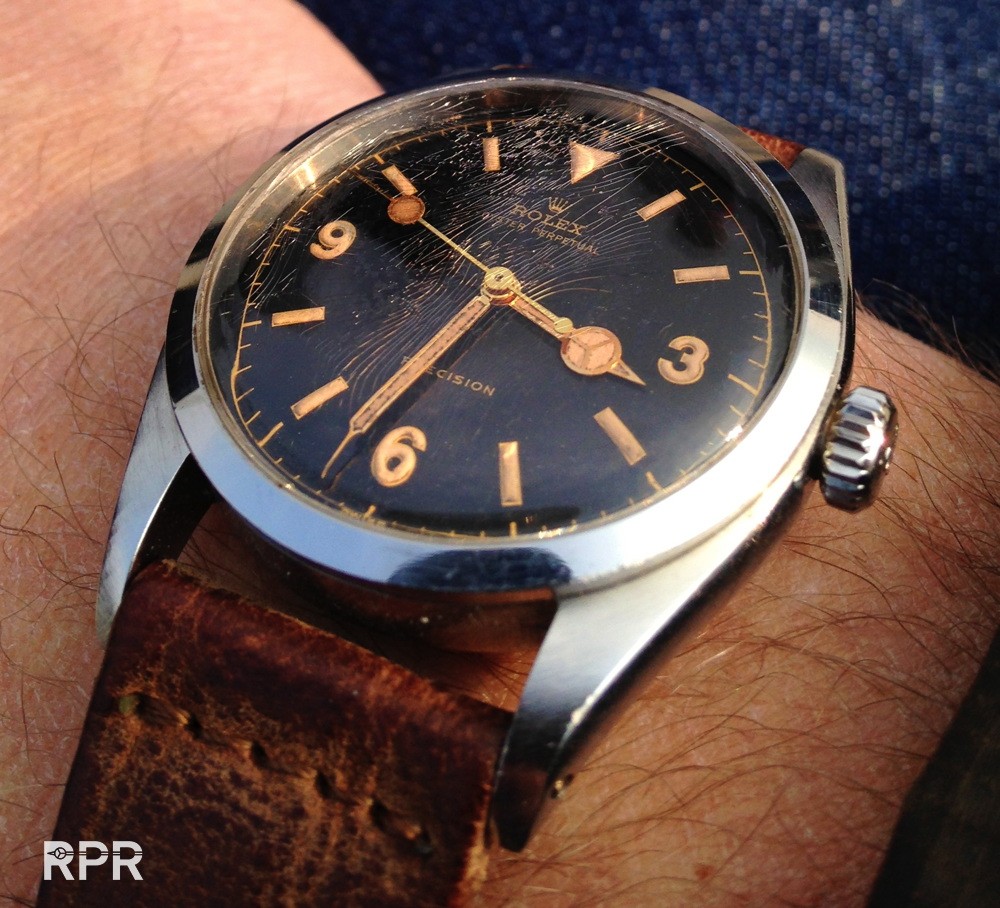
In the modern vintage watch world, which is full of “put together“‚”swapped“‚”cosmetically enhanced” and “photoshopped” online and offline offers, at first we have to determine the meaning of the words: “all original“. The current market (as we see at the recent Geneva watch auctions yet again) has become all about rarity in the reference and condition but generally the word “original” is being abused by most offers you find. So what does “all original” mean in the watchword? My explanation to this is: A Rolex (or any kind of watch ) that still is in exact configuration as it was back then leaving the factory when it got delivered to the retailer and bought by the client.
As watch brands have delivered their watches over the world in sometimes different configurations, due to import tax, local taste or for instance special orders, the ultimate version to have, is the one being shown in their catalogue at the yearly watch shows ( think of Basel World ) As many global watch brands used to do and in particular the penny-pinching swiss ones, factories always used their left over stock of spare parts in their next designs. Then as most iconic watches where not very popular when they came to the market, it took sometimes 5-10 years or more to sell the initial batch the manufacture made. What we often see is that later delivered examples have different dials, bezels and or updated movements making them not exactly the same in detail as when the first ones got introduced. 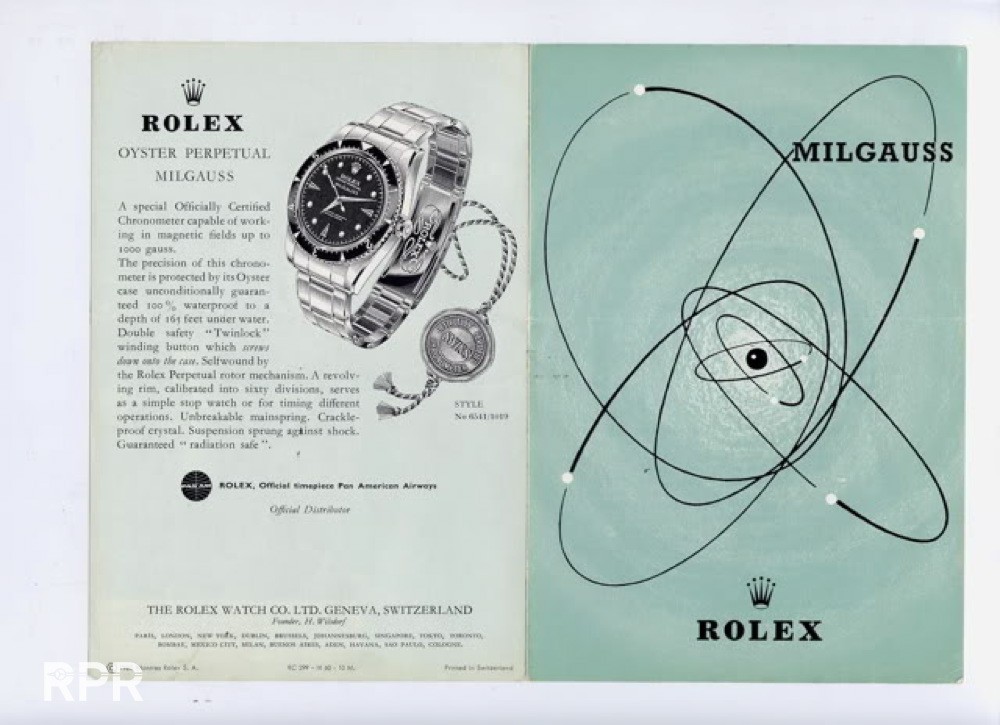
A mayor influence on the originality has been played by the manufacture itself, namely during the servicing the watch. Original old parts, most importantly the dial and the hands, have often been changed due to the fact the new radiation regulations that became obligatory after 1964. The chance from radium to tritium ( with a maximal radiation of the total watch of 0.25Mvsr ) changed the dial description at 6 o’clock from ’Swiss’ to T-Swiss-T and later T-Swiss<25. Its due to all these facts that I use the word “Catalogue style” to determine the best possible version / configuration one could collect. A Rolex that’s still in the condition as it was published in their old catalogue, being from the first batch and not been serviced with later parts, is the ultimate one to have imho!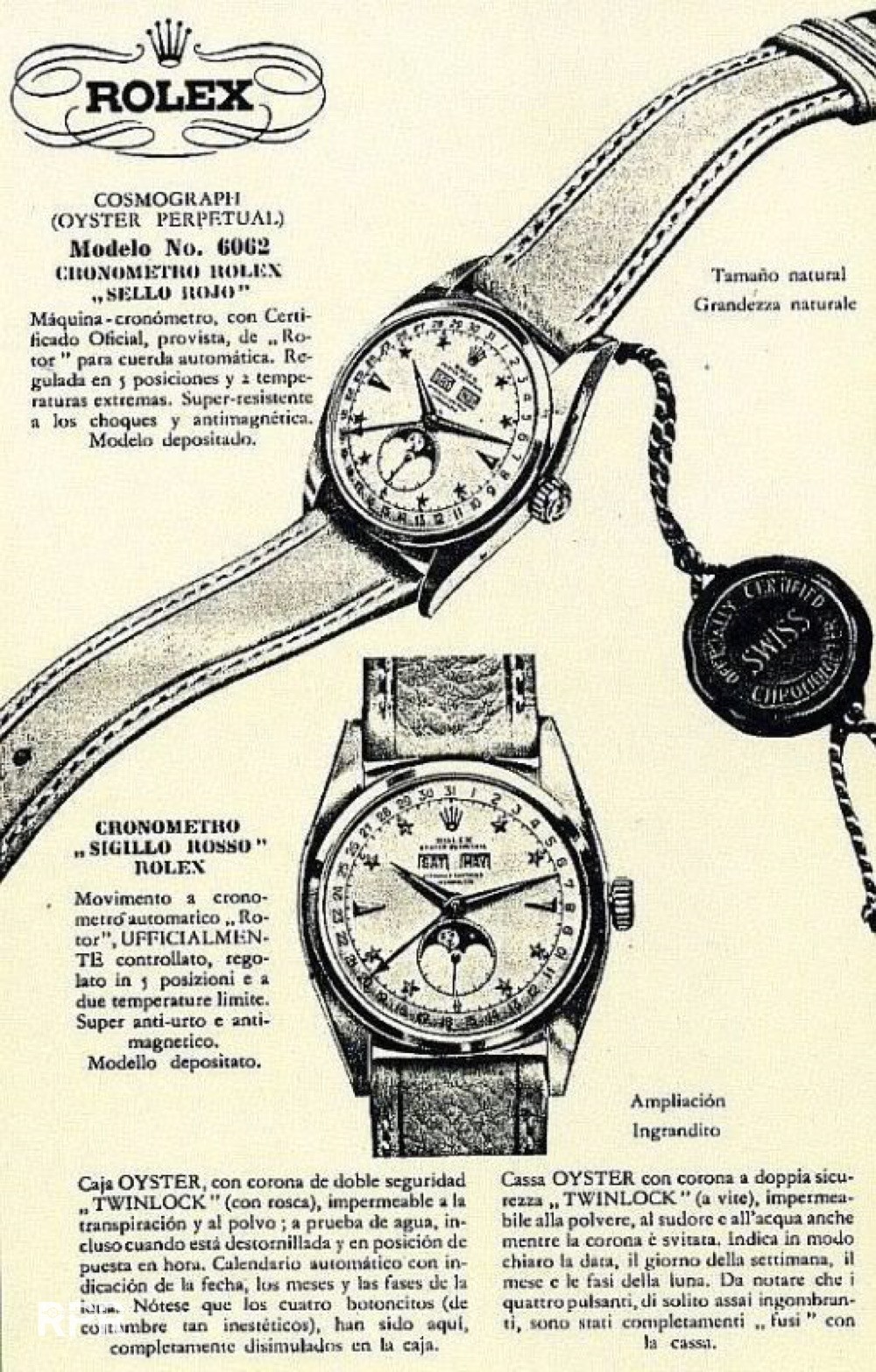
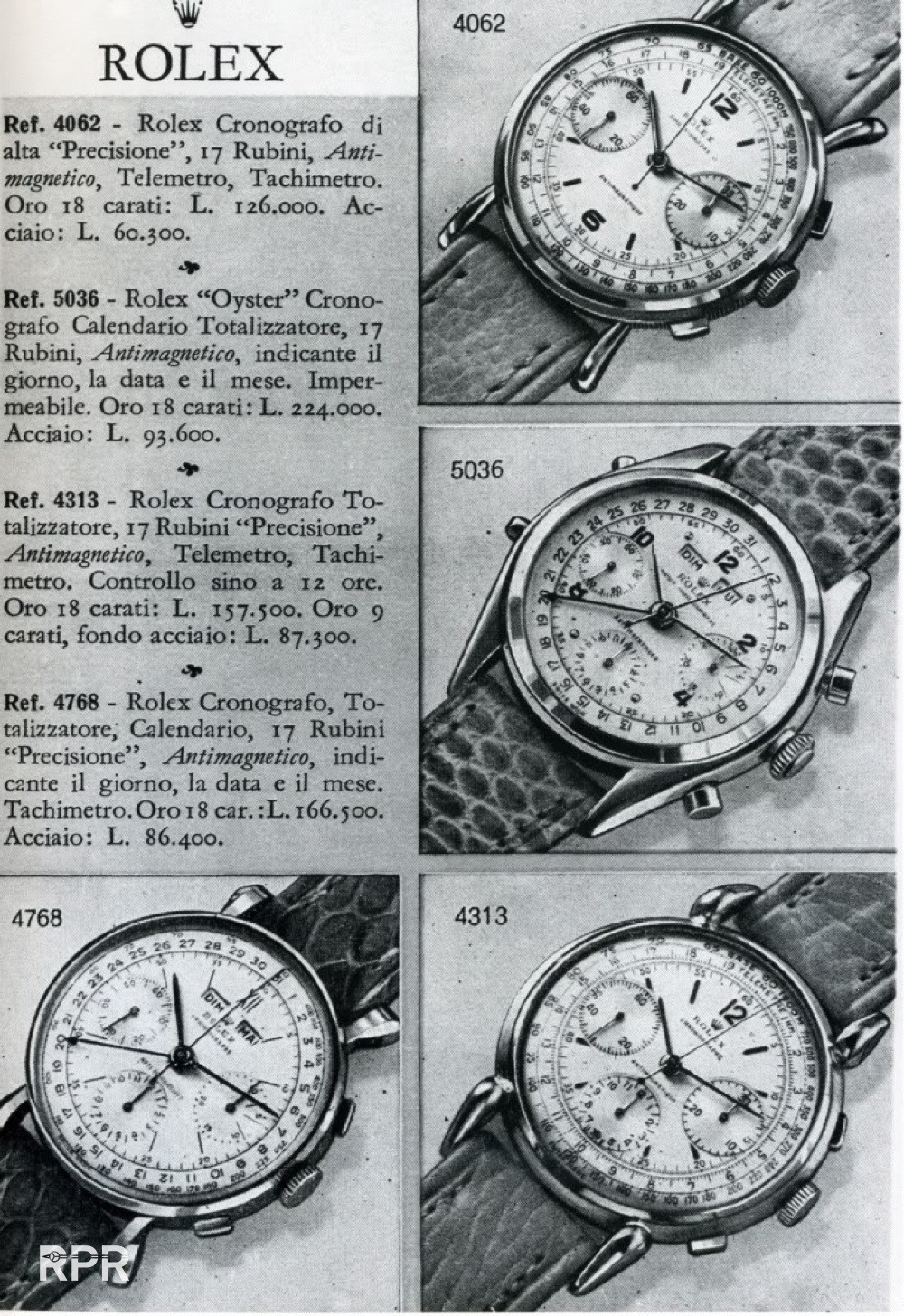 Advise: Use Google to find pictures of original old watch catalogues. Specialist watch forums can help you out as well. As some forums are closed and google can’t get the picture out there to show you, it’s most of the time a small effort to register yourself and then use the ’search option’ For Rolex I can highly recommend VRF (www.VintageRolexForum.com) Besides the many freshly found examples that have been posted over the years, there’s a „Vintage Dial Archive”, „Rolex Serial Number Project” and a „VRF Classic Post” sections that are very useful to go through.
Advise: Use Google to find pictures of original old watch catalogues. Specialist watch forums can help you out as well. As some forums are closed and google can’t get the picture out there to show you, it’s most of the time a small effort to register yourself and then use the ’search option’ For Rolex I can highly recommend VRF (www.VintageRolexForum.com) Besides the many freshly found examples that have been posted over the years, there’s a „Vintage Dial Archive”, „Rolex Serial Number Project” and a „VRF Classic Post” sections that are very useful to go through. 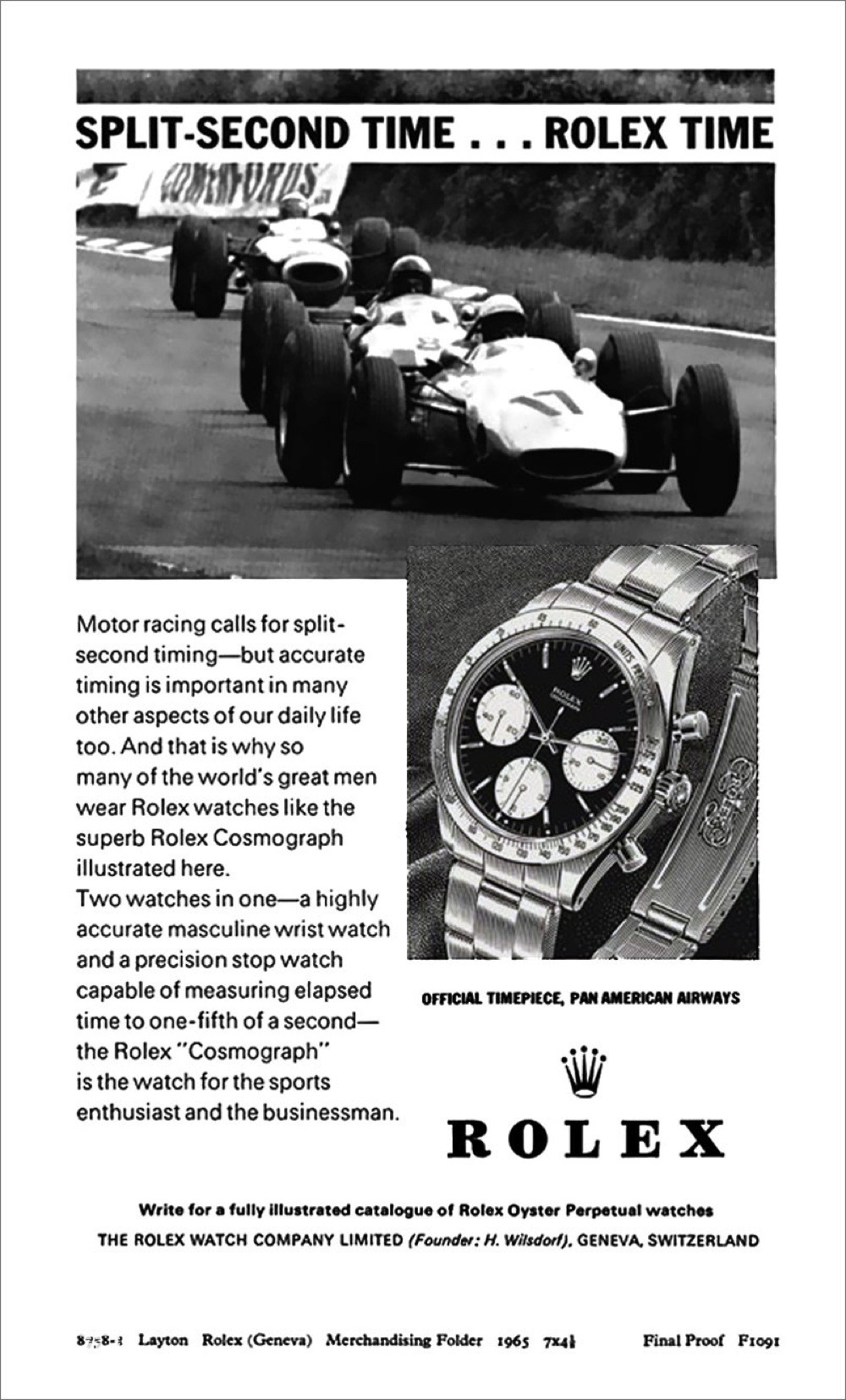
Now we know what is the best is to collect, next step is to determine the quality. What we often see when we analyze any watches on its condition, is that the „ all over patina” is not matching. An old watch that has been worn and stored during time will have patina on the dial. Furthermore it has little dents on the common edges of the case, show wear on the crown and leave marks between the lugs from the bracelet that was attached between the lugs. A perfect case with a non perfect dial are signs that someone is trying to cover up earlier damages. Or the other way around a damaged and worn-down case with a perfect dial and hands also tells us something has been done to cover up imperfections.
Advise: Check out ‚honest, untouched’ offers from private clients on Ebay.com to get a feeling how watches ages over the years. I can also advise you to check the sold archive of auction houses like Bonhams that have hardly take any ‚dealer prepared’ offered lots into their sales but just auction they lots as it is. Ones you have looked through many examples, your eyes get trained to spot original patina. Below a NOS Submariner.. 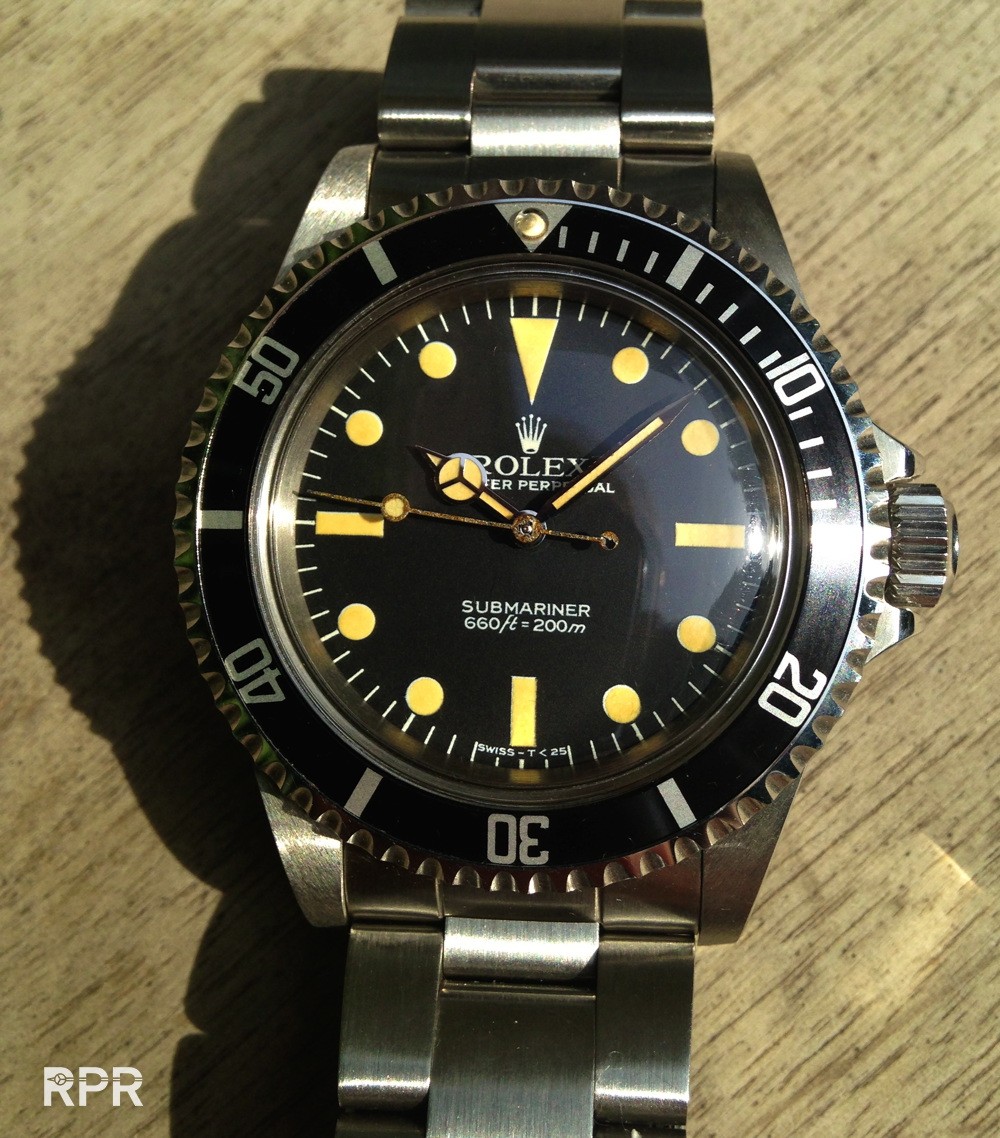
On an older, glossy gilt dial printed with galvanic technique where you see the lume is actually added lower on the sticky white surface.
Below we see a 1963 Explorer Ref 1016 with so called “Underline”, sold in The Netherlands in 1965. The serial number is mentioned on the Chronometer Certificate. Although it’s having the “minute track ” and it’s marked only with “Swiss” at 6 o’clock, the luminous is not radium but already later Tritium hence the geiger is below 0.25 mSv as you can see.. 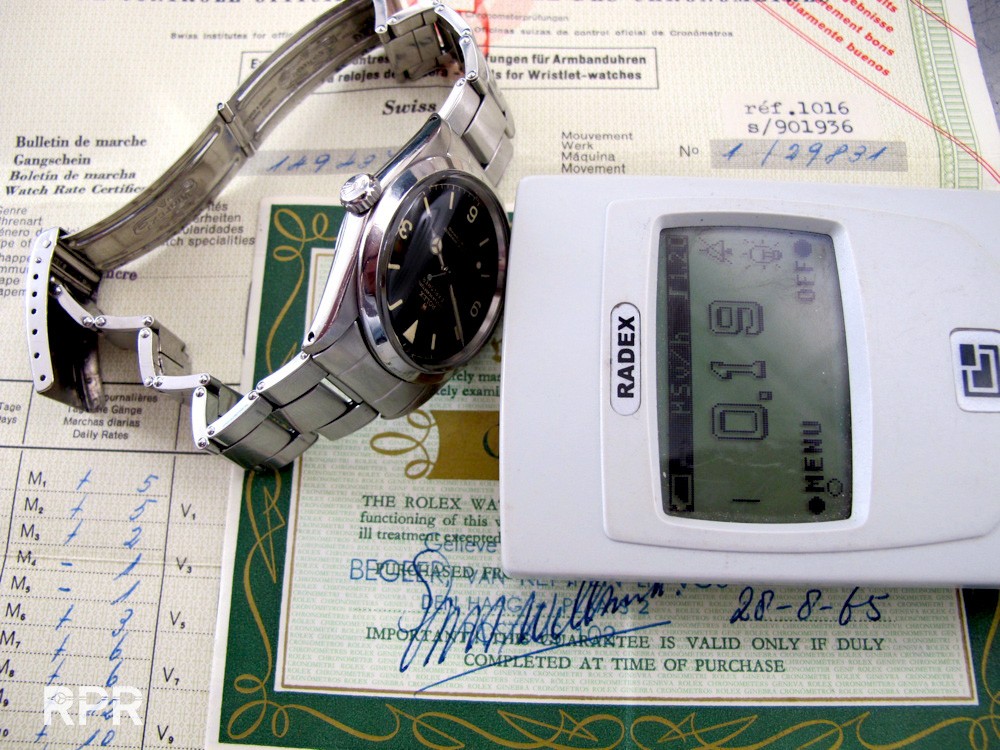
Probably the best tip I can give you for the popular Rolex or any kind of luminous dialed watch, is always to check the luminous up close! The biggest problem one can have with a watch is humidity, entering through a broken crystal or damaged crown. The water condensation ( which is in many cases salt or chloor water) destroys the movement and will also slowly damage the dial and hands. Therefor I call the luminous material on hands and dial ( which is generally fluffy and added perfectly round on the dial) the highly important „moisture meter” cq “condition meter“, showing us what has happened inside the watch during its life. Once moisture has entered the watch, the luminous sucks it up and will become very dark on the top and sometimes even fall off over time. The luminous in the hands tend to tone greenish, leaving marks of corrosion on the surface of the hands. See below how original tritium glows up under ultra violet light.. 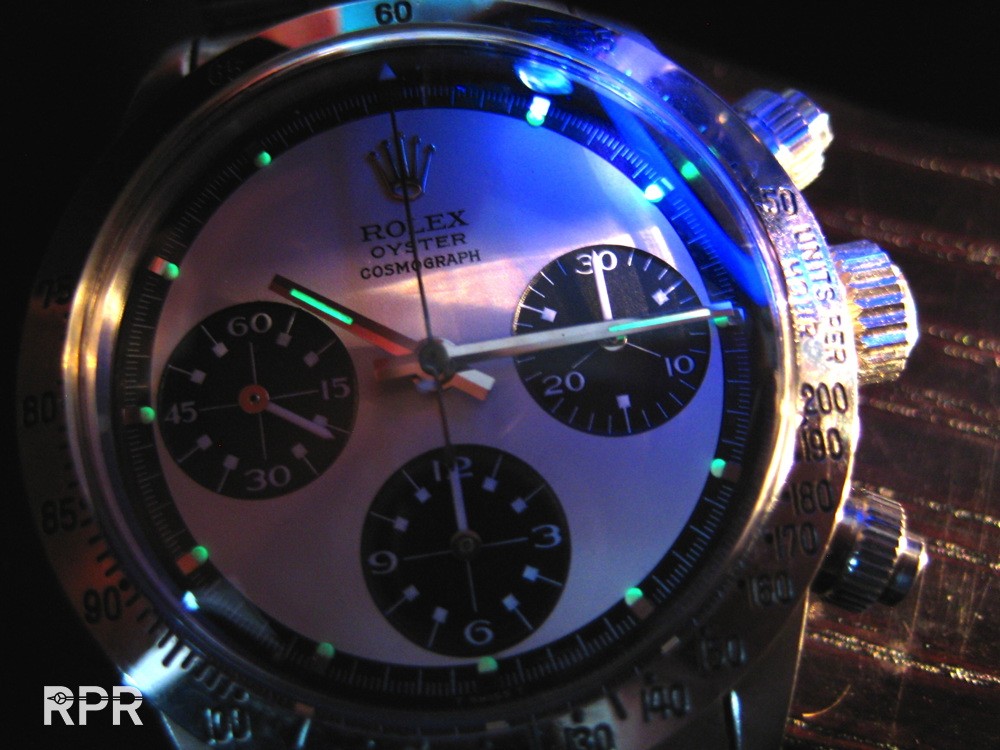
Above you see all original tritium luminous on an Oyster Paul Newman…below a sad story as the luminous got newly relumed and lost 50% or more of it’s value ;-(
What we are looking for is „matching luminous of dial and hands”, both have to be in the same color, still fluffy and undamaged. In general you can say that the correct tone on earlier radium (Pre 1964 examples) is a „cappuccino” color and later tritium (after 1964) is a bit lighter, more yellow cream. As many dials during their lives have been re-lumed (newly added luminous due to water damages or because customers wanted to see it light up in the dark again as tritium has a lifespan of 12.5 years and looses its brightness ) we often see the all over patina is not matching.
Below you see is a first owner barn find Rolex Paul Newman where all luminous dots are still in tact and the luminous of the hands are matching the dial. It’s an earlier version, notice the much thinner second hand in the 9 o’clock register and different lay out of the bezel engraving, this is one of the first ref 6239’s. 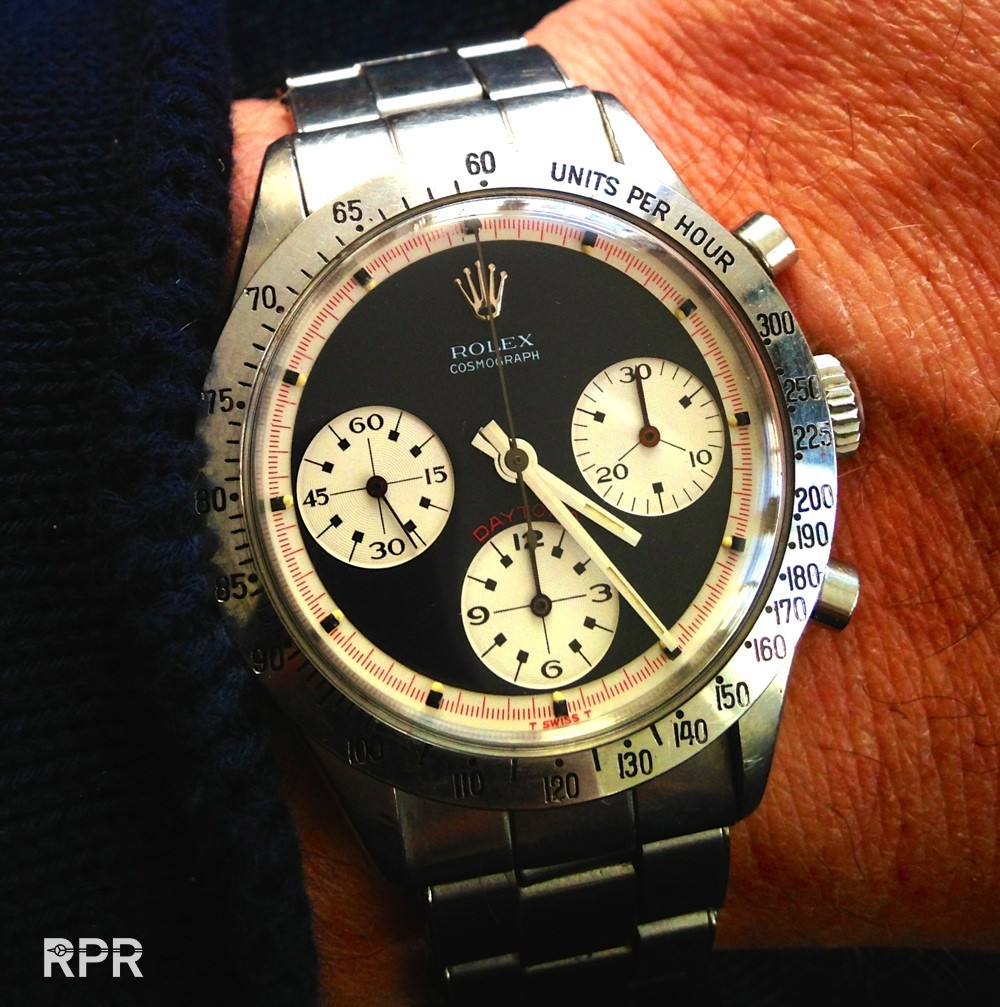
Secondly you also see black 3 color Paul Newman where one could easily say it’s the same as above but it’s not, is a later transitional ref 6262.. 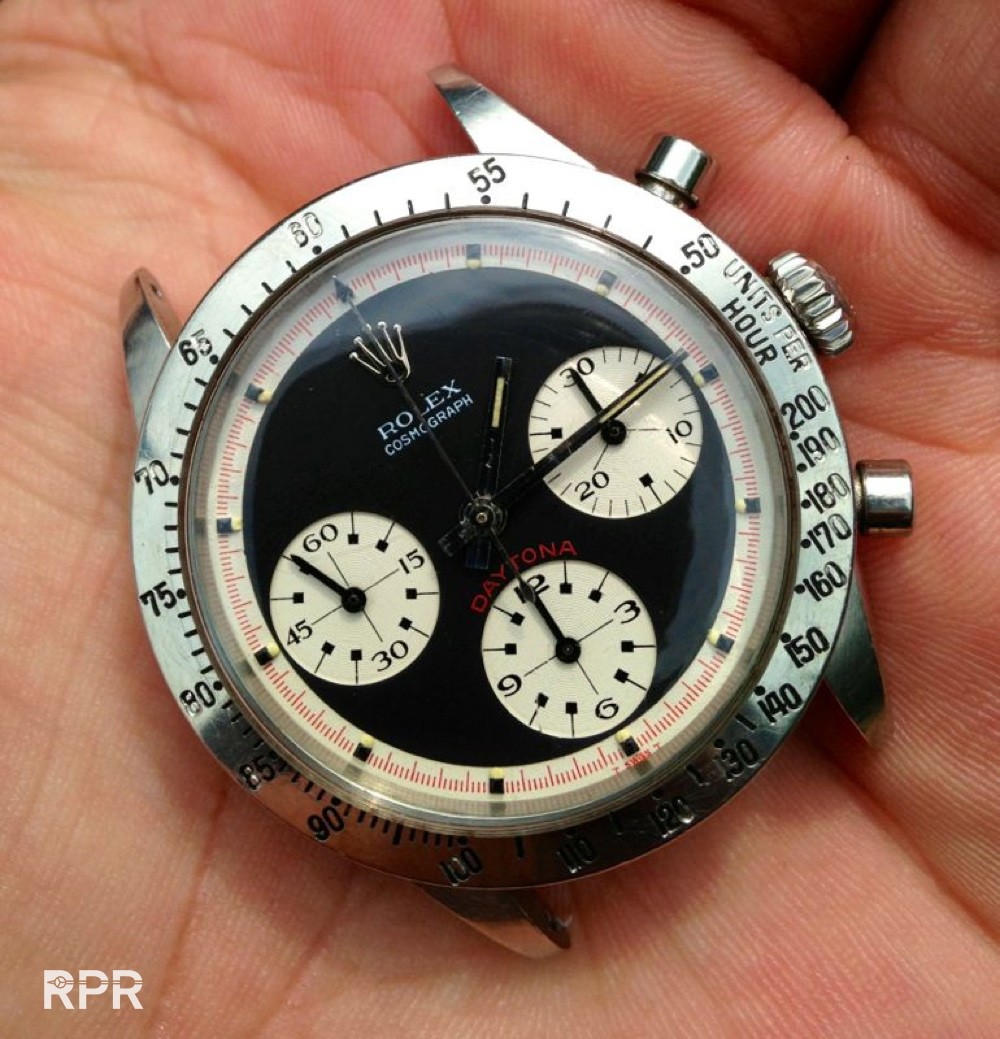 And and without the crystal…
And and without the crystal… 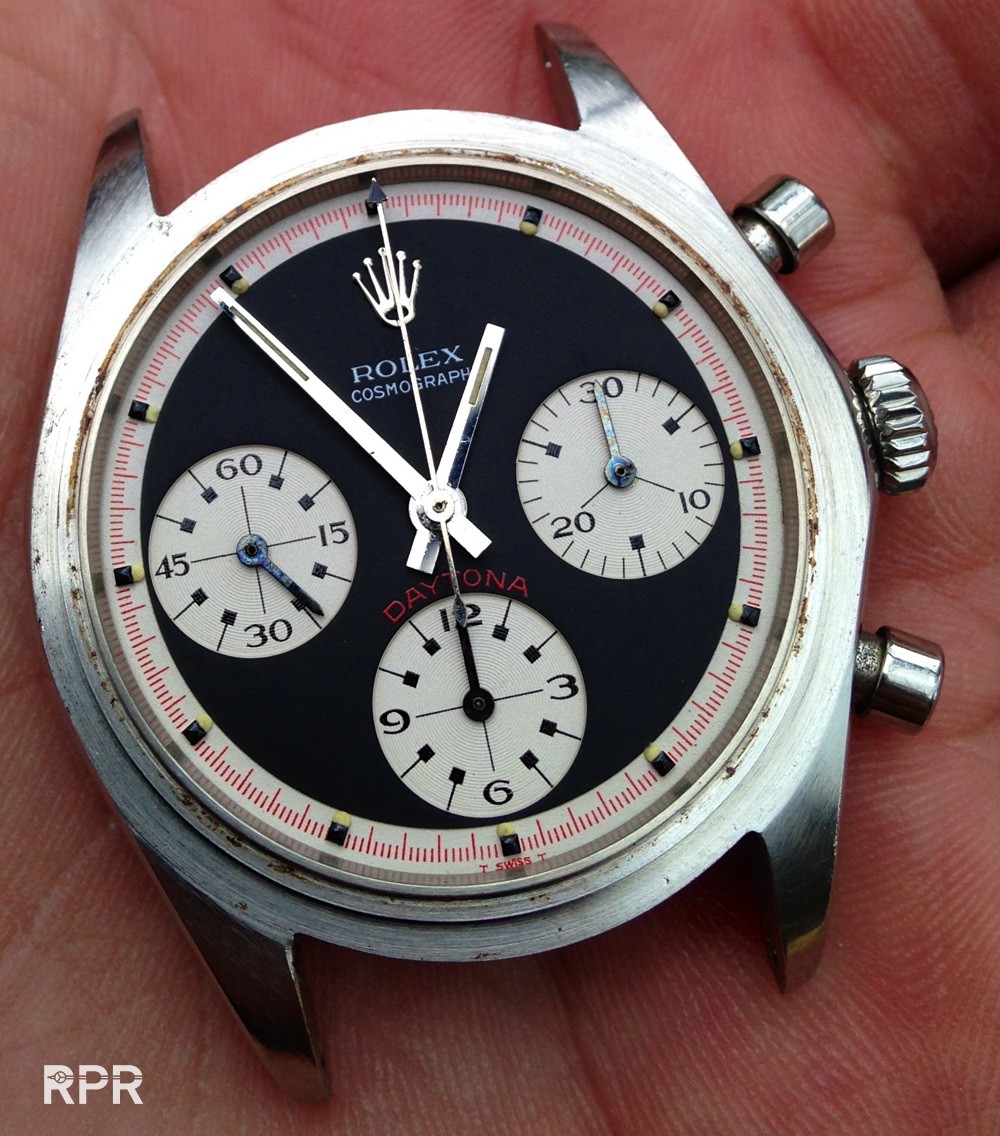
The luminous now looks newer then the rest of patina on the watch, isn’t matching the color of the hands nor does it has the same radiation as original ones. One should always focus on the luminous as this tells you what really happened with the watch you’re examining! See yourself with below luminous dots on the dial, they look non matching, are more yellow greenish, there where the tone of the hands are cream…
–> Check: “The Evolution of Rolex Luminous” 
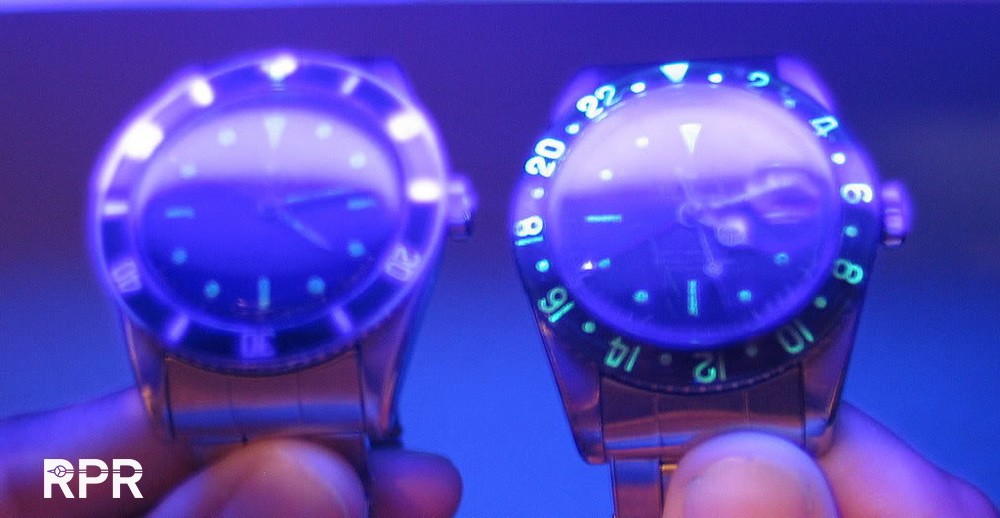
Non matching hands, you clearly see that the luminous on the dial is much lighter then we see with the hands. 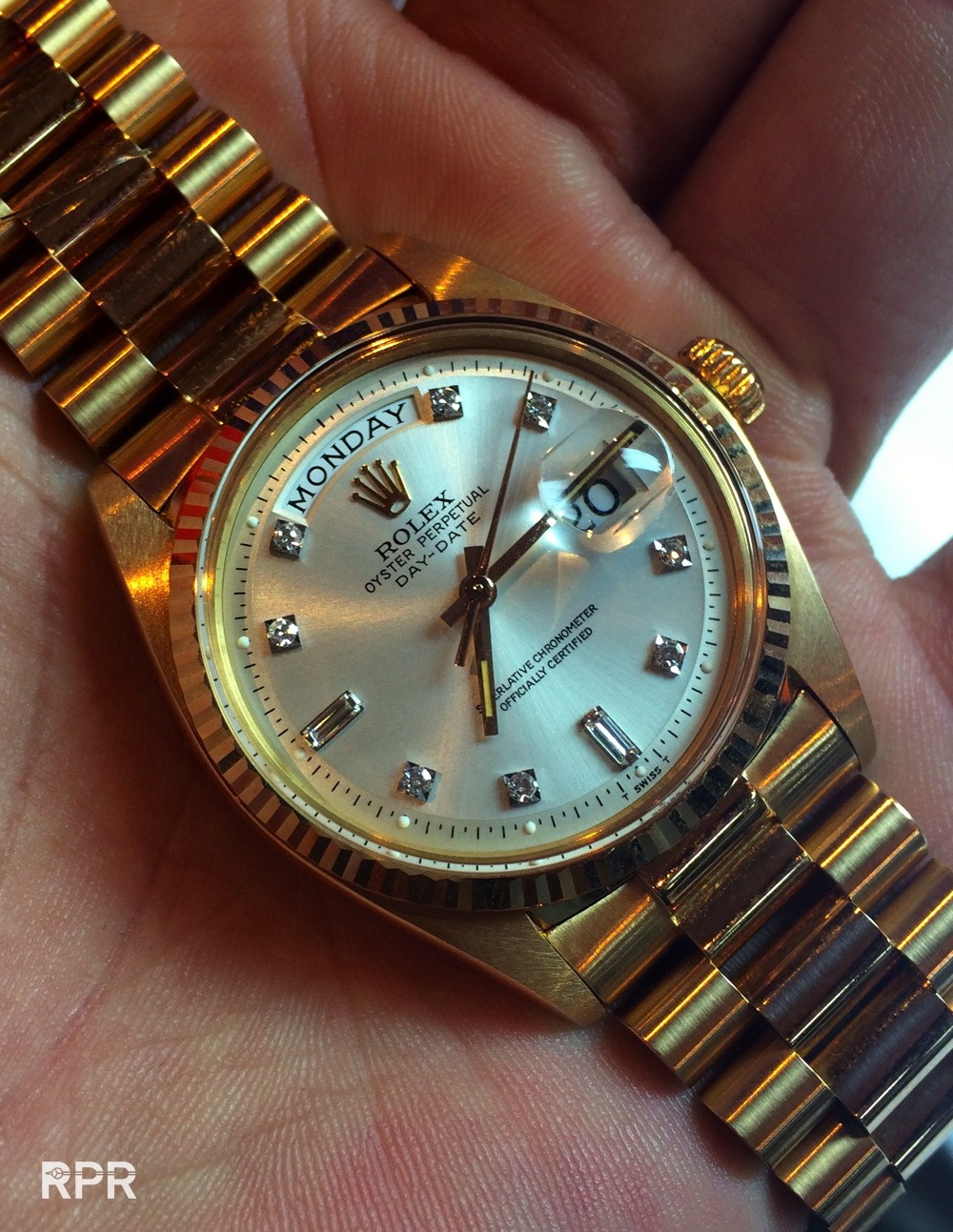 Below we see a all over matching patina on the dial and hands, after the crystal has been removed we see some dirt, that’s also located around the crown & pushers..
Below we see a all over matching patina on the dial and hands, after the crystal has been removed we see some dirt, that’s also located around the crown & pushers.. 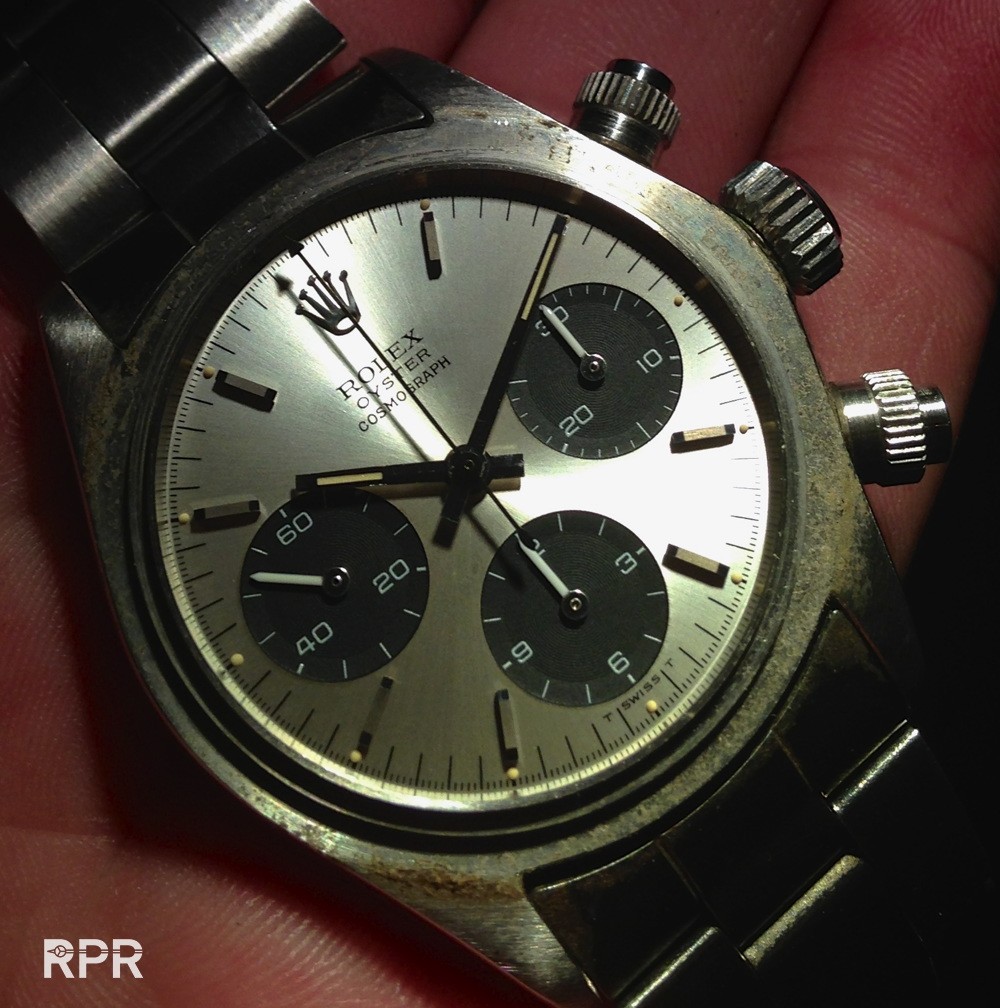
No marks on the dial, no marks on the hands near the center where a watchmaker takes them off and matching luminous of dial & hands.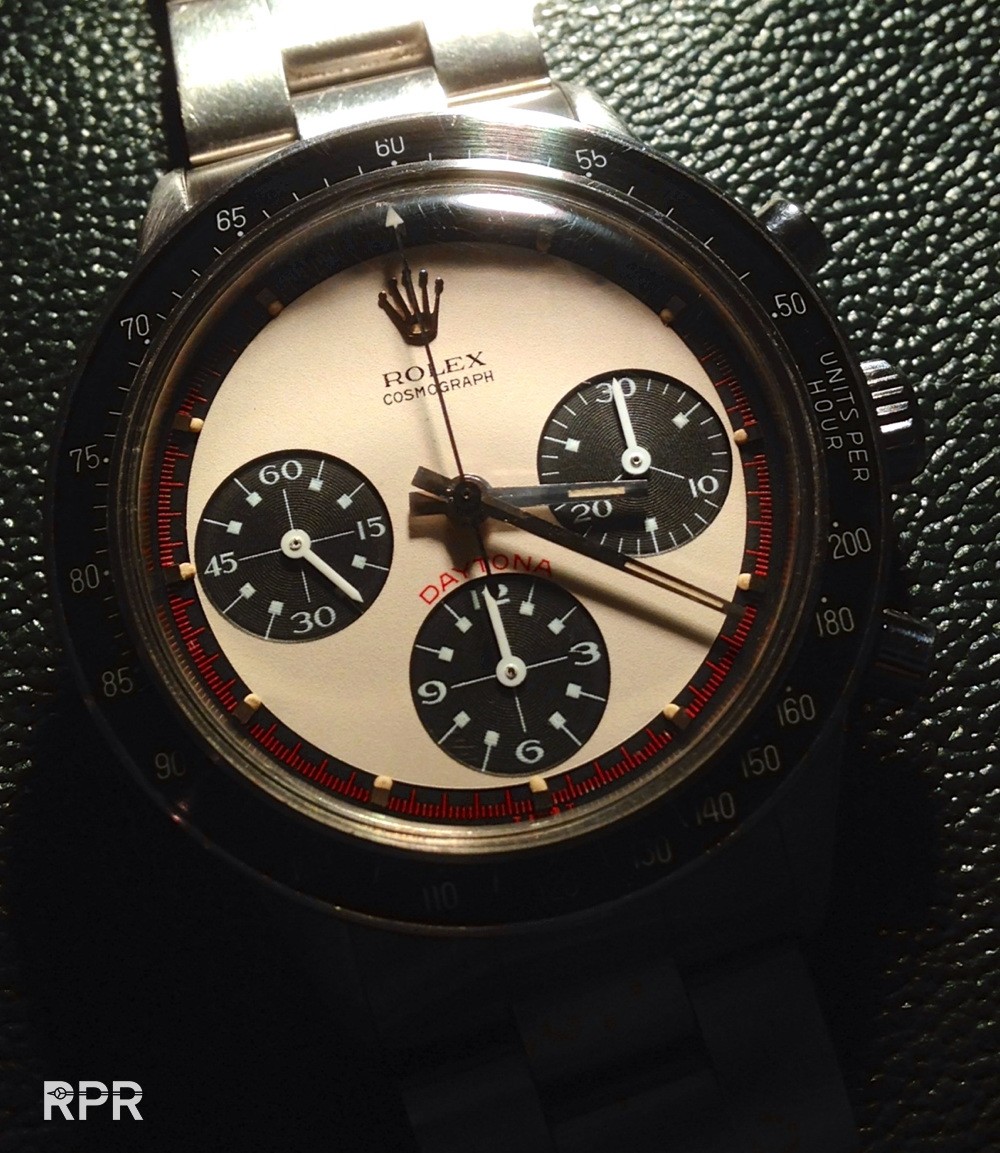
Swapped, period correct parts has become a art in the vintage watch world. It’s due to the extensive experience and knowledge of the collector or the dealer to upgrade a already nice and original watch into the most wanted “Catalogue Style”. For instance if a crisp Big Crown Submariner from second batch (1957-1959) has been found but for some kind of a reason (Rolex didn’t always deliver their watches as seen in the catalogue) it’s missing the iconic red triangle bezel, finding the correct red triangle thats matching with the all over patina of the watch is very difficult! By doing so, you change history and to me one should always save the old original part where the watch was found with and mention the upgrade when it’s been sold.
Genuine vintage parts have therefor become blue chips. An original, un cracked bakelite bezel for a early 6542 GMT Master is like 1/2 the price of the watch. An early Milgauss & Military bezel or hands or even later all red 24 hour hand, all blue GMT bezels have exploded in price due to the fact the most watches where damaged, got changed during a service or simply where not delivered back then with it as nobody really cared about these details from the way we collect nowadays. We have to realize that most of the rare watches from today where made in small batches and where not very popular in sales. It took sometimes years to sell a initial batch and therefor we see first owner watches, never been serviced but still having later parts on it. To bring it back in catalogue style has become an art by itself. I prefer the real deal, below a first owner 18 carat Paul Newman Daytona still in untouched with plenty of DNA left, all original condition..
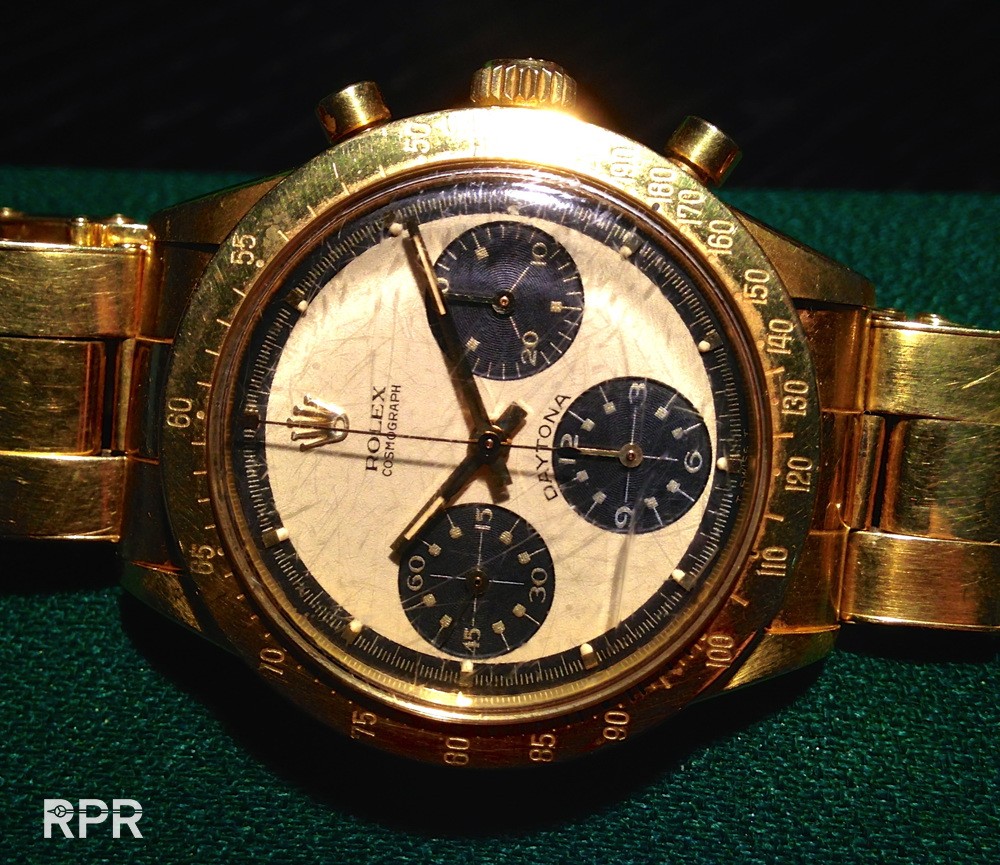
A hot topic are the so called „Tropical Dials”, dials that changed color from black to brown. I highly recommend to double check the luminous on these dials as we hardly see any truth tropicals around any more. The problem that moisture in most cases has, can become a dealer advantage as the top layer has been damaged and then chances the structure of the dial radically from black to brown. To get this damaged dial yet again attractive and all matching, dealers will re-lume it to hide the water damage. There are even watches around that have hand colored sub dials or have been put into a magnetron to speed up the process.
A true tropical dial has perfectly matching original luminous, an untouched top layer of the dial and chanced color because it used to be worn in a very sunny area and then got stored for many years in a dark place ( safe ). Up close this original tropical dial will look the same as a perfect non tropical brown, the surface is still intact, luminous is original and when you loupe it 100X you see the original one has a brown and a blackish pixel next to each other, there where artificial ones will show you only brown pixels. There’s thus a big difference between an original tropical or damaged dial, only original ones deserve a premium!
Advise: Buy yourself a regular Geiger meter (€ 150-200,=) to determine the radiation of your watch. Early 1950 watches with radium lume have a radiation of at least 20-100 Mvrs. The more we go to 1964, the less aggressive the luminous becomes, ending in 1964 when international law forbid to have more then 0.25Mvsr on radiation on a watch. I’ve written an interesting article about „transitional luminous” Rolex using Geiger meters to unravel the mystery of „The Underline”.
After we now know where to look at, by analyzing the luminous, if a Rolex is still in all original condition, we focus on the case itself. My experiences tells me that even a heavily worn watch still has its original shape. Maybe the edges are a bit worn off but generally i’m always surprised who great the shape of the case still is with a fresh find once it has been worn for like 50 years. As we hardly see these „untouched” cases any more, its logic to state that most watches have been „polished”. If you’re not yet aware about how a certain reference should look like once it’s not polished, I recommend you to take a loupe and look closely to the matt polished part of the watch. It’s with the matte parts where you can determine if a watch is polished or not.
Up and down, we see 2 x unpolished chamfers, beveled edges that are so particularity loved by vintage Rolex collectors.. 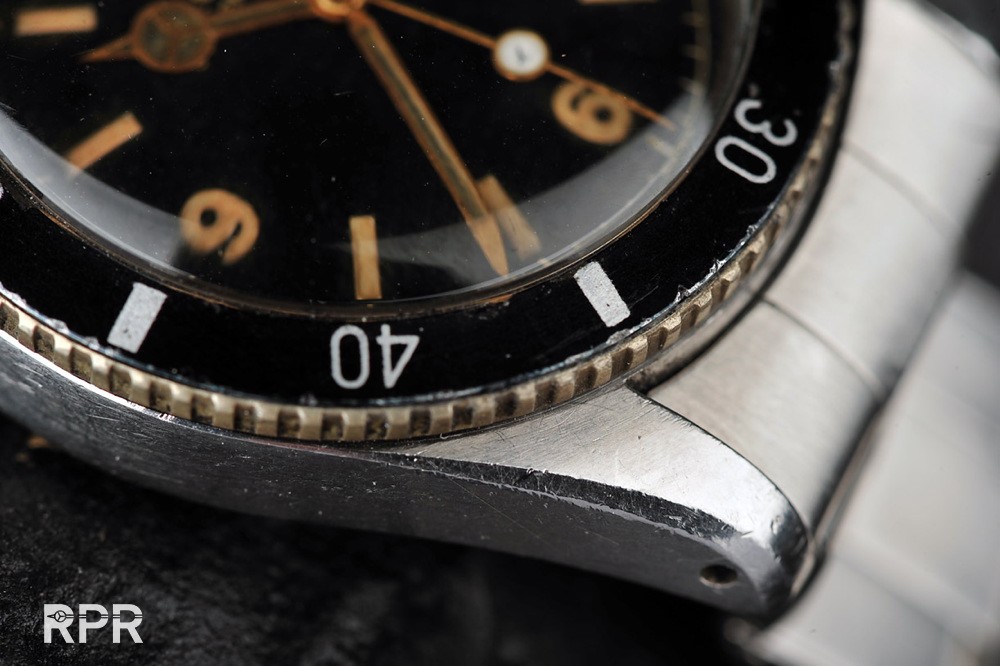
A ‘common’ Rolex reference, the Submariner ref 5513. But as it’s still in honest and crisp condition, it’s highly collectable as all the original patina is still there! 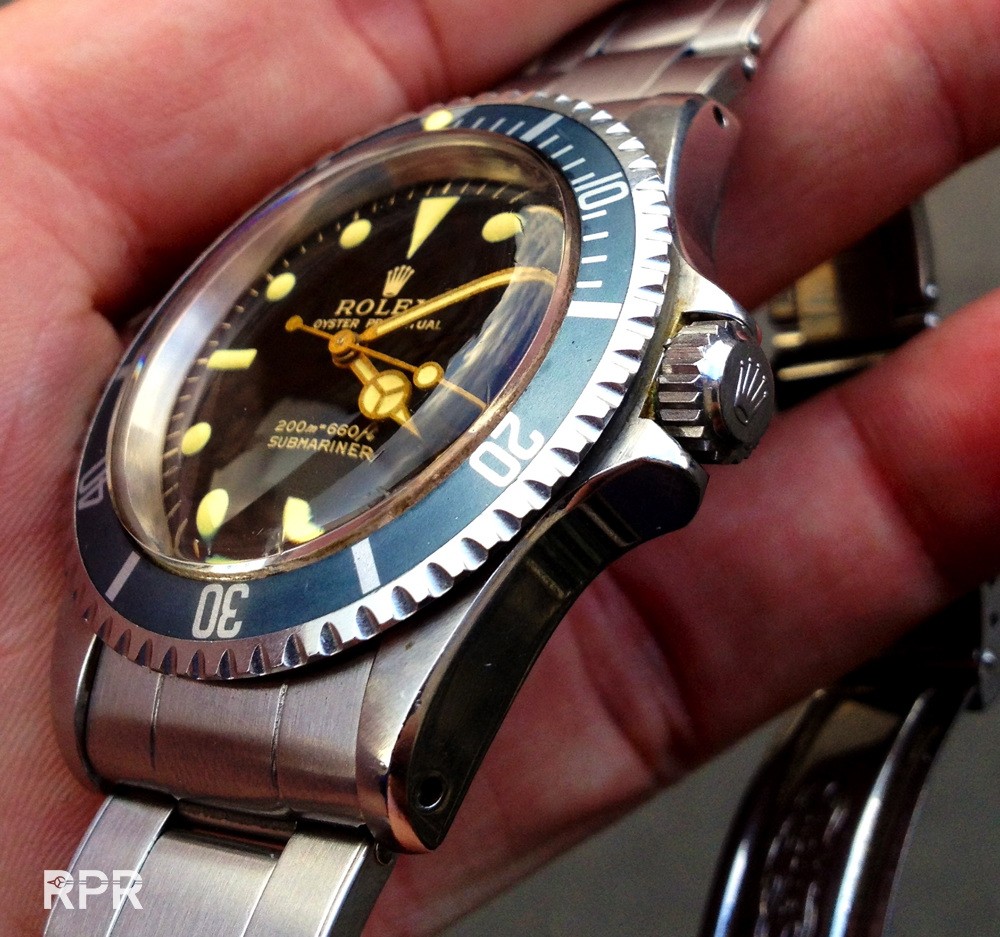
How to spot a laser welded Rolex case?
As always when you start analyzing a vintage Rolex, every small detail is important and should match the ”all over patina”. With other words, the case should have the same aging as the dial, hands and bezel. In most cases when a case welder has done his job, he merely focuses on the lugs and chamfers with newly added bevels. Don’t forget, collectors want their Rolex laser welded because the case looks very tired and worn down. Logically the rest of the watch parts will still show you aging, once the case is looking like new, you will immediately spot it’s not matching in detail with the other parts.
But what if the dial was nice and the case only needed an small surgery to become much more impressive? If it’s not obvious the parts are not matching, look closely between the lugs, you will notice that this matt area is much more „worn” then the like new lugs are. Besides that, the case holes are often newly drilled you notice when looping them up close the inside is different, missing the necessary patina and also looks new.
Next, you have to know how a NOS Rolex case looks like, what exact curve is the bevel making and how wide is it as with every reference it’s different then you can compare it. Besides the glossy finish the matt finish polish on the case is pointing you out if it’s redone or original. The light breaks differently on a matt surface that’s recently done then on a matt surface thats done 20-40 years ago. Small scratches will be on top of the matt finish and you will see a depth in it, besides the fact that the newly added polishes are never having the same structure sand lines when it’s done afterwards. Here’s a nice NOS example of how a small crown looks when it left the factory. Study the lines, polishes, curves and dimensions but most importantly, the all over condition is matching. Every single part is NOS, not only the midcase / lugs…
Find below a application patent June 11, 1963 for the GMT case with crown guards..Interesting for us vintage Rolex lovers, we see at the top that their patent at United States Patent Office got filled already on April 14th 1961 from swiss application on October 14th 1960!
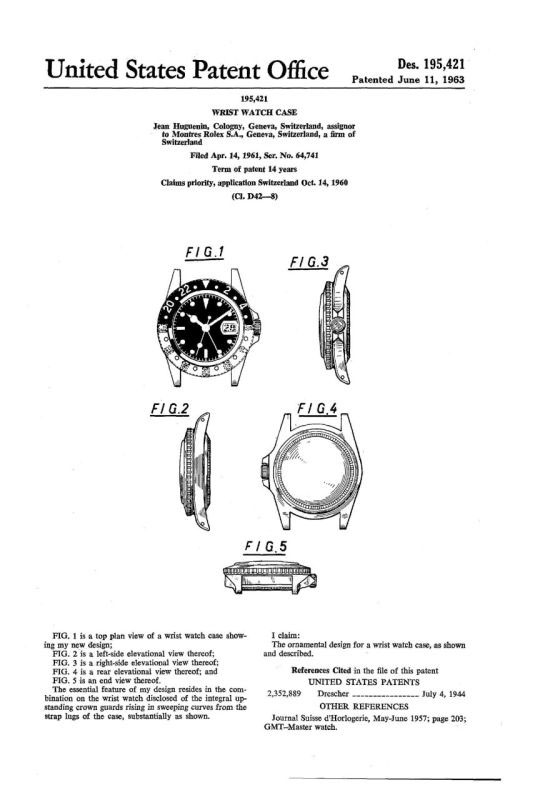
Totally fresh monobloc case seen from the back, note how sharp the rills are and the gravure of the serial and the references still are.. 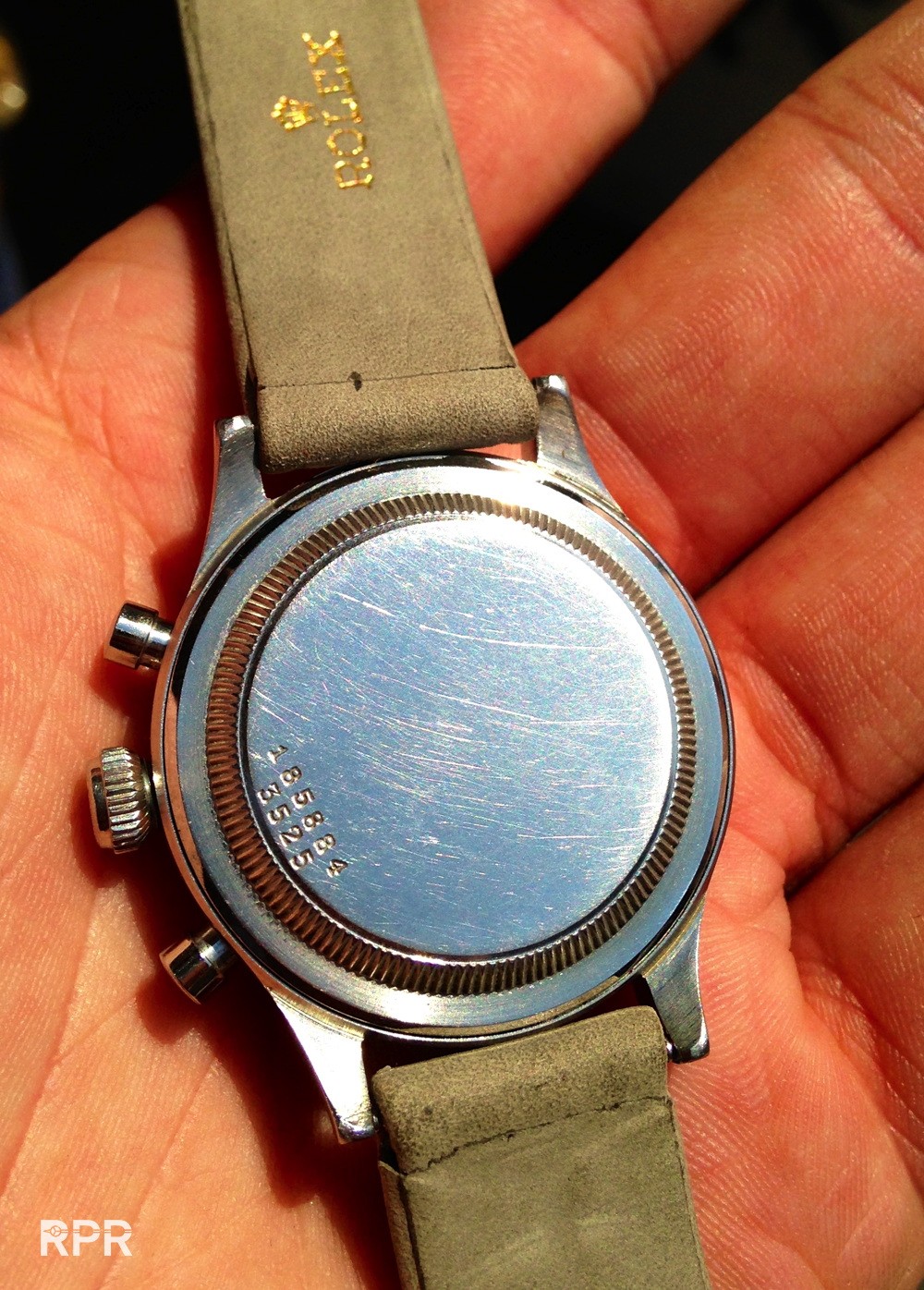
Up close you will see with a polished example that the fine lines are not perfectly straight as most likely the polished cases have been done by hand, there where the unpolished cases have a manufacture polish, done when all parts aren’t yet assembled and always the same, in 1 go. The next important feature of a polished watch is that at first the case looks nice but the engravings made mostly in the case back are worn out, polished out. Again this is what I mean with „matching all over patina”.
For instance, it doesn’t make sense when the hands are luminous and the dial is not, the bezel is faded but the case looks like new or the crystal and pushers are of a later service type nor a newly fresh engraved „Asprey” stamp while the rest of the Rolex engraving is all worn out or you notice that a scratch on the case back is under the gravure while it was delivered with the gravure but now seems to be added later. Sometimes common sense will help you out when you doubt. The bezel is worn but the case isn’t or the crown and pushers are new where the case isn’t , etc.
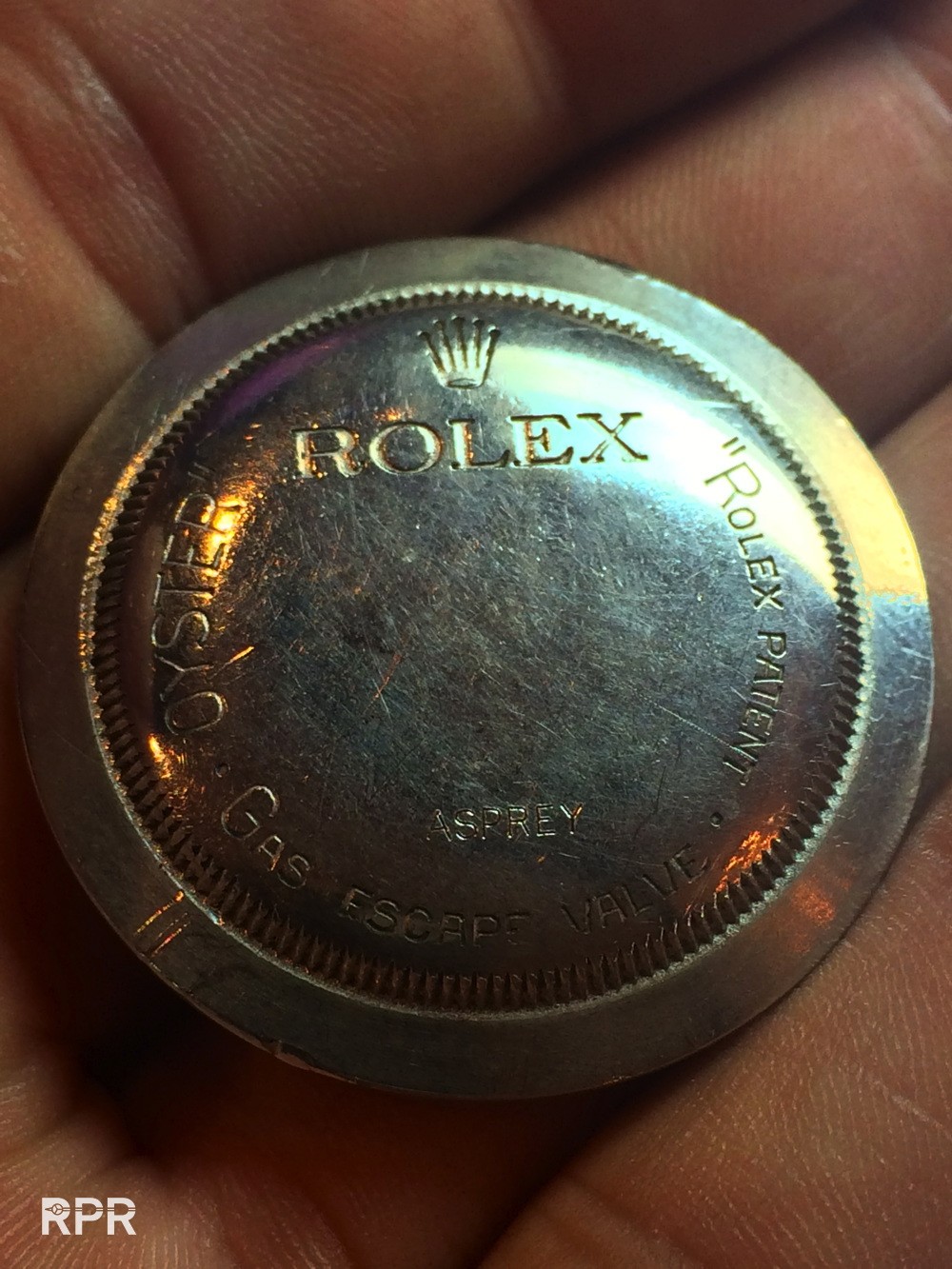 Newly unoriginal lasered Military Submariner engravings…
Newly unoriginal lasered Military Submariner engravings… 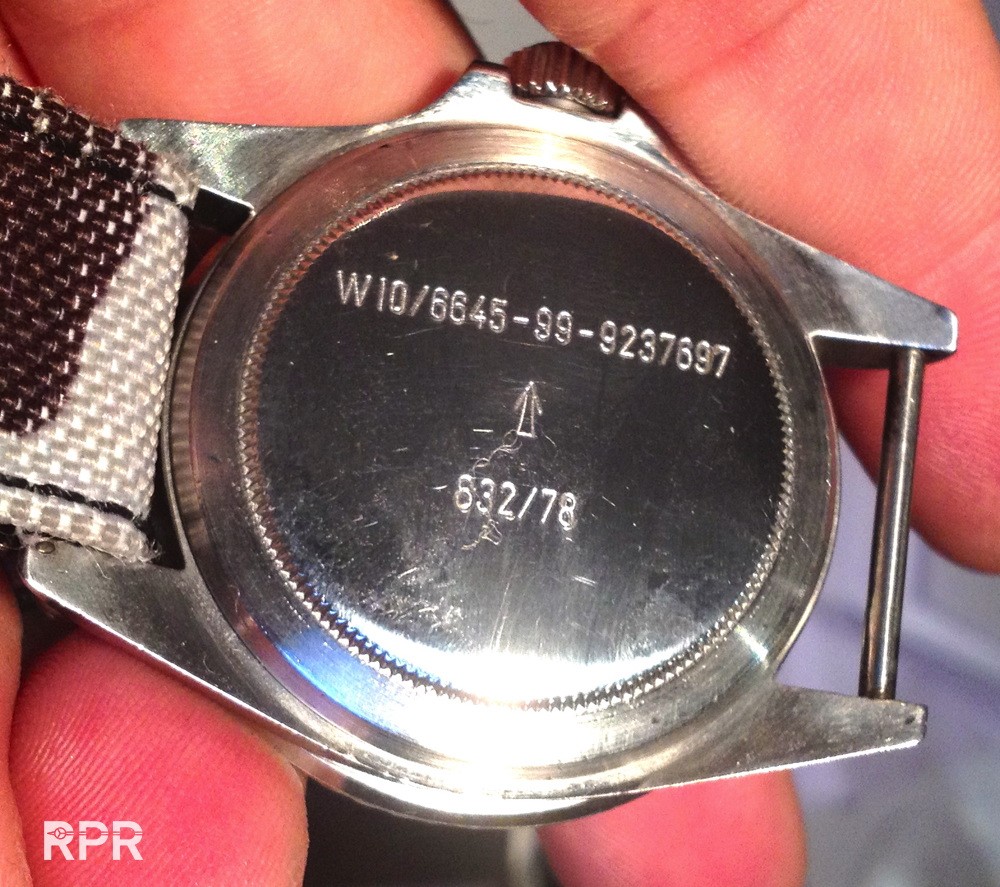
During the years many cases, specially gold ones, got hallmarks or import – export stamps. If these little stamps, mostly hidden in the back of the case lugs or on the sides of the watch, are worn out and the rest of the case if looking perfect at first view, one can easily state the case has been polished. The same we see between the lugs, where bracelets with their end links always leave visible marks. A fresh looking engraved serial number and reference number, we find with Rolex between the lugs, can point you out that the watch hasn’t been worn a lot as the end links didn’t scratch the surface due to friction. I specifically add this remark as nowadays we see cases been „laser welded” ( steel or gold is added to the worn case by laser and afterwards polished in catalogue style). Besides the part between the lugs looking ’tired’ where the case looks brand new, sometimes the push pin wholes having a different drill can show you the case had a laser job done. Here some examples of un polished cases, some showing the original still fresh engravings and hallmarks clearly…
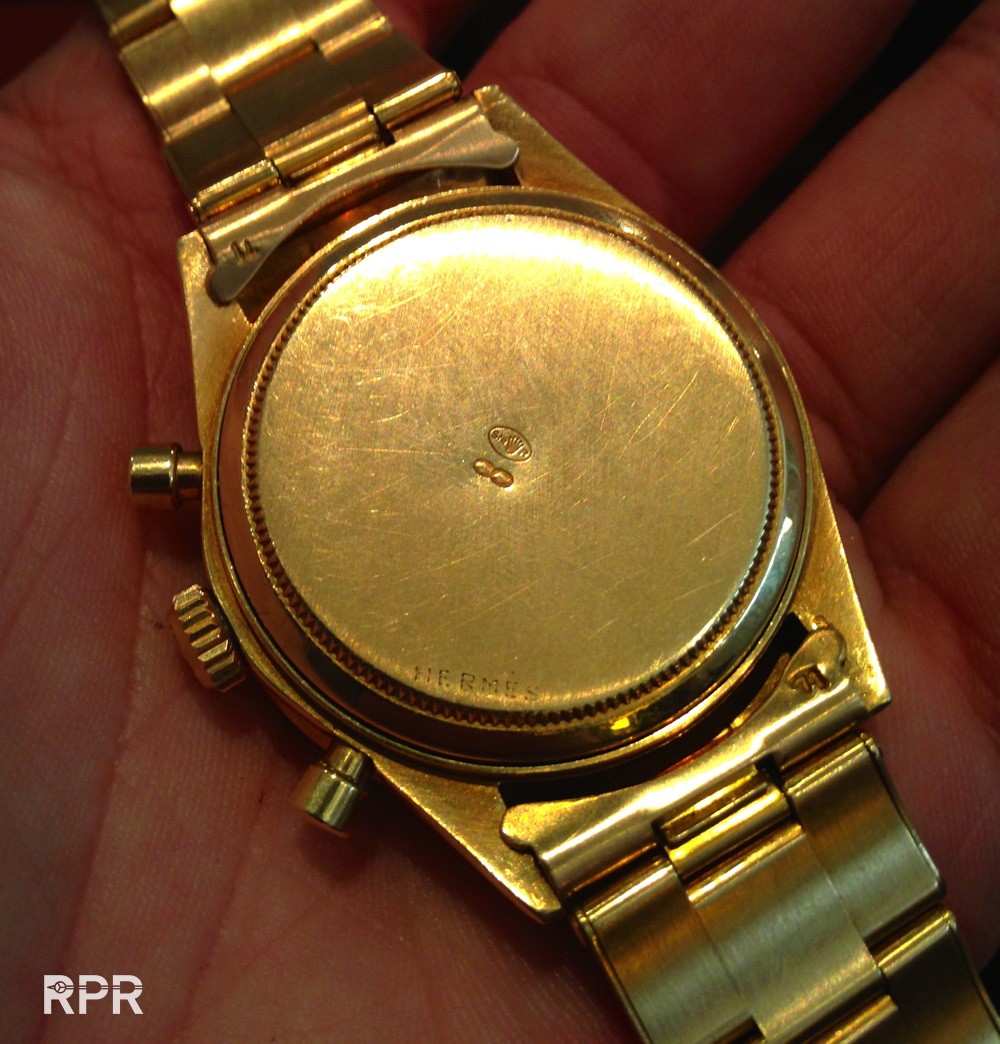 Above the french hall marks in the middle and the Hermes ( from Paris ) engraving on the side of the case back..
Above the french hall marks in the middle and the Hermes ( from Paris ) engraving on the side of the case back.. 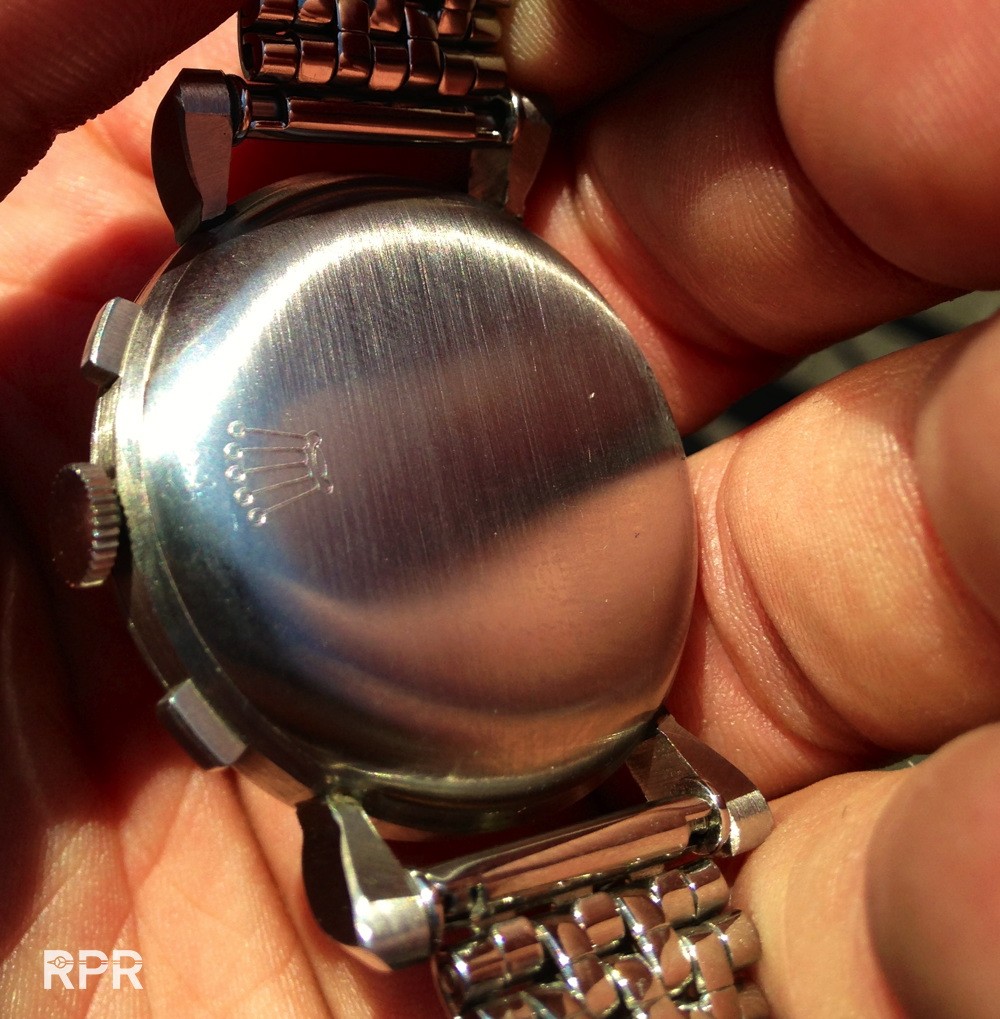 Ultra fresh and unpolished early Rolex chronograph. It’s a time capsule that seems to be unworn even after some 75 years!..
Ultra fresh and unpolished early Rolex chronograph. It’s a time capsule that seems to be unworn even after some 75 years!.. 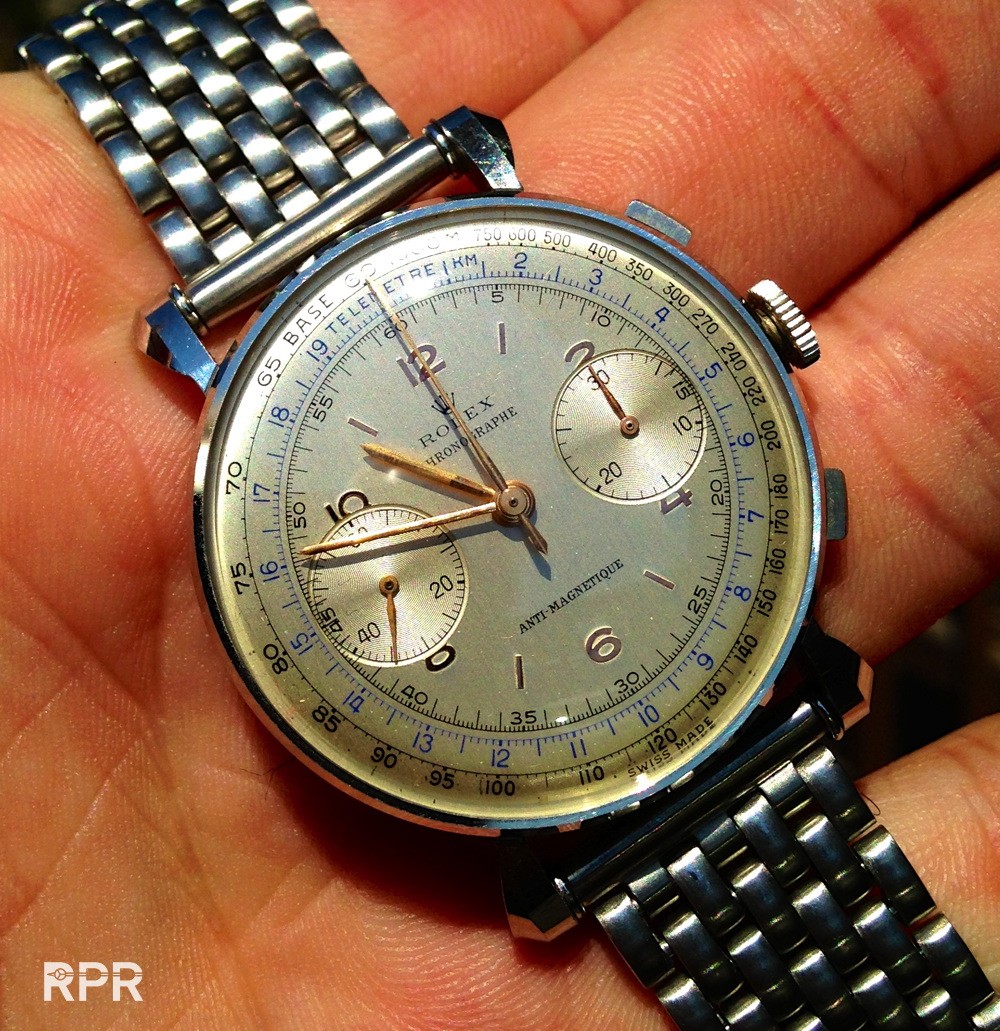
Crisp time only super elegant big size Rolex Precision..
Registered Design & Model Depose engraving still clearly readable on this pink gold Rolex Killy.. 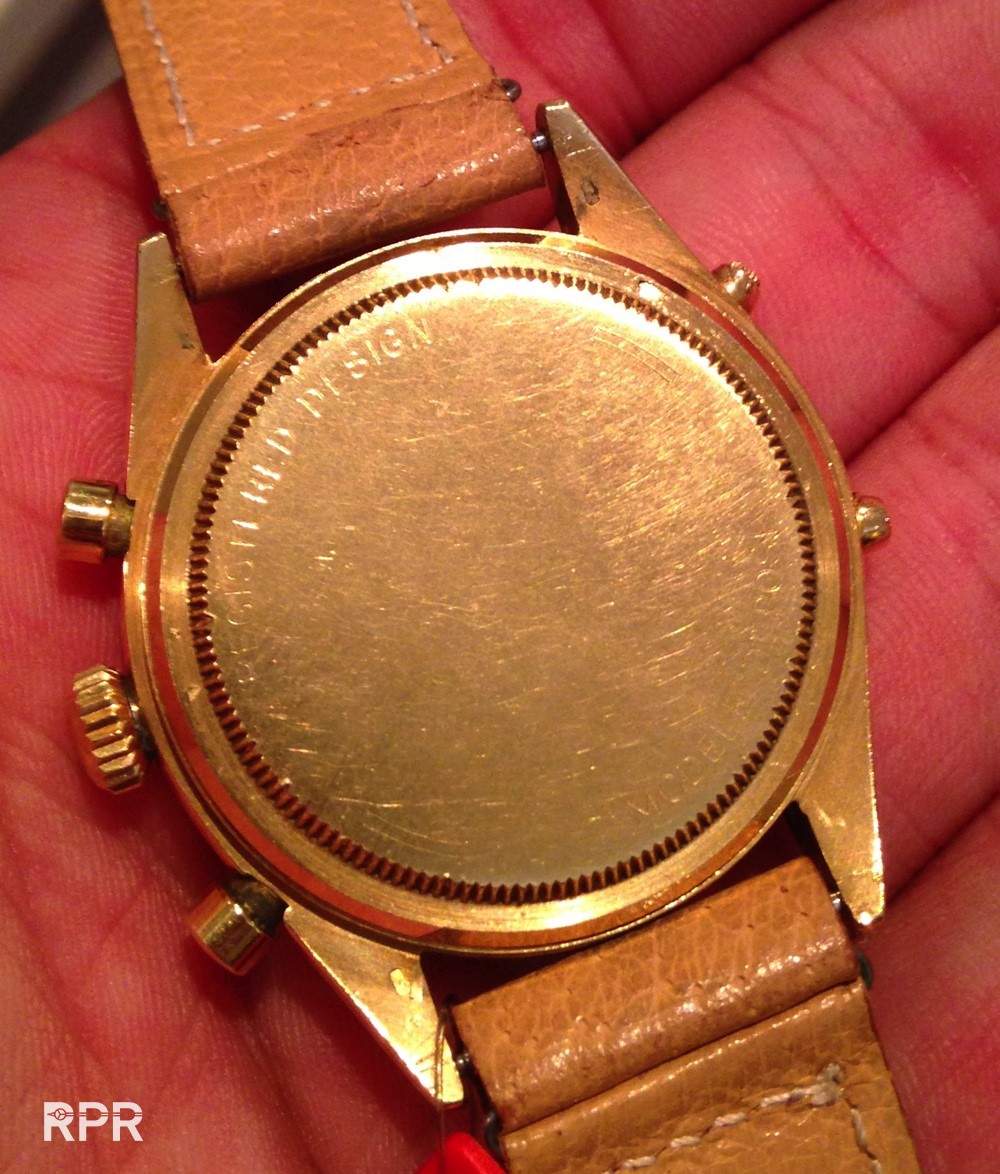 Fresh hall mark on the sides of this unpolished pink gold Padellone ref 8171…
Fresh hall mark on the sides of this unpolished pink gold Padellone ref 8171… 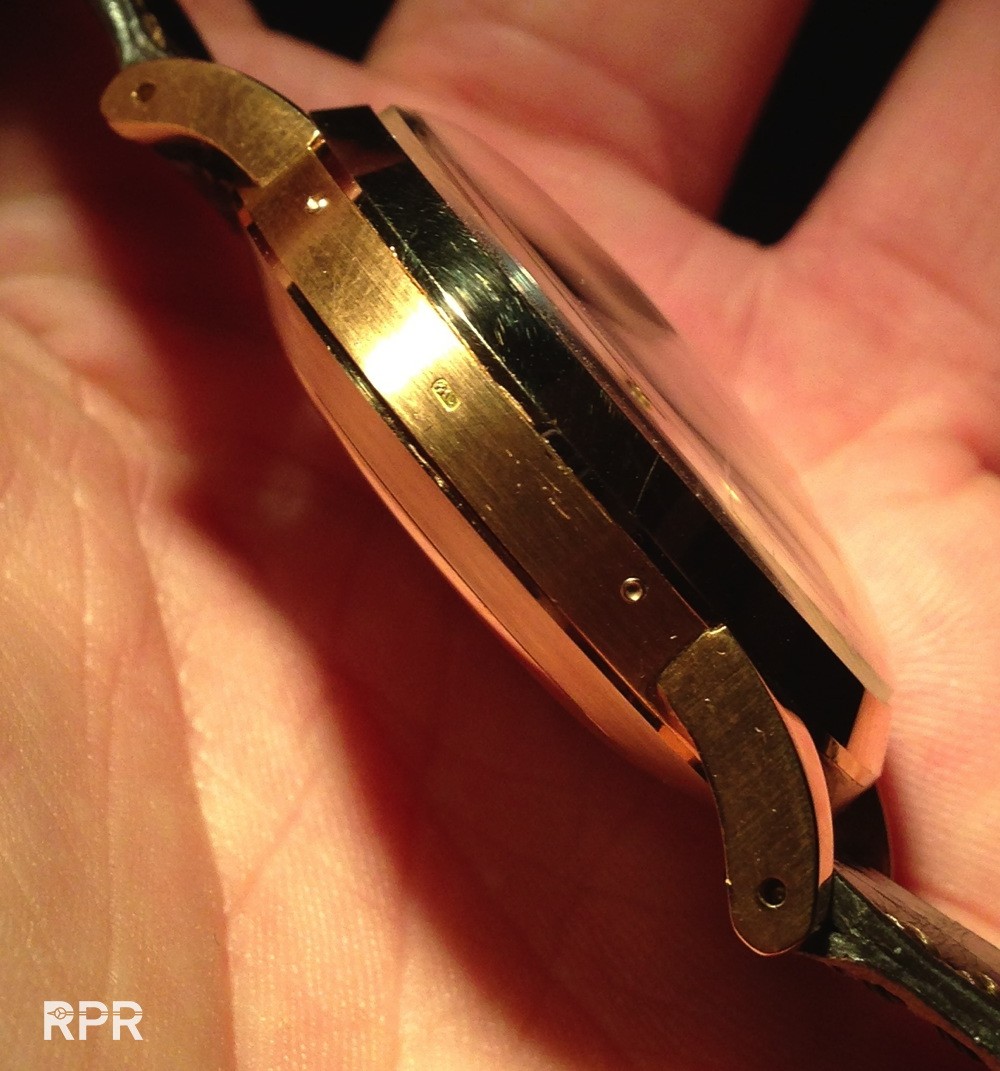
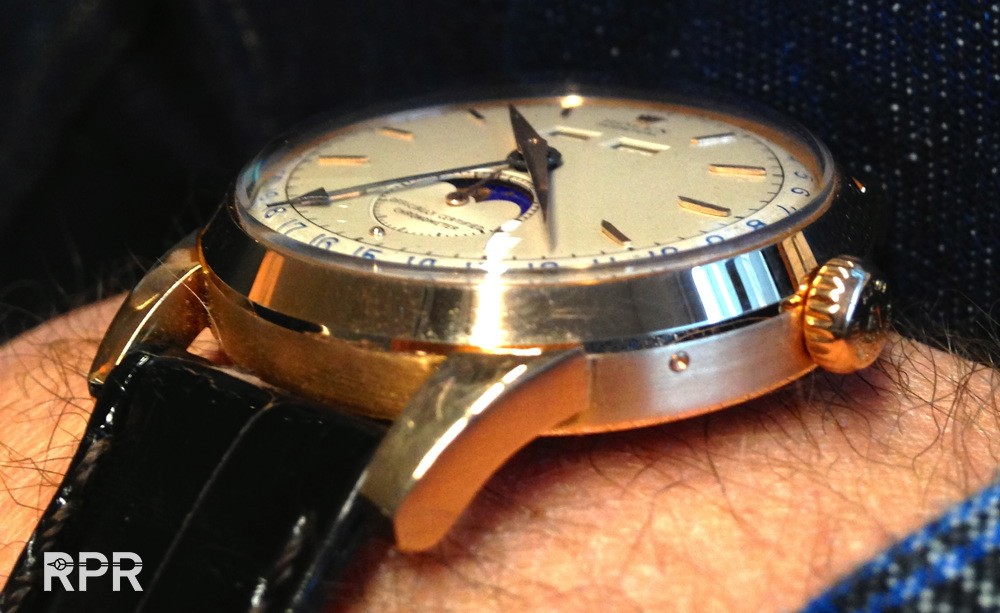
The Rolex stamps & 18 carat hall marks spread over the 3 of the 4 lugs insides… 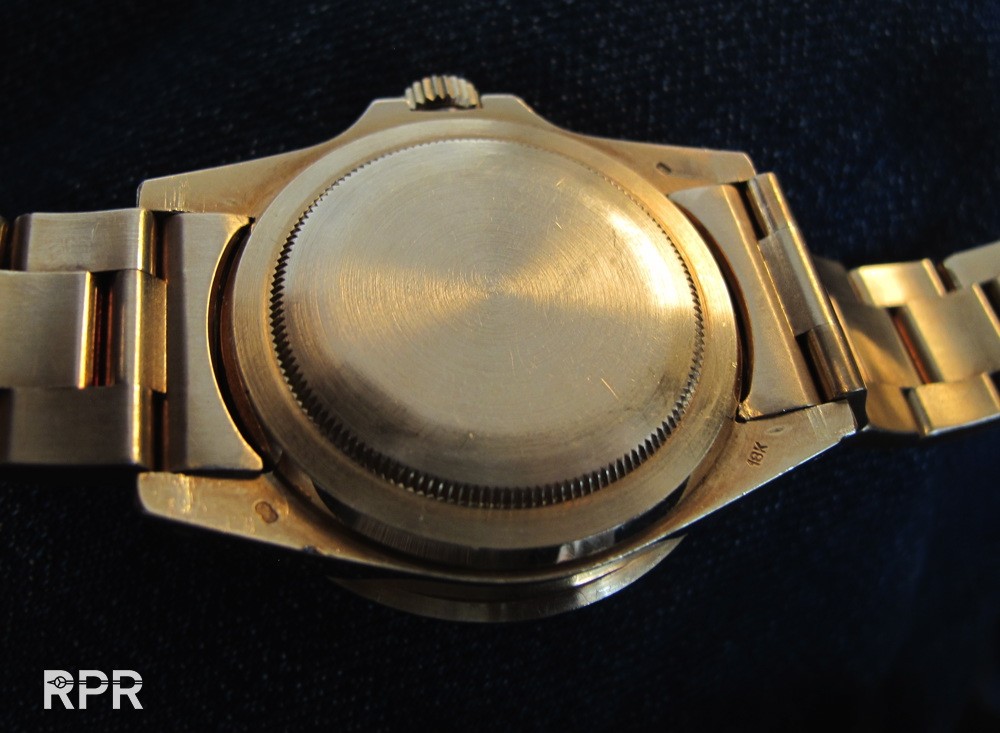
And although it’s not the rarest gold Submariner as it’s the second eerie with Feet first, ref 1680, it’s the condition that makes it collectable!.. 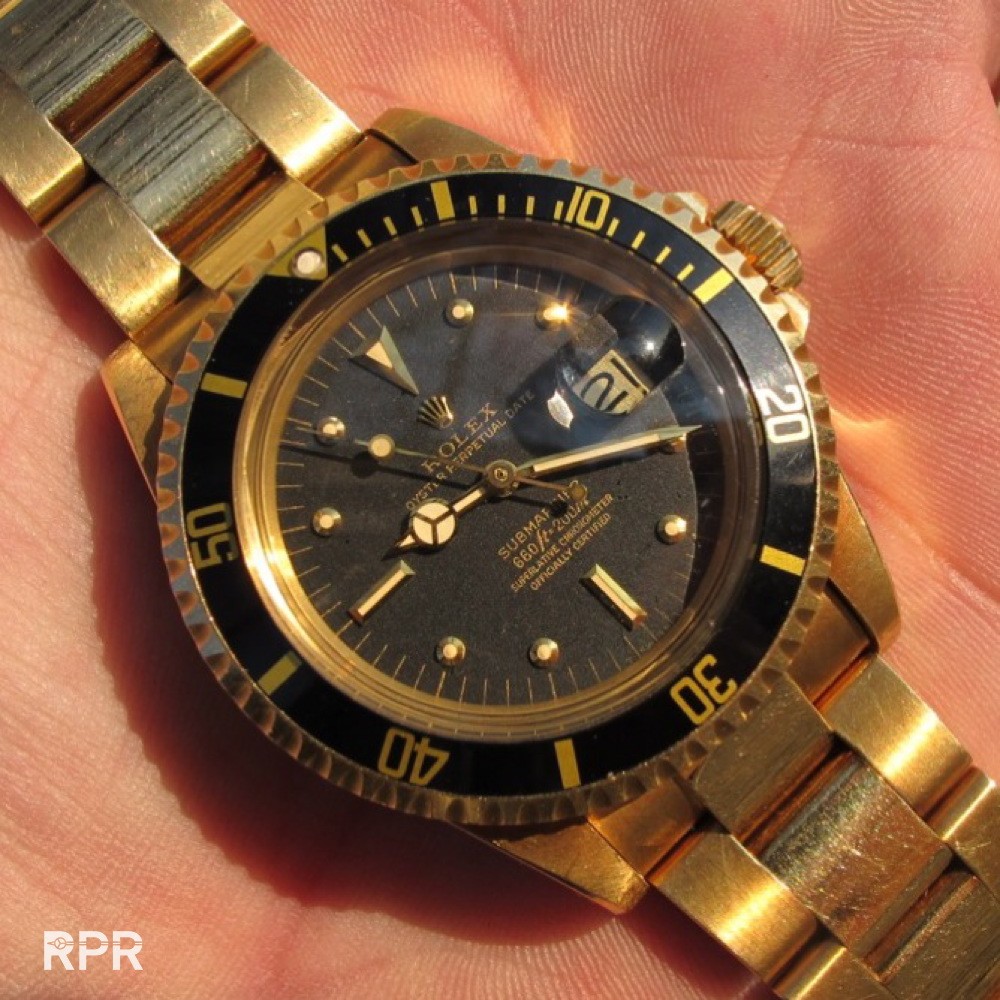
Case back inside of a freshly found Rolex 6062 stelline. Notice the small watch maker mark at 12 o’clock.. 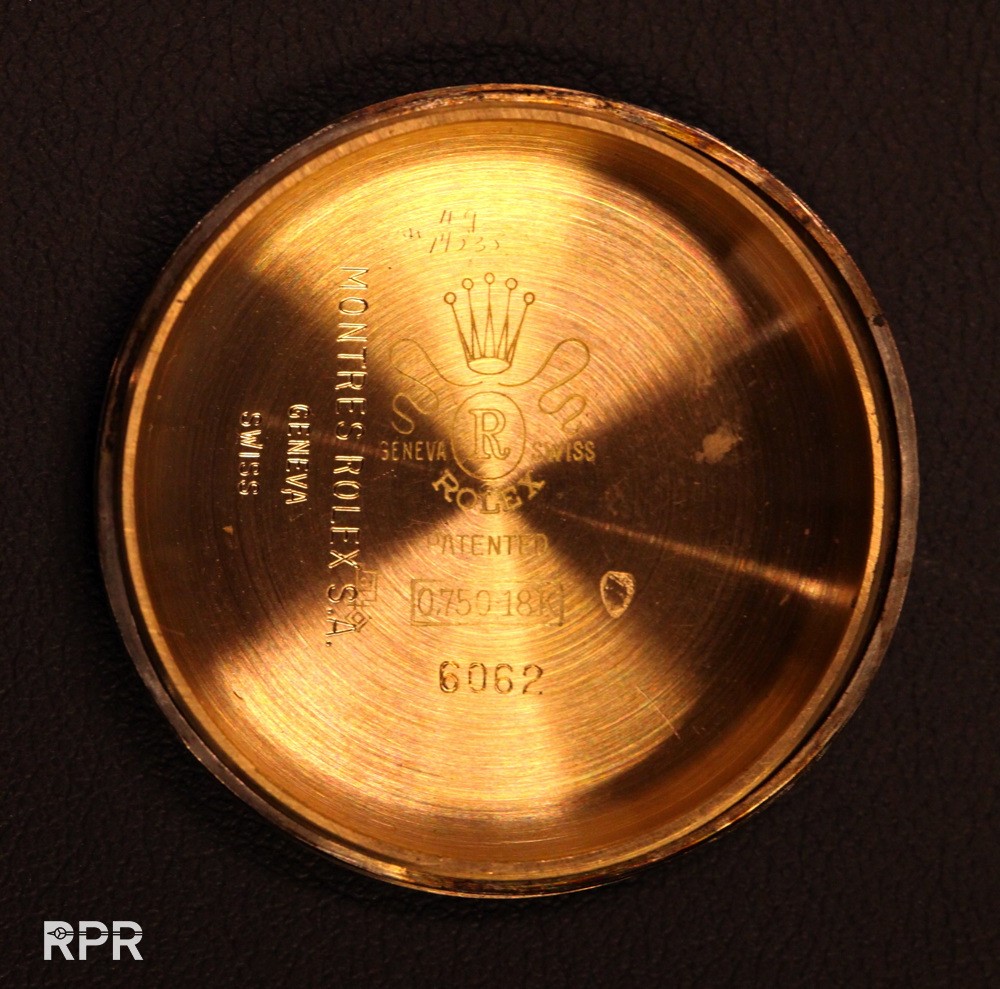
Each Rolex reference had it’s own specific Rolex logo & reference number inside their case back, up till like 1966/67 we also see the date added once left the manufactory. As most Rolex are perpetual calibers, you can spot a worn out automatic rotor leaving marks in the case back. Also individual service codes are always engraved by the watchmaker… 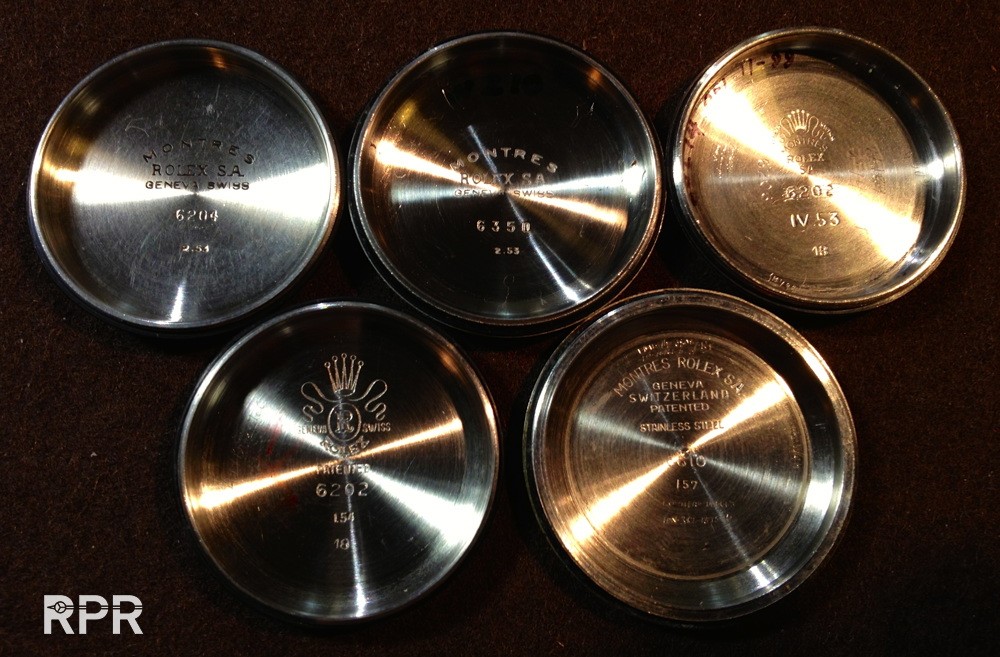
Advise: Buy yourself a professional loupe with 10 x magnify, I recommend the Zeiss Loupe you can get at your local optician or easily purchase at a stamps shop. Always loupe with both eyes opened, don’t close the one you’re not using. Never use a loupe that has an integrated lamp or violet light, it will damage your eyes.
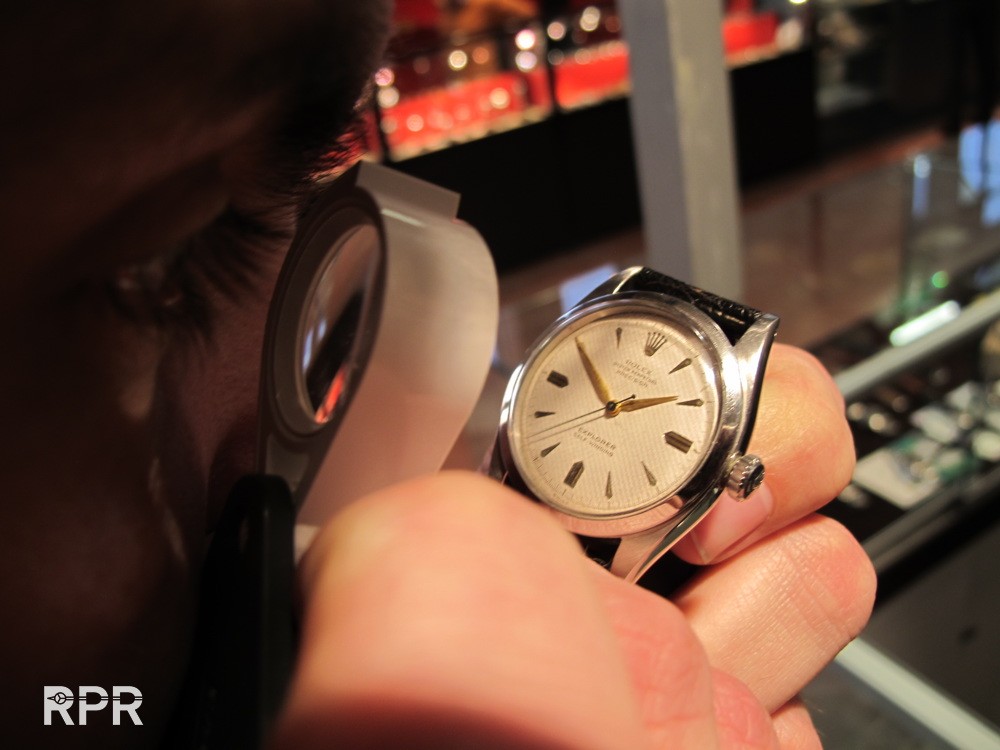
The movement has become secondary in watch collecting the last years of grande revival. Funny enough when you think about a watch, logically the movement should be what it is all about. When watch collecting started long ago, the focus was always on highly complicated movements, built in pocket watches and later after WWII commonly in wristwatches. We still see that the old school collectors are merely interested in a rare version of hardly seen complication but generally the new way of collecting has changed dramatically. Now it’s the face and it’s uniqueness next to the preservation that became popular. New buyers enter the market and are solely interested in building up a collection of very nice looking, iconic wristwatches.

The push in price we noticed on the Daytona since some 2 years is amazing. A Paul Newman Daytona or Killy DatoCompax using a non Rolex modified Valjoux caliber have broken every record. There where an iconic small or big crown Submariner, Milgauss, Explorer, Day Date or GMT master with in house Rolex manufacture movements don’t reach the same level yet. This will most likely happen soon because Rolex’s innovative spirit and magnificent heritage lies in the references that are totally designed by them, including the movement!..
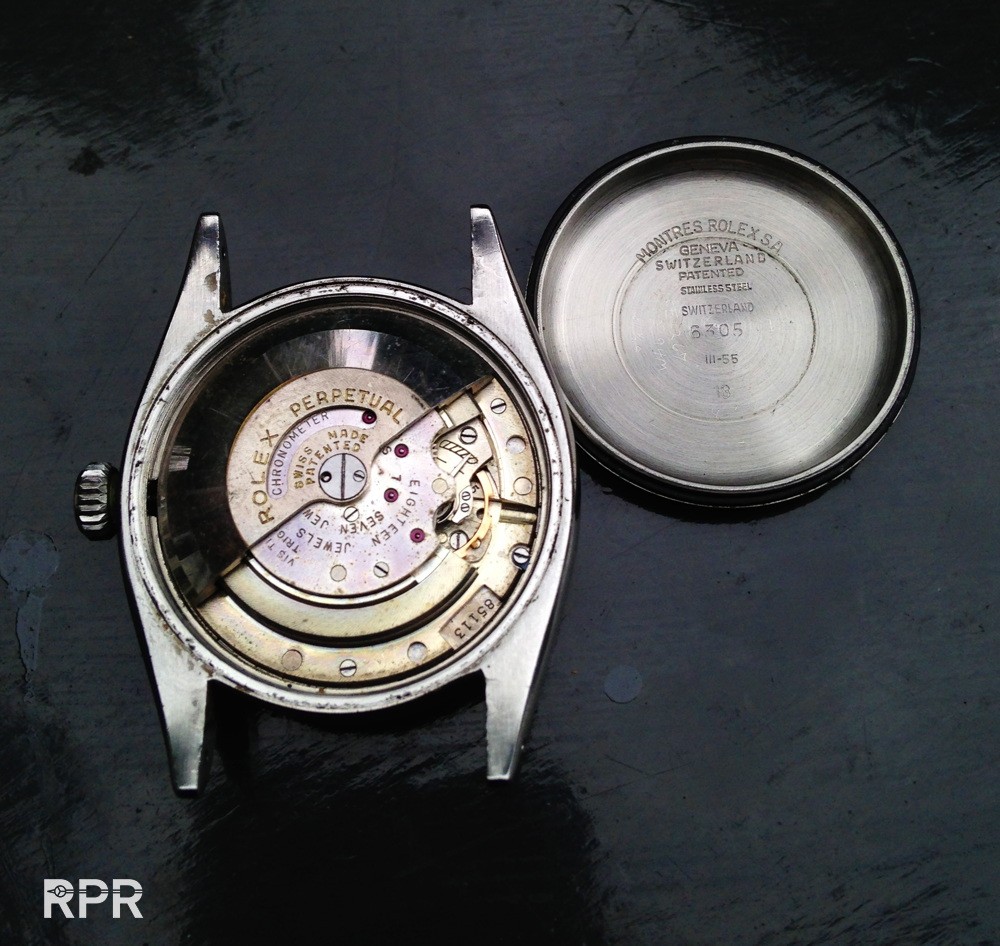
The patina on the top of the movement should match with the rest of the watch, if you see a clean case, most logically the movement will also be clean when you open the back. My tip is to check the most commonly used parts up close and see how their condition is. With other words, to get the movement out of the case one needs to unscrew the crown and the movement plates at the edge that are holding the movement tight in the case. When you notice that the screw to release the crown, mostly located near the 3 o’clock opening where the crown goes into the movement, is damaged on the surface, it means it has been taken out a lot. A not so precise watchmaker probably used the wrong screwdriver and damaged the top of the screw and the surrounding of the plate. The same you check with every screw visible from the top. Water damage will oxidate the movement making it look brownish and dirty. Here it helps to analyze NOS ( new old stock ) movement pictures to get an idea how they looked like. As most Rolex are waterproof, using the Oyster concept, the screw thread thats attached on the case back will reveal you heavy use or not. Any watchmaker who serviced a watch made his marks engraved in the case back, spotting many of those individual codes will tell you it has been serviced a lot.
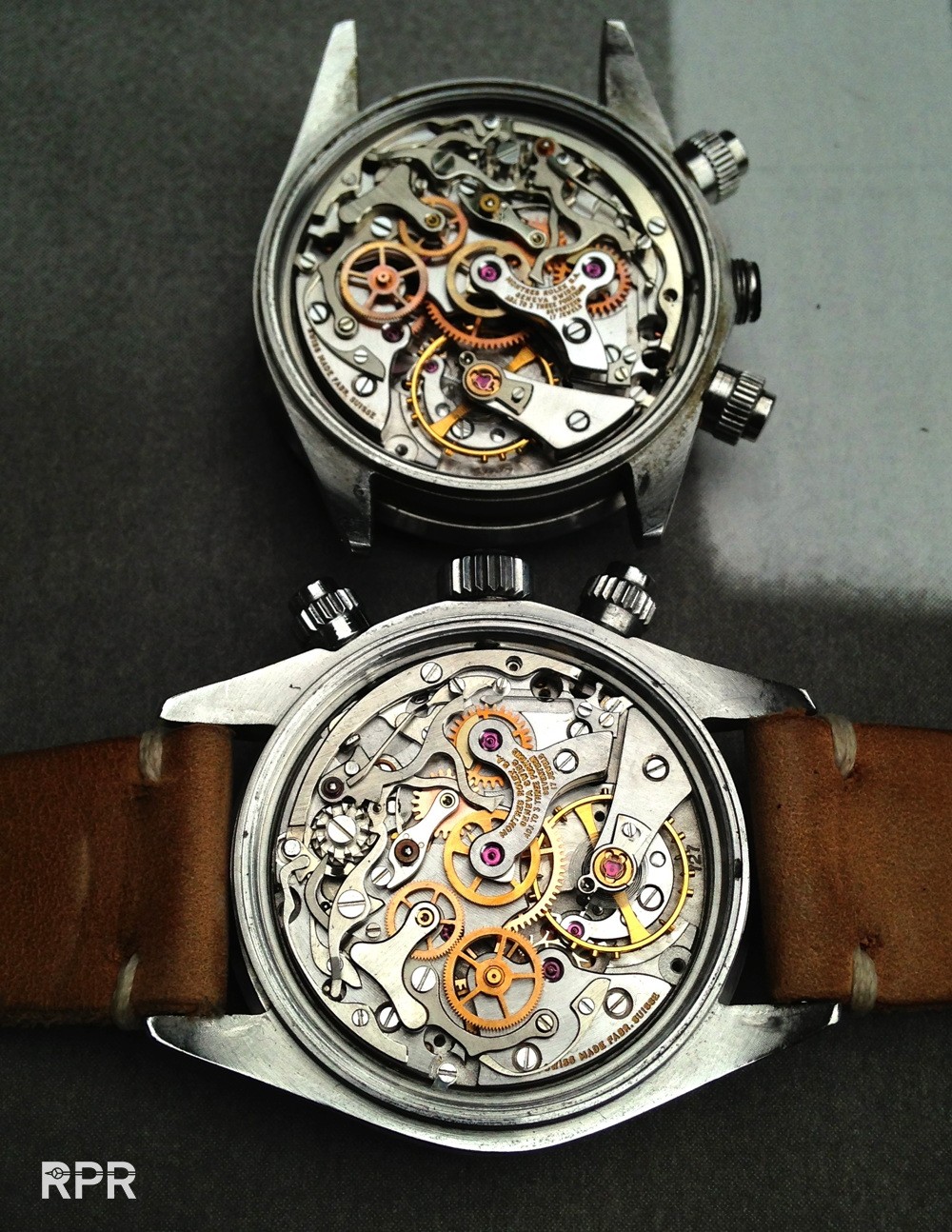 Below Submariner movement, caliber 1560, is still having it’s original rotor..
Below Submariner movement, caliber 1560, is still having it’s original rotor.. 
Up close, the reference number, below the Brevet + marking. 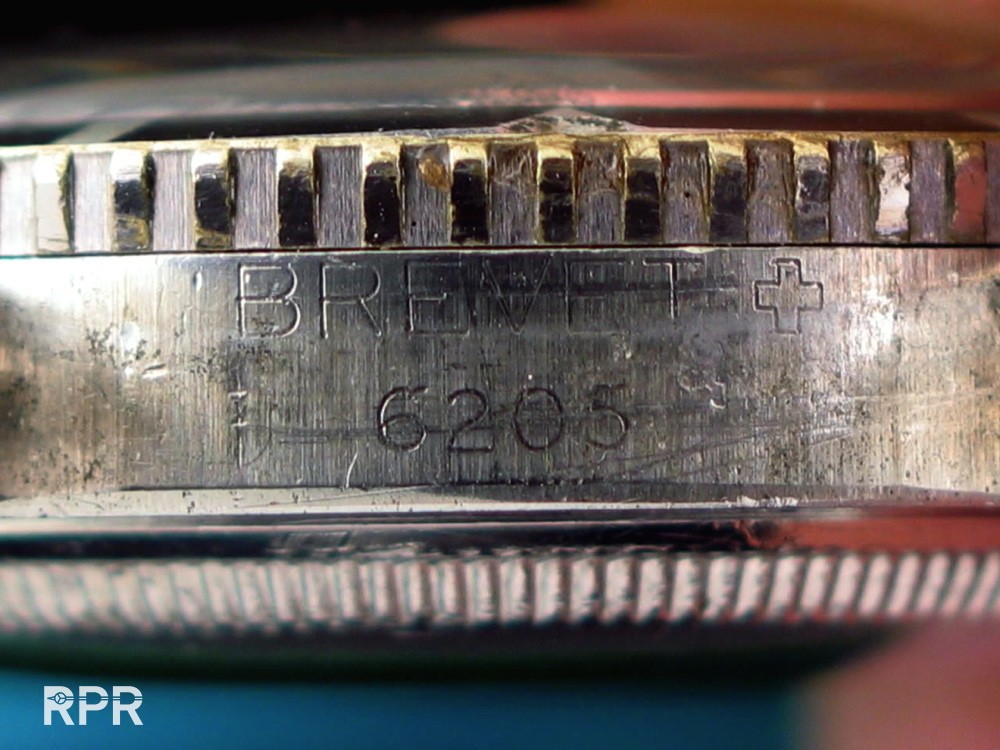
And analyzing the fonds of the Rolex serial numbers engraved between the lugs up close… 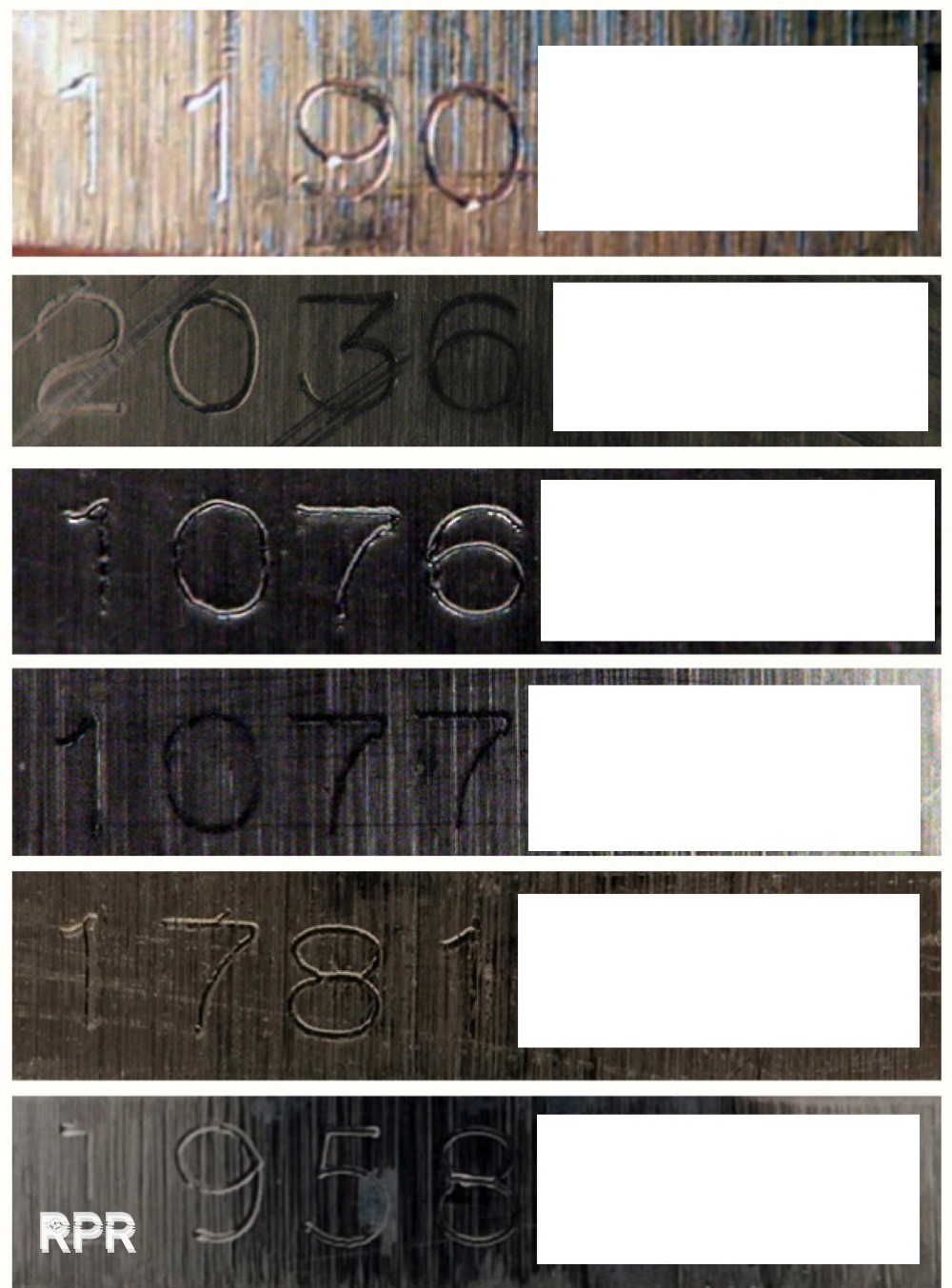
Then last but certainly not the least interesting, fake – counterfeit parts: Many collectors have experienced that a so called great deal turned out into a nightmare. Since many years the collectors market in general has been overloaded with un original, later produced, counterfeit practices. As modern watch collecting has become all about the dial, we see many creative crooks trying to enter the market of big money. Reproducing a dial in all it’s details is becoming better and better, even to a degree where it’s almost impossible to determine right or wrong. It’s improving so fast, due to the use of modern technics, that one should remove the dial out of the case ( with all risks of damaging it ) to be certain if it’s a original one or not.
Magnifying it up to 100-200 x and comparing with one thats proven original isn’t possible for many collectors. Therefor buying from a trustable source where returning a watch with issues is never a problem, has become highly recommendable. Often when a deal is to good to be true, something is smelling fishy. Be aware and try to train your eyes to notice every small detail that’s not like you’ve seen before. Question every difference, ask fellow collectors or post your picture in a watch forum online before making the deal! See below a fake Rolex Submariner dial, where the printed graphic is becoming very close to original. If you doubt buying from pictures, always make sure you see the watch in your hands before finishing the deal. Once you’ve handled these fakes, you’ll notice that the patina is wrong. In those cases your eyes tell you the dial seems to be ok at first look but when you examine it up close, with your loupe, your brain is warning you to be extra careful as something is not correct. 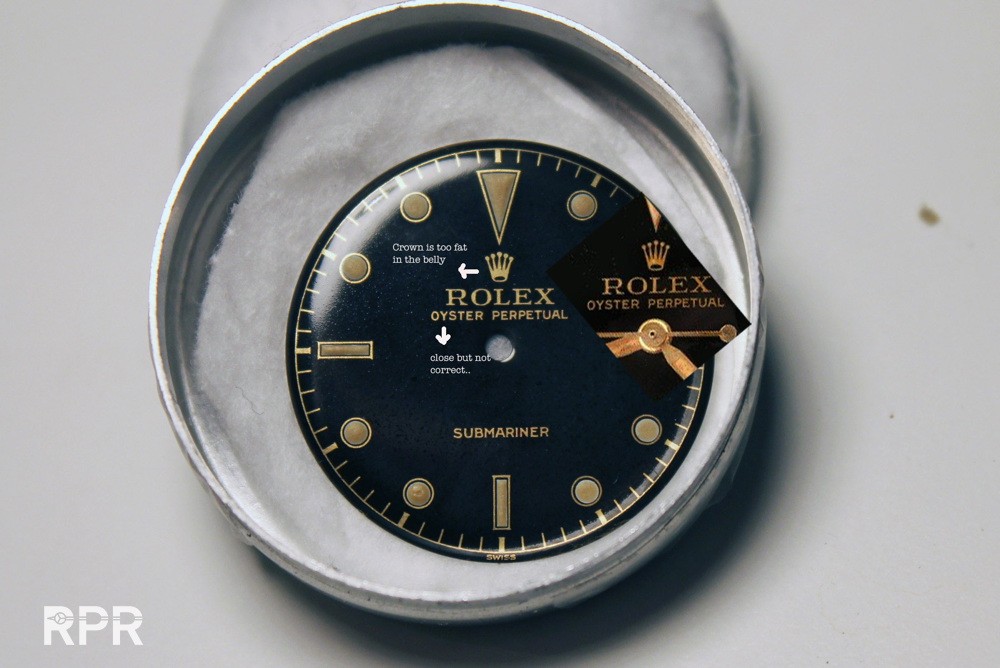 Same as above, the print is almost spot on ( compare it yourself with the 2 original cut outs I added on top of the picture ) but the patina of the laquer and the luminous are new and the dial has hardly any radiation although it’s a mid 50-ies Rolex design that originally is having a strong radiation. Be aware!!
Same as above, the print is almost spot on ( compare it yourself with the 2 original cut outs I added on top of the picture ) but the patina of the laquer and the luminous are new and the dial has hardly any radiation although it’s a mid 50-ies Rolex design that originally is having a strong radiation. Be aware!! 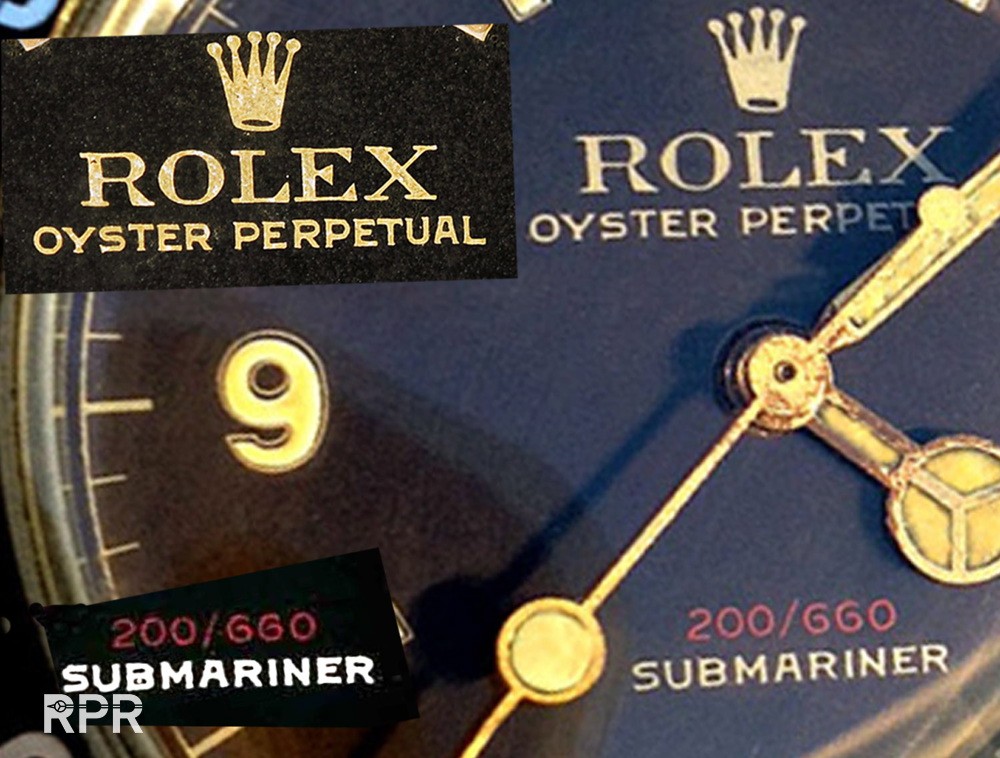 Below we see a original Radium Submariner dial where the aggressive radium dust has eaten up the top layer of the finished dial..
Below we see a original Radium Submariner dial where the aggressive radium dust has eaten up the top layer of the finished dial.. 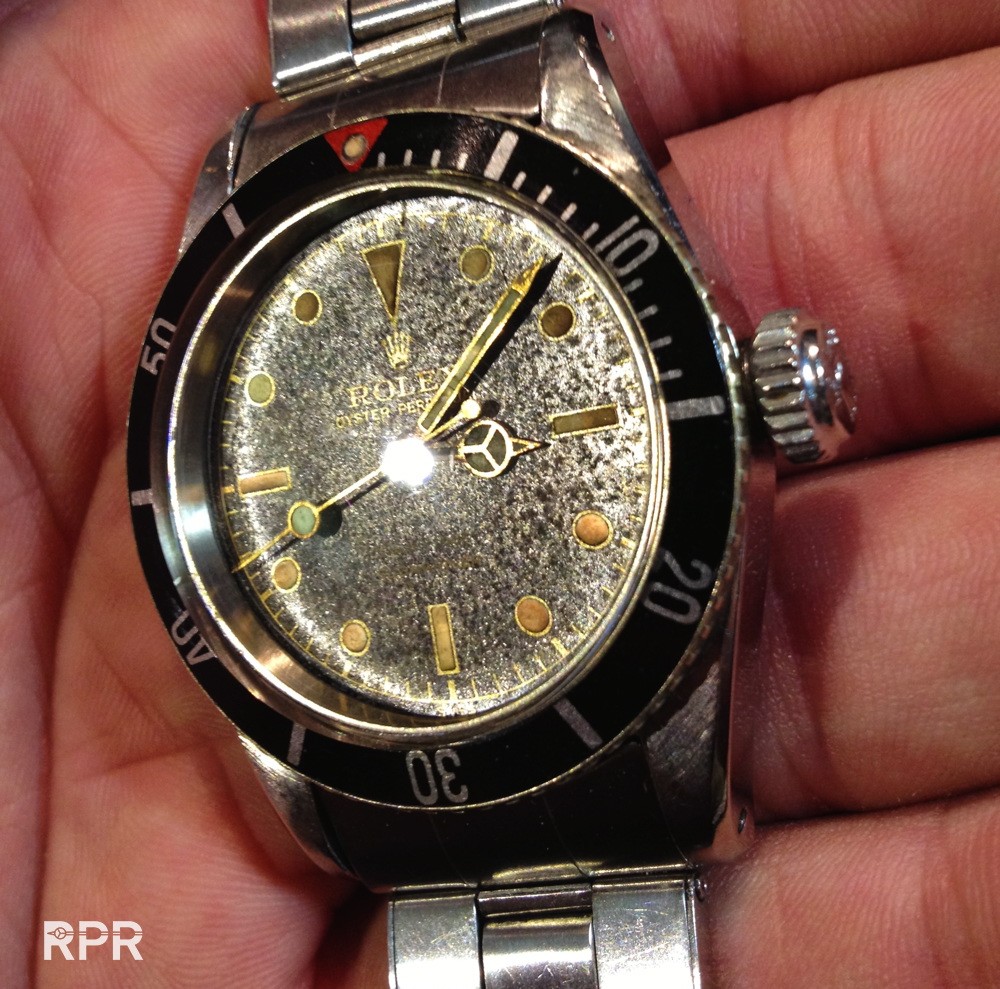
In below picture you see clearly the way of printing that this glossy minute track Submariner Ref 5512 with SCOC text. These last 2 lines are added on top of the already finished laquer, there where the Submariner & 200m=660FT, is below the finish.. .
On the left you see a service crystal with a facet on the edge, there where the original crystal is domed.
Be aware, high quality fake vintage Rolex dials are been offered into our market, read my RPR article on how to determine a fake dial here! As I reported you several times in last decade, the fakers are getting better and we all have to be very careful in what we buy for our collection. In my Buyers Guide I recently posted you can read about the little details that are so important for the originality of a true vintage Rolex. Since some while now we, the inner circle of hardcore vintage Rolex dealers & collectors, have noticed that fake Submariner dials are being sold as genuine. It seems most pop up in Europa, at the moment, the source might come from Germany and the UK but quickly they are also offered in the US and Asia. These new generation fakes have become very very good in quality and one needs to be an expert to see the difference, specially when you’re looking at a picture only. The text is almost 100% copied due to the use of modern techniques a dial design is blown up 100x the normal size and then corrections are made into detail…
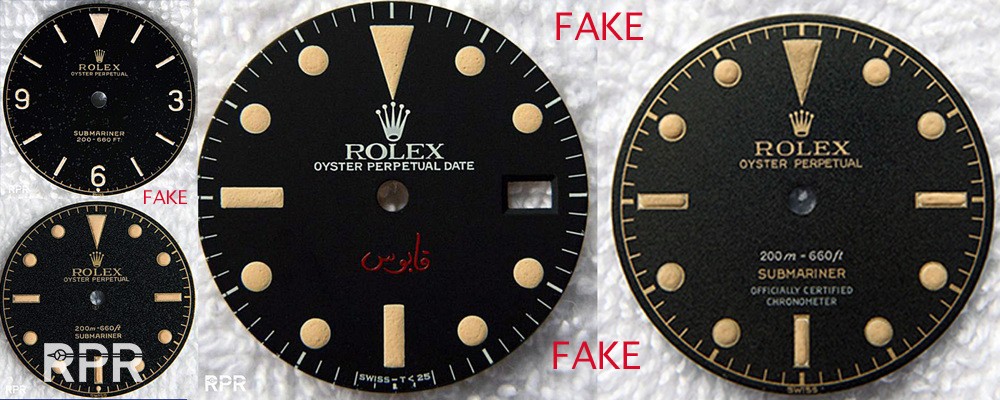 The left one is original Rolex there where the right one is counterfeit. I pointed out for you where the graphic is off.
The left one is original Rolex there where the right one is counterfeit. I pointed out for you where the graphic is off. 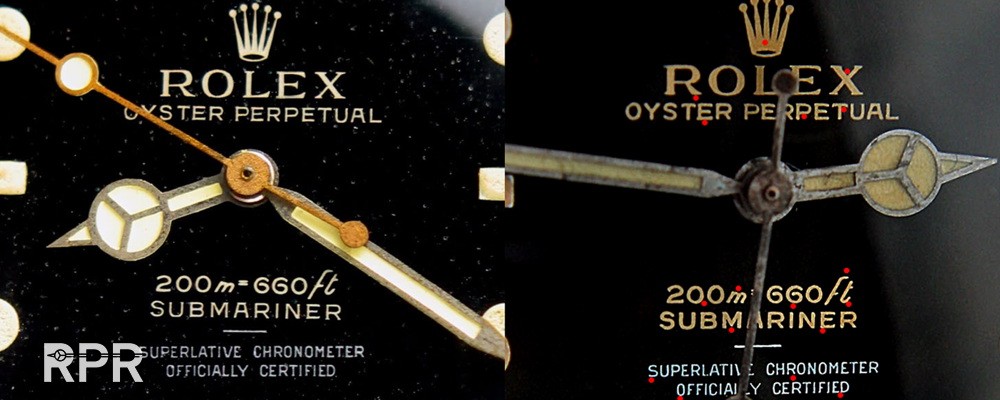
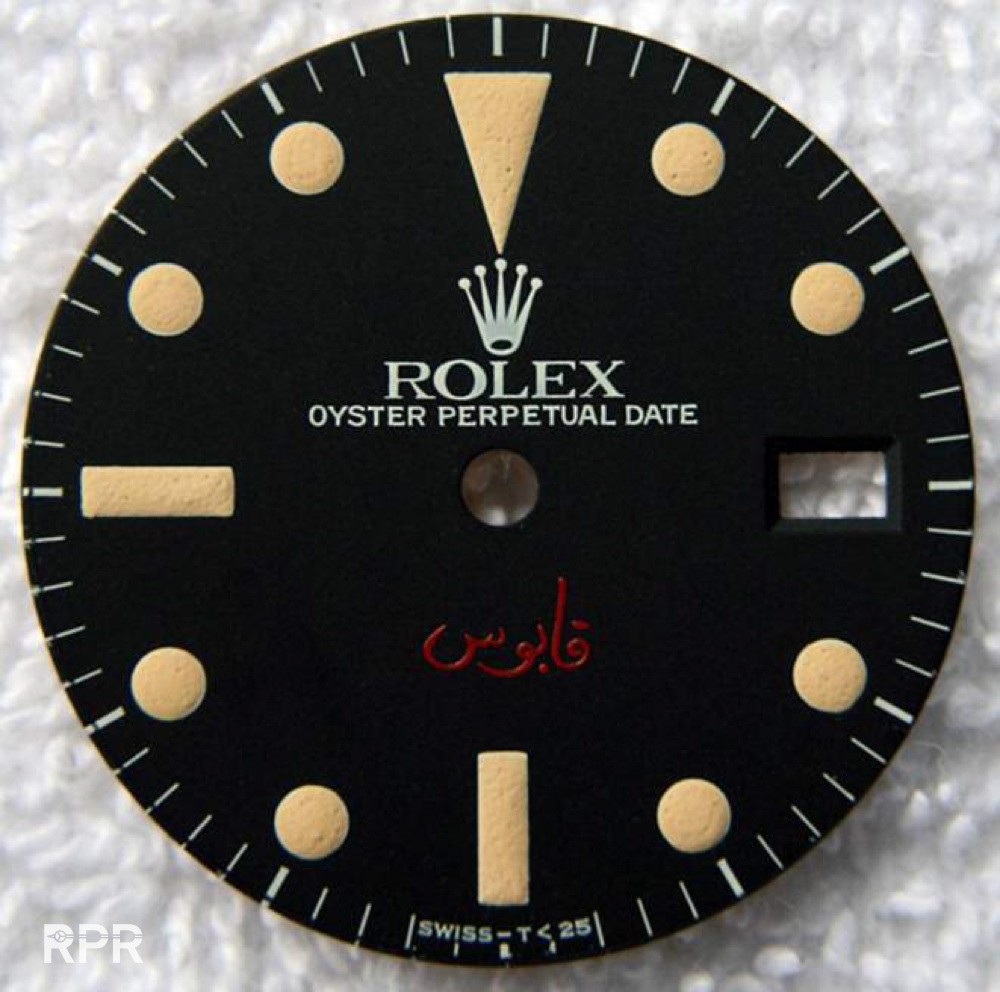 FAKE! With everything that has been made new to look old the graphics might become closer but the patina and aging is missing.
FAKE! With everything that has been made new to look old the graphics might become closer but the patina and aging is missing.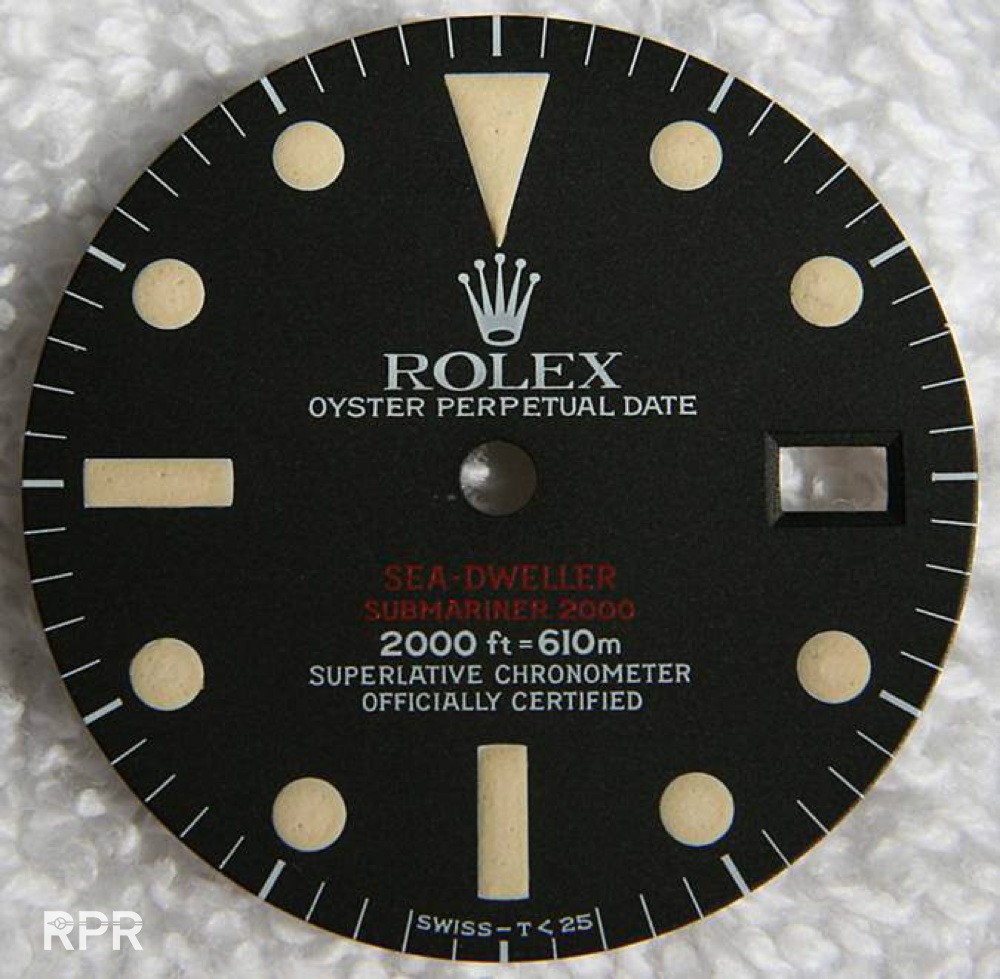 FAKE! Even when the crooks add patina on below dial, you see it’s newly made…
FAKE! Even when the crooks add patina on below dial, you see it’s newly made… FAKE! Often you immediately notice the sloppy lume job, something at Rolex would never happen / or got approved…
FAKE! Often you immediately notice the sloppy lume job, something at Rolex would never happen / or got approved…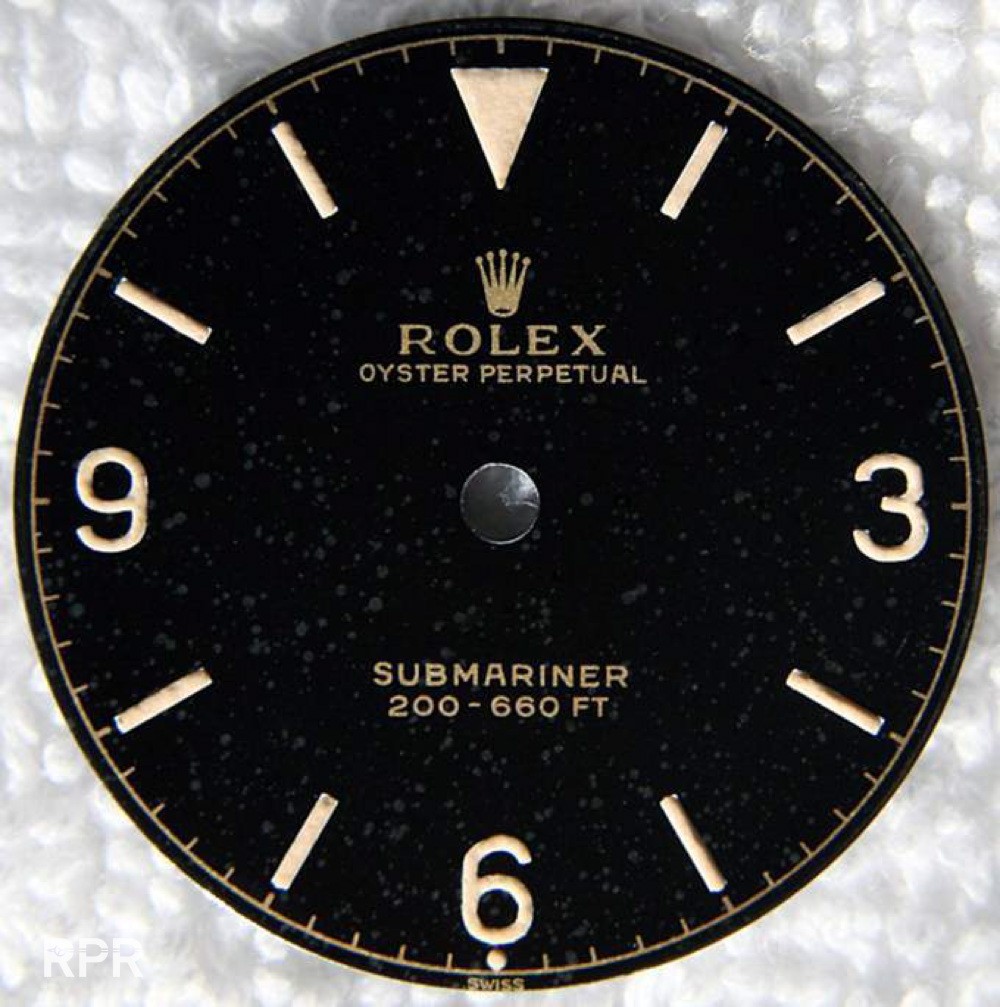 FAKE!
FAKE! 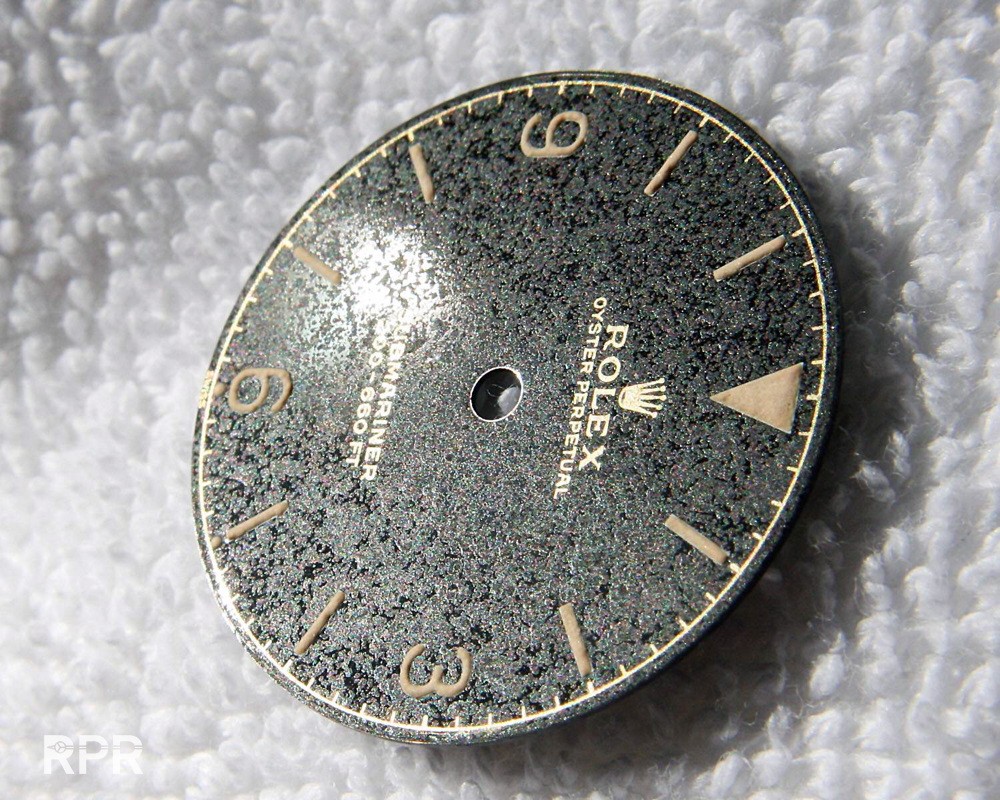 FAKE!
FAKE!  FAKE!
FAKE! 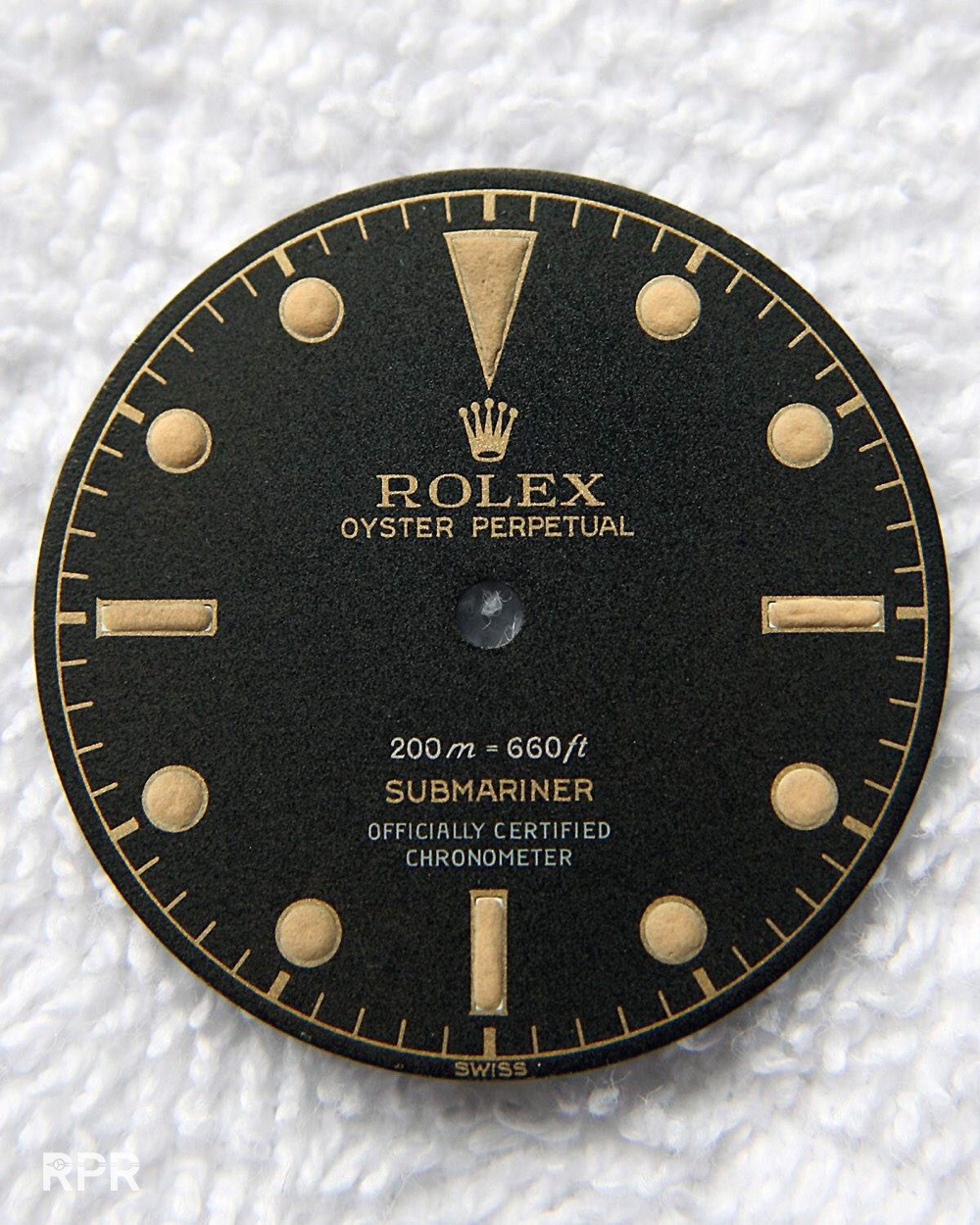 FAKE!
FAKE! 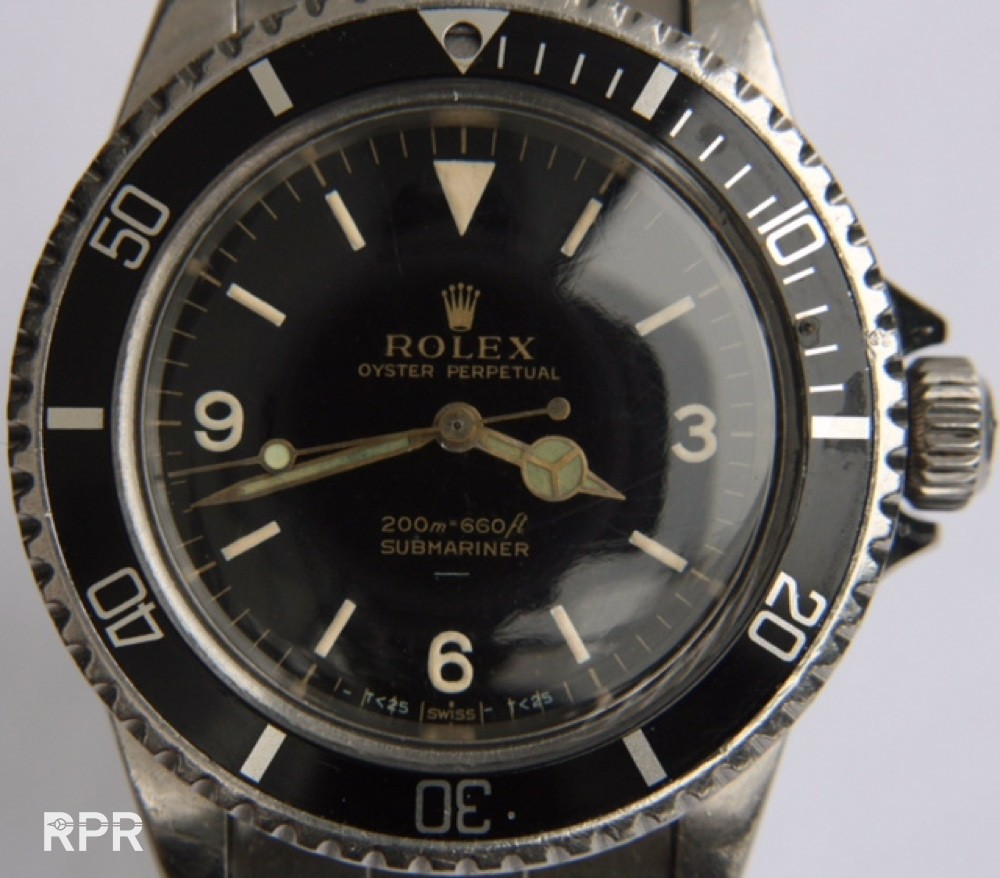 FAKE!
FAKE! 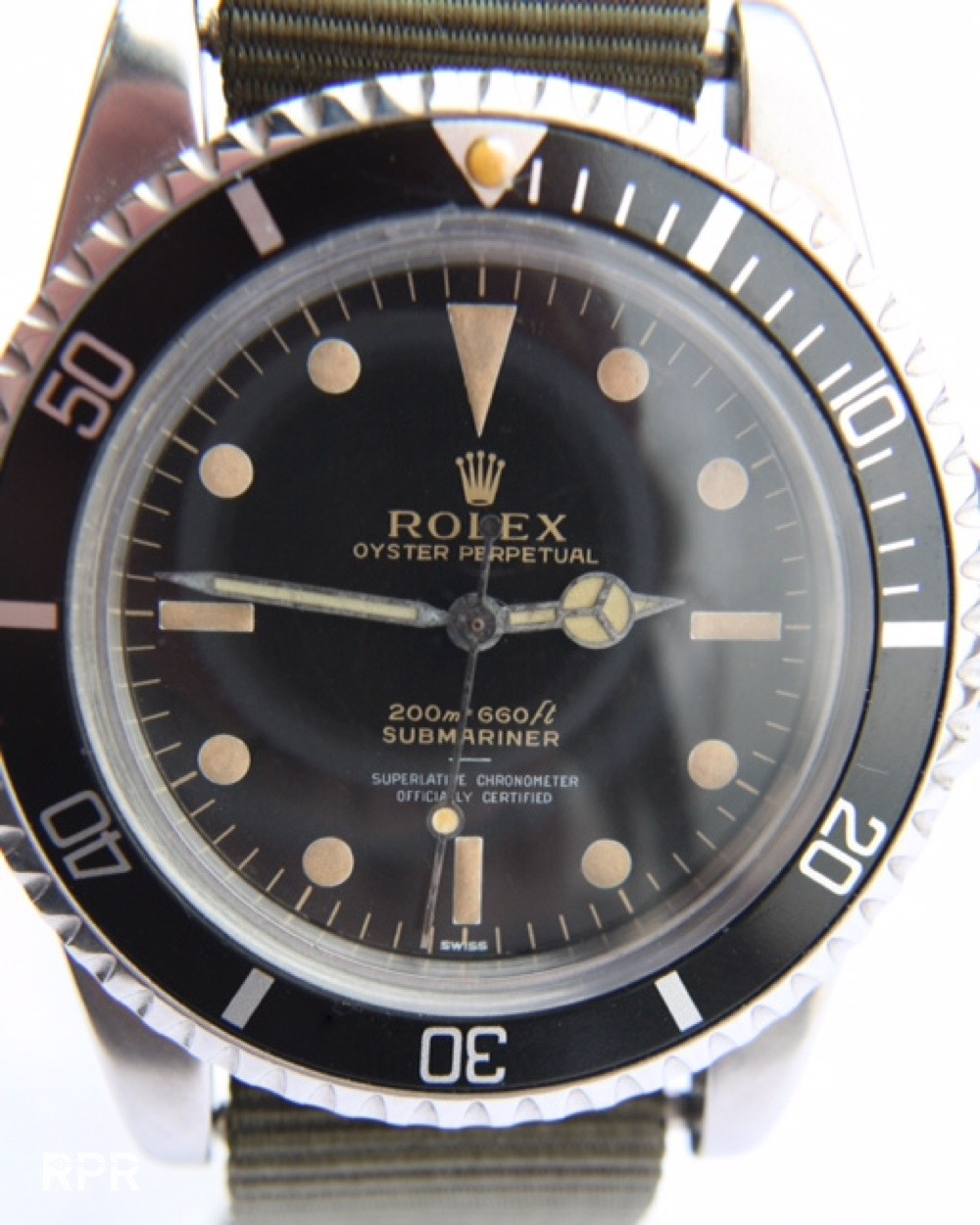 FAKE!
FAKE!  FAKE!
FAKE!  FAKE!
FAKE! 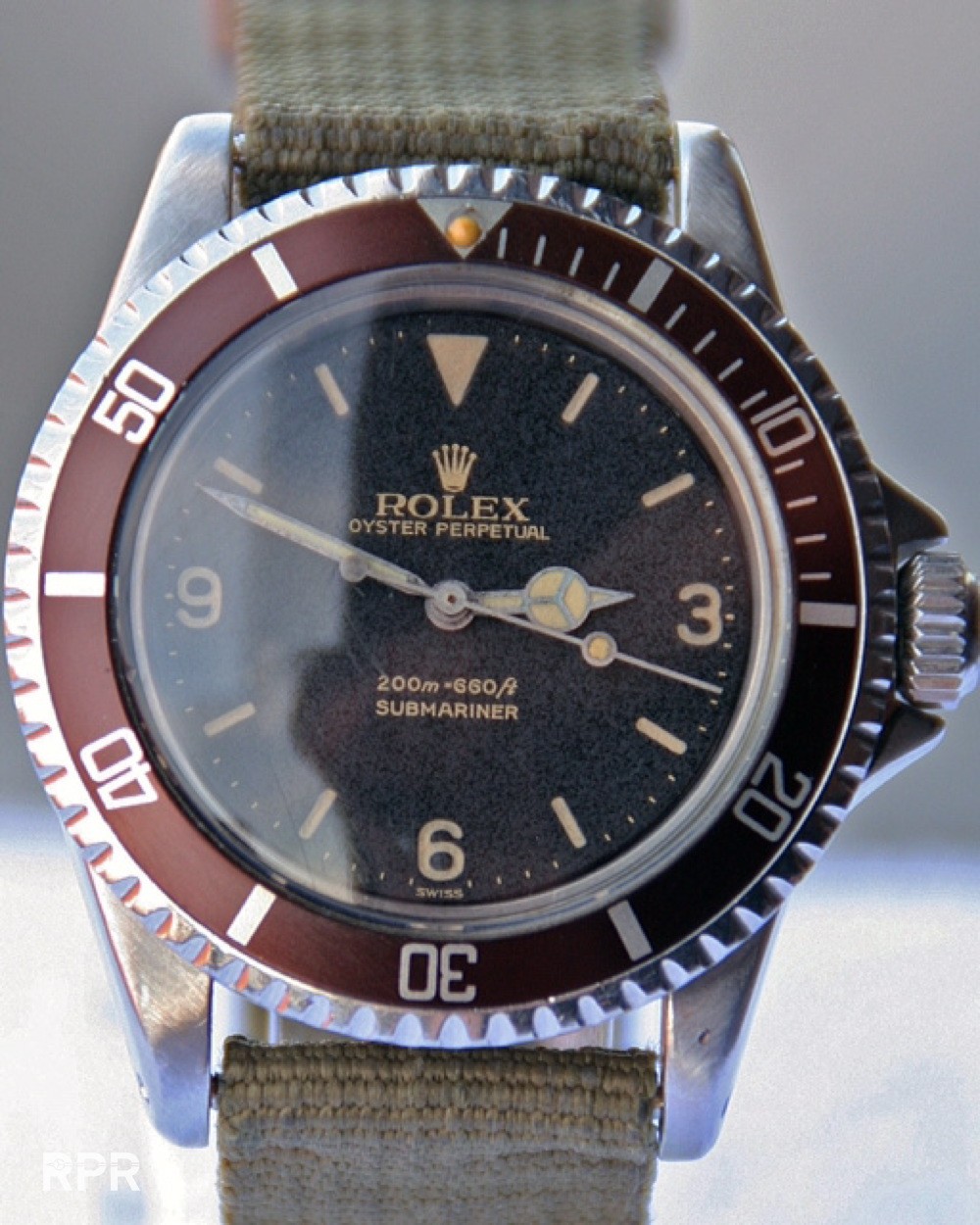 FAKE!
FAKE! 
Every Rolex reference has it’s own unique Rolex crown, printed or applied on their dial. To make it even more complicated, in those references that had been produced for a long time ( Like 5512, 5513, 1675, 1016 etc) we see different types in different periods. In the near future I’ll make a overview, for now a collage: 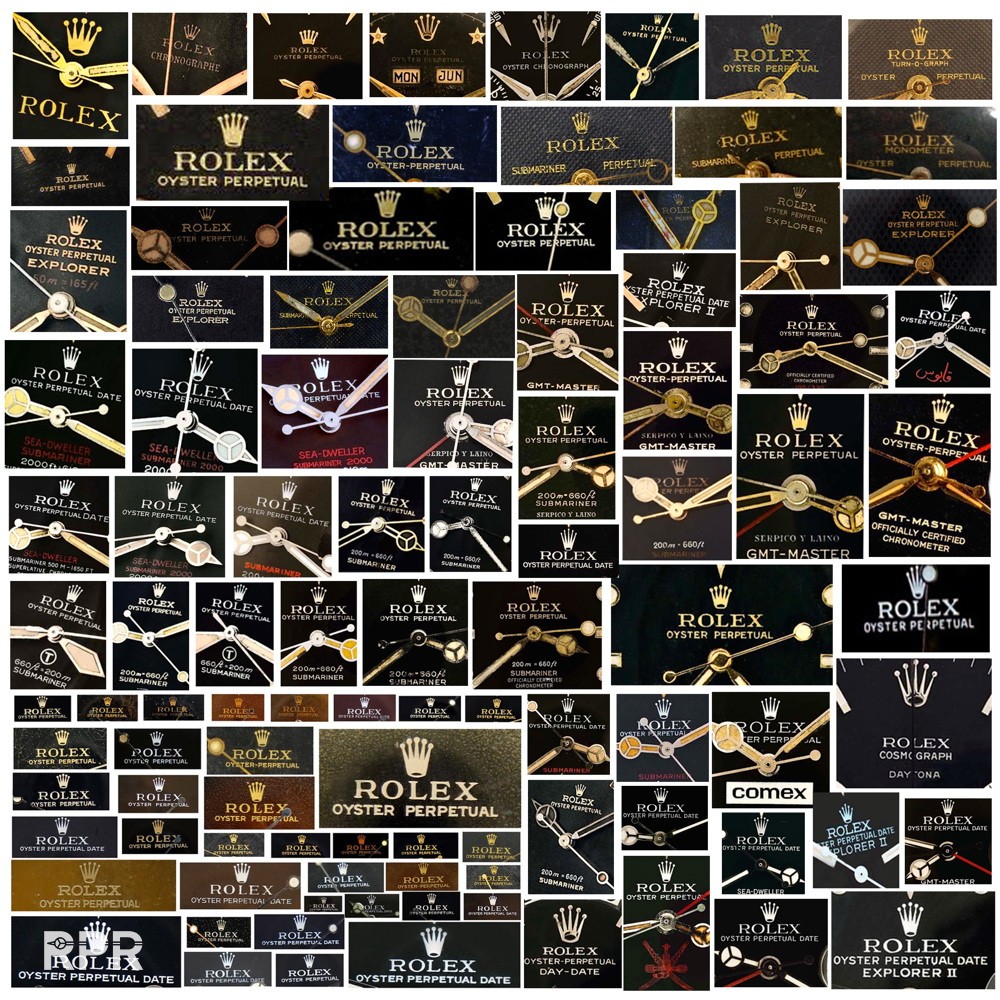
Ok, now lets analyze 2 x examples with the knowledge from above. What do we think has happened to below pictured Submariner Ref 6538? Look closely and try to answer yourself before you scroll down..
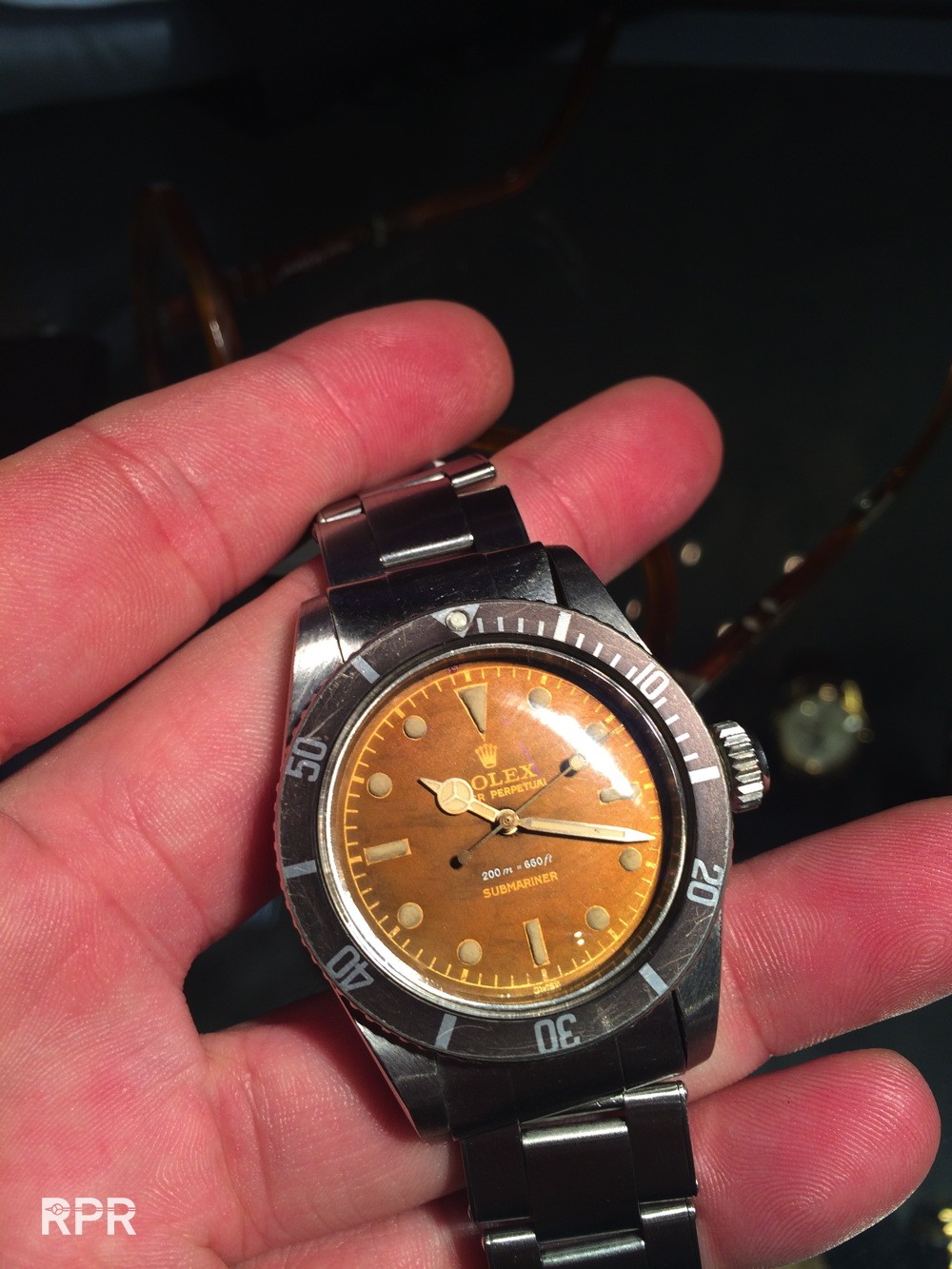
As always, first focus on the luminous on the dial and that on the hands. We clearly see that the color in the hands is much lighter then the color on the dial, so this immediately tells you: something has been done to make it look nicer. The hands in general have a bigger amount of luminous than the dots on the dial, besides that, the luminous in the hands does not have a surface compared to the dial. Therefor generally speaking hands tend to change later in color then the dial. What we see is just the other way around, besides that, the hands are to small as the minute hand is not reaching to the minute track but stop just before.
So at first, your alarm bells should already have gone off, something is suspicious, hands where not those that where born on this iconic Submariner. Next we look carefully to the luminous on the dial, in specific at 3-6-8-9 and 12 o’clock. We notice that the radium lume ( swiss dial ) is not perfectly added and hanging over the gilt lines printed on the dial. As Rolex always have done this perfectly it means it’s not Rolex, done afterwards. SO besides the hands, the luminous is also not original as we want to see it. Fact is that the dial has gone tropical, from initial black to brown caramel. As the lume on the dial is renewed professionally the discoloration of the dial has happened due to a moisture problem and not due to heavy UV light and long storage, so in other words, it’s a damaged dial that got cosmetically enhanced to fool people. The next one, a 4 line Submariner small crown ref 5508. First again try to analyze it yourself before you scroll down to my remarks… 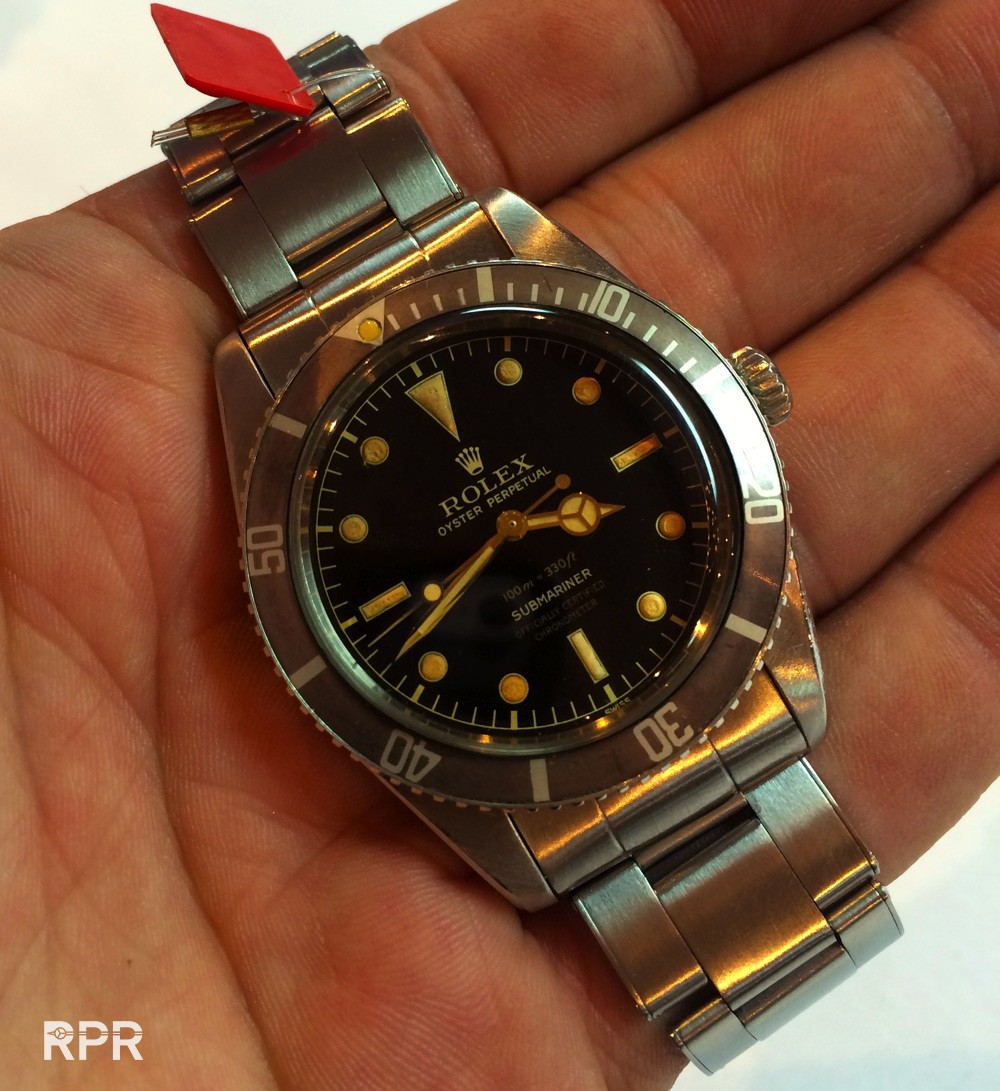
We start as usual to check out the color of the hand & dial luminous. With this one the both colors looks seem to match at first sight. But once you focus on the hands you see again that they are to short. Minute and second hand are not reaching the minute track on the outside. Besides that, given the fact that this is also a swiss radium dial, we don’t see any corrosion on top of the gilt hands, done by the radium dust. So again, your alarm bells should ring by now. Next we inspect the luminous up close on the dial, we notice that the top layer of the luminous dots have lost their rounded structure. Actually the top have been scratched of to remove the stains that where there initially.
As the lume is the moisture meter we’ve learned, in this case the moisture has entered the inside and got sucked up by the luminous making it turn brownish black in due time. Many watch makers in the past almost automatically removed the top layer of the lume making them look like craters. So besides the hands, also the lume on the dial has been touched. Then we focus on the case and the bracelet, we see that the small hairlines are not consistent and the color of the steel is all over much too bright looking, meaning it’s recently polished, with other words, prepared for sale. The next Big Crown comes from recent Geneva sale from the market leader Christie’s. What do you notice?…
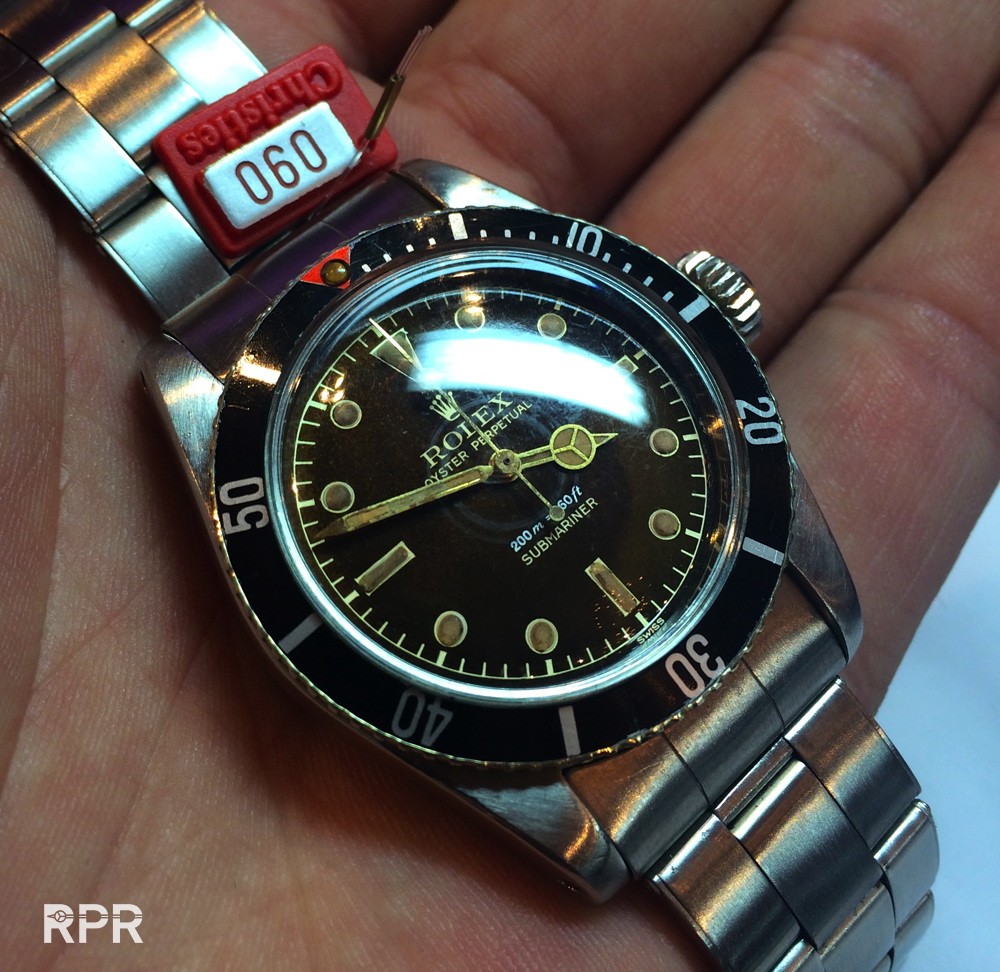
It’s about the same story as on the first tropical brown Submariner we analyzed up here except the hands look to be more matching. Why I bring this one up as a example to discuss is that if you where a buyer and you would only trust the pictures published by Christie’s online and in their catalogue, you would never had seen that the middle of the dial shows circular damages. This is due to the fact that the hour hand was pushed to hard while placing it back and then slowly damaged the surface of the dial. The glossy lacquer is irreparable. I strongly advise you when you want to buy at an auction, always to make sure you check the actual watch ( preferable in daylight ) before the sale starts. The enormous amount of photoshop done is a thorn in my side. It’s cheating with the trust they have earned by becoming market leader imho. I honestly think all auction houses should stop using photoshop. To rest my case, following pictures is of an early 1956 Big Crown with 4 lines coming for sale in NY soon…
Now compare it with below picture recently made by iPhone and you see the above is all photoshopped. Even the typical greenish 6 o’clock index we see on early sports Rolex from 1954-1957, has become the same color as the rest of the luminous on the dial. Over sudden the whole dial is also equally black. 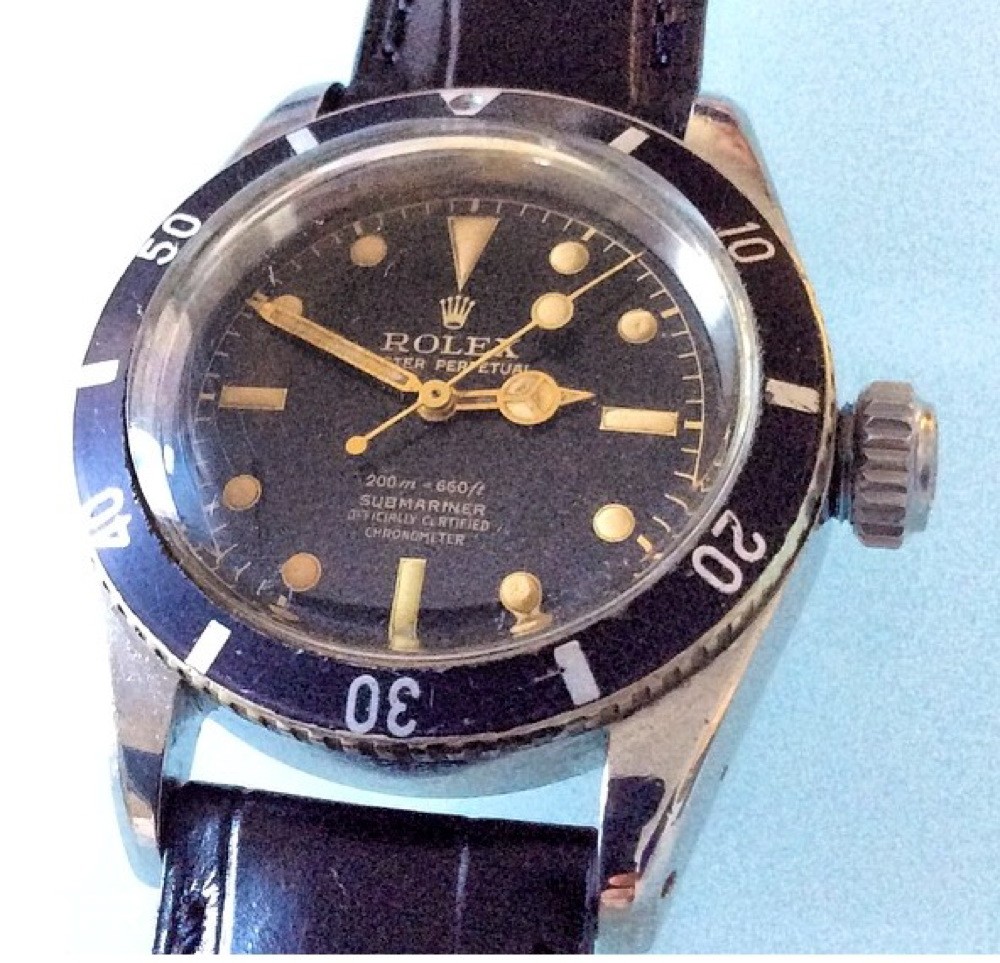 Advise: Use the enriched information from John Goldberger’s „Vintage Rolex – 100 superlative Rolex Watches” Application for your mobile. Besides the all the information from the book, there’s a section with close ups from the movements, case backs and dials! An absolutely must have for any serious watch collector and Rolex lover in general. It’s regularly updated with interesting data of newly discovered Rolex that come to the market. Check his website for possible Ipjone & iPad applications on Rolex and Patek Philippe over here: www.johngoldbergerwatches.com
Advise: Use the enriched information from John Goldberger’s „Vintage Rolex – 100 superlative Rolex Watches” Application for your mobile. Besides the all the information from the book, there’s a section with close ups from the movements, case backs and dials! An absolutely must have for any serious watch collector and Rolex lover in general. It’s regularly updated with interesting data of newly discovered Rolex that come to the market. Check his website for possible Ipjone & iPad applications on Rolex and Patek Philippe over here: www.johngoldbergerwatches.com 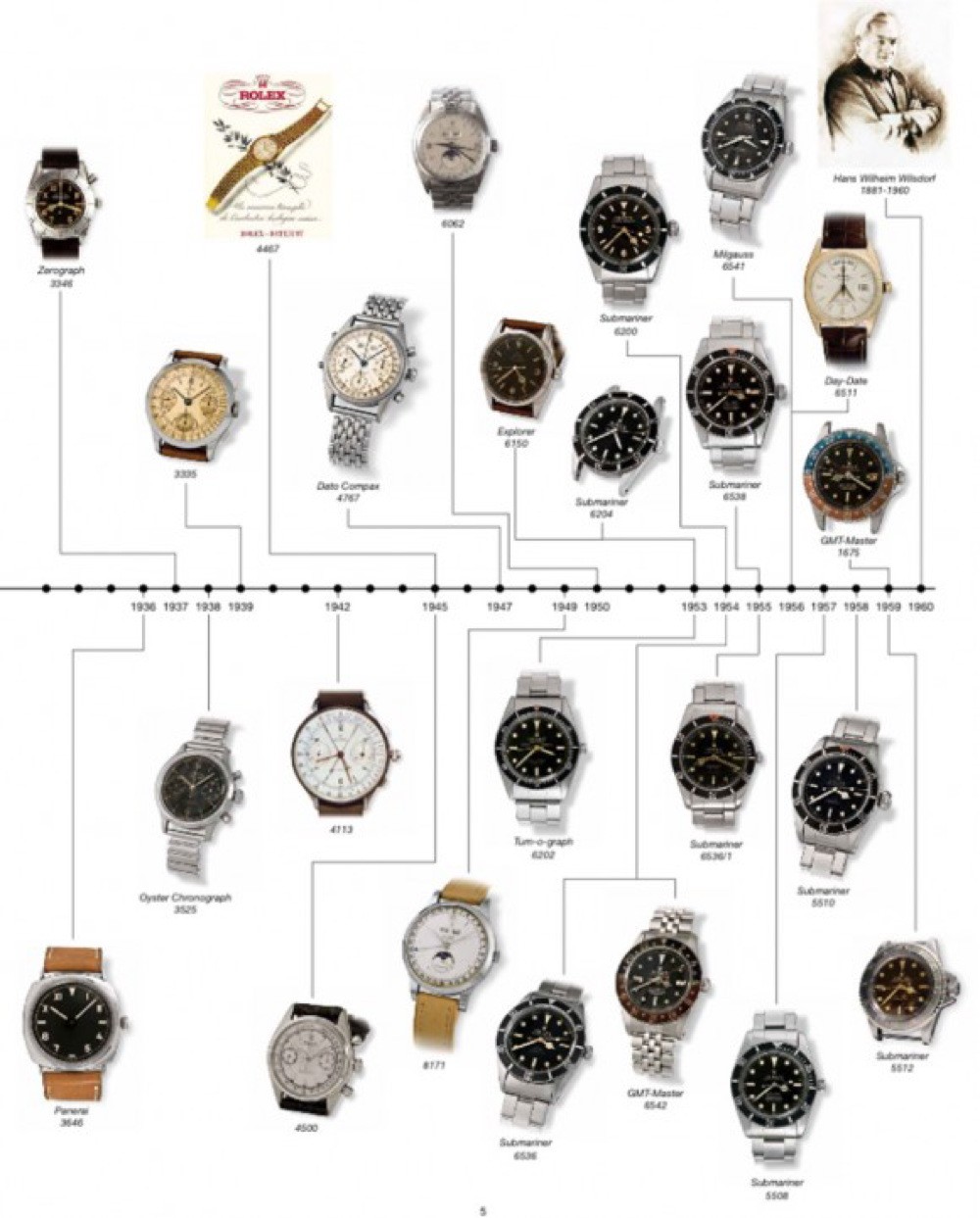 Provenance: I like to add in a update the proven history of a watch. Wikipedia says about provenance: The chronology of the ownership, custody or location of a historical object. the primary purpose of tracing the provenance of an object or entity is normally to provide contextual and circumstantial evidence for it’s original production or discovery, by establishing, as far as practicable, it’s later history, especially the sequences of it’s formal ownership, custody and places of storage. The practice has a particular value in helping authenticate objects but establishing provenance is essentially a matter of documentation.
Provenance: I like to add in a update the proven history of a watch. Wikipedia says about provenance: The chronology of the ownership, custody or location of a historical object. the primary purpose of tracing the provenance of an object or entity is normally to provide contextual and circumstantial evidence for it’s original production or discovery, by establishing, as far as practicable, it’s later history, especially the sequences of it’s formal ownership, custody and places of storage. The practice has a particular value in helping authenticate objects but establishing provenance is essentially a matter of documentation.
With a Rolex this could be the original Rolex warranty papers that state the reference number and in some cases the serial number, the COSC chronometer certificate that state the serial number and movement number, the original receipt stating the price and article description, later service papers confirming the serial and reference numbers. Having pictures from the past showing the owner while wearing it and a letter stating it’s history is a must. As Rolex has delivered many different markets in the world, sometimes using local suppliers like we see with bracelets a lot for instance, many different versions of the same reference have come to the market. Having a proper provenance can provide us prove about the originality how it has been delivered initially. When you buy a vintage Rolex from first owner or from the relatives, always ask for extra information they can add. The more provenance you have, the better it is! 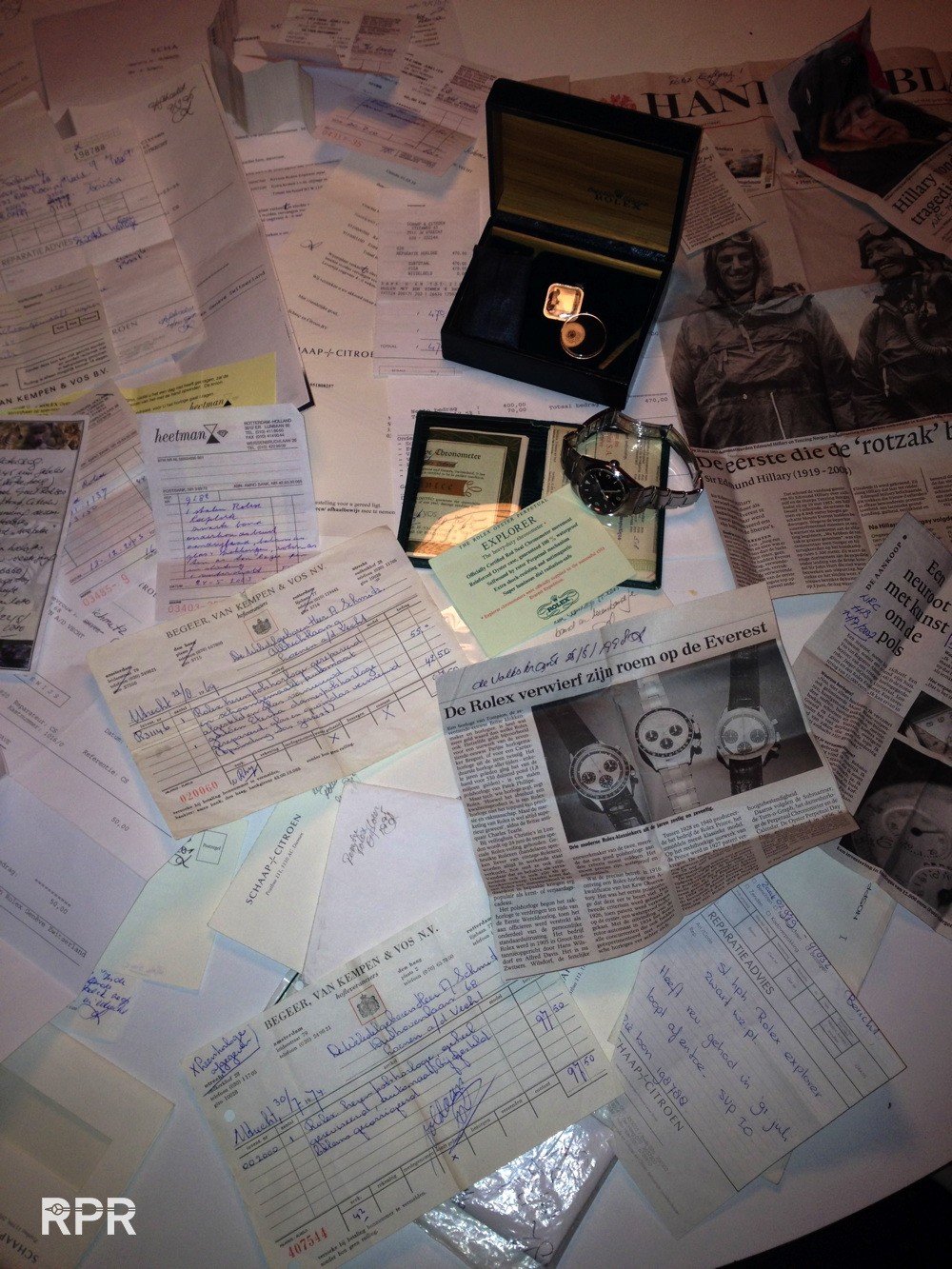
Conclusion: My general believe is that we nowadays see to many ‘worked on’ vintage watches around. Every day a nice and honest watch somewhere in the world gets a ‘treatment’ because it’s dial is having some little spots or the case has original scratches on it. By changing the original patina you destroy the vintage value for ever. It’s like a woman that has got herself a facelift to look more beautiful but doesn’t realize it’s never possible again to age and to return back to normal. As long she doesn’t smile, laughs or cry’s, not showing you her emotions, she looks as fresh like a statue or a picture. I strongly believe that even a simple steel Airking or Datejust, a Explorer 1 or even a Cellini will become highly collectable as long it’s alive and fresh and all original condition having it’s necessary patina all over.
The watch market has to understand that exactly these little scratches or small imperfections are the key to future collecting! Stop messing around and offer watches like they are and not how you would like to see them. Once everybody understand the importance of originality, we will see that a simple red sub in great condition will be worth double or triple the money they sell now in average. It’s due to the experience and knowledge you built up over the years analyzing, comparing and discussing that only honest quality has a future. Not buying a Daytona or even a Paul Newman because 1 lume dot is missing and although the total watch is nice and crisp, is nonsense! What I tried to explain in my guidance is that you have to be aware about a vintage watch that, for instance, got totally relumed by professionals, where the patina is destroyed and thus not worth buying. We have to realize that perfect grail watches are super rare and not everybody will be able to acquire one in crisp “catalogue style” as the price will only go up rapidly because we know now not many more will come to the market. Settle for honest quality is my advise, no matter the reference, believe in true patina and buy the best your wallet allows you to!!
I really hope the above quick guidance I set up will help many novice and senior collectors to understand what they are seeing. Always believe your eyes and never the story you get told! Analyze everything up close, use common sense and make your due diligence before you buy a vintage watch or a vintage Rolex in particular! Make sure that when you’re not happy, you can return the watch and never wire any amount if you’re not 100 % sure that this is the actual owner. The world of vintage Rolex is full of scam and laster, relying on a trustable dealer, who has a reputation to defend, is most of the cases the best option you have. In case of any emergency you can always send me a picture to info at Rolex Passion Report .com where I will have a closer look at your question and give you my free opinion. To determine if a Rolex has the correct serial numbers, where it has been delivered or to get a original Rolex service, you can contact Rolex Heritage Department in Geneva directly. Thanks for reading, I hope you enjoyed it! I wish you lots of fun with your passion of collecting Rolex, or any other watch 😉
Best to all of you!
Cheers Philipp Stahl
I like to add the important “Evolution of Rolex Luminous” at the end of this post for your eduction purpose….

A lot has already been written about the impact of the luminous used in wristwatches. In specific the turn from using radium to tritium has been discussed in length on vintage Rolex Forums. Today I don’t want to debate the dangers of early radium nor the legal impact radiation had for the swiss watch companies. I merely want to make a general overview that’s useful for Rolex collectors to understand the differences of luminous, their used time period, the influence it had on the condition of the dial and what typical details one has to look for when analyzing a vintage Rolex. As you could have read earlier in my vintage Rolex Buyers Guide, the luminous in general I see as a “Moisture Meter” or more specific, a “Condition Meter” of which you can determine what has happened inside a Rolex during it’s life. As long as you don’t inhale early radium pre 1953, there’s no need to panic, you can wear your vintage Rolex as often as you want, even James Bond knows…
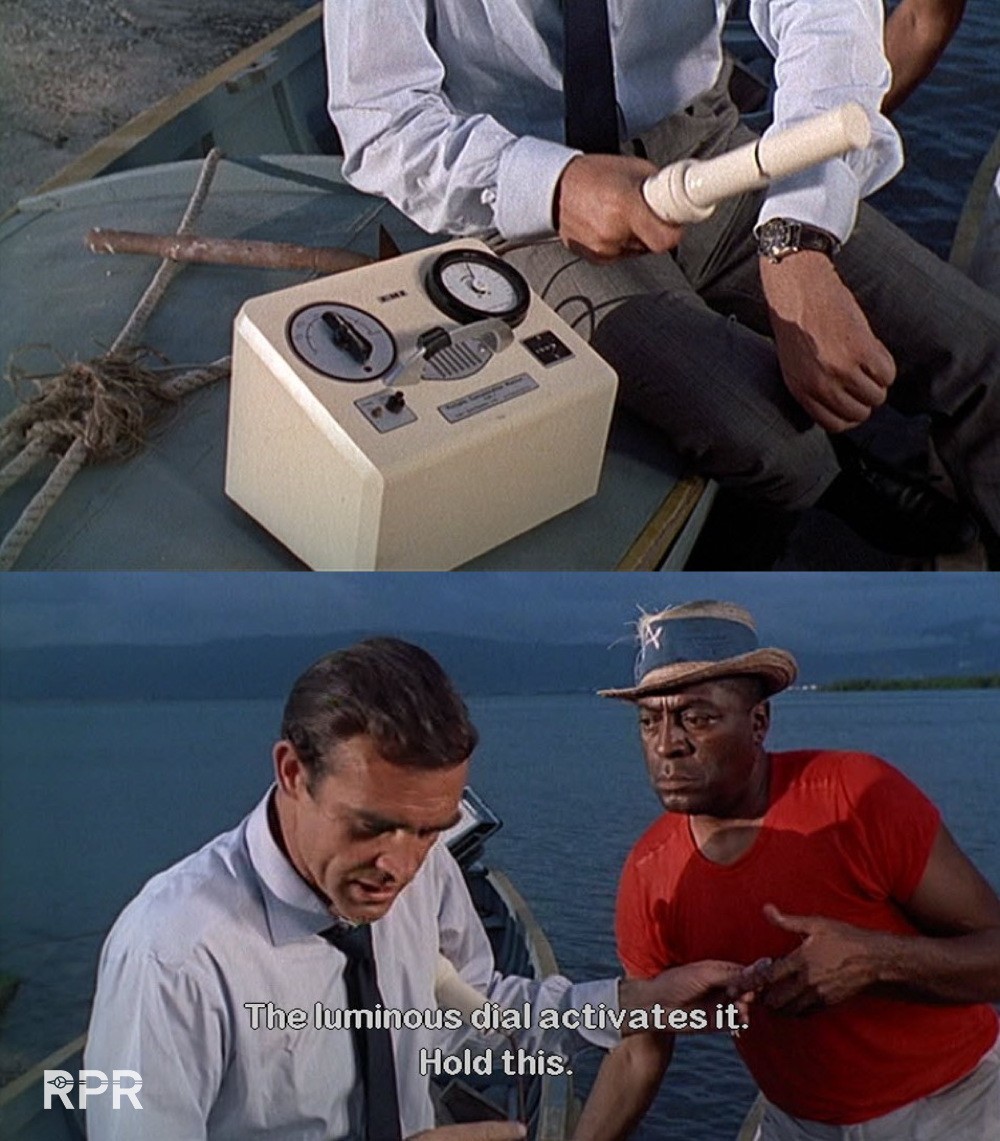
At first I like to start with the overview of the approximate date of luminous used by the Rolex Company:
- Prior – 1953, The early age of Rolex luminous, used on their pocket watches, early oyster cases, bubble backs and radiomir Panerai’s.
- 1953 – 1956, When Rolex introduced the world their sports / utility / tool watch concept with radium Submariner, TOG, Explorer & GMT Master.
- 1957 – 1960, When Rolex lowered radiation and chanced dial printing from 1 to 2 colored print and enhanced the lacquer to a more glossy variant.
- 1960 – 1963, The pre ‘Transitional” period with “Exclamation” mark and due to the starting international regulation, again less radioactive luminous.
- 1963 – 1964, “Transitional” underline of which Rolex switched from Radium to Trtium, delivered dials are “swiss” signed but laminated with tritium.
- 1964 – 1967, The new generation tritium luminous got added on glossy dials, signing chanced from “Swiss” to “Swiss – T<25” & “T-Swiss-T”.
- 1967 – 1983, The matte dial with tritium luminous got introduced by Rolex. We see tritium signings variations like T Swiss T<25 or σ T-Swiss-T σ.
- 1983 – 1997, The last era of the tritium dials when the glossy dial surface came back, now the luminous was added in a added white gold surround.
- 1998- 2000, LumiNova was invented in 1993 and patented in 1995; Nemoto & Co. Ltd. was contracted in 1998 to provide LumiNova to Switzerland.
- 2000 – 2008, Super Luminova, a improved version of Luminova, a material that has the same properties as tritium but is not radioactive.
- 2008 – now, Chroma Light, the new blue-ish colored Super Luminova thats been in use since Rolex patented it.
The early aged radium dials from the 20-ies and 30-ies where merely fitted on a emaille surface, using strong first generation Radium that by then not known that it could be dangerous. In contraire, radium drinks where sold to cure health issues but soon this chanced after the tragic story about the Radium Girls. For the Rolex collectors under us, the period that started at Rolex from 1953, is one of the most interesting time phrases for aficionado’s. The Turn O Graph Ref. 6202, Submariner Ref. 6204 & 6205 and later the Big Crown Ref. 6200 are the beginning of the since then ever lasting legendary tool – sports watch concept.. 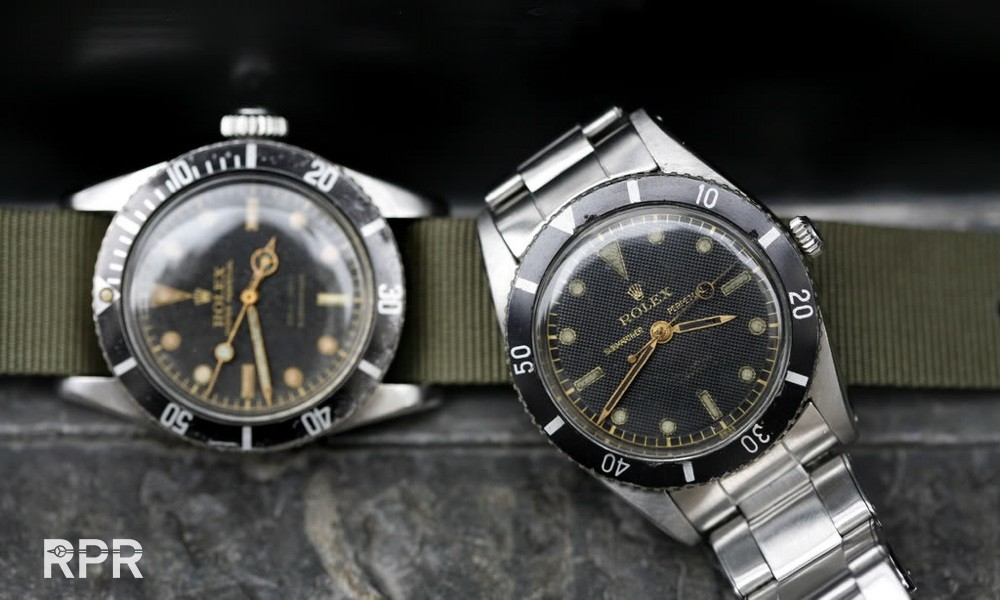 What we see in above and in below pictures are first generation Rolex Sports models. In many cases the radium luminous has turned greenish when moisture – condense came into the case as you can see above. In below Submariner ref 6200 you can clearly see that the radium dust is covered over the dial, mostly around the radium plots. One of the characteristics of these early sport dials is the fact the they have a 1 color print and a lacquer finish thats not as shinny as we see in later examples. The radium dust, one never must inhale, leave small stains on the surface of the dial. In below picture you can also clearly see the transparant paste in the hands that was added before the radium luminous came on top.
What we see in above and in below pictures are first generation Rolex Sports models. In many cases the radium luminous has turned greenish when moisture – condense came into the case as you can see above. In below Submariner ref 6200 you can clearly see that the radium dust is covered over the dial, mostly around the radium plots. One of the characteristics of these early sport dials is the fact the they have a 1 color print and a lacquer finish thats not as shinny as we see in later examples. The radium dust, one never must inhale, leave small stains on the surface of the dial. In below picture you can also clearly see the transparant paste in the hands that was added before the radium luminous came on top. 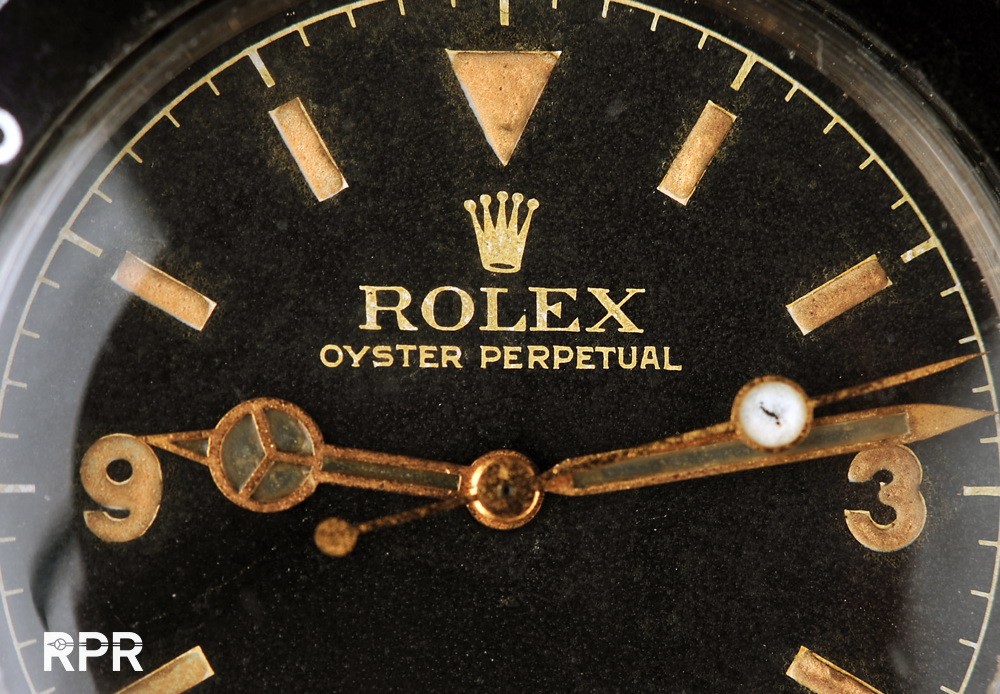
2 x Submariner Big Crown but both very different in detail. First is a 1954 Ref 6200 with later added “Submariner” at 6 O’clock, secondly we see a 1958 Ref 6538 with 4 line dial, besides the depth rate and Submariner, this version has a OCC ( Official Certified Chronometer ) movement.
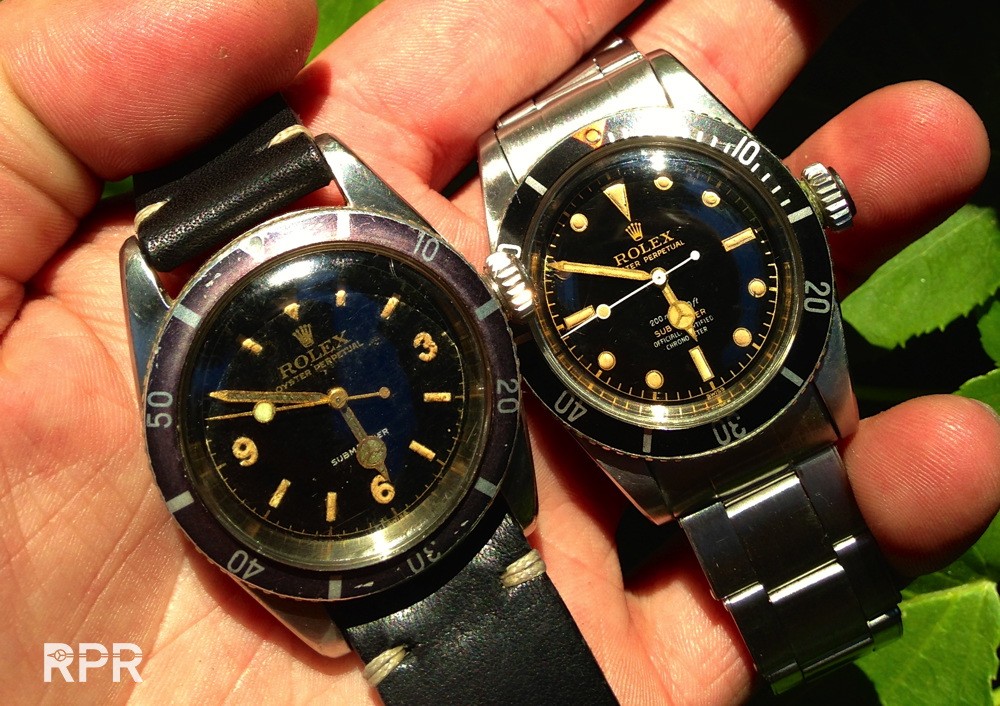
Up close a early Ref 6204 with black “Honeycomb” dial, split logo ( Submariner & Perpetual) pencil hands and slightly visible, the OCC sign at 6 o’clock. The radium dust has slightly eaten the dial surface. The missing luminous in the second hand has been spread around the dial. Moisture made the pencil hands inside turned dark as well as the plots on the dial greenish.
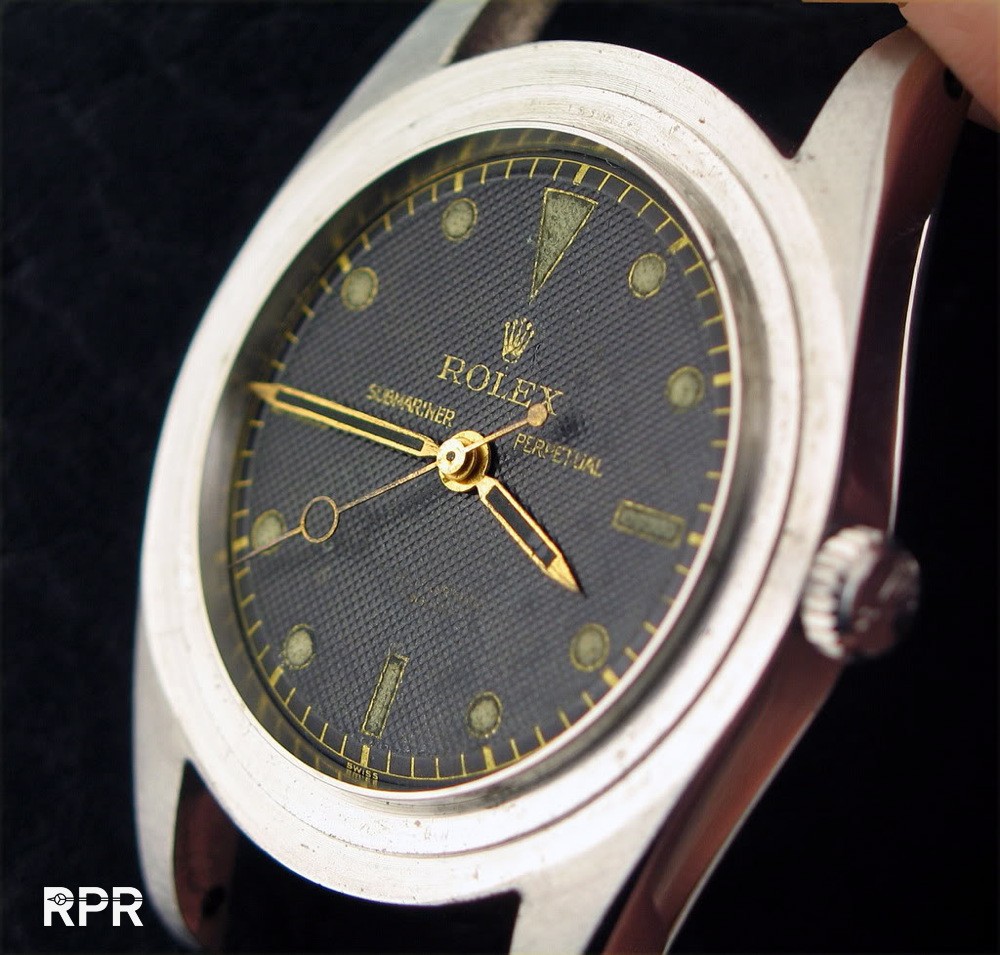
Next we see a first generation Big Crown Ref. 6538. You notice that the depth rate ( 200M = 660Ft ) and the Submariner print are both in 1 color! Another typical detail we see is the 6 o’clock marker being more bright then the rest of the radium plots. Most probably this marker is a special mix of radium for easier underwater readability.
Detail comparison: Left and middle version are both early 6538’s with 1 color print, there where the right one is having a 2 color print ( for depth rate & OCC)…
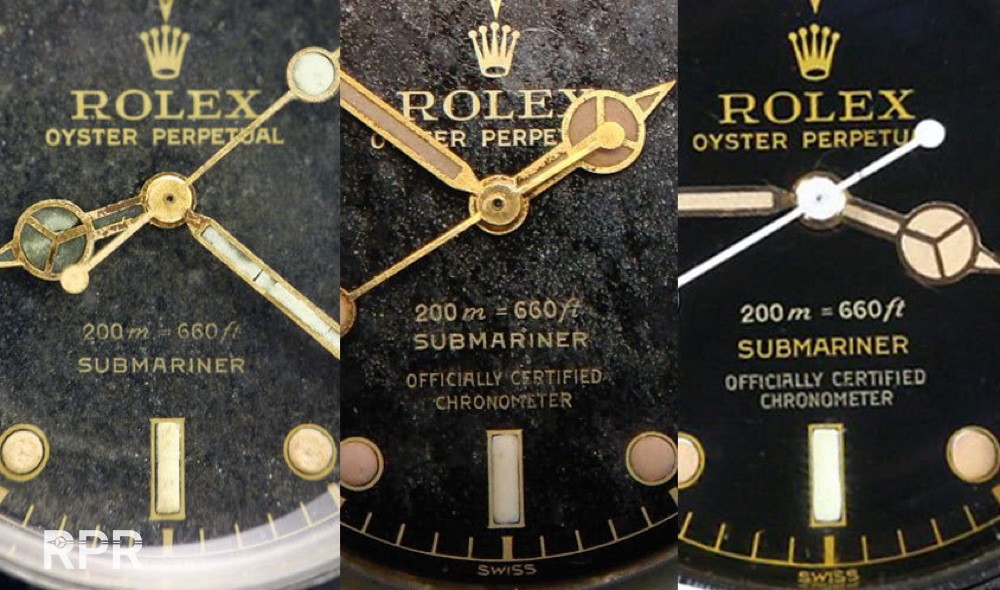
Next to each other, second and first generation Rolex Big Crown’s. Clearly visible is the different finish that covers the dials, there where the later left one is all shinny and glossy is the right one of first generation. A lot of research I’ve done on these Submariner Big Crown’s and my standard procedure was to measure the dial with a geiger meter. From the results I can inform you that the radiation between first & second generation 6538’s is significant, depending on the condition of the luminous of as well the dial and hands, the later glossy versions where at least 5 times less radio active, hence the better condition you find them now.
 Close up of a fully in tact radium 6 o’clock Explorer ref 6350 marker from 1953…
Close up of a fully in tact radium 6 o’clock Explorer ref 6350 marker from 1953… 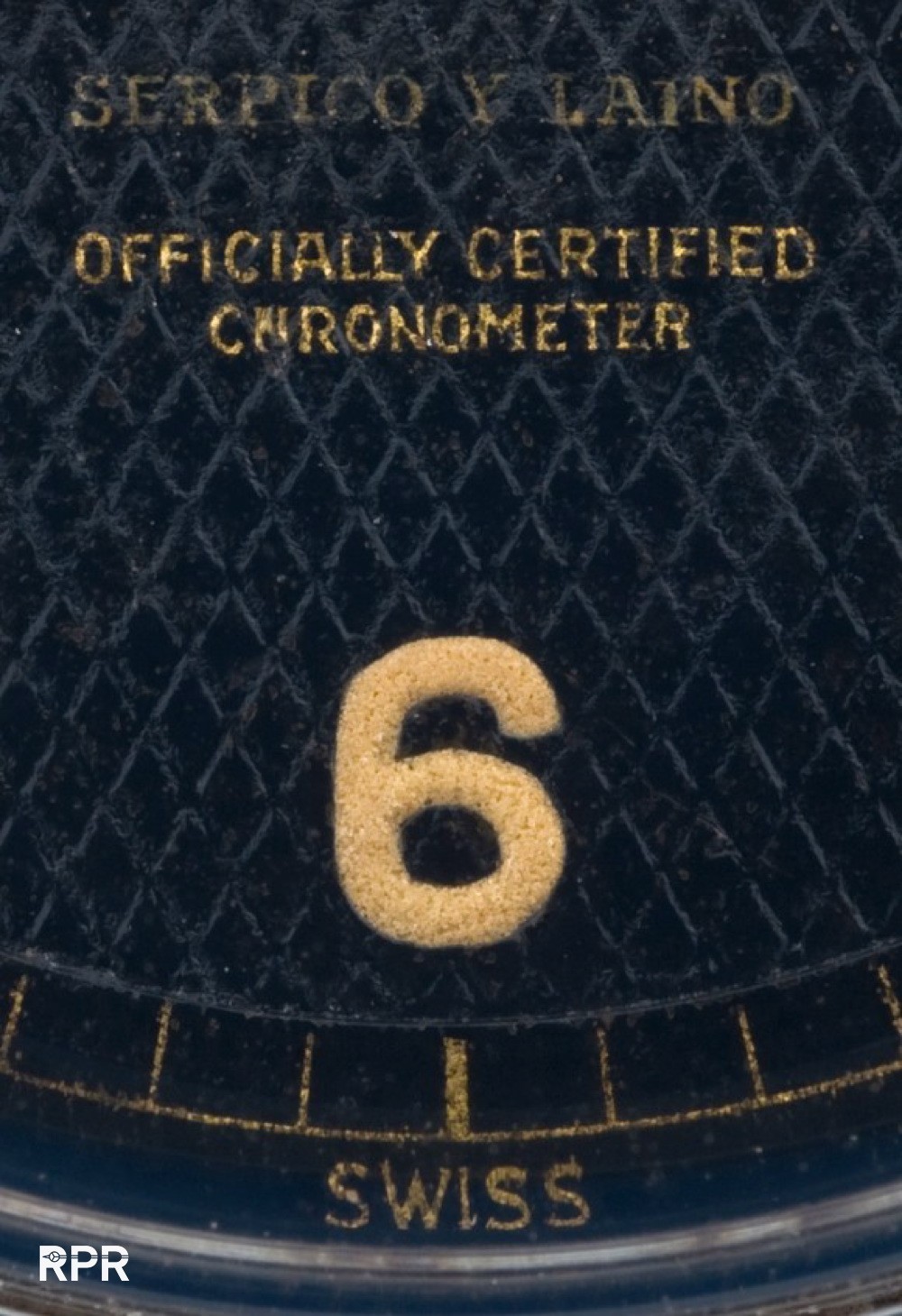
Comparison: You will notice that the graphic chanced over the years with the later version we see on the right. The Submariner text has become more modern.

A typical detail you hardly see at any pictures on the internet is the unique patina of the glossy dial surface. The to each glossy Rolex dial unique tiny cracks are only visible when you play with the light. Furthermore we see that the top part of the Rolex print is punched in the dial and as well the ‘submariner print. The depth rating and OCC are added later, on top of the finished lacquer, making it possible for Rolex to print 1 dial and later modify it for their needs.
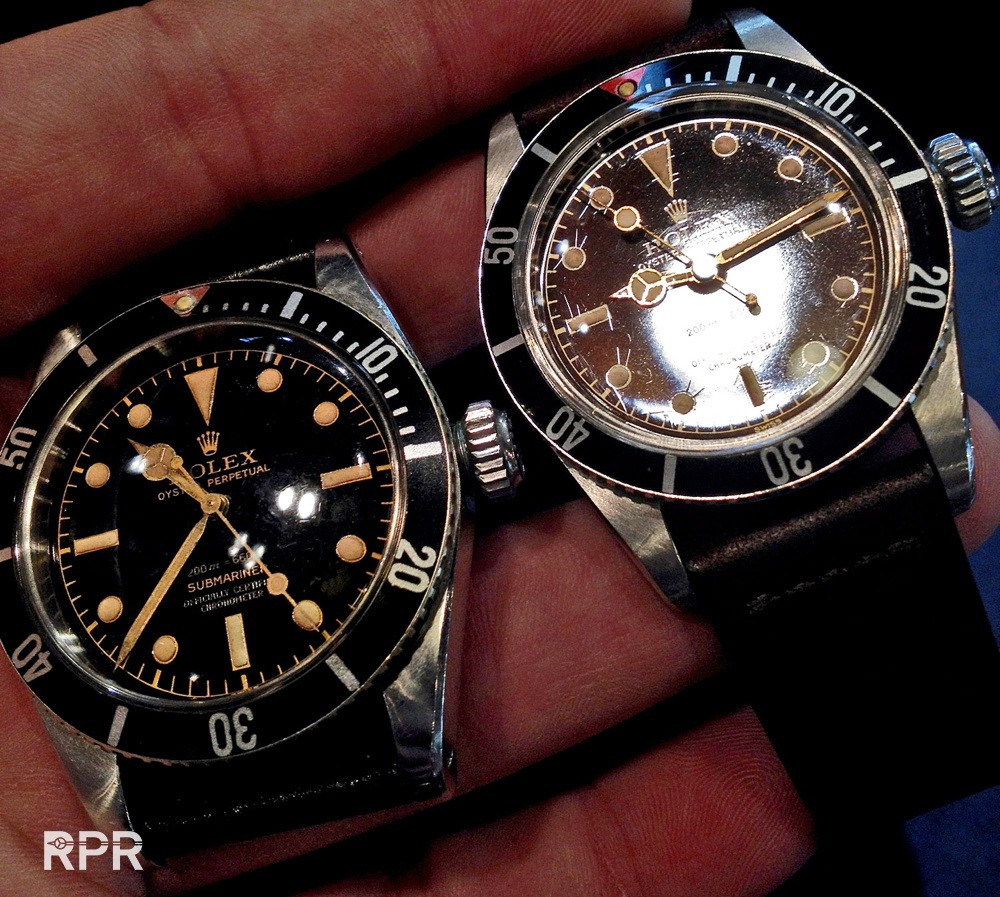
Not many Rolex collectors are aware about the fact that the Big Crown & Small Crown versions are having the same graphics. Below you see that at this pre stamped the depth rating for small crown was used and added over the already finished lac. First Rolex service dial? (follow the link to more vintage Rolex study).
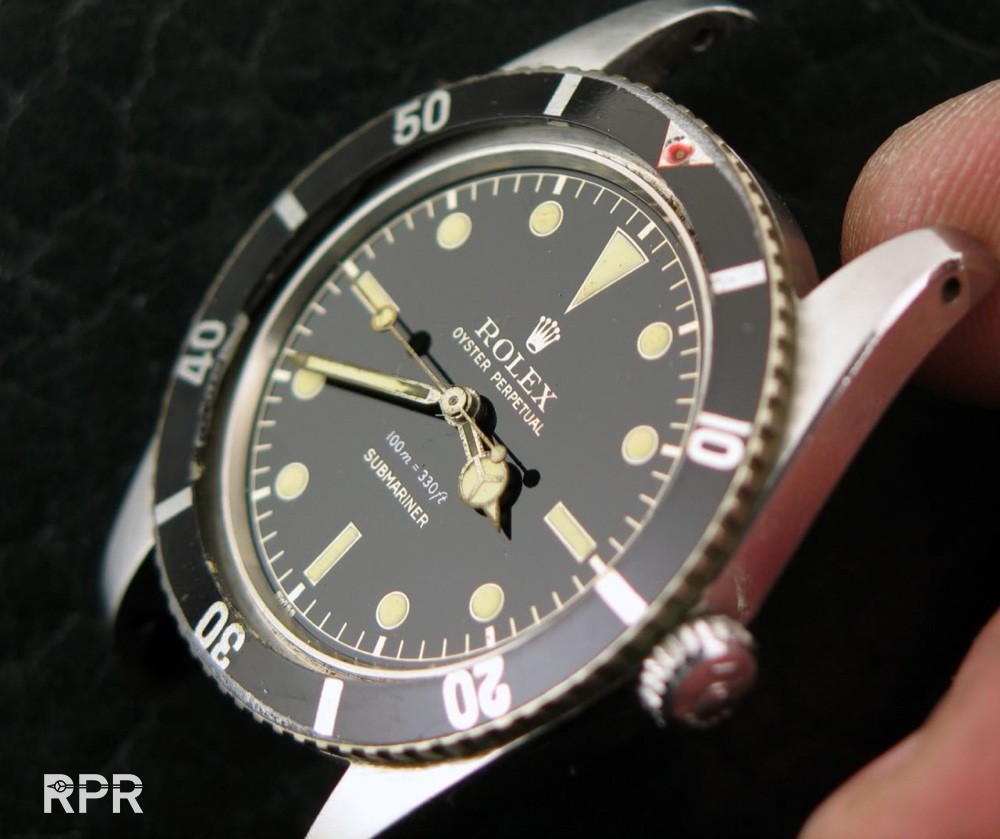 Another interesting detail is the white surface underneath the radium plots that was added to the dial so the luminous could stick on easily. Rolex luminous is always between the gold surroundings and hardly ever will go over it, something you see with later resumed dials a lot, the luminous material is often bigger then the white plot…
Another interesting detail is the white surface underneath the radium plots that was added to the dial so the luminous could stick on easily. Rolex luminous is always between the gold surroundings and hardly ever will go over it, something you see with later resumed dials a lot, the luminous material is often bigger then the white plot… 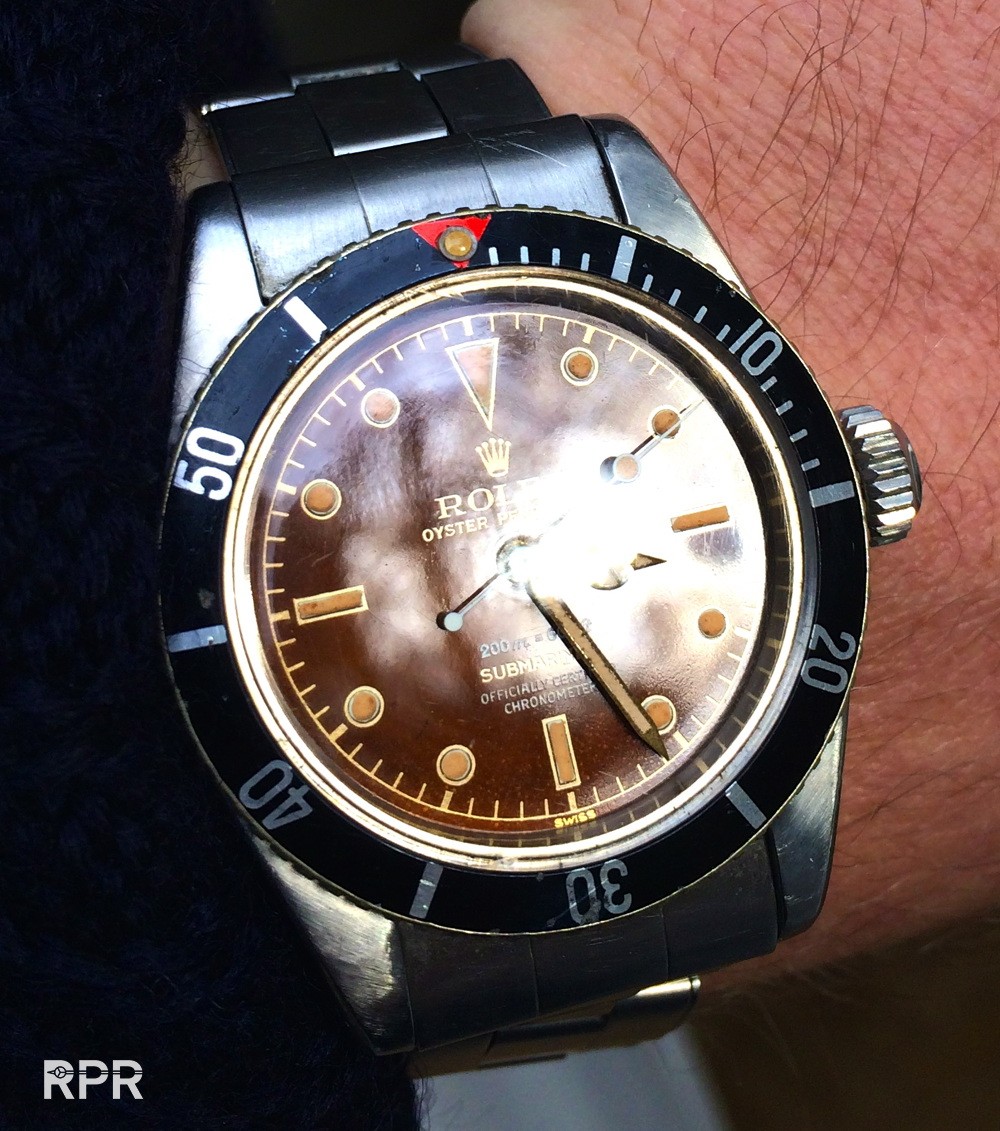
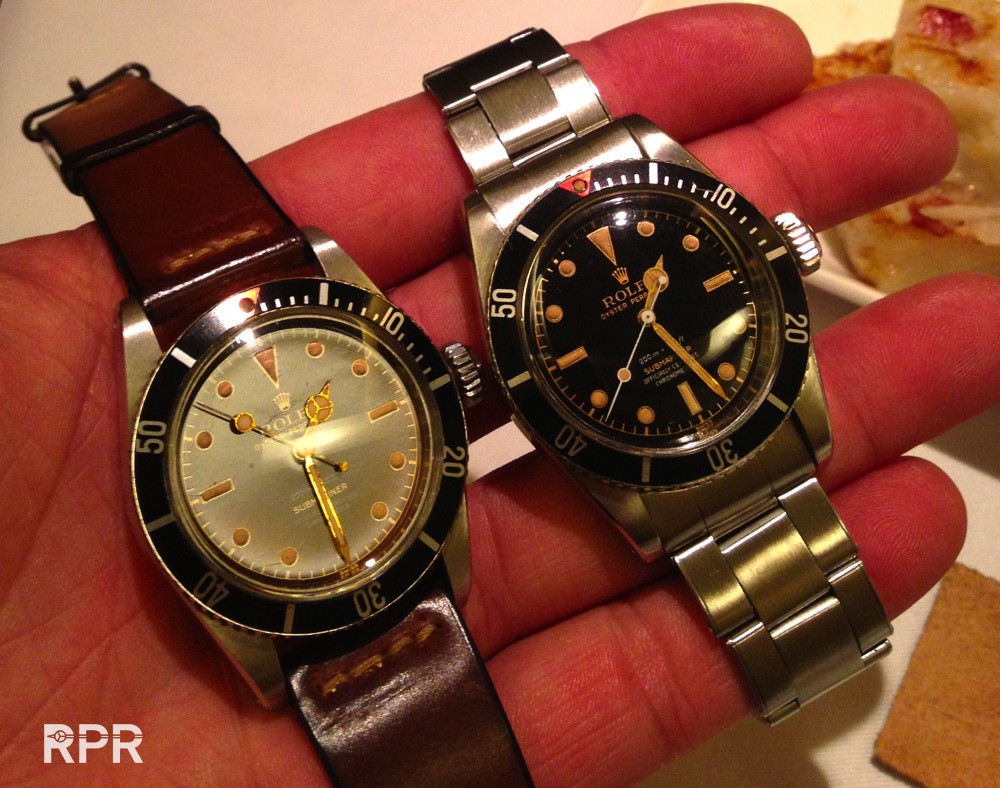
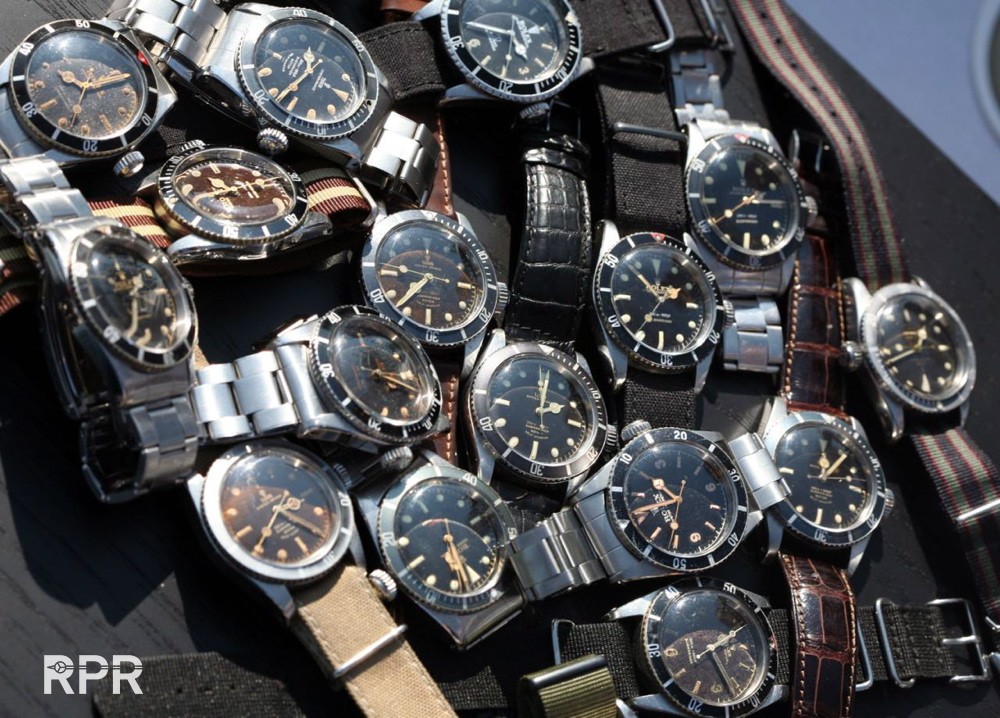
If moisture enters the case, it will damage the surface and leave little black stains on the lume dots, as you can see below. Again, the luminous on the dial and hands, are the condition meter showing you what happened over the years with the watch. Moisture and condens will be sucked up by the luminous and make it chance color to dark and ugly, then it will destroy the top layer of the dial.
From the front hardly visible but once you turn the dial slightly you notice the infrastructure of cracks. My believe is that the dials have been stored for a long time at a dry place and that this has cracked the surface…
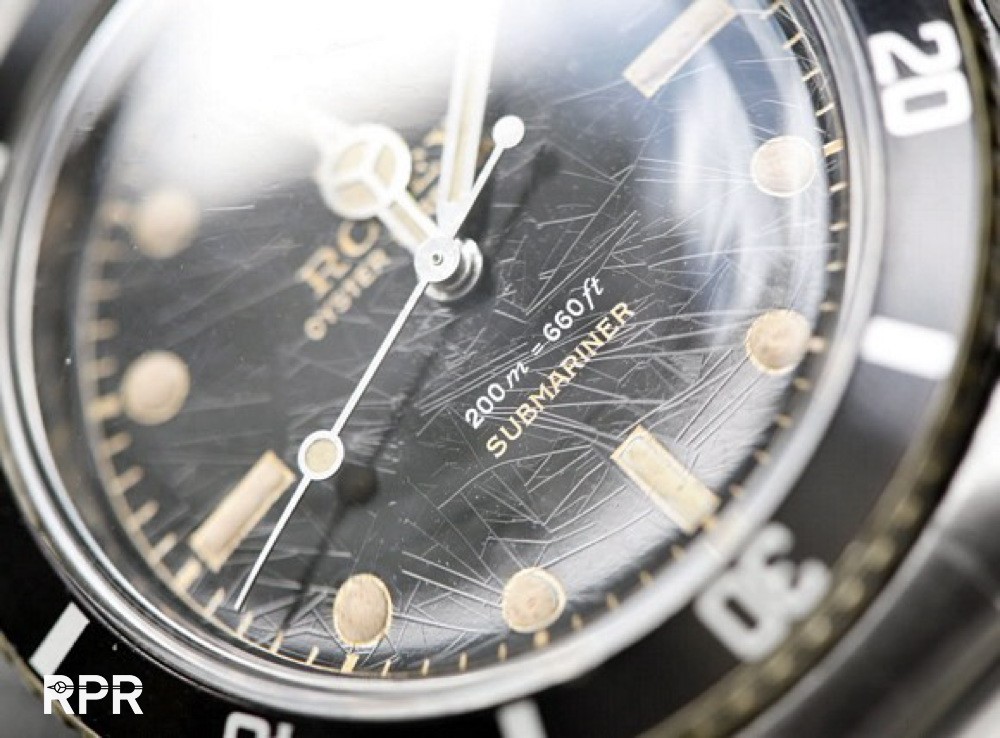
Yet another example of cracked surface. This particular SCOC small crown 5508 is almost all over damaged and the grooves have become very deep… 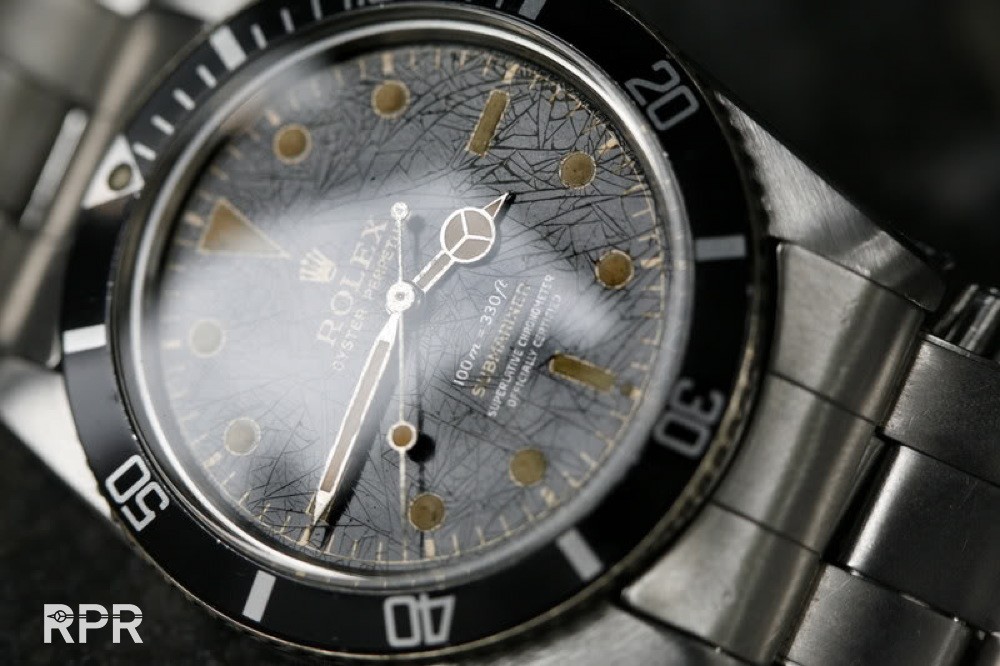
And another cracked one. In both 3 examples we see that the hands have also been chanced during a service by Rolex to later smaller ones, meaning that all 3 of them had a water problem back in the days and the original radium hands where chanced to later tritium ones, hence the different in color of the luminous.
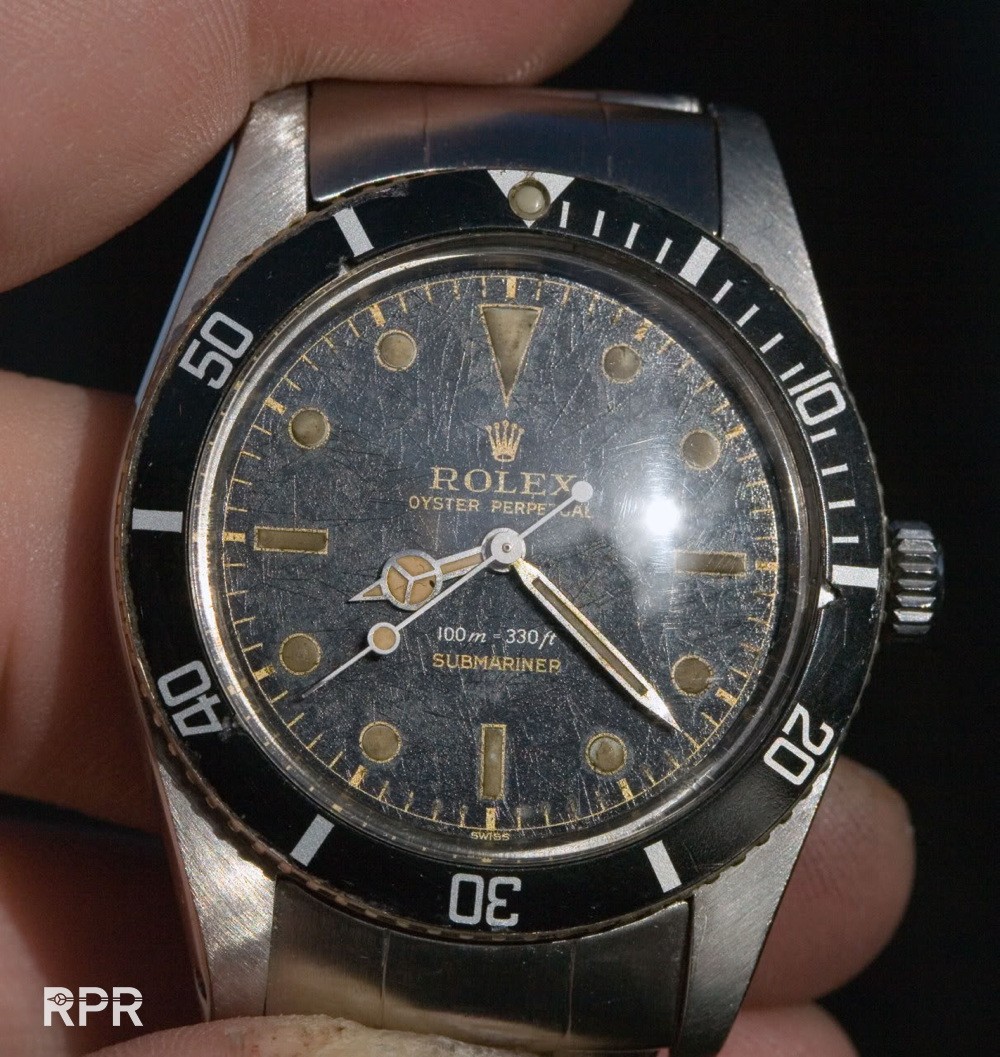
See below a broken dial finish that flakes…

While analyzing the below 2 photo’s now you clearly notice that the hands do NOT match the rest of the color of the luminous, thus something has happened afterwards before sit went to auction. Are these the original hands and has the dial been swapped perhaps?
Below you can see pictures of the radium investigation I made on many different sport Rolex and other watches during the recent years. I specifically was interested to see the rate of a untouched original owners Rolex as with them we knew nothing has been done to chance the look / originality. Below a early Panerai Radiomir ref 3646, below measurements from the back..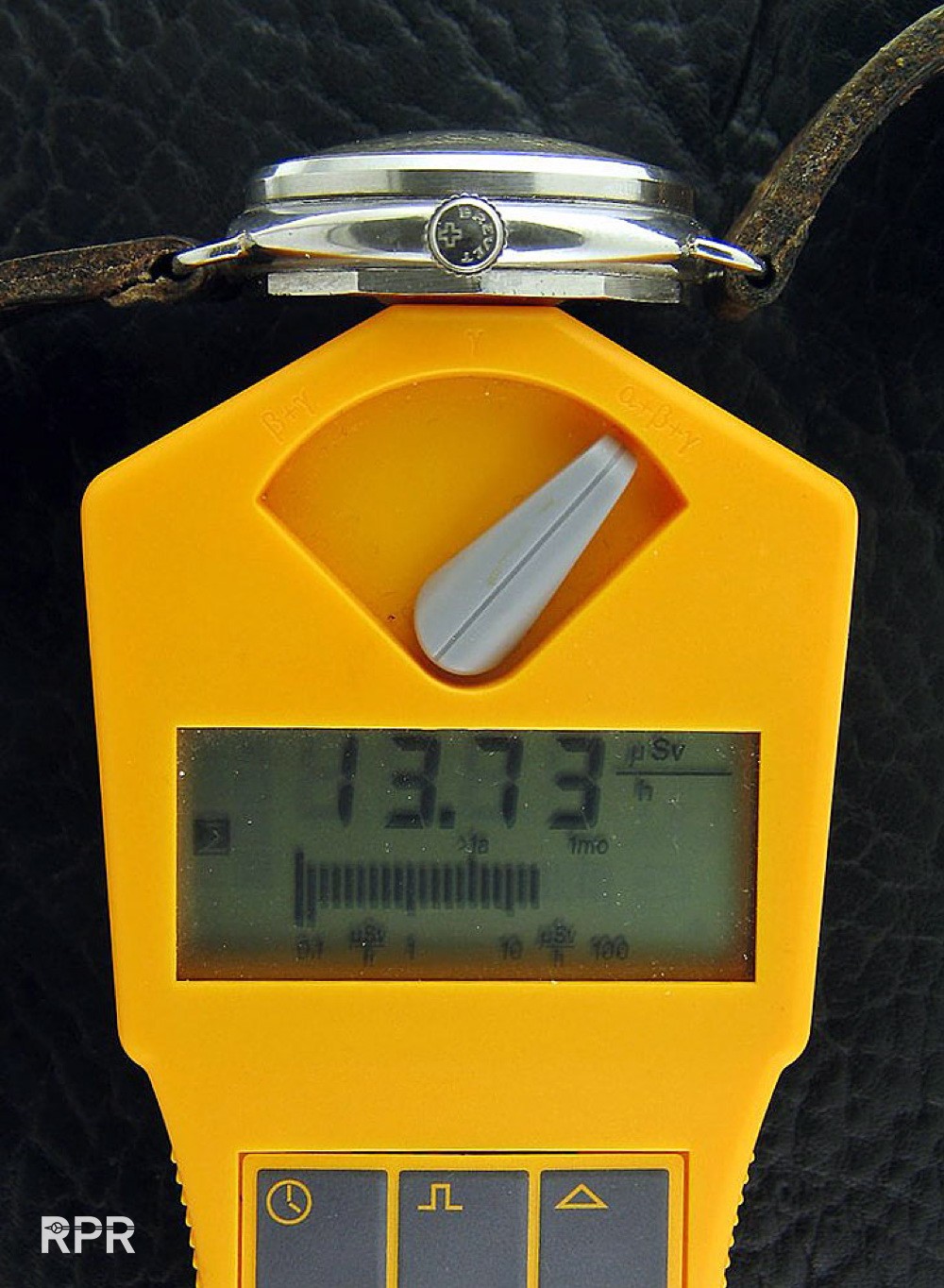
And up front it’s much higher. This ref 3646 is still in original untouched condition with it’s original crackle crystal..
A 1953 Rolex ref 6202 in untouched original condition showing us a high radium dial measurements…
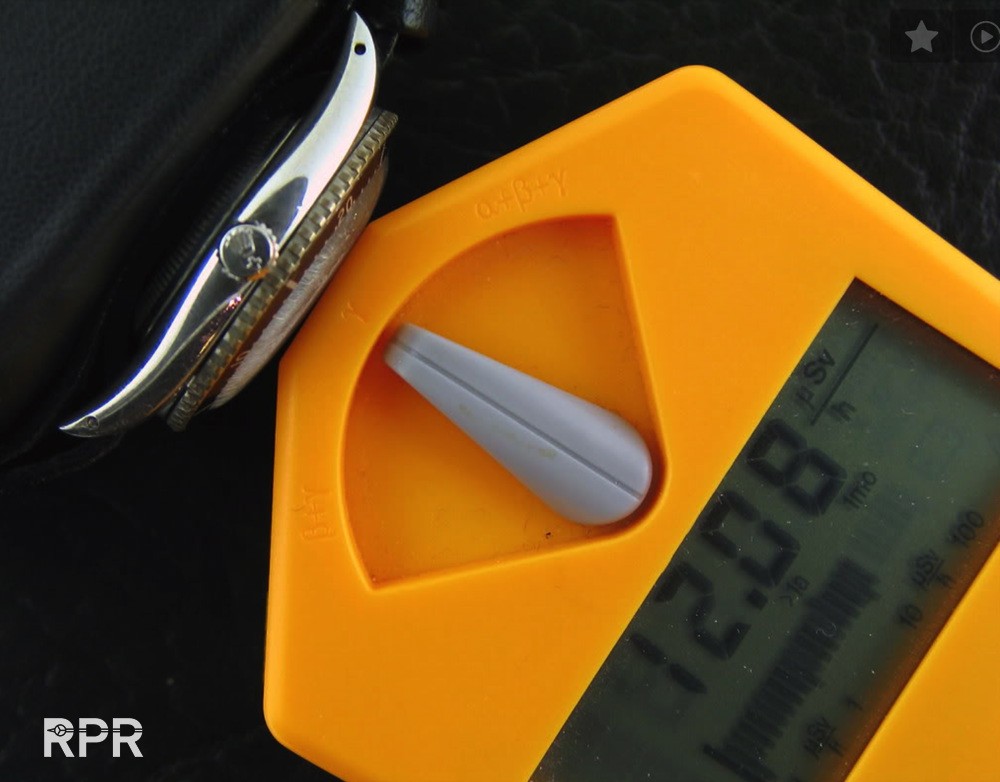
A Rolex ref 6542 up front, untouched 1958 example with bakelite radium bezel..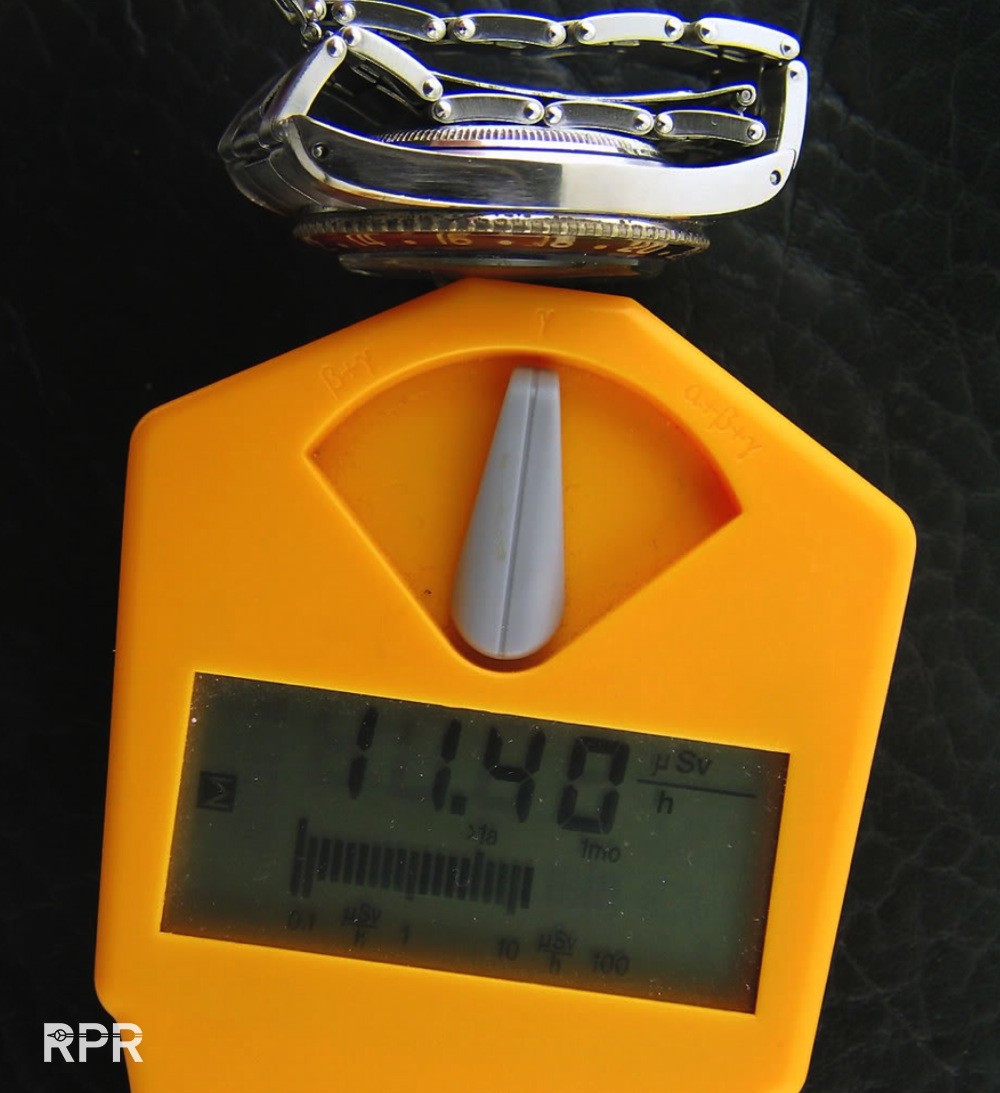
The geiger went really crazy on the early Panerai tools, below a high reading on a compass..
And on a original untouched Panerai depth meter…
From the Panerai book of Volker some more geiger results.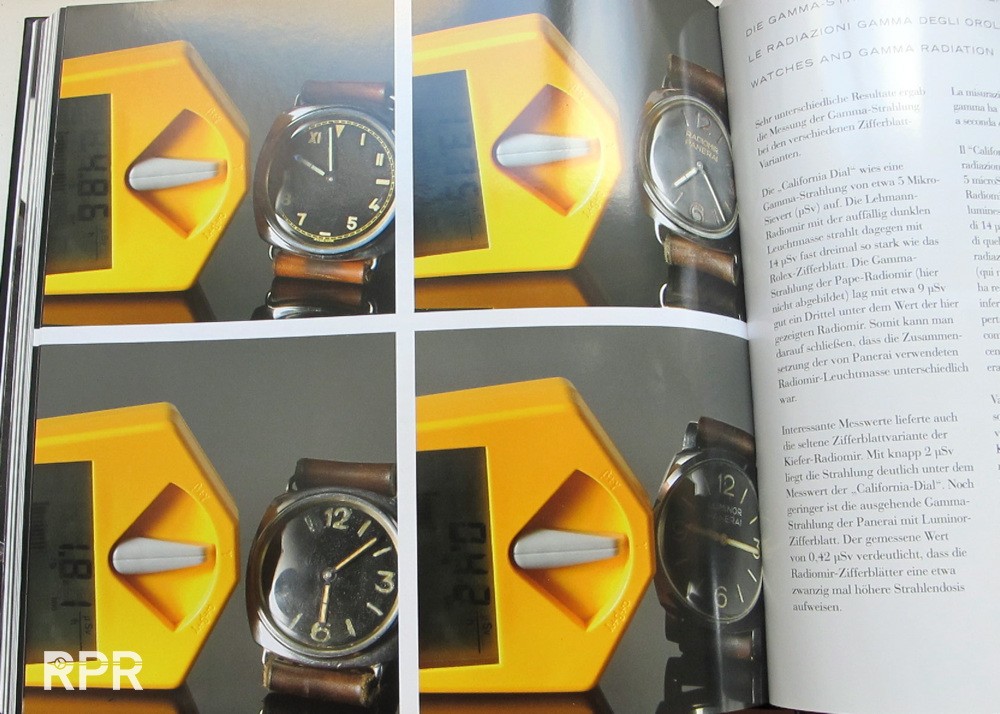
Another tip besides using a geiger meter is using ultra violet light to determine the presence of radium is a must…
The bakelite bezel on the GMT Master ref 6542 was highly radio active. This has become a huge issue in Rolex past when a client brought his Rolex in the US and wanted to ship it out to Singapore, the government noticed the extreme radiation and started a investigation against Rolex in the US. All 600 plus examples that where sold in the US had to be tested on the presence of strontium 90… 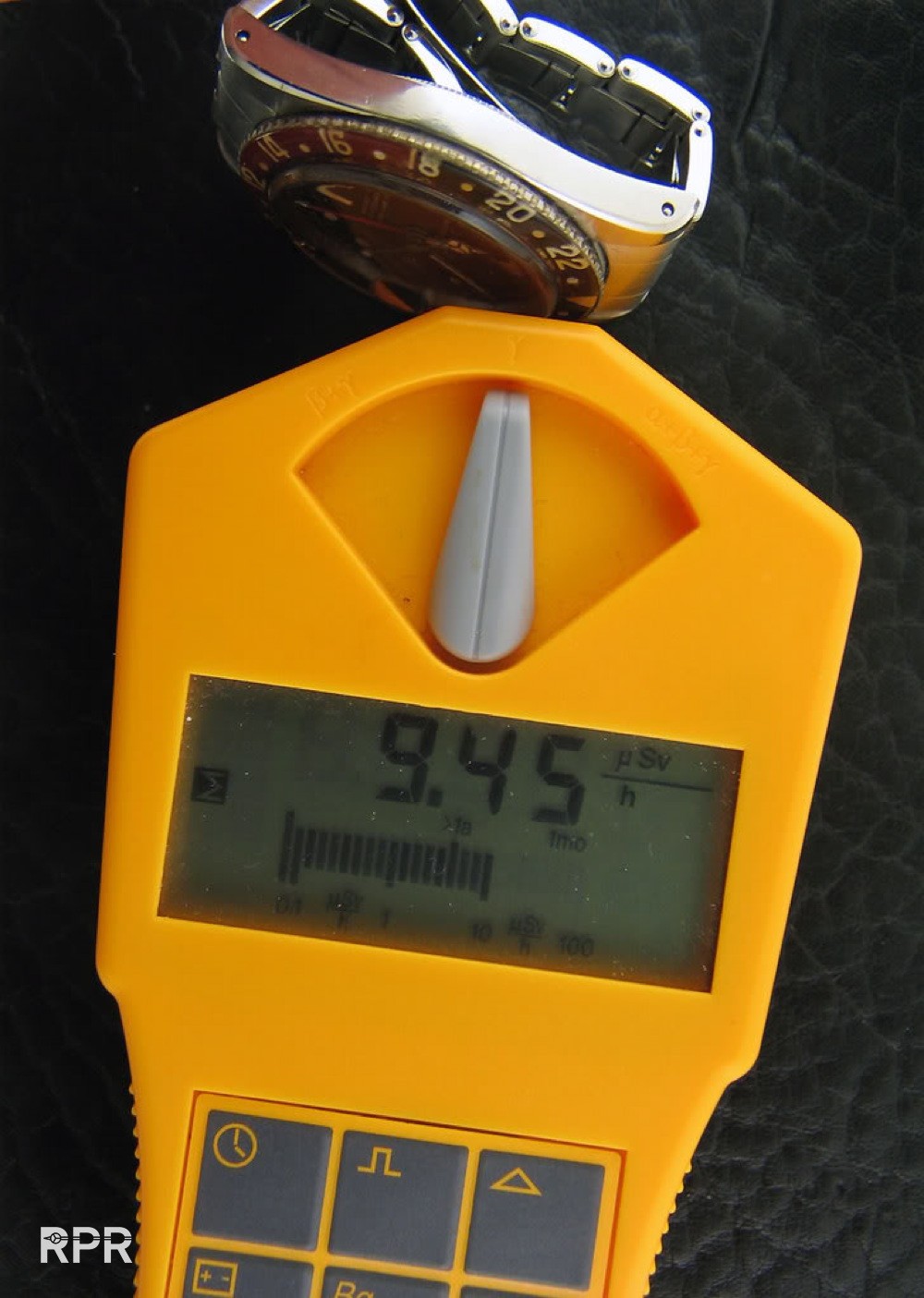 Below you see a official Rolex document that states that the 6542 GMT master has been tested and no violence of AEC regulations. (follow the link to more vintage Rolex study)
Below you see a official Rolex document that states that the 6542 GMT master has been tested and no violence of AEC regulations. (follow the link to more vintage Rolex study) 
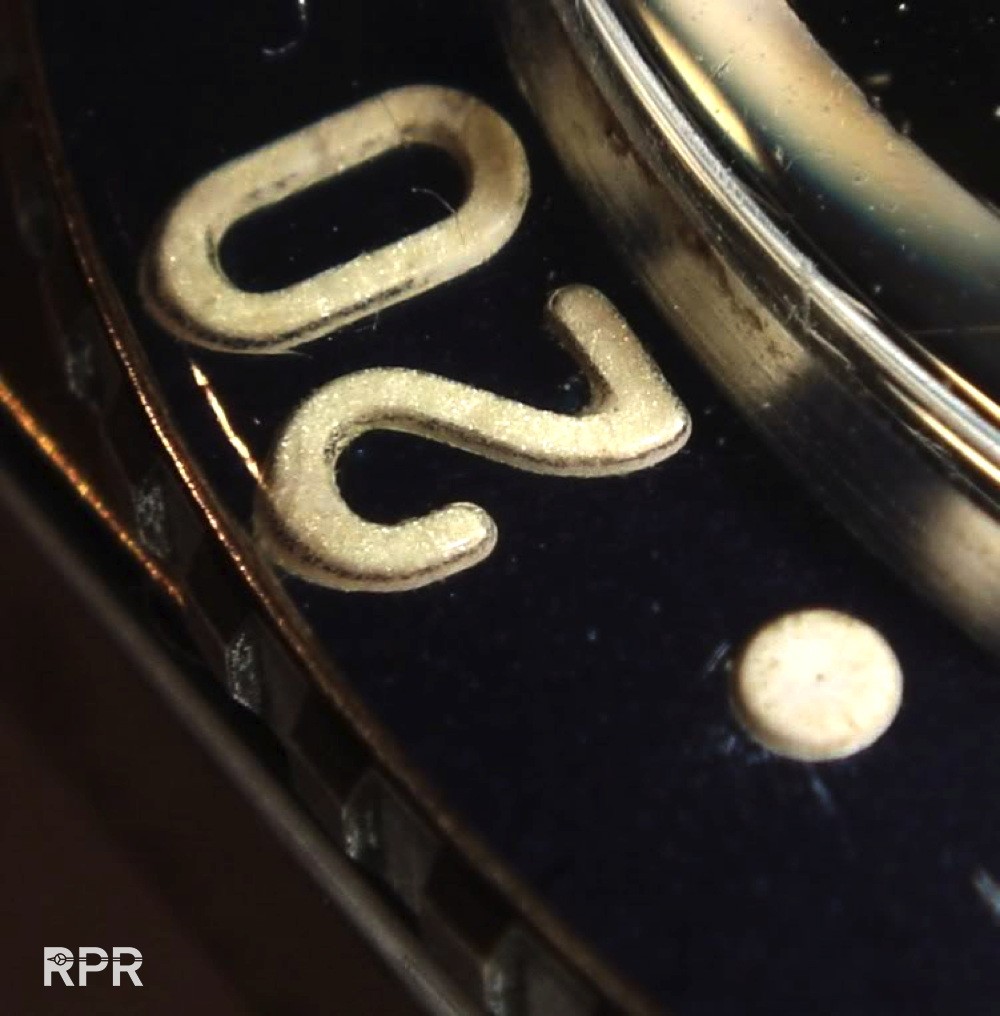 Above a close up of the bakelite GMT bezel and below the GMT Master 6542 of legendary explorer next to Jacques Piccard Deepest dive, Lt. Don Walsh..
Above a close up of the bakelite GMT bezel and below the GMT Master 6542 of legendary explorer next to Jacques Piccard Deepest dive, Lt. Don Walsh.. 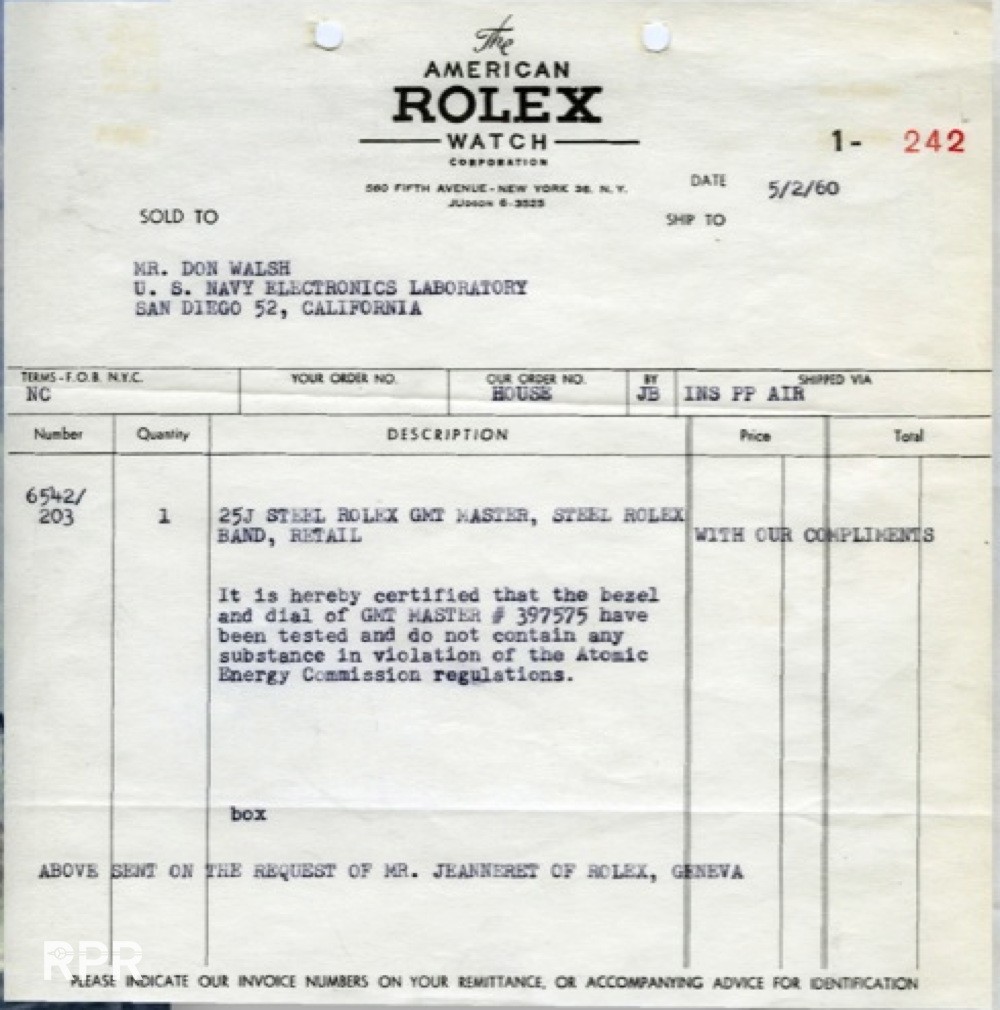
You see the bezel lights up, there where the dial is not reacting to the ultra violet light. Meaning the bezel is radium and the dial has been relumed with non radioactive material…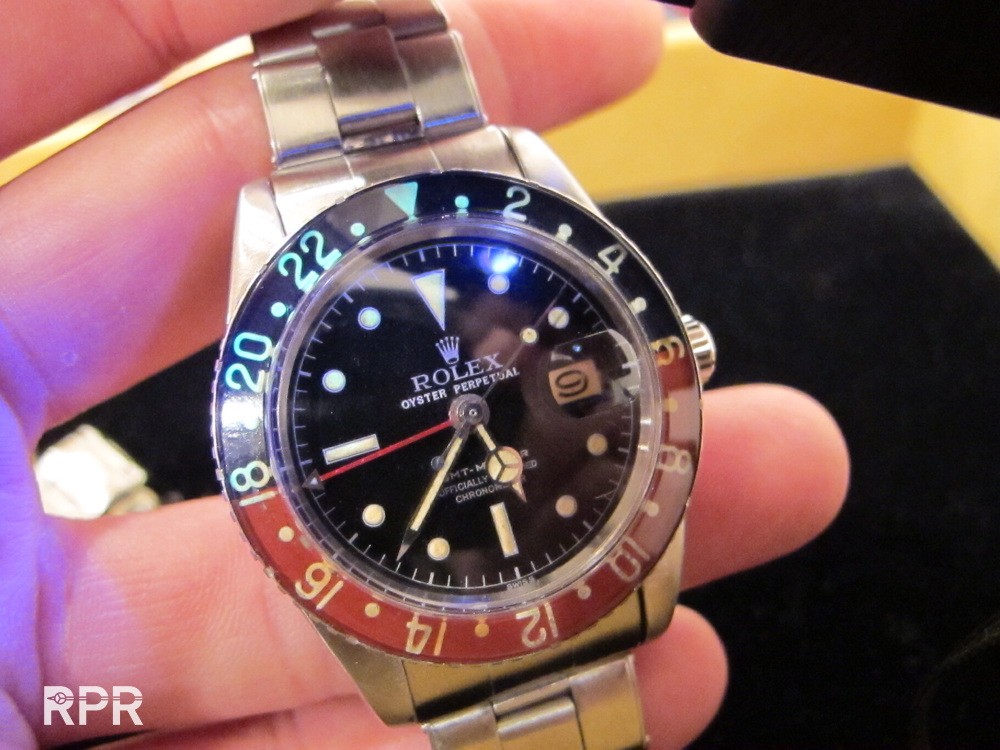

Front radiation of a Big Crown 6538 and below the bright lightning 6 o’clock marker of a 5508 small crown under ultra violet light. The bright 6 o’clock marker was most probably done by Rolex designers to help divers read the dial in the dark quickly and clearly. The luminous dot that was added on the bezel and used for timing the dive is not logically always on the 12 o’clock spot so to help the visuality Rolex chanced the luminous of the 6 o’clock marker to a more greenish mixture is my consensus.
Below you see a early Submariner which has been resumed with luminous. Not always will the Geiger meter give you 100 % proof as nowadays specialist are using old radium to relume a dial. But if you look closely you will see that the luminous is not perfectly added within the round plots, clearly not a Rolex job…
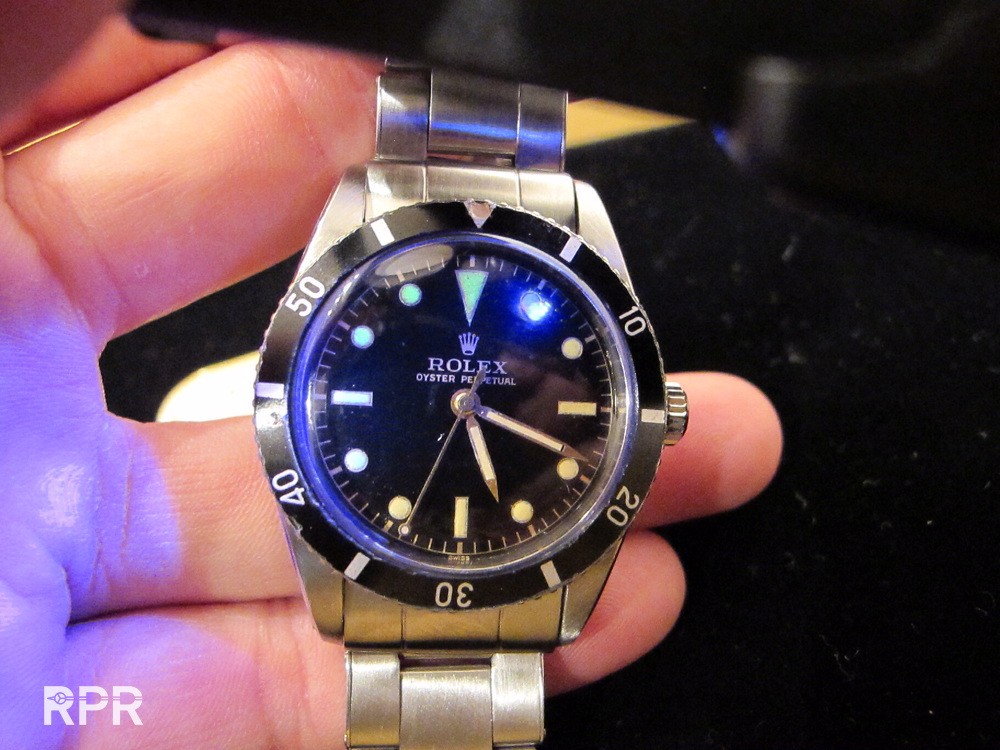 Geiger alert on first generation Submariner…
Geiger alert on first generation Submariner… 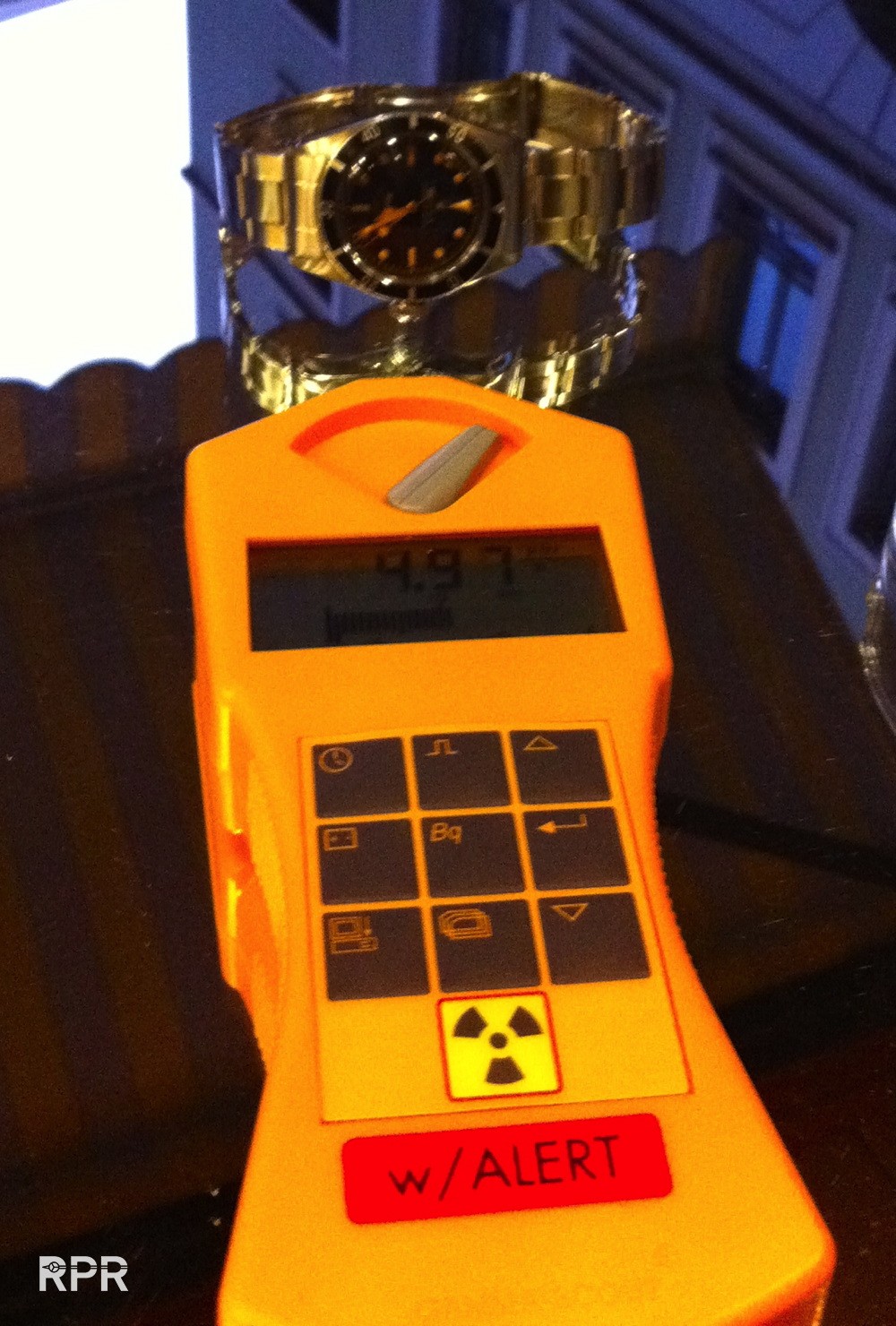
Big Crown 6538 forms second generation, produced in 1958 with glossy gilt dial and radium luminous… 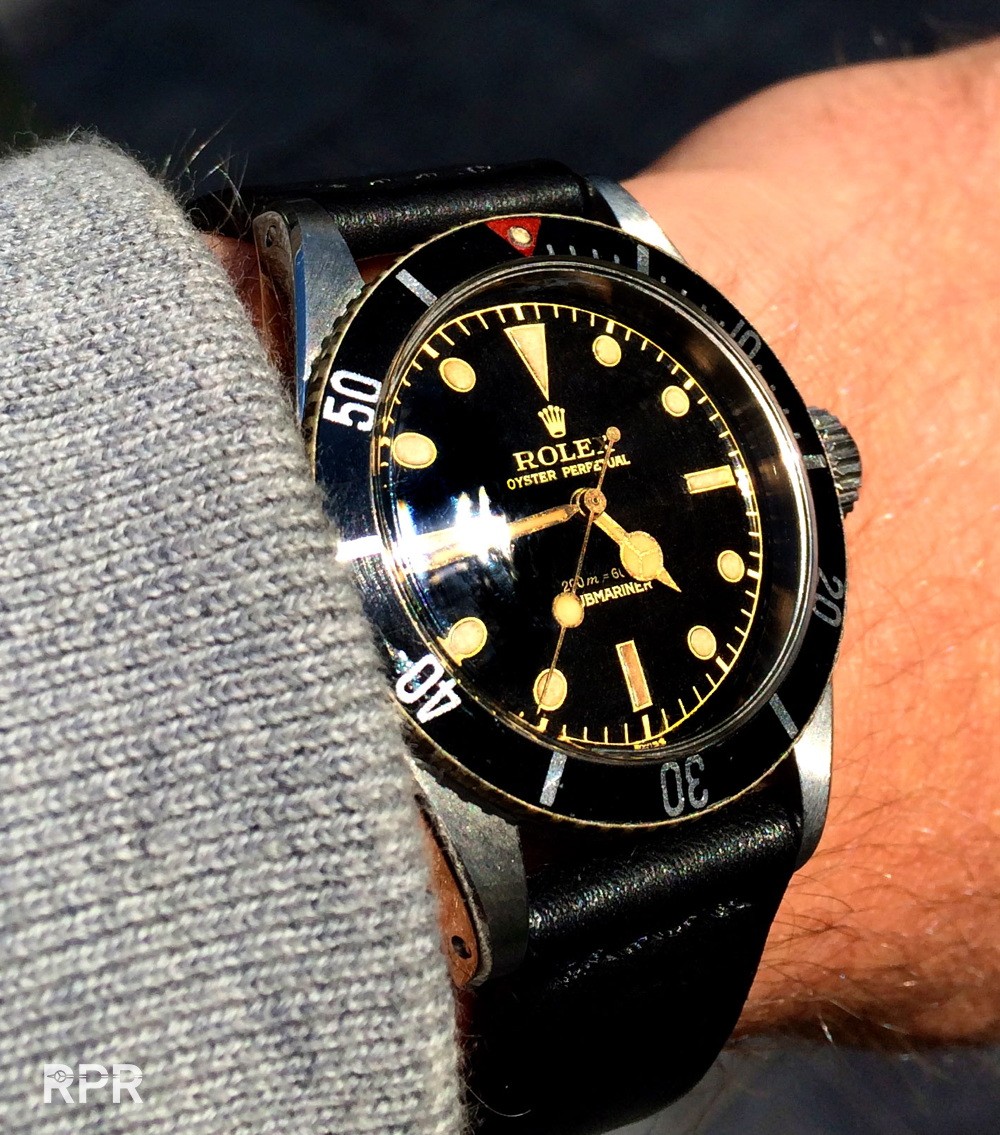 Original condition of a rare 369 Submariner version when it was discovered. You see the stains of oxidation on the surface, something that can easily be cleaned with distilled water..
Original condition of a rare 369 Submariner version when it was discovered. You see the stains of oxidation on the surface, something that can easily be cleaned with distilled water.. 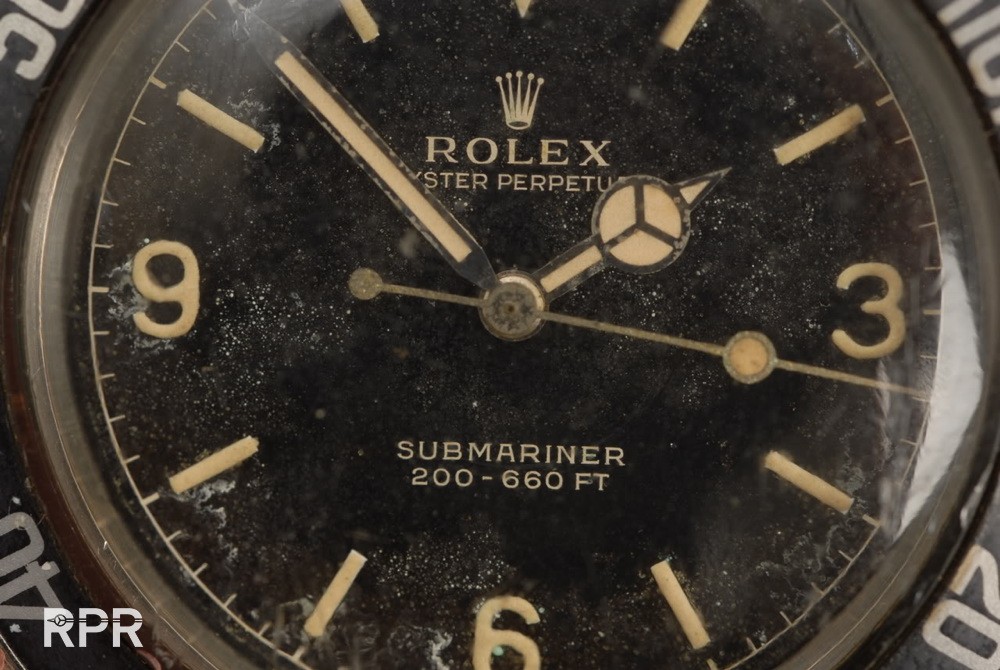 Radium swiss Rolex ref 6234 with original luminous. All plots are perfectly shaped and color on the dial is matching the luminous of the hands, first owner find still in all original condition..
Radium swiss Rolex ref 6234 with original luminous. All plots are perfectly shaped and color on the dial is matching the luminous of the hands, first owner find still in all original condition.. 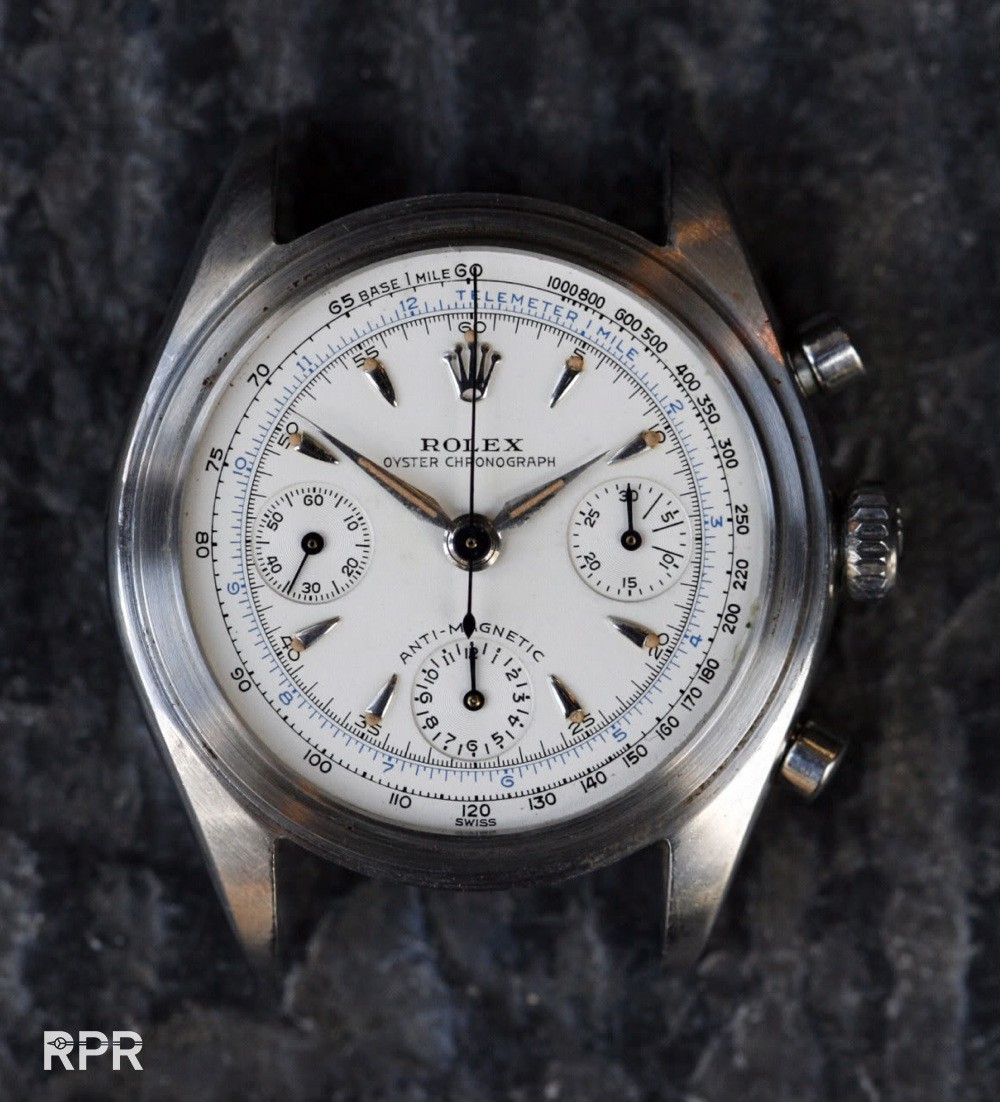
The same we see in following examples, a rare waffle diales Datejust with radium luminous on dial and hands. Notice the “burning marks of the radium” around the luminous, something we see more obvious on lighter colored dials…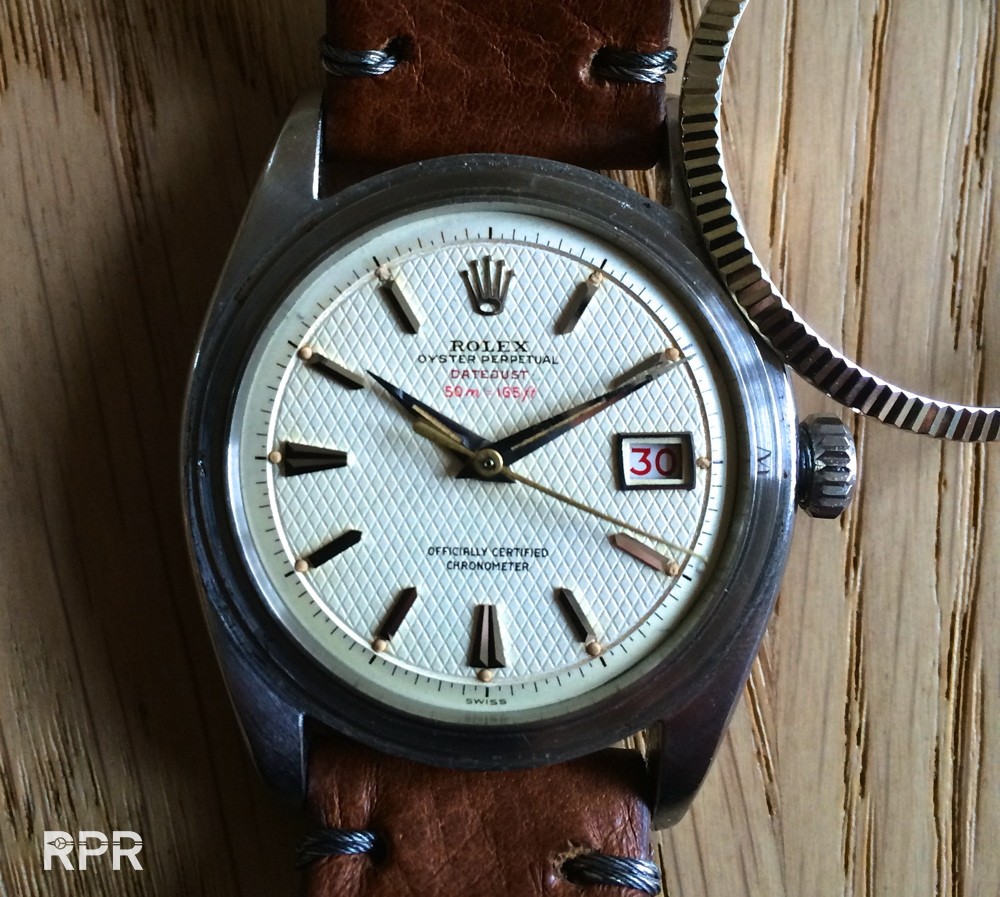
A second generation Rolex small crown what got serviced early 60-ies but except the bezel insert, still has it’s original dial and gilt hands… 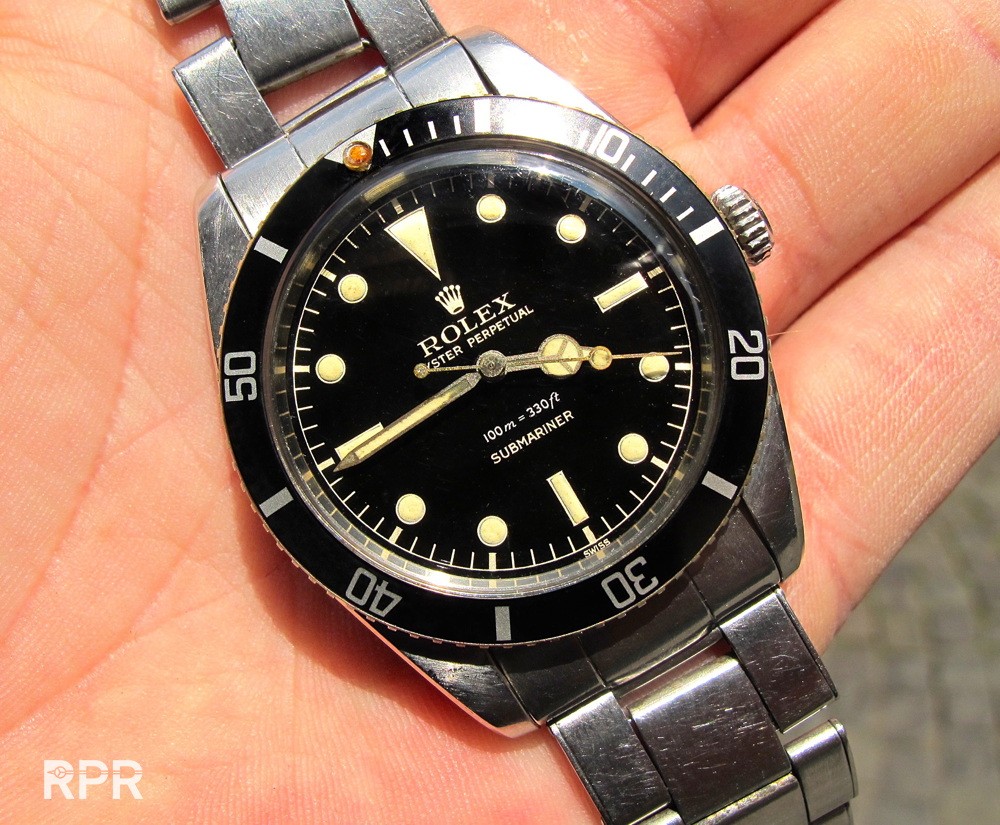
A early Big Crown ref 6538 minute track service dial with tritium ( Swiss – T<25 ) Different coronet and print technique.. 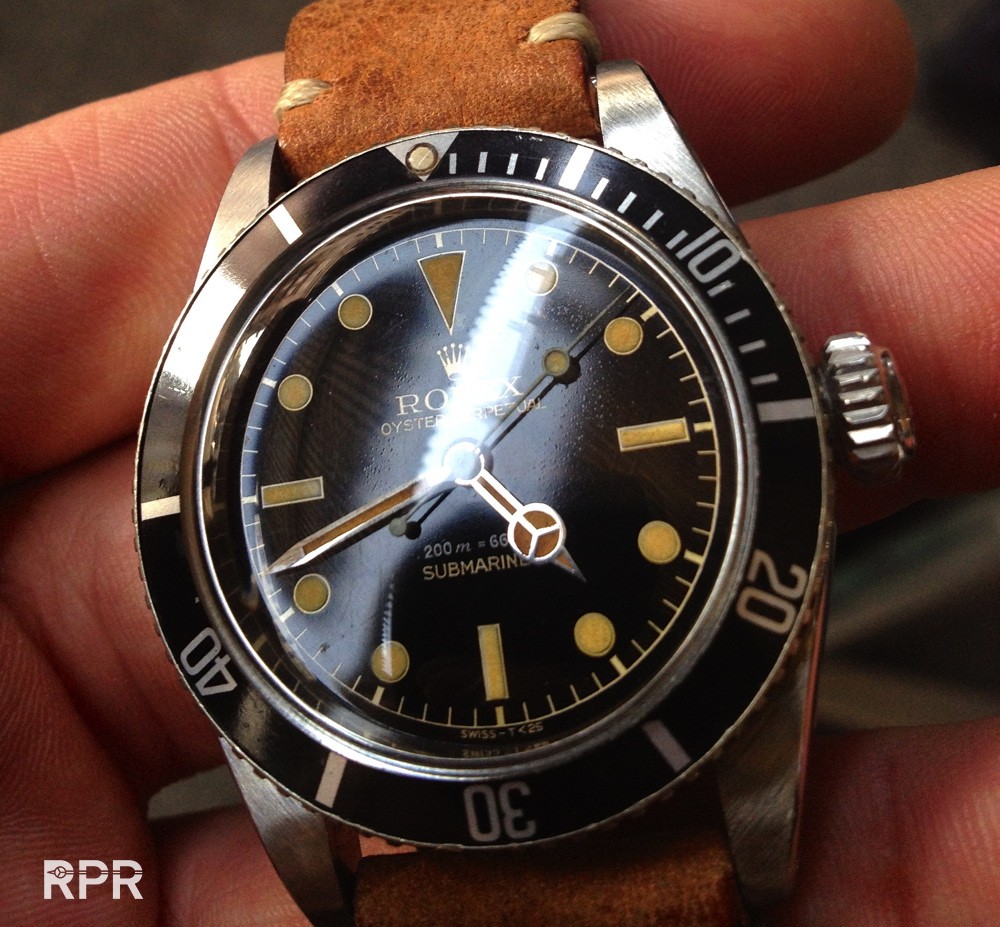
A 1958 Rolex Small Crown Submariner Ref 5508 with it’s original bezel and spidered tropical dial. We see the humidity in the hands turned a bit green. 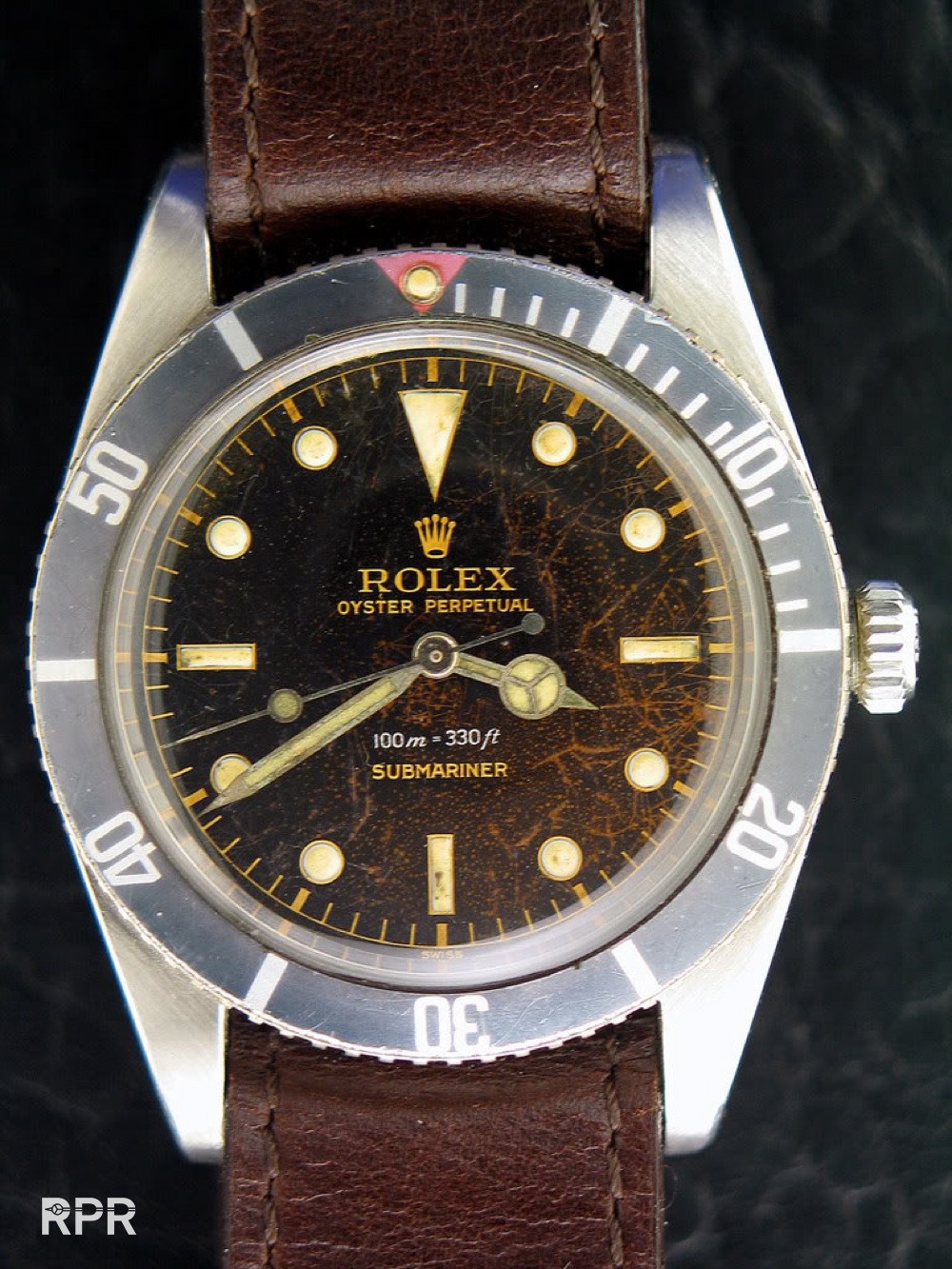
A ‘burned’ Big Crown dial that due to humidity, dry storage and lot’s of UV light chanced color and cracked in the surface…
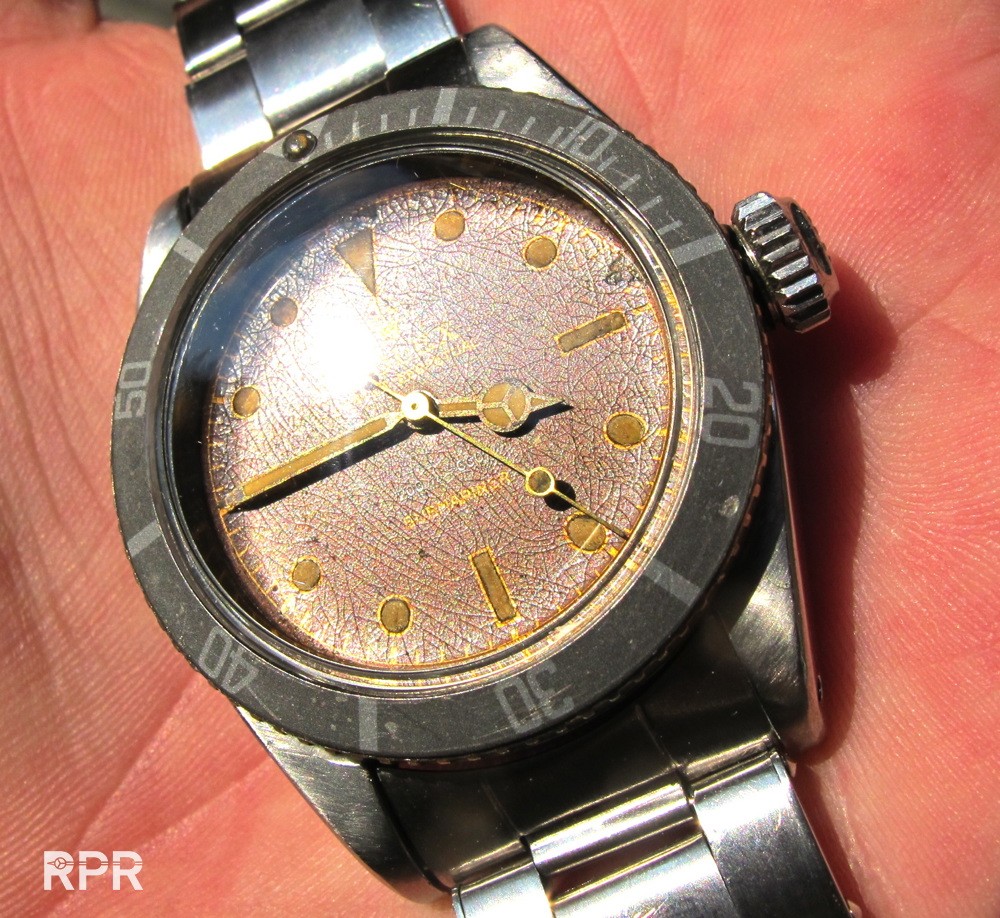 Below you see how the moisture the radium chanced to green spots around the luminous dots on the dial. Nobody would really care about this face unless you see the backside…
Below you see how the moisture the radium chanced to green spots around the luminous dots on the dial. Nobody would really care about this face unless you see the backside… 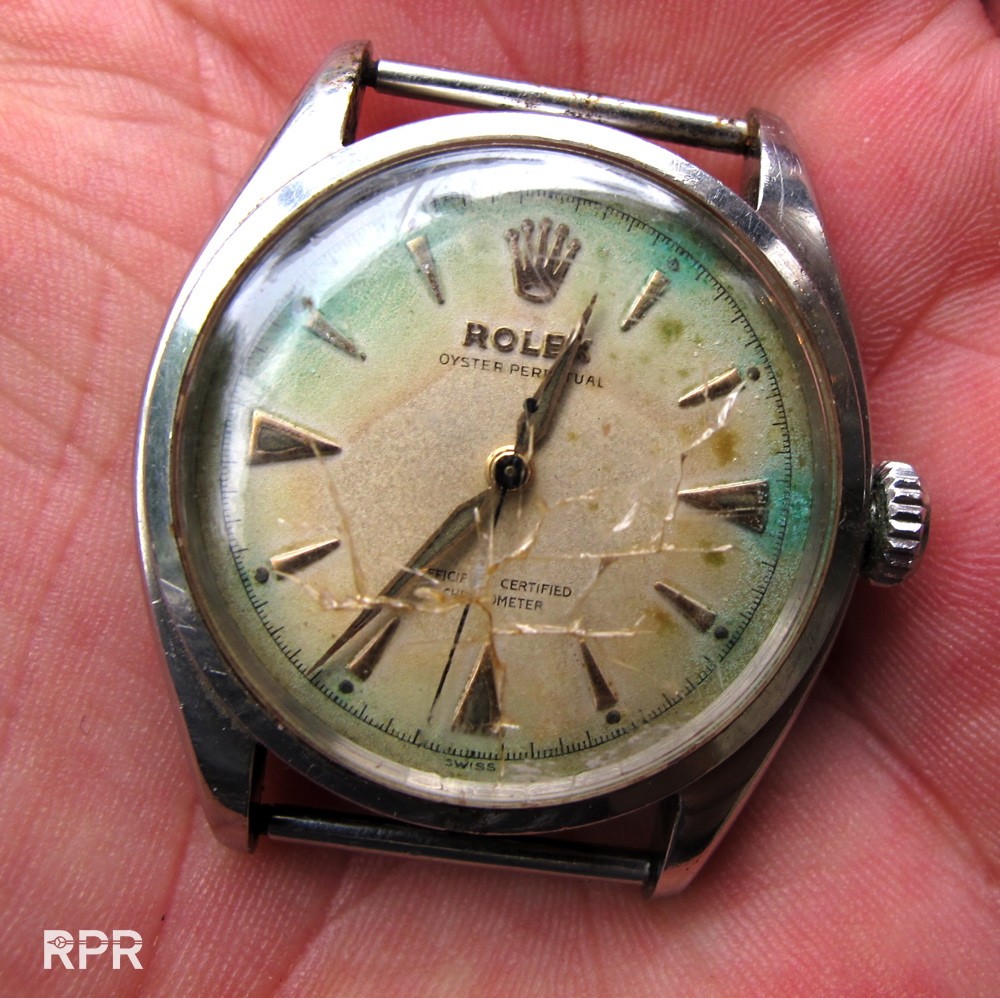
To Sir E. Hillary from Rolex Bosecks, Calcutta 😉 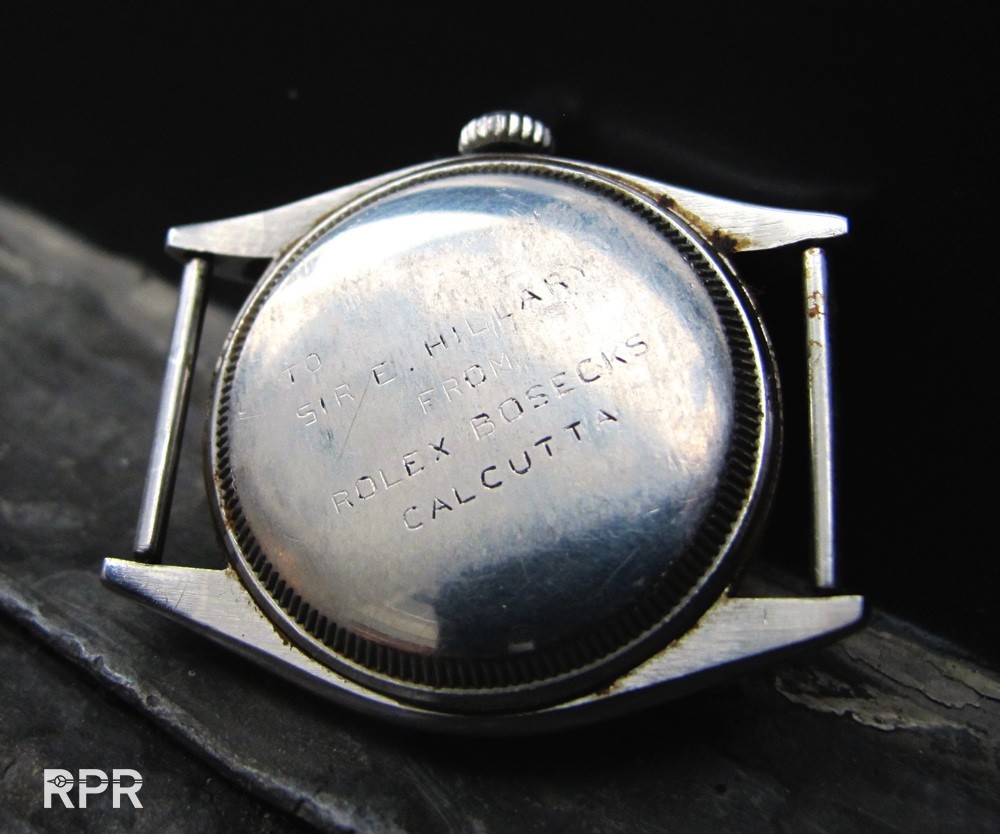
Last version of the Big Crown dial, the luminous becomes less aggressive and much brighter then we have seen before. Also the coronet is different then the typical small & big crown version we are used to. It’s more like the early 1959 Submariner 5512 ‘ thin fingers’ coronet.. 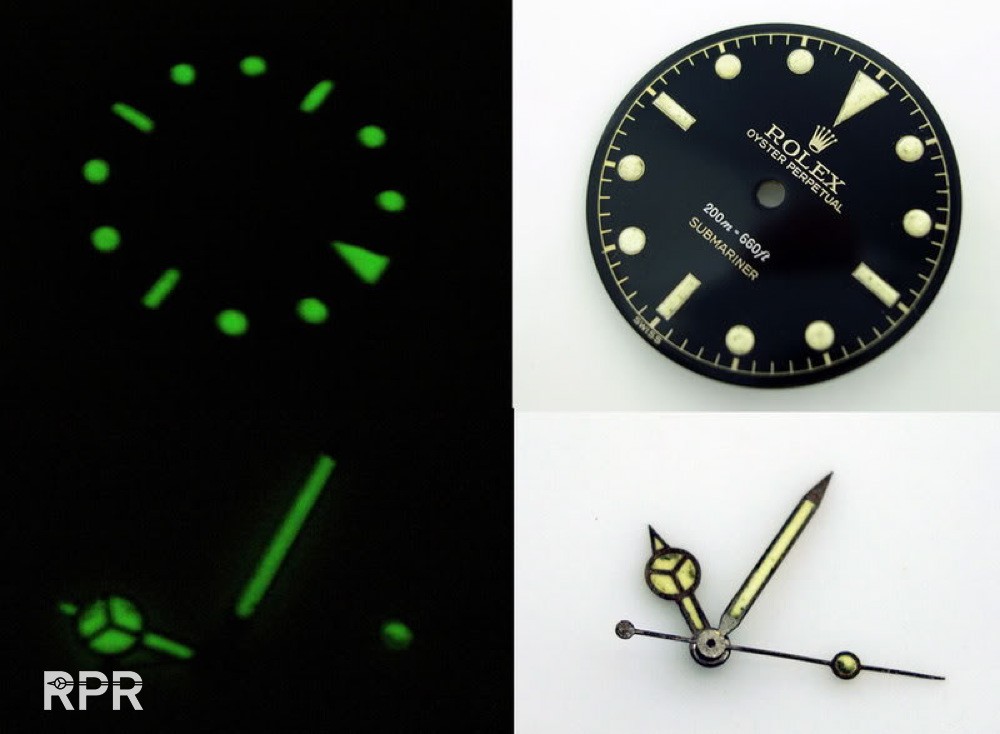 Same much brighter almost greenish colored luminous we see on the last version of the small crown, here below 5508 SCOC 4 liner from 1962…
Same much brighter almost greenish colored luminous we see on the last version of the small crown, here below 5508 SCOC 4 liner from 1962… 
Around 1962 we see the exclamation mark, the little extra dot at 6 o’clock added on top of the dial is most probably a first sign of the dial maker to show Rolex (US – Canada?) clients that radiation has been adjusted to a lower degree..
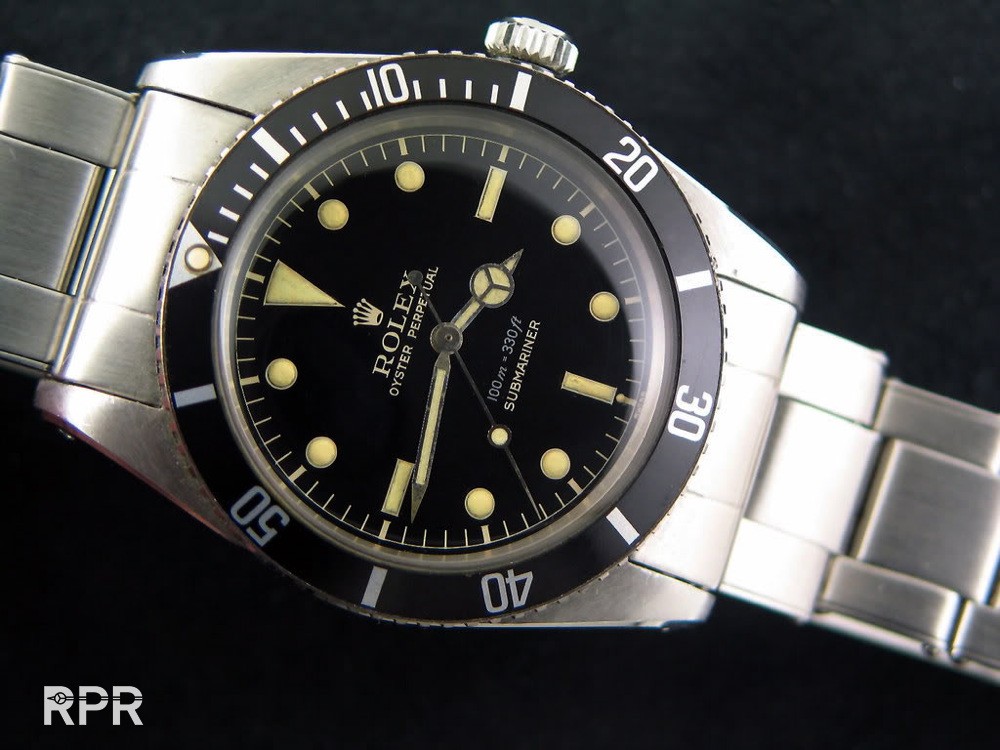
Below you see a comparison of first generation Rolex Big Crown Submariner (1956 – 1957) on the first 2 pictures with 1 color print, then second generation ( 1957-1960) with 2 color print and the last version is the third generation ( 1960-1962) on the far left..
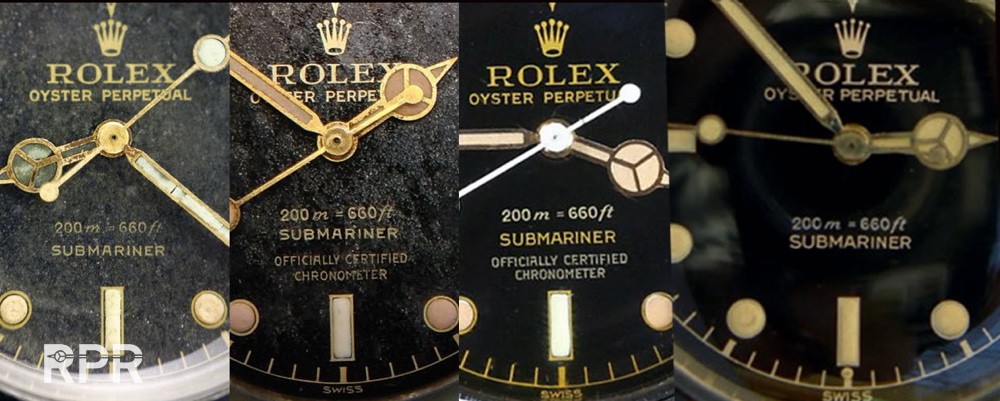
The pre transitional period shows us brighter luminous, this particular small crown Ref 5508 is having a “exclamation mark” we see around 1962 (follow the link to more vintage Rolex study)
Here a perfect example of 1959-1960 luminous on a tropical ref 5512 chapter ring…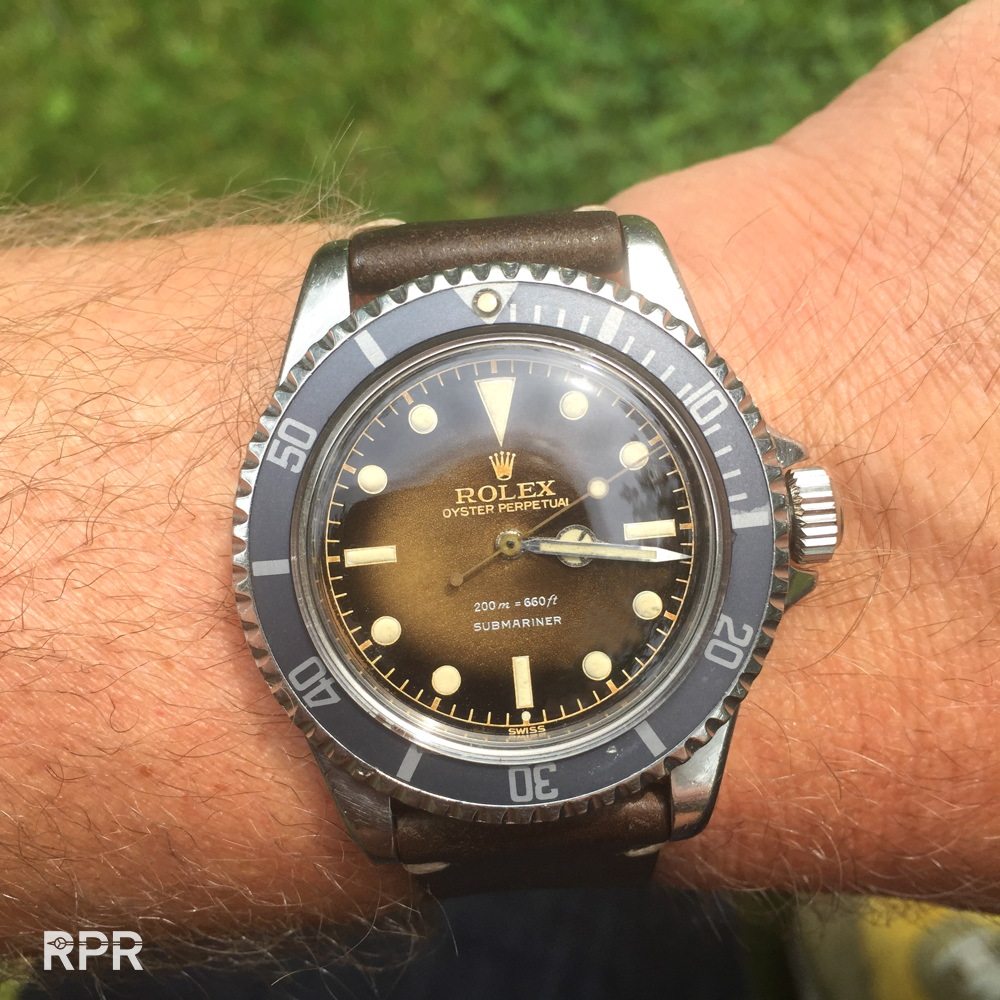
Close up of a late minute track Submariner ref. 5512 SCOC, again we bright luminous added on the glossy dial.. 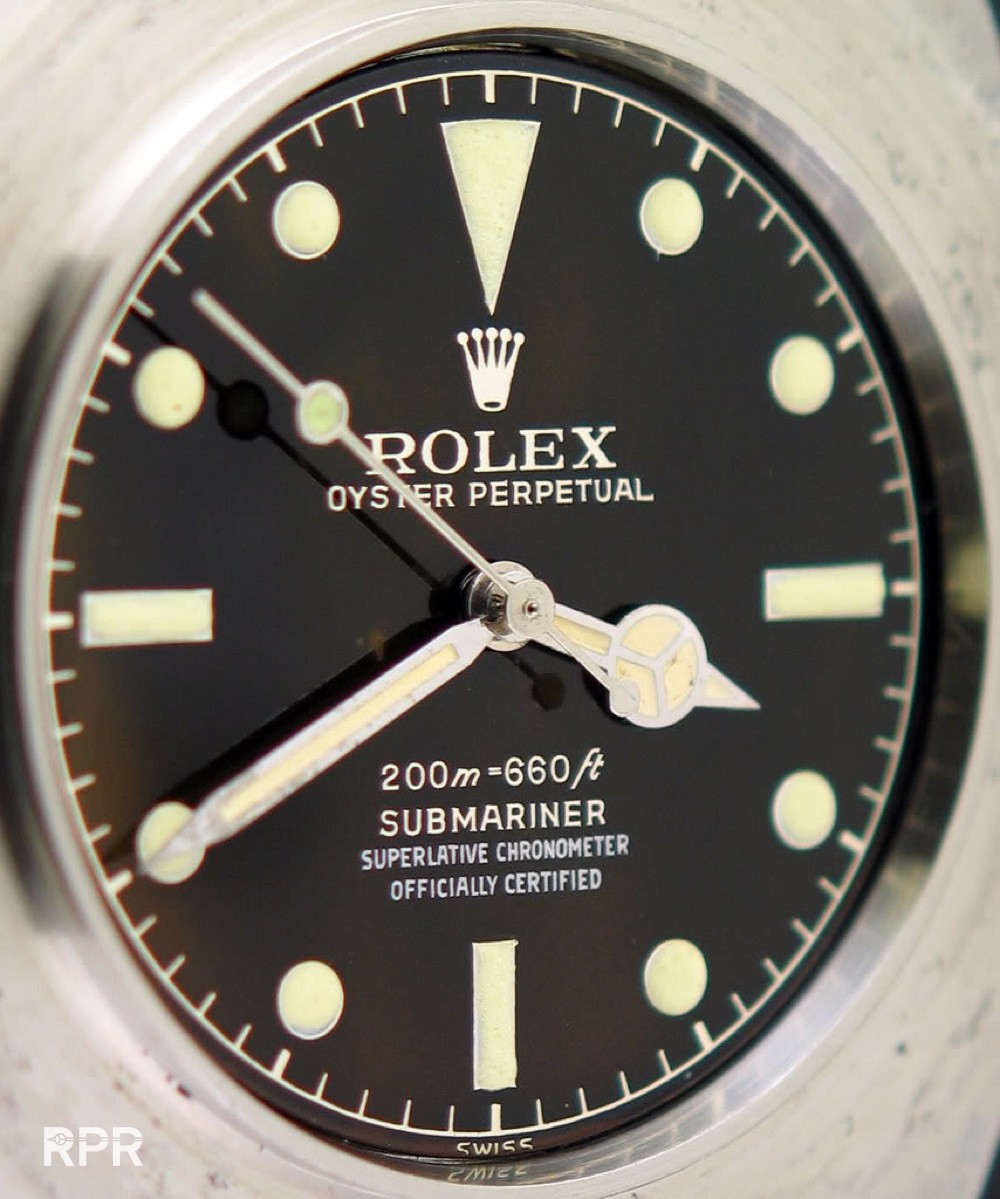 Transitional “Underline” Ref. 5512 on the left and slightly earlier minute track on the right…
Transitional “Underline” Ref. 5512 on the left and slightly earlier minute track on the right… 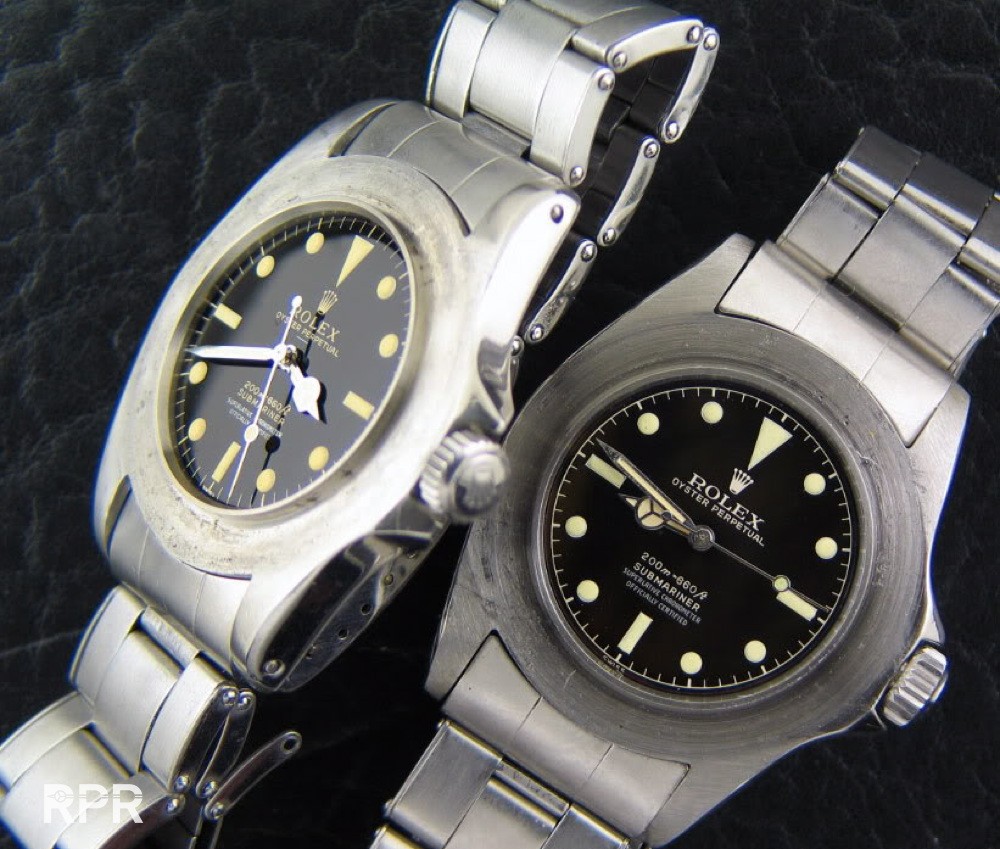
A transitional “Underline” which has been placed between Submariner & SCOC and a “White Swiss” added on top of the track. We see that the surface is slightly speckled, something thats more usual then unusual with these transitional dials. Seems like the quality was not perfect. A older dial plate used for a newer case design perhaps? 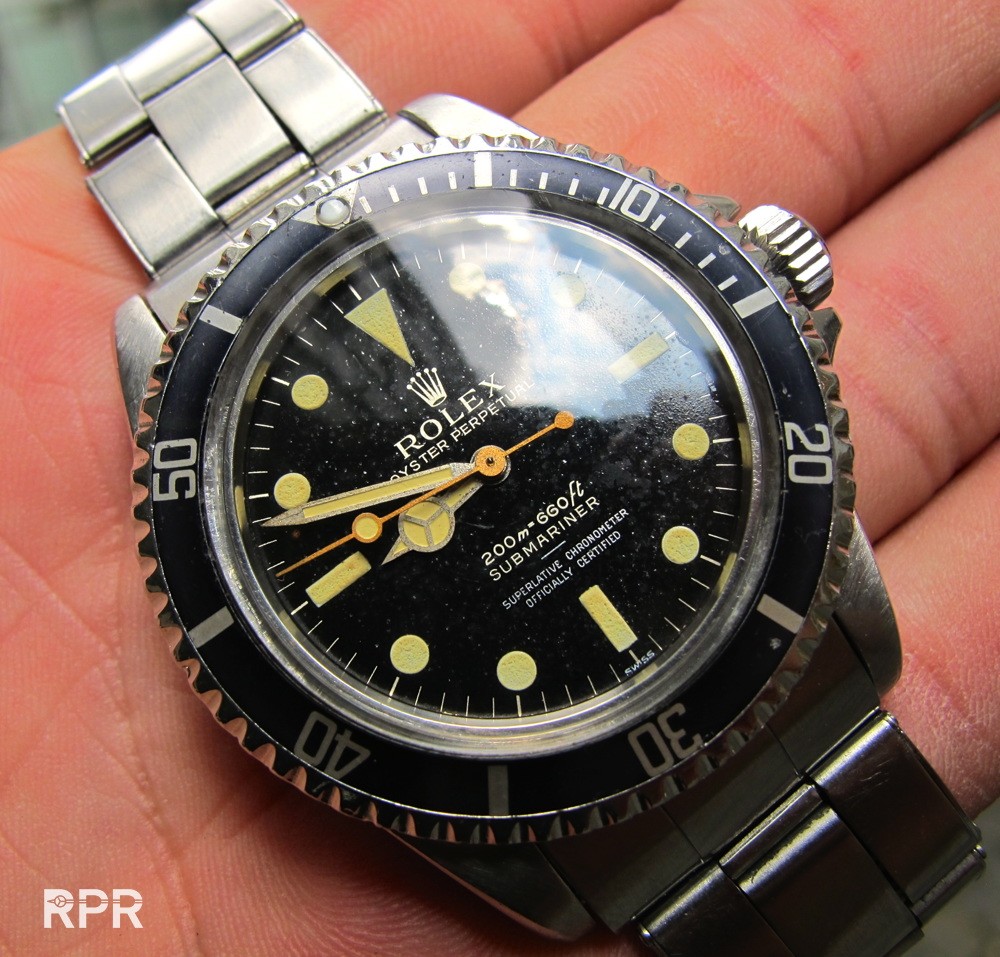 Close up of the “White Swiss” added on top of the track..(follow the link to more vintage Rolex study)
Close up of the “White Swiss” added on top of the track..(follow the link to more vintage Rolex study) 
Fully gloss Ref 6234 chronograph dial where the “Underline” & “Anti-Magnetic” is added later. Obviously a old style dial design that got luminated with tritium. 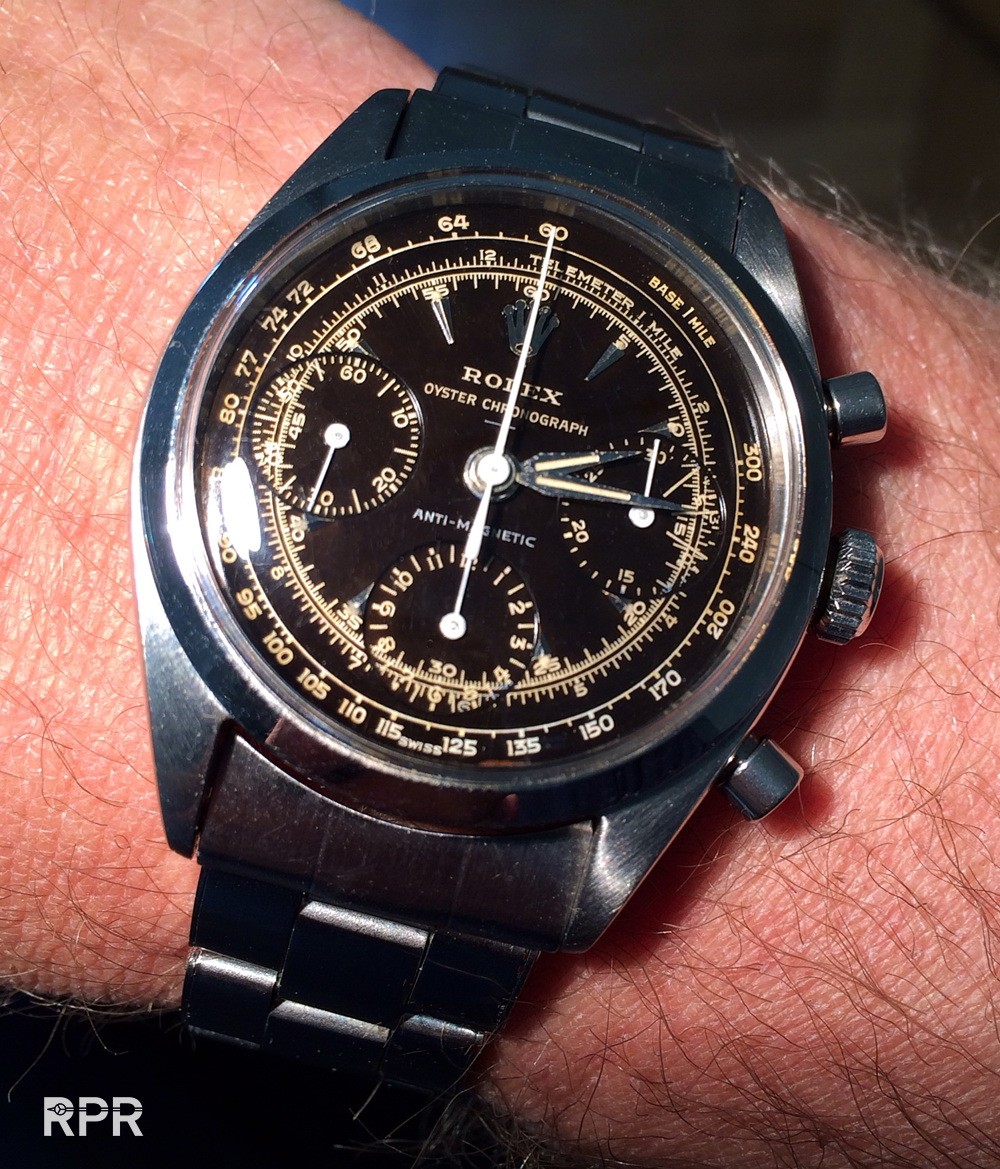
Side view of a 5512 SCOC “Underline dial with a close up of the tritium plots. We see they are puffy and also the white disc underneath are partly visible. The underline and SCOC text is added later on top of the lacquer, the rest of the print is punched into the dial, laying deeper.. 
Yet another stunning transitional Sports Rolex, a 5512 minute track with underline, slightly earlier then the above example due to the close track. 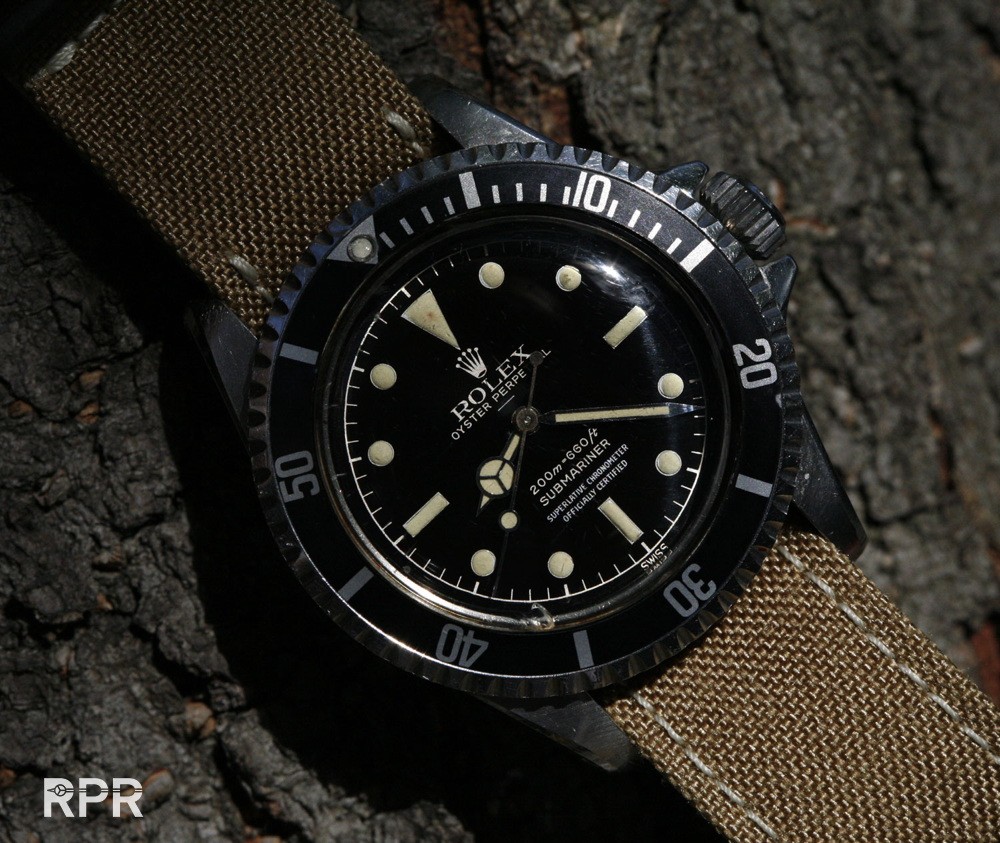
and here another late 4 line Chapter Ring ref 5512 with transitional “Underline”, probably one of the very last minute tracks..
Other watch manufactures used similar signing for the tritium mark, these below Tornek- Rayville US had also a “moisture meter” on the dial, chancing the upper half of the circle into the same color as under half once moisture entered into the watch case. VERY clever and innovative solution to protect your watch.

One of the very first Daytona’s Rolex delivered. A 922.xxx serial “Underline” with “Double Swiss” signing ( one swiss not visible as it’s located under the rehaut) The perfect voluminous tritium dots matches the color of the hands of this hardly worn exceptional rare Cosmograph..(follow the link to more vintage Rolex study)  Explorer 1016 with of which we see the unique cracks in the glossy lacquer perfectly. You know also notice that the luminous on the markers and 3-6-9 are deeper in the dial located…
Explorer 1016 with of which we see the unique cracks in the glossy lacquer perfectly. You know also notice that the luminous on the markers and 3-6-9 are deeper in the dial located… 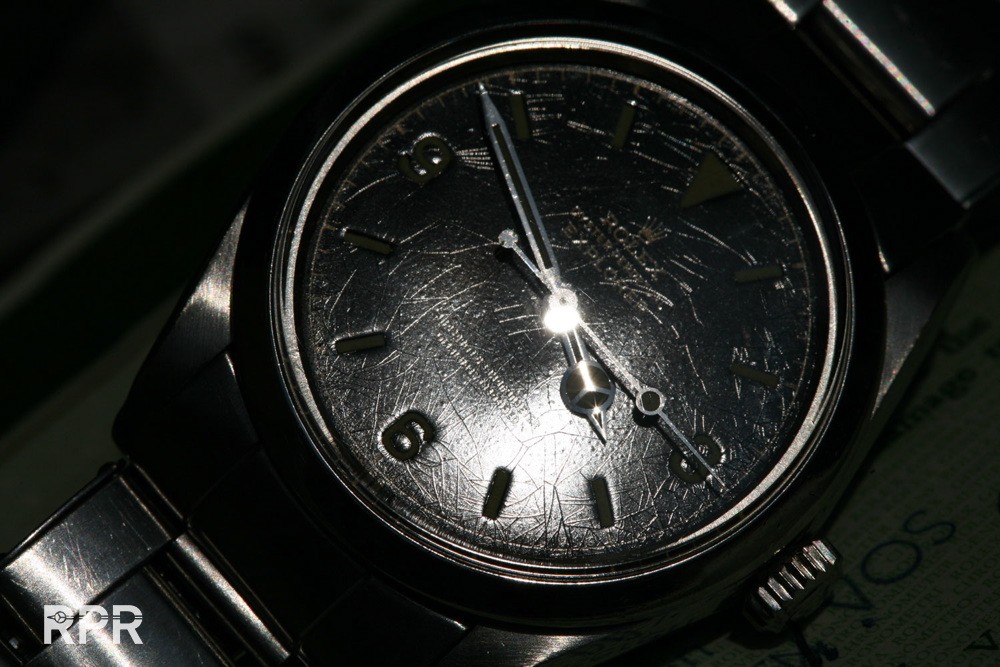
This “Underline Explorer 1016 has a tritium radiation, less the 0.25 Msv.
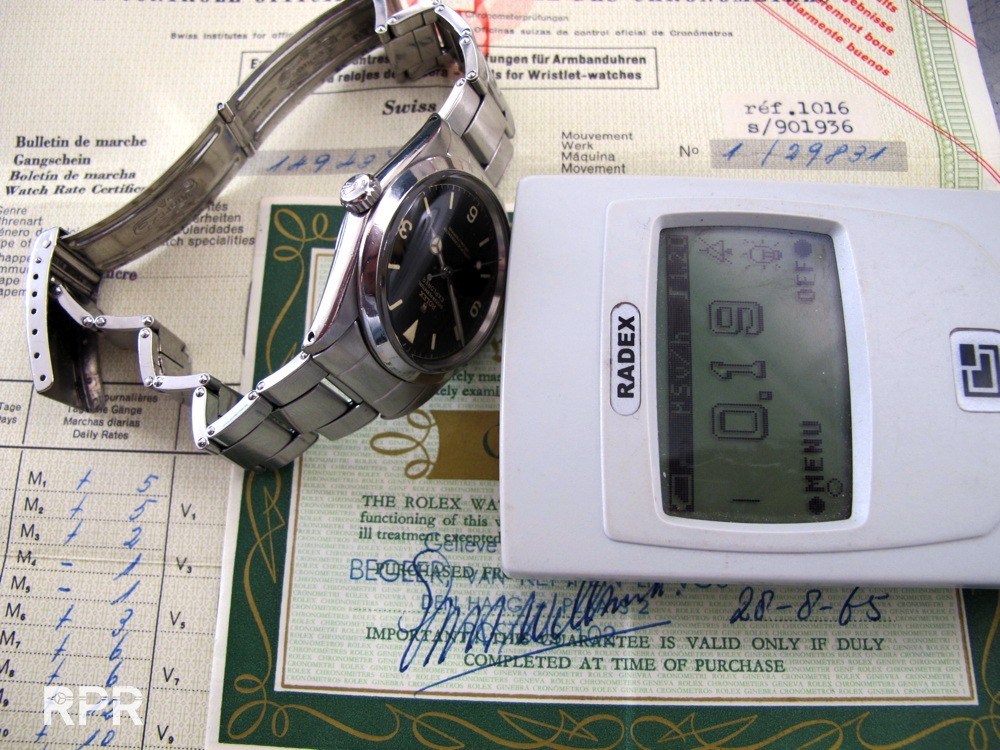
Close up of a rare service dial, one that only has a added “T” behind the radium SWISS, clearly added later and maybe a finished swiss dial that never got laminated and was used as service dial by adding the T and tritium. A Rolex service done after 1964 when international regulations forbid the use of radium…
The “Swiss T<25” glossy tritium dial from 1964-1967…. showing some light “spiders” around the luminous plots…
Next is a original owner Submariner sold by Bonhams in all the condition how the owner brought it in, untouched and some moisture stains on the glossy lacquer, something that can be cleaned of with ionized water…
A overnieuw from one of the most successful references Rolex ever made, the Submariner ref 5512/3 from 1959 till mid 80-ies.. 
Below some NOS (New Old Stock) Rolex and Tudor dials that have a rich patina due to the fact they where stored in the dark and haven’t seen the light for many years…
The coming of the seventies chanced the dial surface from glossy to a modern matte surface, here a Ref 1016 Explorer with nicely aged tritium luminous. The with the previous glossy dials so matching gold print chanced with the matte dials to a modern white print… 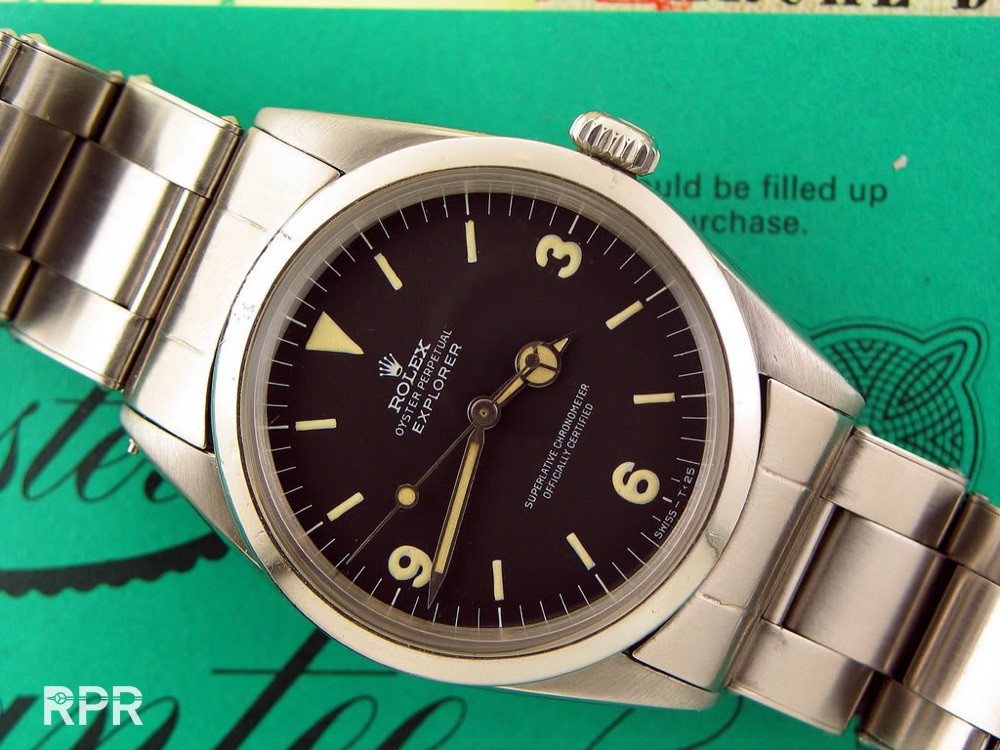
The more yellowish color of the tritium is cleverly visible in next experimental Rolex SeaDweller. The iconic “Single Red ref 1665”. Matt dial, white print, note also that the printed DATE behind oyster perpetual is much bigger in text. The red Sea Dweller text perfectly covers the white text underneath, first examples of this legendary reference had a 500m = 1650 Ft depth rate..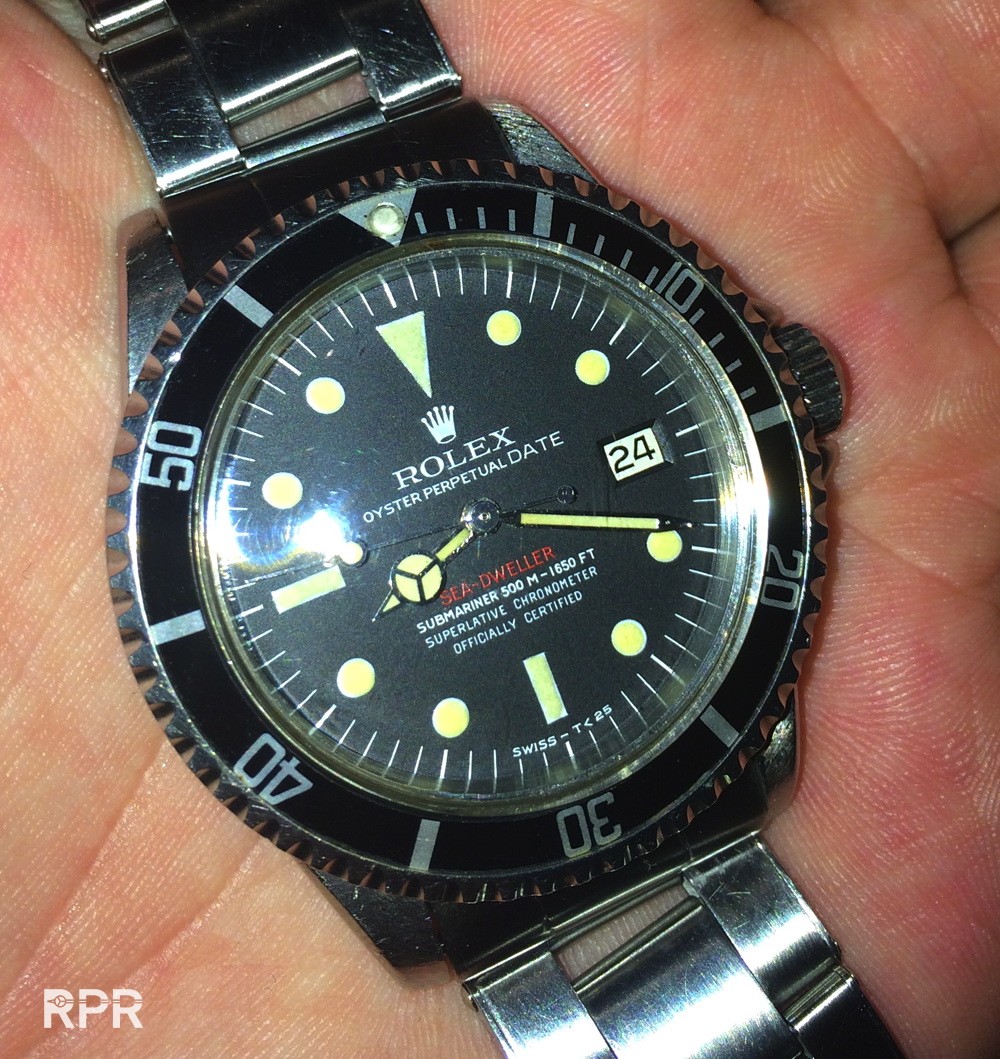 Shortly later, end 60ies, came the Red Submariner Ref 1680, of which many different version have been made.. (follow the link to more vintage Rolex study)
Shortly later, end 60ies, came the Red Submariner Ref 1680, of which many different version have been made.. (follow the link to more vintage Rolex study) 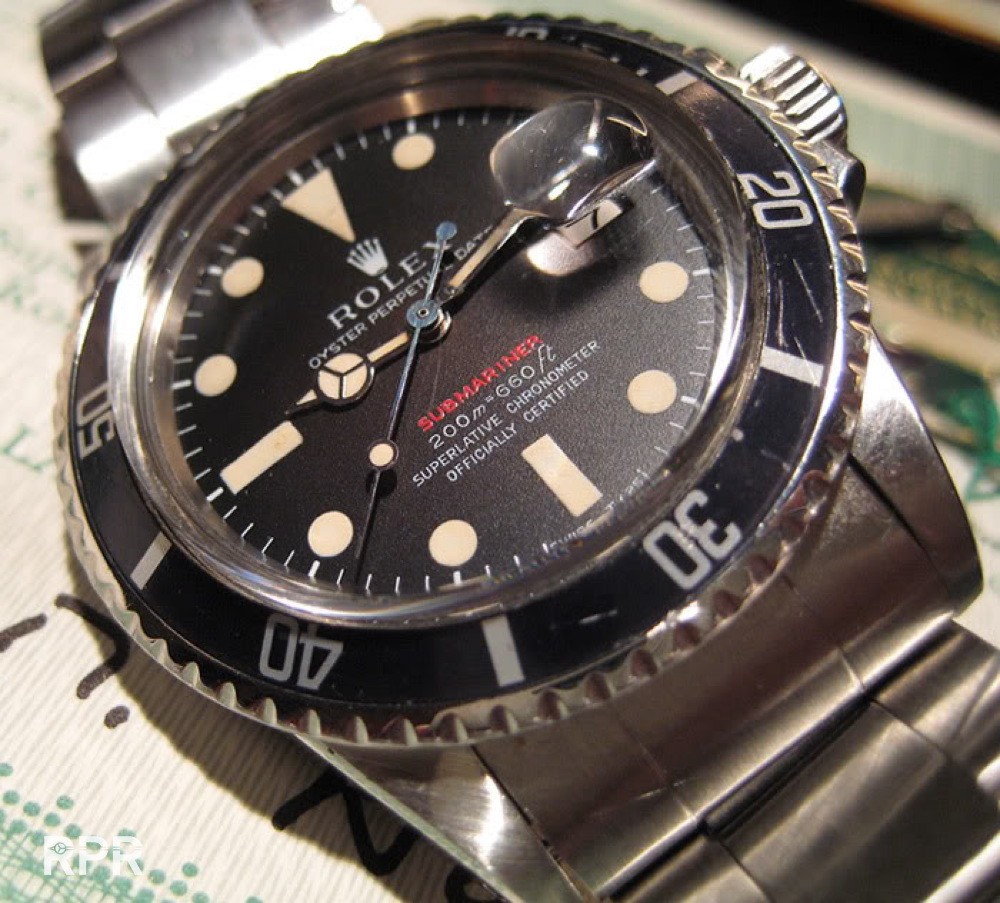
Heavy patinated Ref 1665 for Qaboos in like NOS condition…
A “T Swiss T” Daytona ( having 1/3 of the tritium as a more luminated Submariner or GMT ) Nicely aged dots are matching the color of the hands.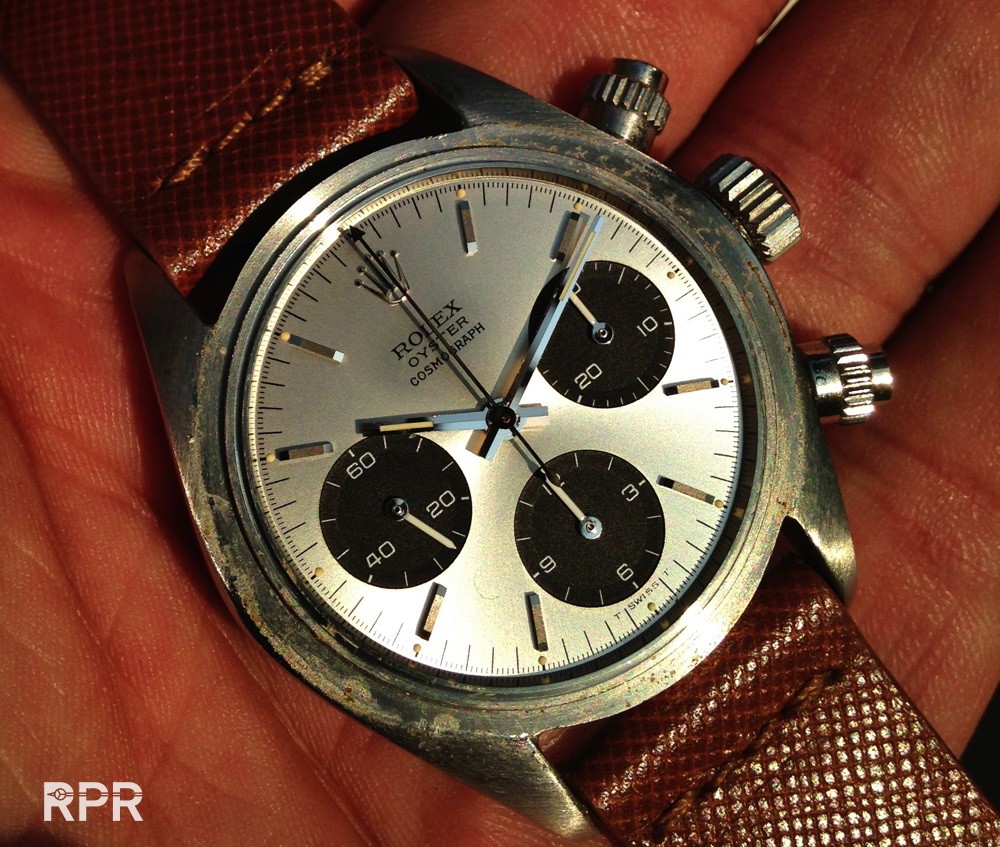
You see below the lume dots of the Newman dial are bit bigger due to the fact the where placed against the typical square newman index…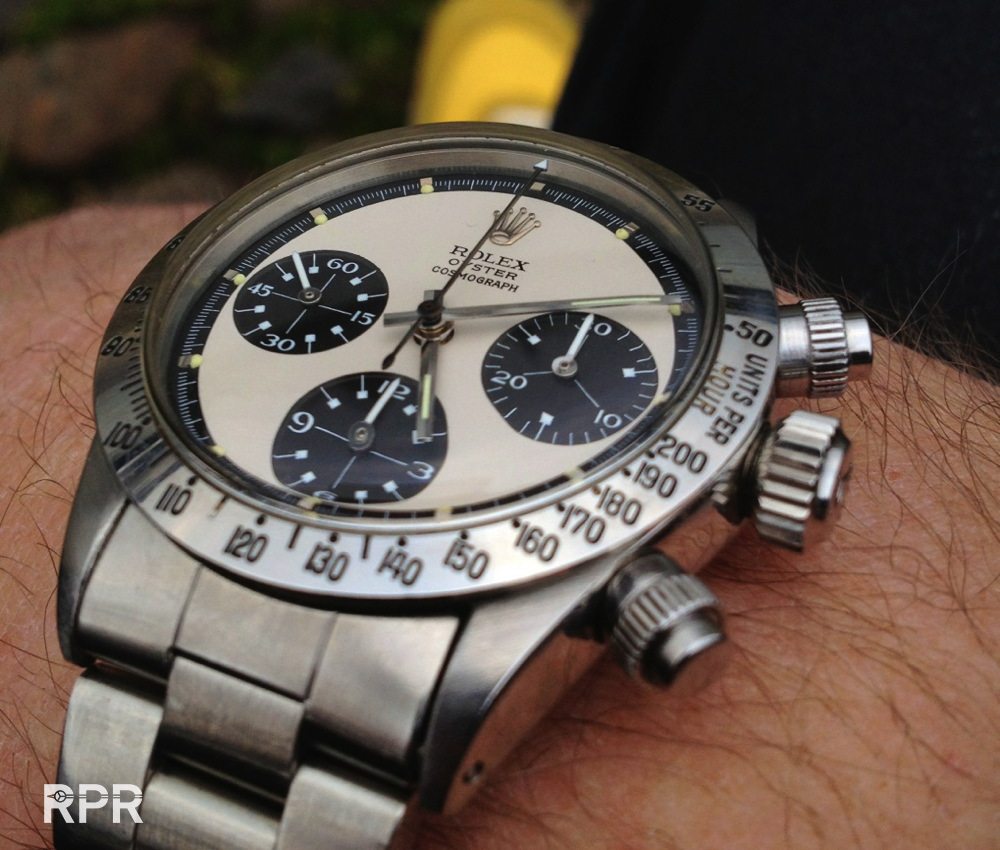
Here we see the tritium light up under ultra violet light, shortly after you did this, the bright color will fade away and stay visible in the dark for another minute or 2. 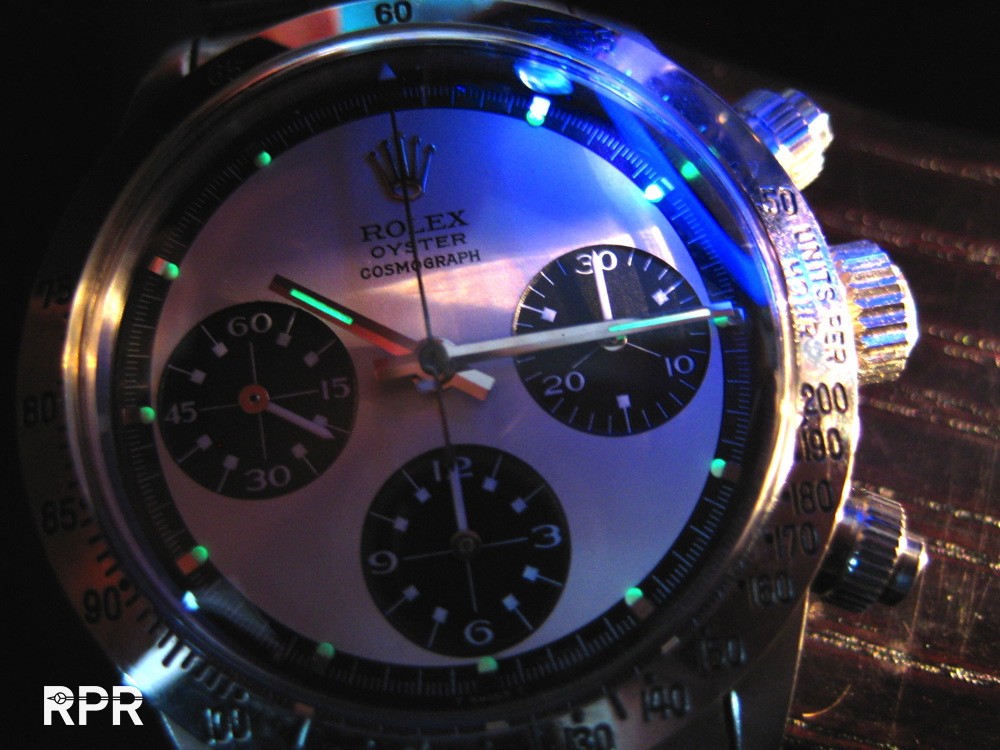
In daylight we see the luminous is creamy colored, once activated with UV light it become bright green. 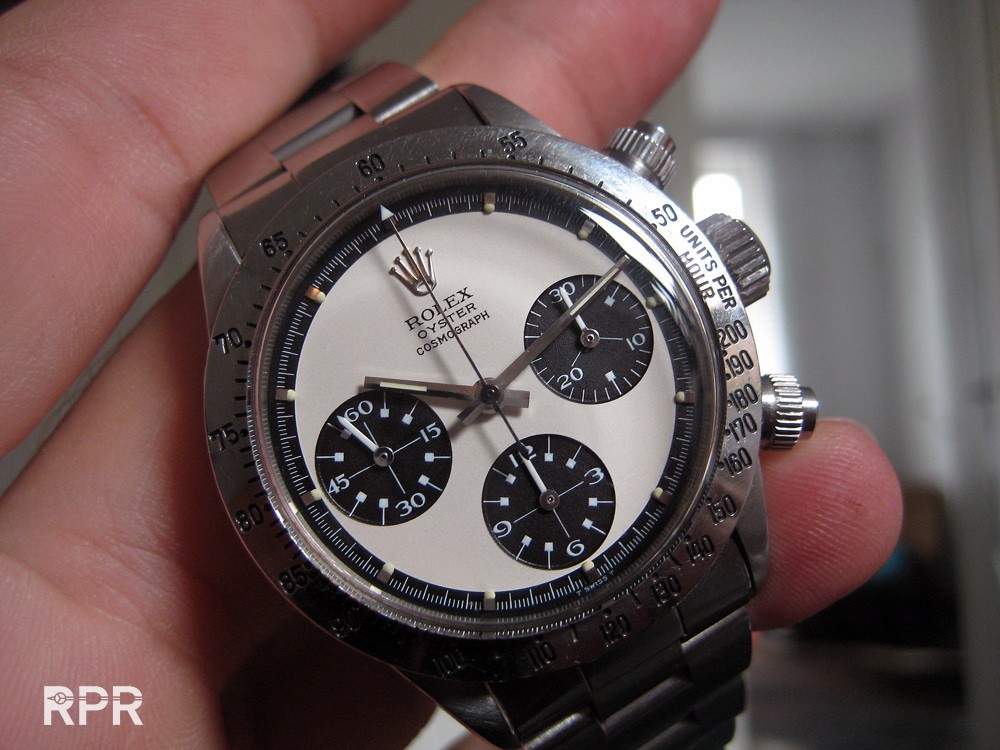
3 x perfectly aged and all intact Oyster Paul Newmans…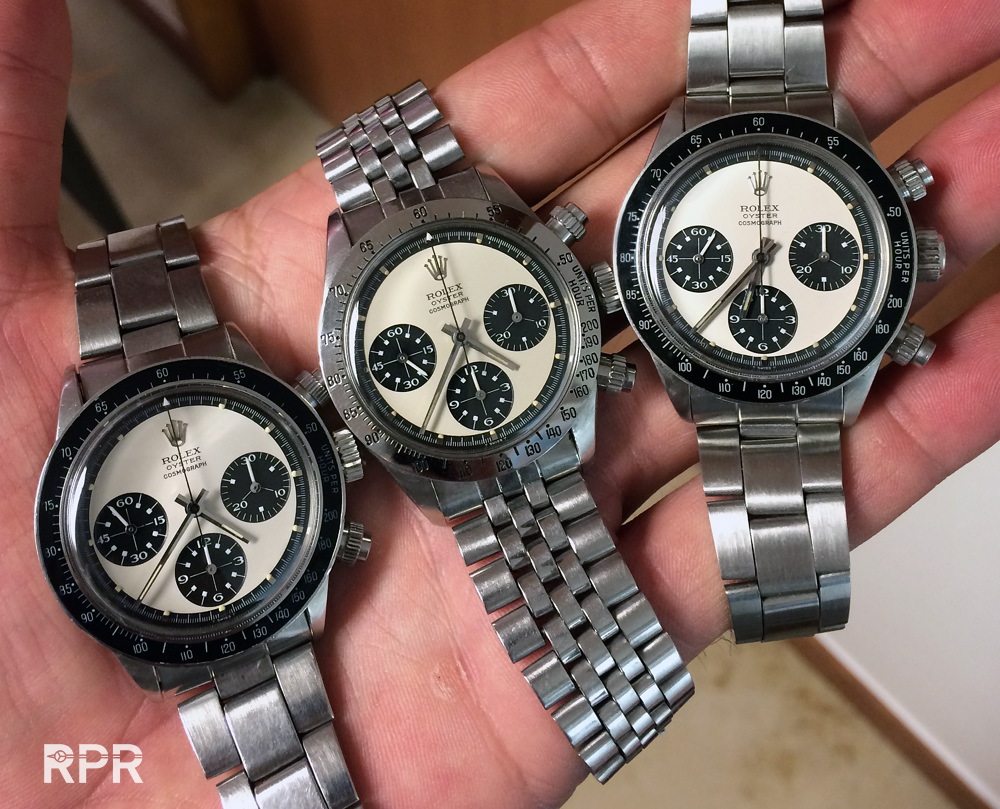
Up close a detail of the structure of how a original aged tritium dots looks like, spongy. 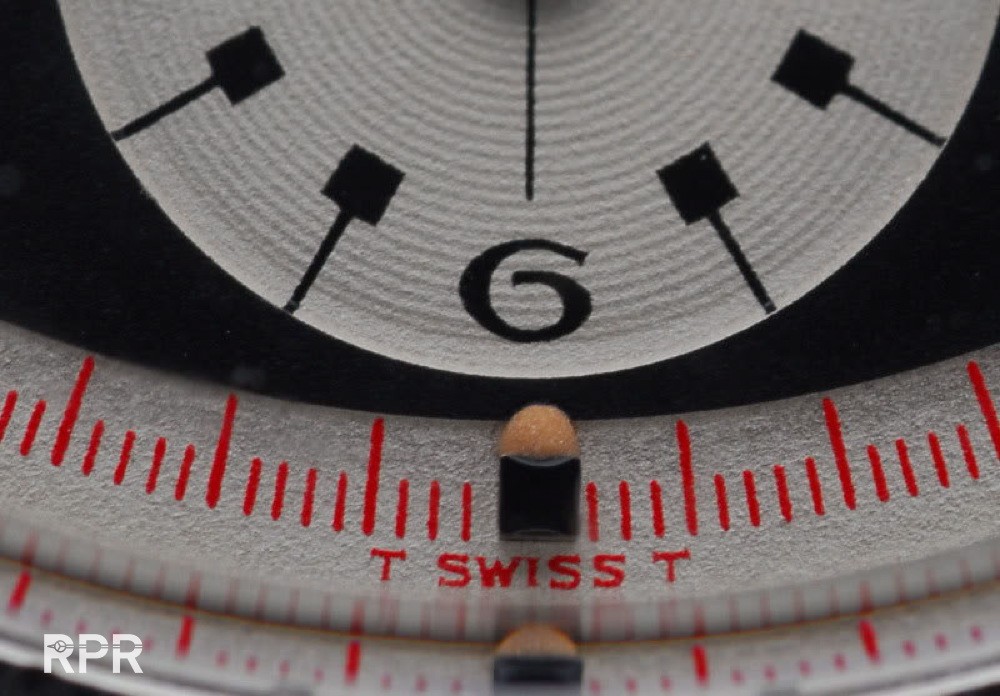
2 nicely aged unrestored Cosmograph’s with perfect matching tritium luminous.. 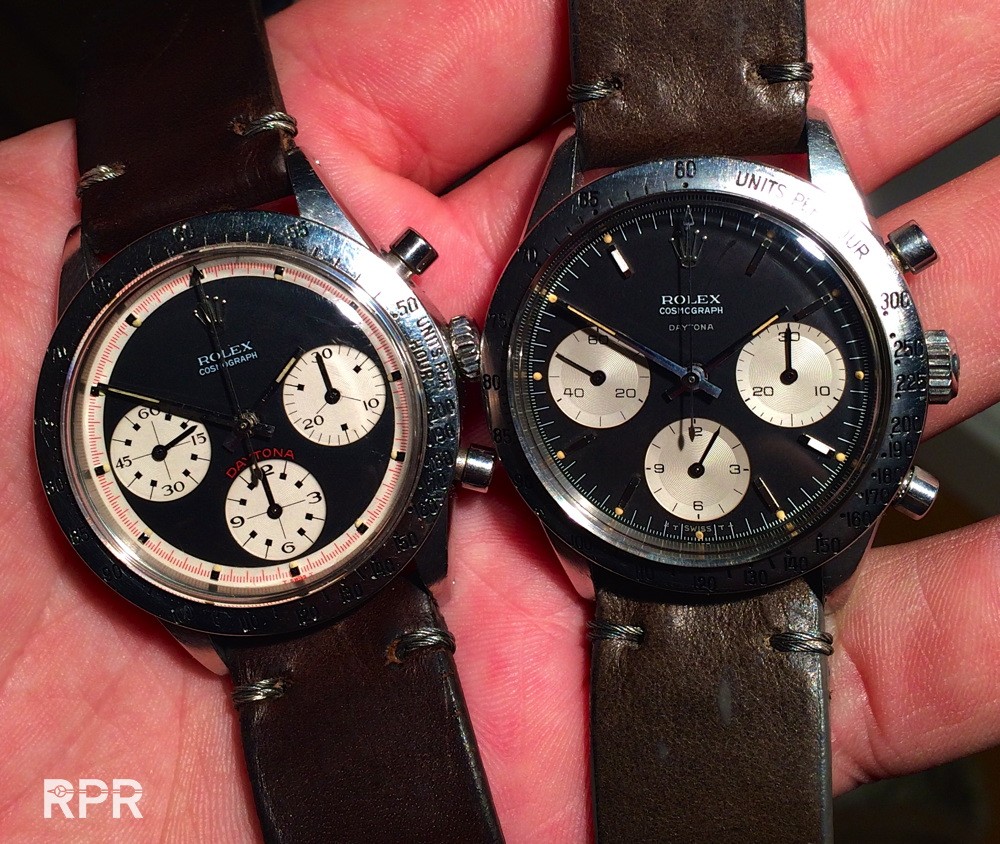
We see that sometimes the lume dot has been moved, most probably due to a hard hit like falling on the ground or so..
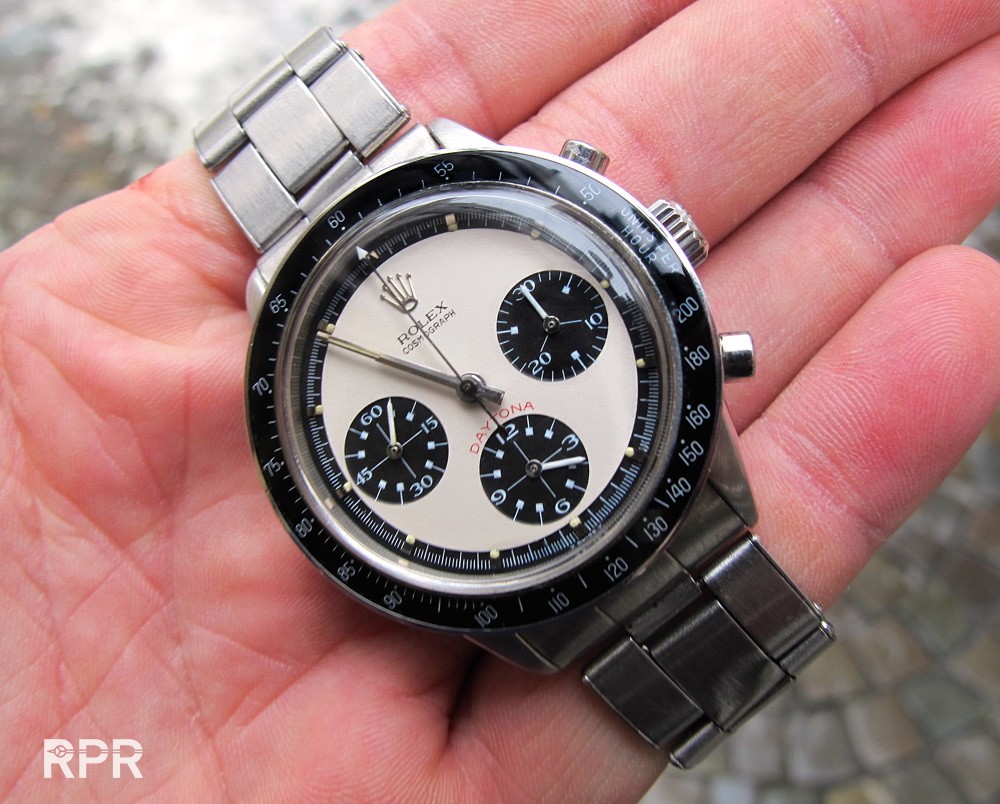 Around the beginning of the 70-ies we see on several Sports Rolex that the black paint of the dial changed during the years to a tropical brown tone. This was most probably due to the fact that the dial maker mixed his black color with plenty of red pigment and due to the exposure to the UV light, the black faded to brown. Something we particularly see on Meter first Red Sub’s, MK2 Seadweller’s and GMT Masters but also on regular 5513 Subs or Daytona’s from around 1968-1972.
Around the beginning of the 70-ies we see on several Sports Rolex that the black paint of the dial changed during the years to a tropical brown tone. This was most probably due to the fact that the dial maker mixed his black color with plenty of red pigment and due to the exposure to the UV light, the black faded to brown. Something we particularly see on Meter first Red Sub’s, MK2 Seadweller’s and GMT Masters but also on regular 5513 Subs or Daytona’s from around 1968-1972. 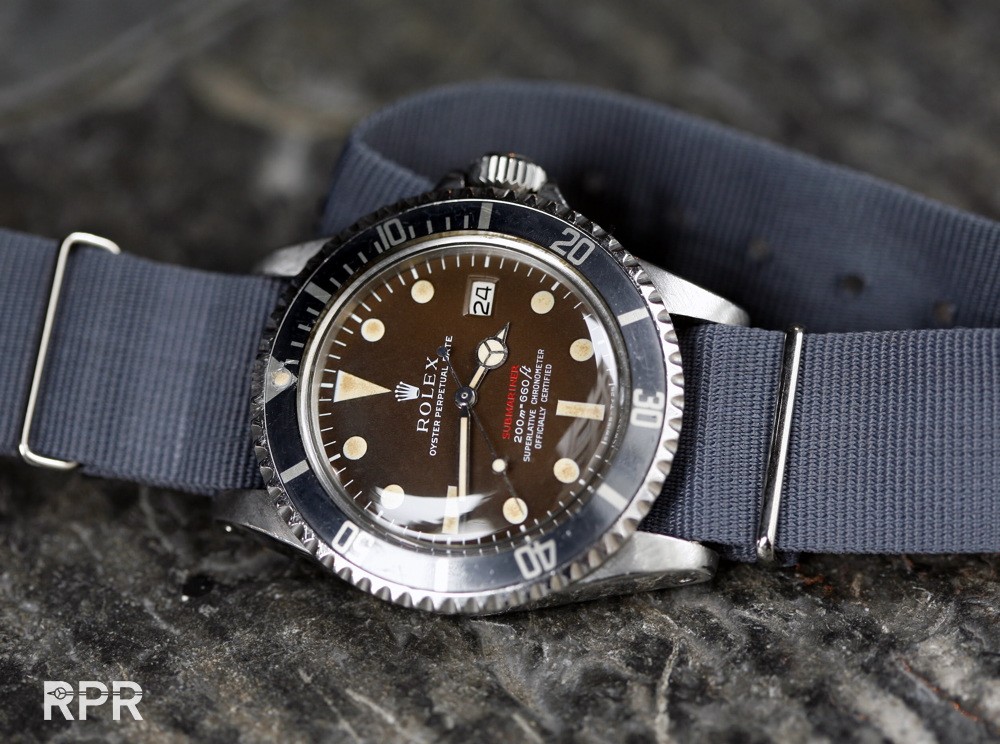
A MK2 thin case Double Red Seadweller with tropical dial. The red and white paint is as usual with matte dials added on top of the dial, without any lacquer over it. On single and double Red Rolex dials we often see that the tritium luminous is very thin, sometimes even more white then creamy colored. 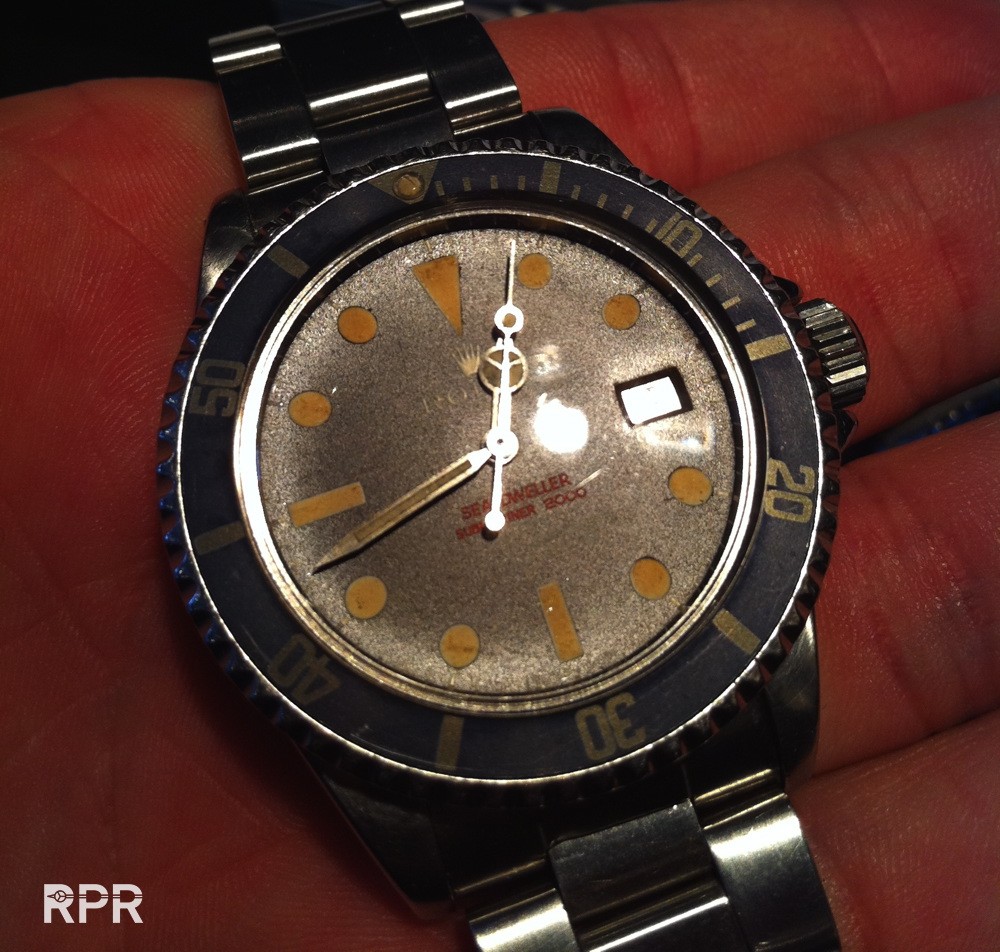
Dark chocolate ref 1680 from the first serie, with meter first…

A Sigma ( white gold markers around 1970) T swiss T Daytona with faded tritium dots and tropical brown sub dials 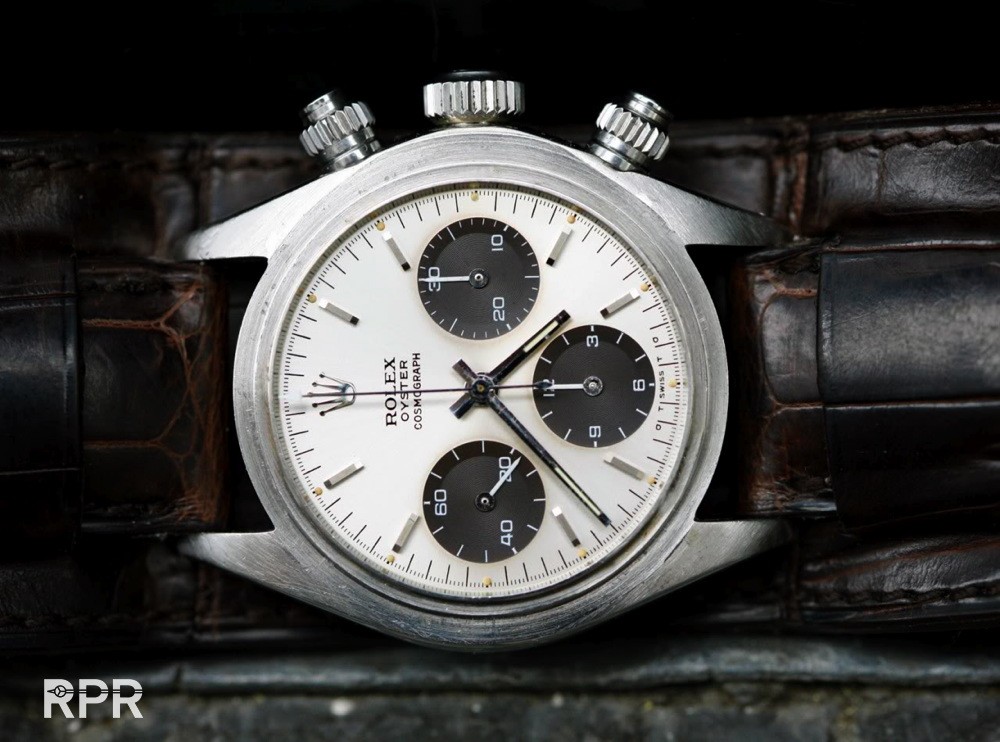
All black sigma Daytona from first owner in untouched original condition. Perfect matching luminous shows a perfect condition of the dial.. 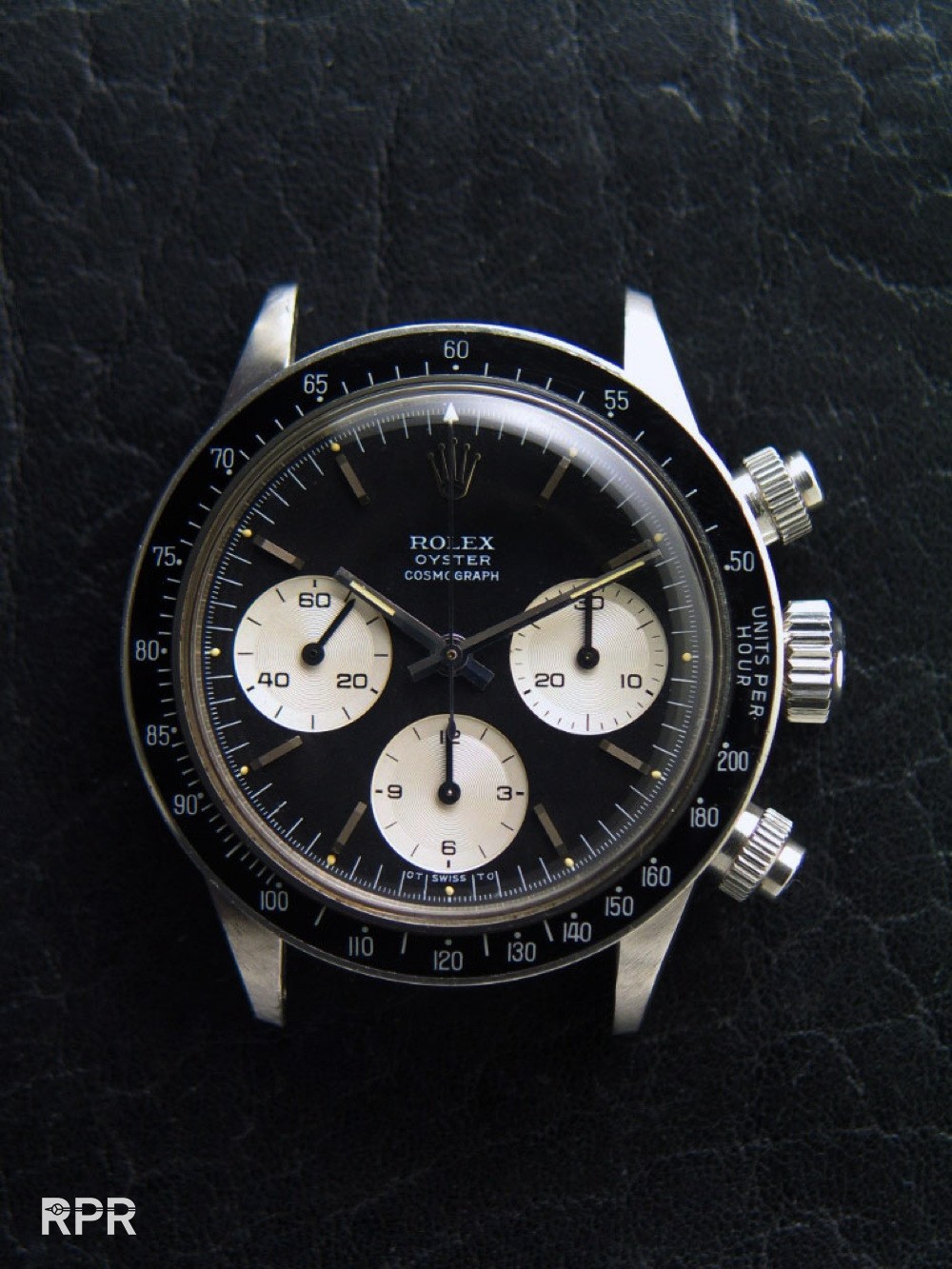
Here below we see a modern interpretation Rolex Geneva made for a client, gold print of a modern design, toned luminous…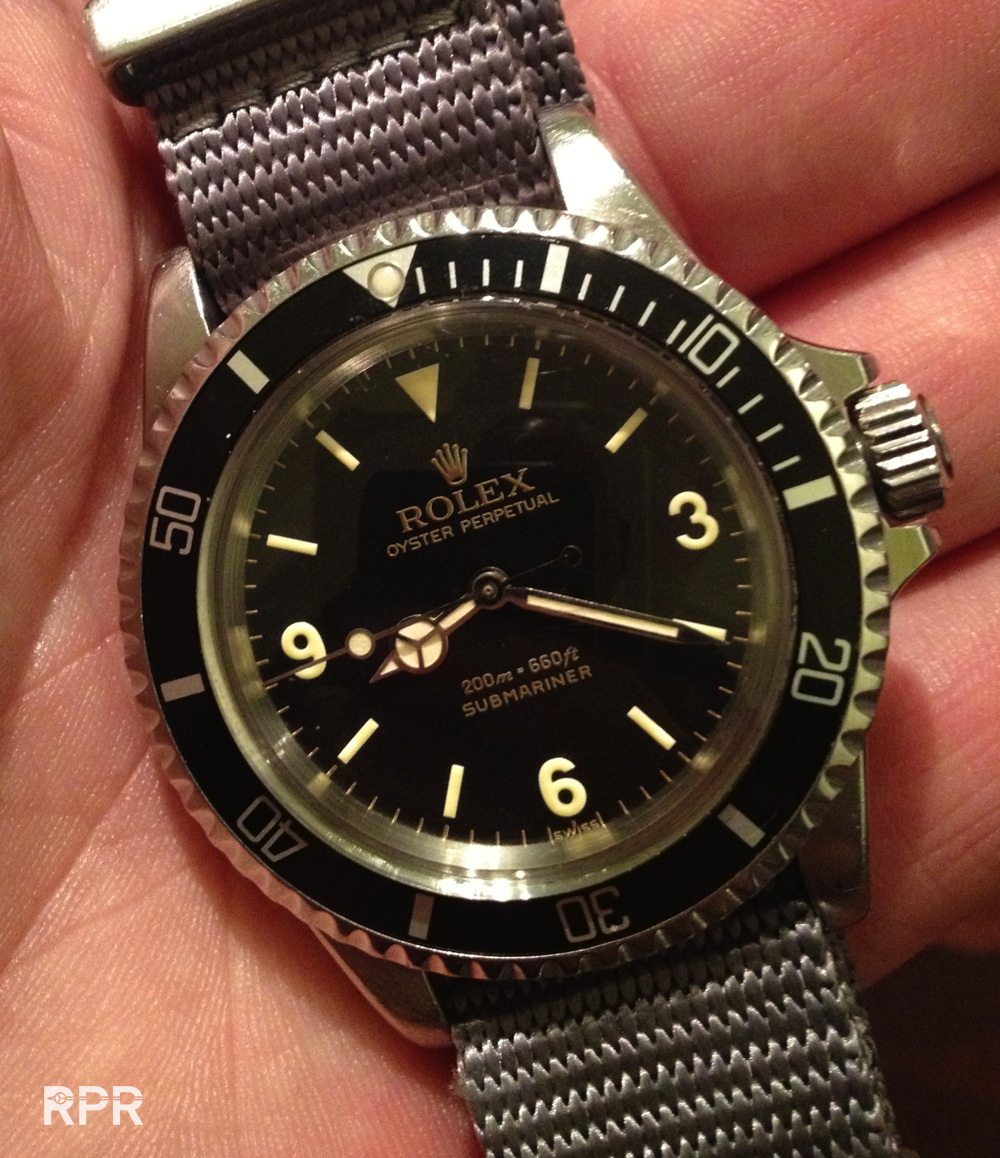
This has been offered for auction by the previous owner, clearly we see the matt dial making it a mixture of wrong decisions. Original 369 Explorer dials where printed in galvanic technique, making the text lay dieper, the surface was glossy, the typo was matching the date of 1962-1965 when these iconic beauties. I personally think it’s not ok and I heard they stopped doing this.
But then it looks like Rolex is using their heritage look at Tudor for a one-off modern interpretation of their ref 7923…
Yet another special Rolex lume we see with the Milgauss ref 1019, there where the dots are normally round, they are square now..
2 x creamy colored tritium Explorer’s, both untouched and still in their original condition. All 3 belonged to Sir Edmund Hillary… 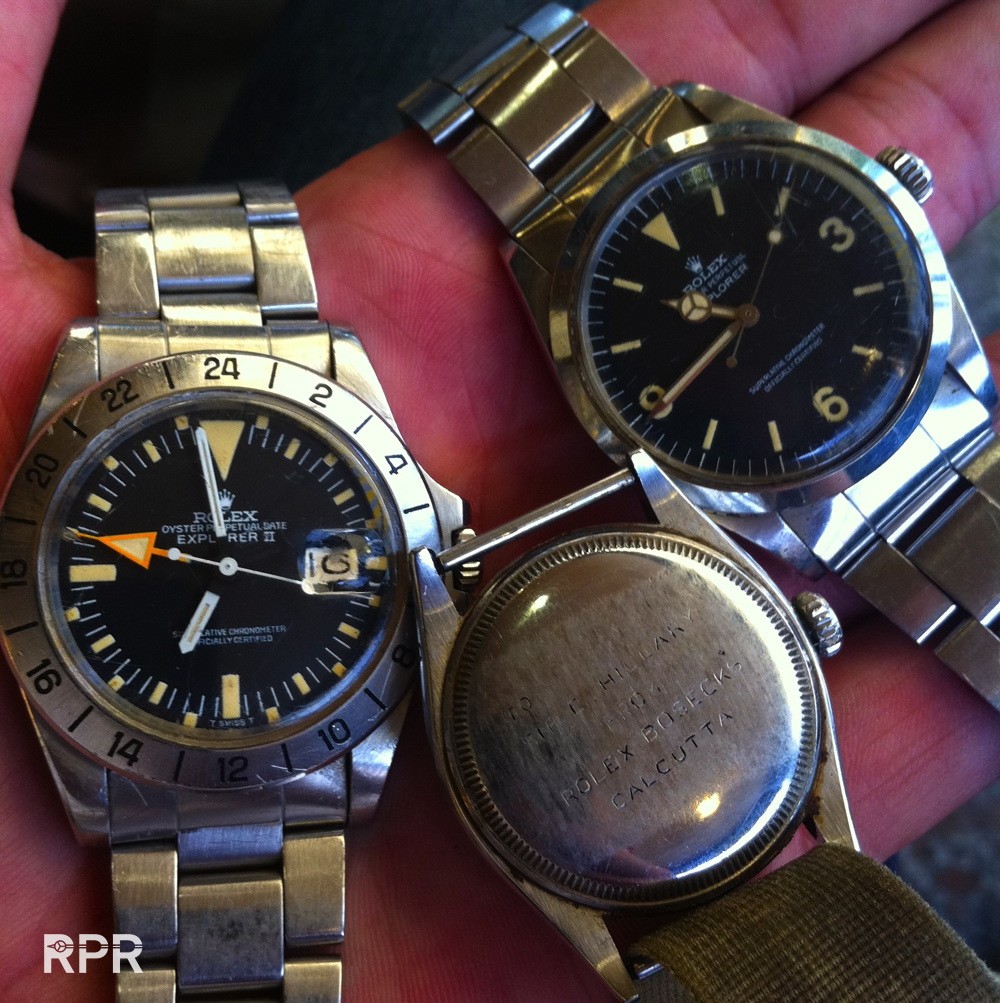
Fat Ref 5513 matte Submariner tritium plots that are so big they touch the track on the outside… 
Or no luminous at all on this blue Submariner prototype ref 5513 made by “Singer” for Rolex in 1967…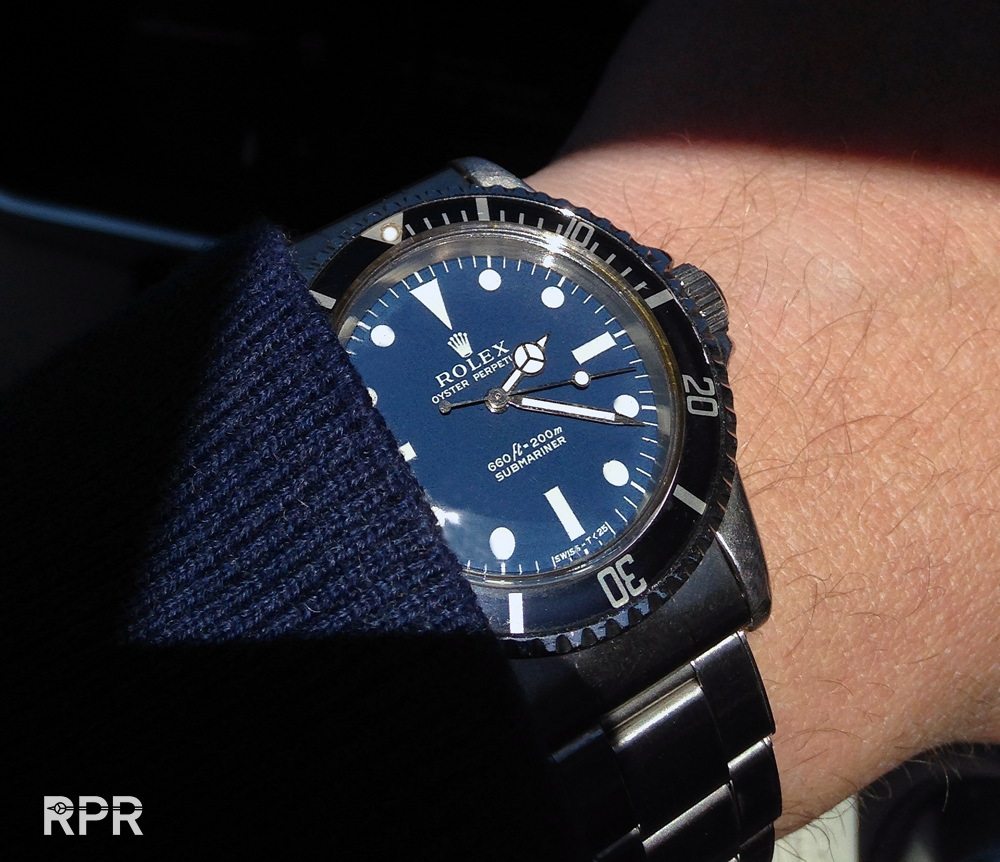
Ref 1665 as MK 3 DRSD on the left next to a little later by “Stern” manufactured “Rail Dial”…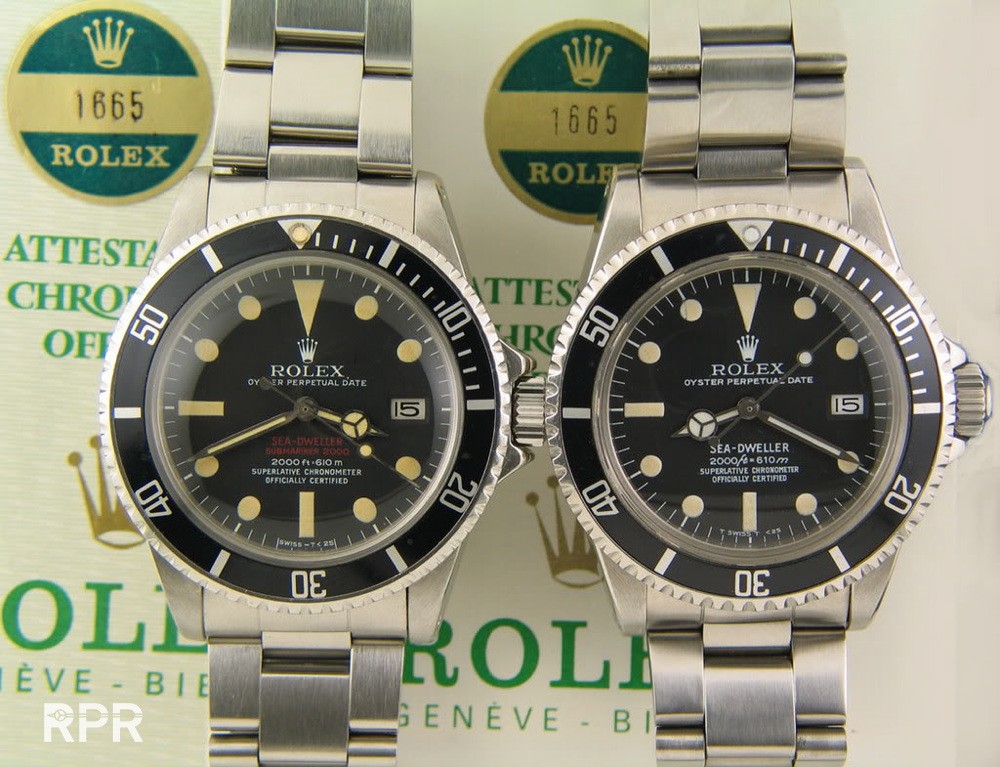
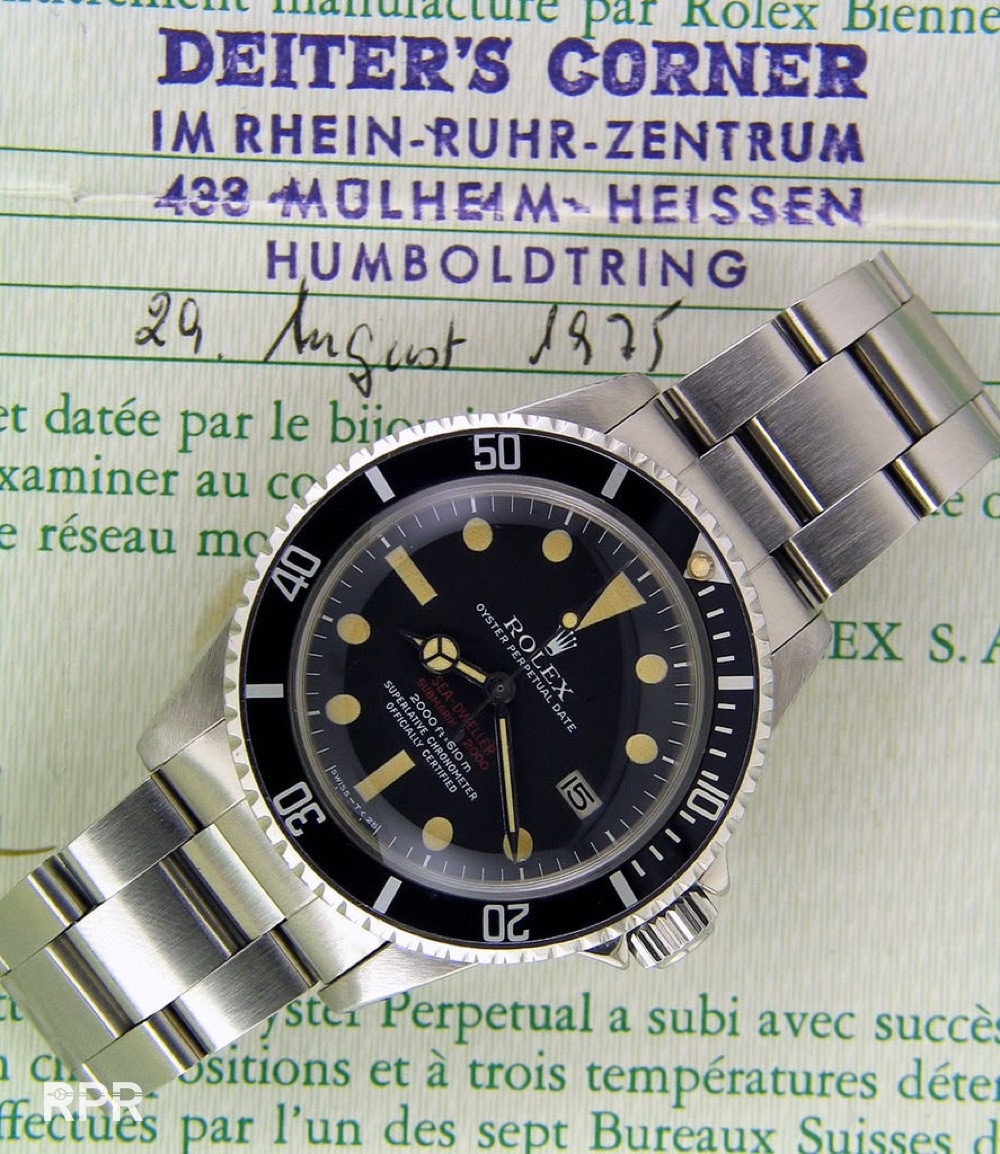 Deep Orange colored NOS dial and hands that chanced to this brilliant tone after being stored for a long time in the dark.
Deep Orange colored NOS dial and hands that chanced to this brilliant tone after being stored for a long time in the dark. 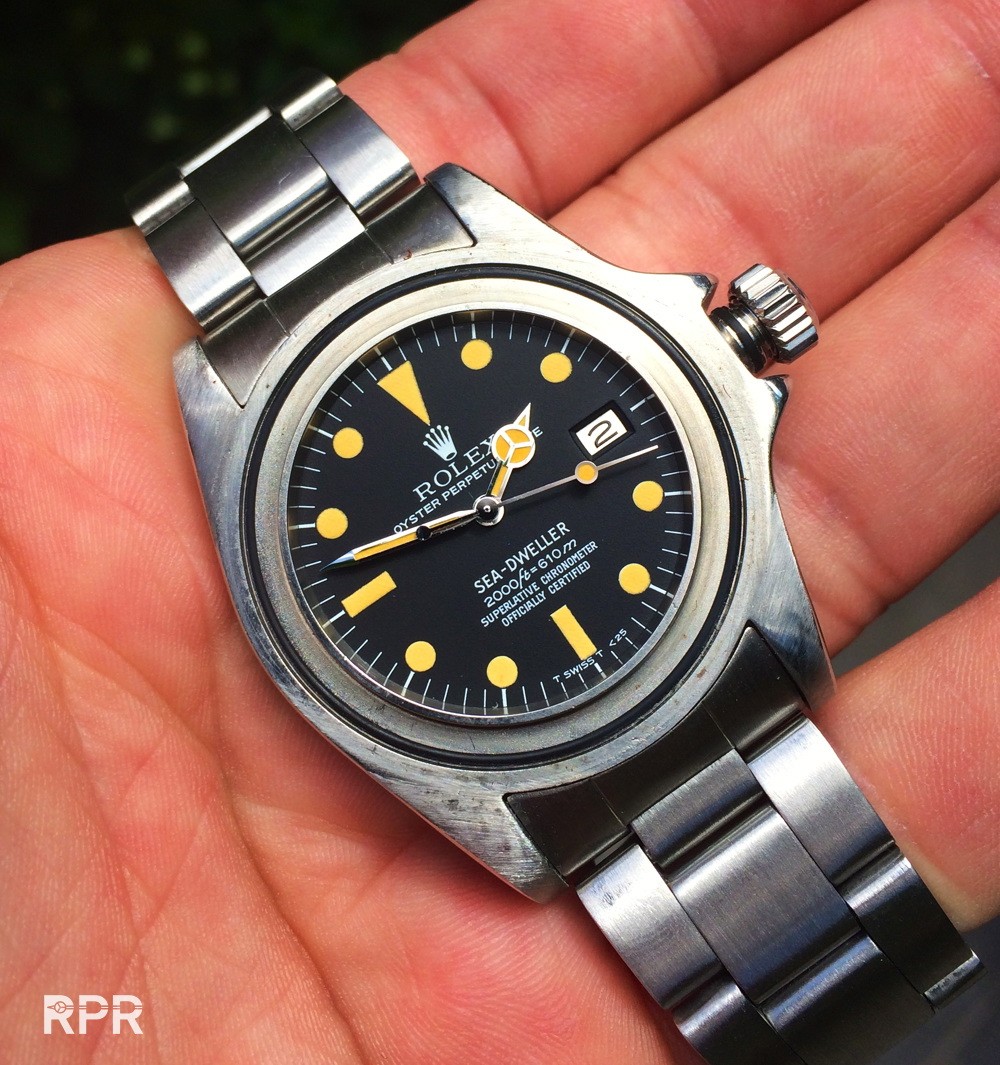
2 x Rail Dial on the top, followed by a Mk2 with tropical brown dial and a Mk 4 with matt black dial… 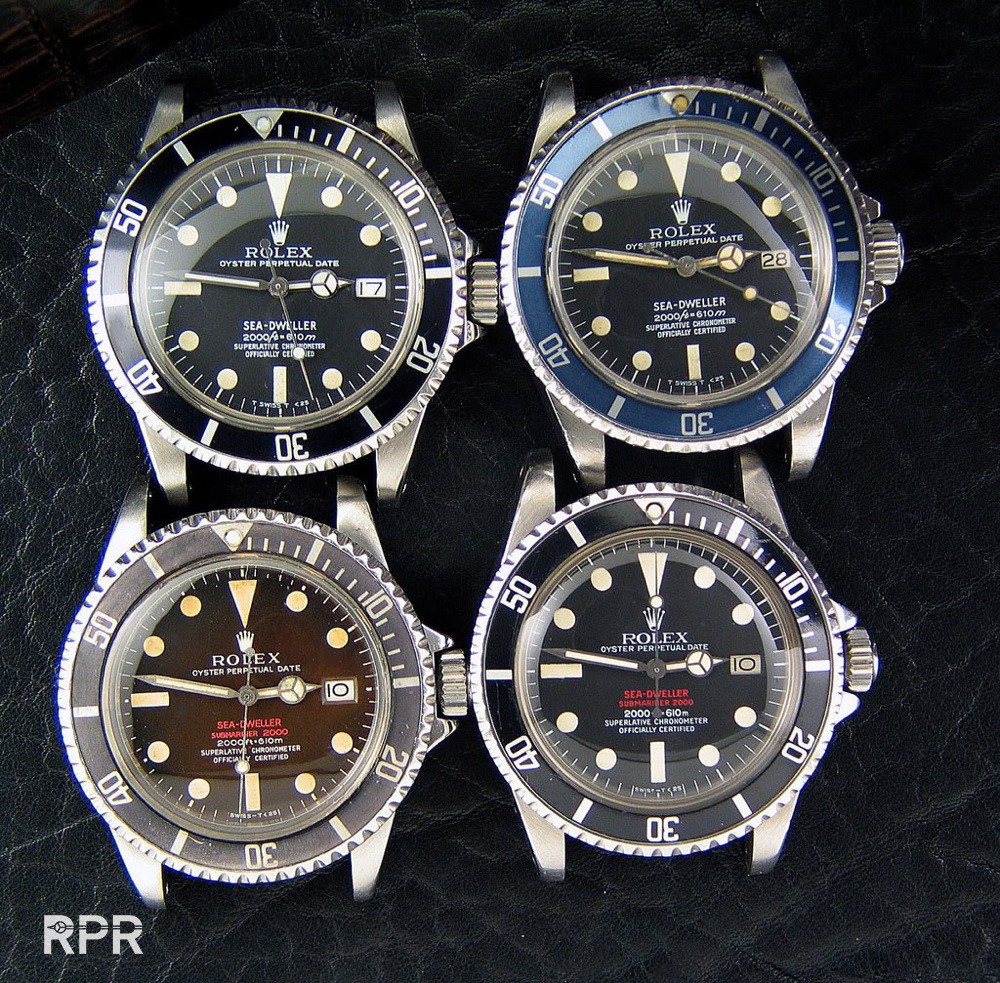 Close up of a naked Comex Seadweller ref 1665…
Close up of a naked Comex Seadweller ref 1665… 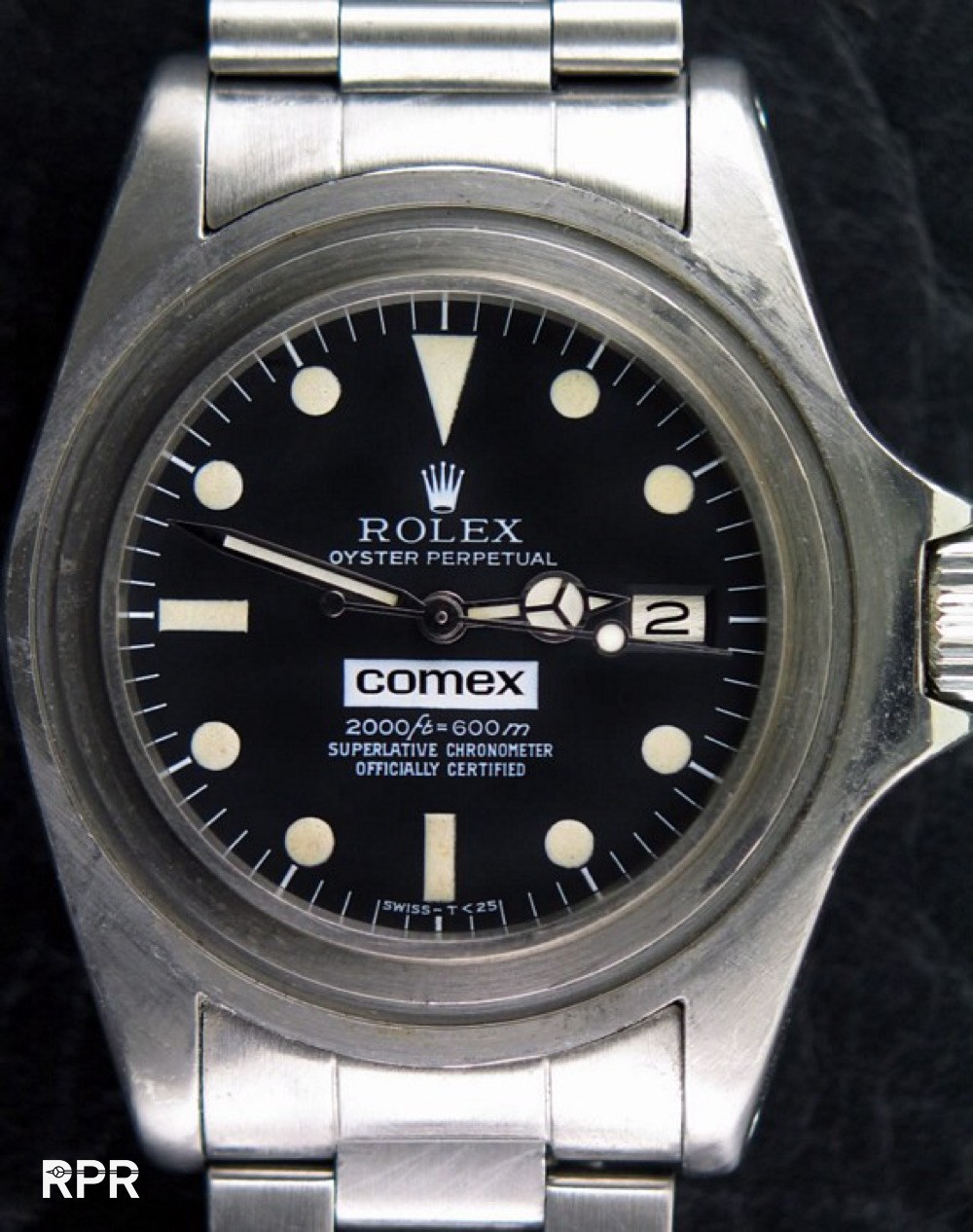
A later ref 1680 with feet first Red Submariner with very light colored tritium… 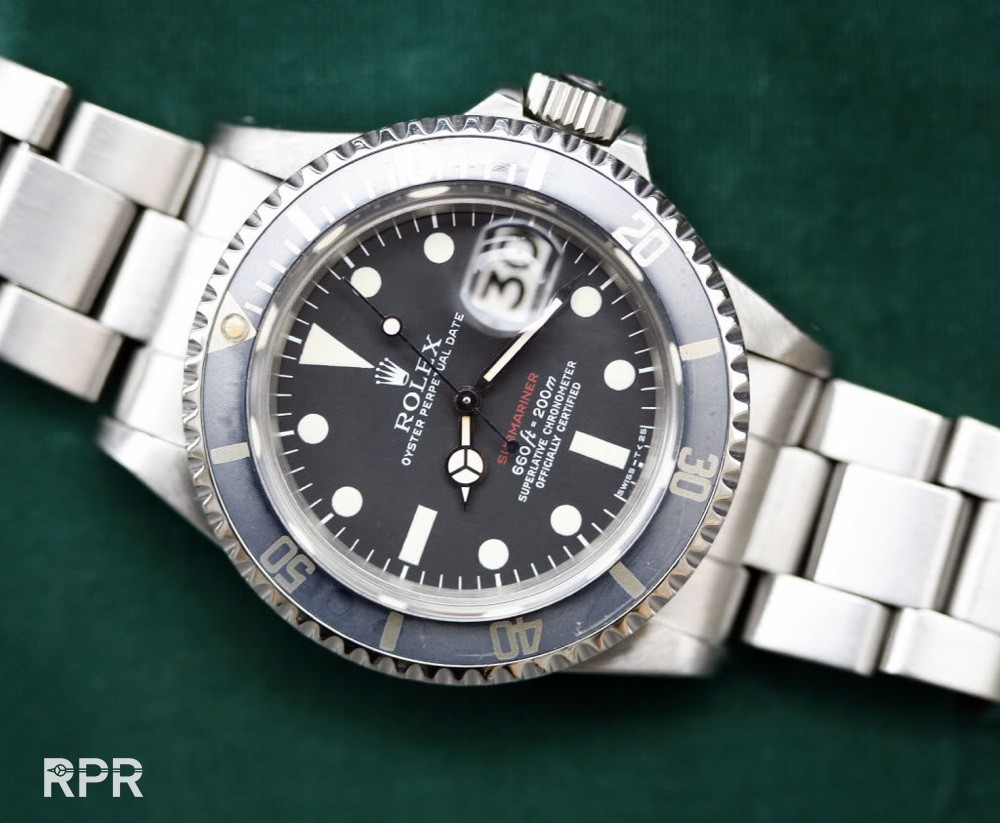
A Big Red Daytona Cosmograph with nicely voluminous tritium dots.. 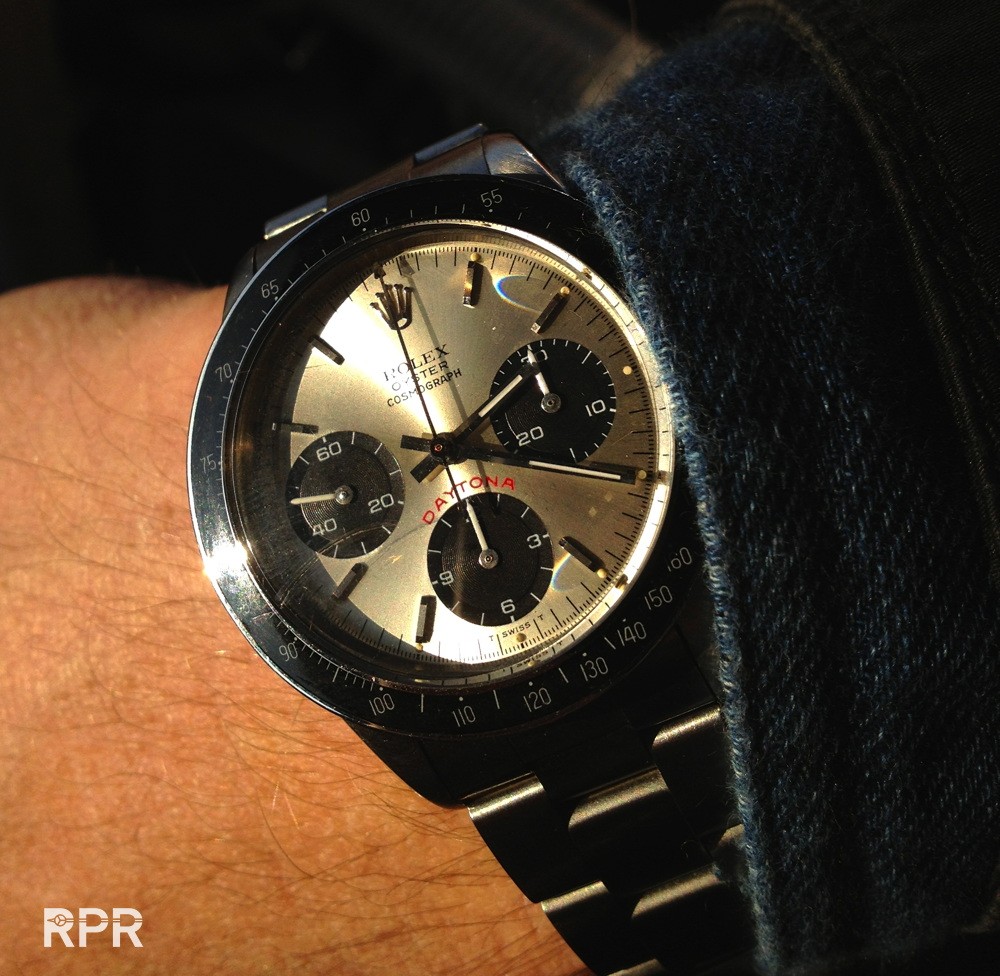
The transitional Submariner from plexi to sapphire crystal, ref 16800 & 168000. Matt dials in modern case, with anti scratch crystal was the way forward.. 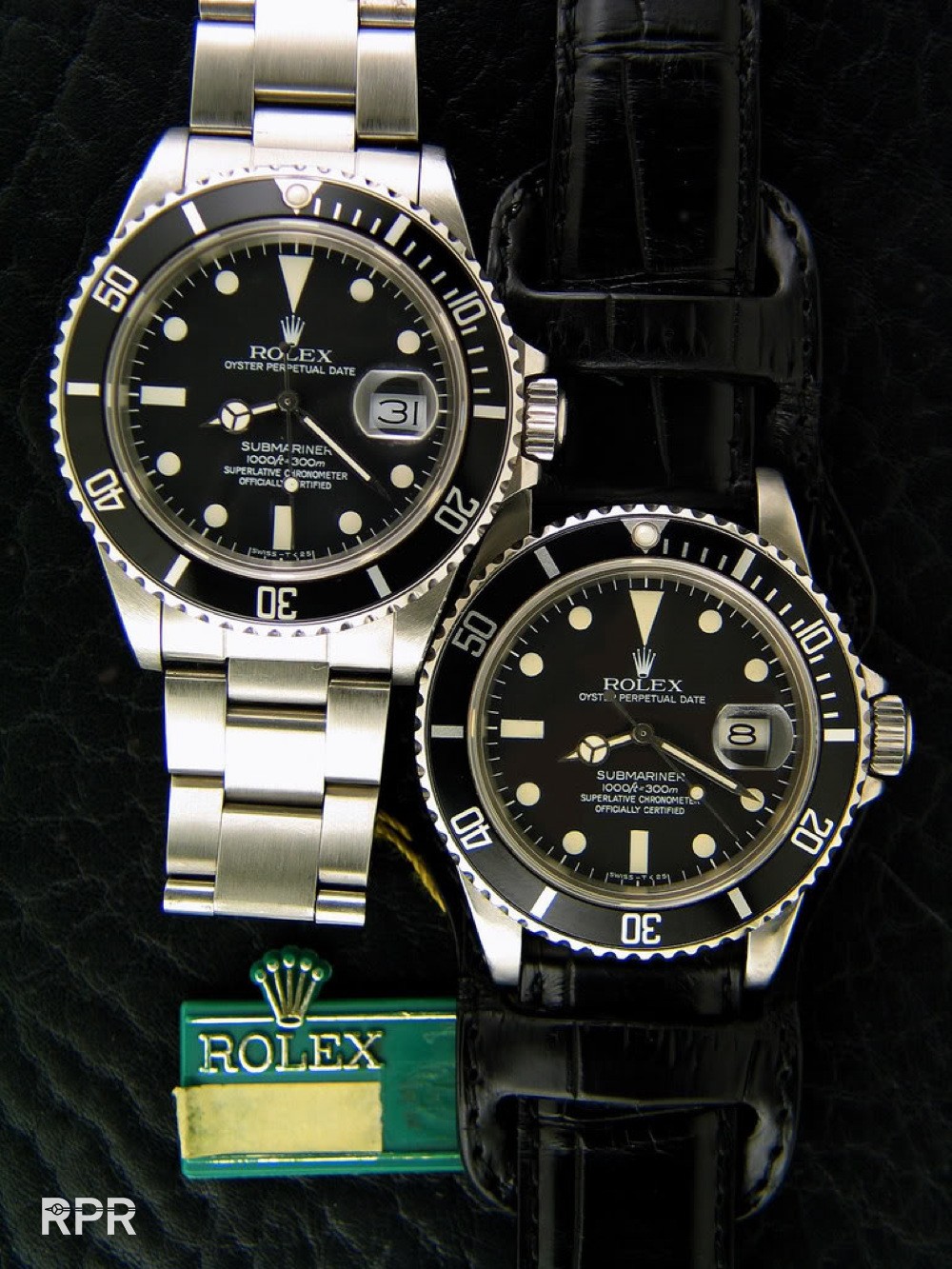
A safe queen ref 16800 that spend it’s life in the dark. Note the heavy patina on the dial and tritium dot of the bezel, there where the hands typically for this reference, chanced muchness in color tone..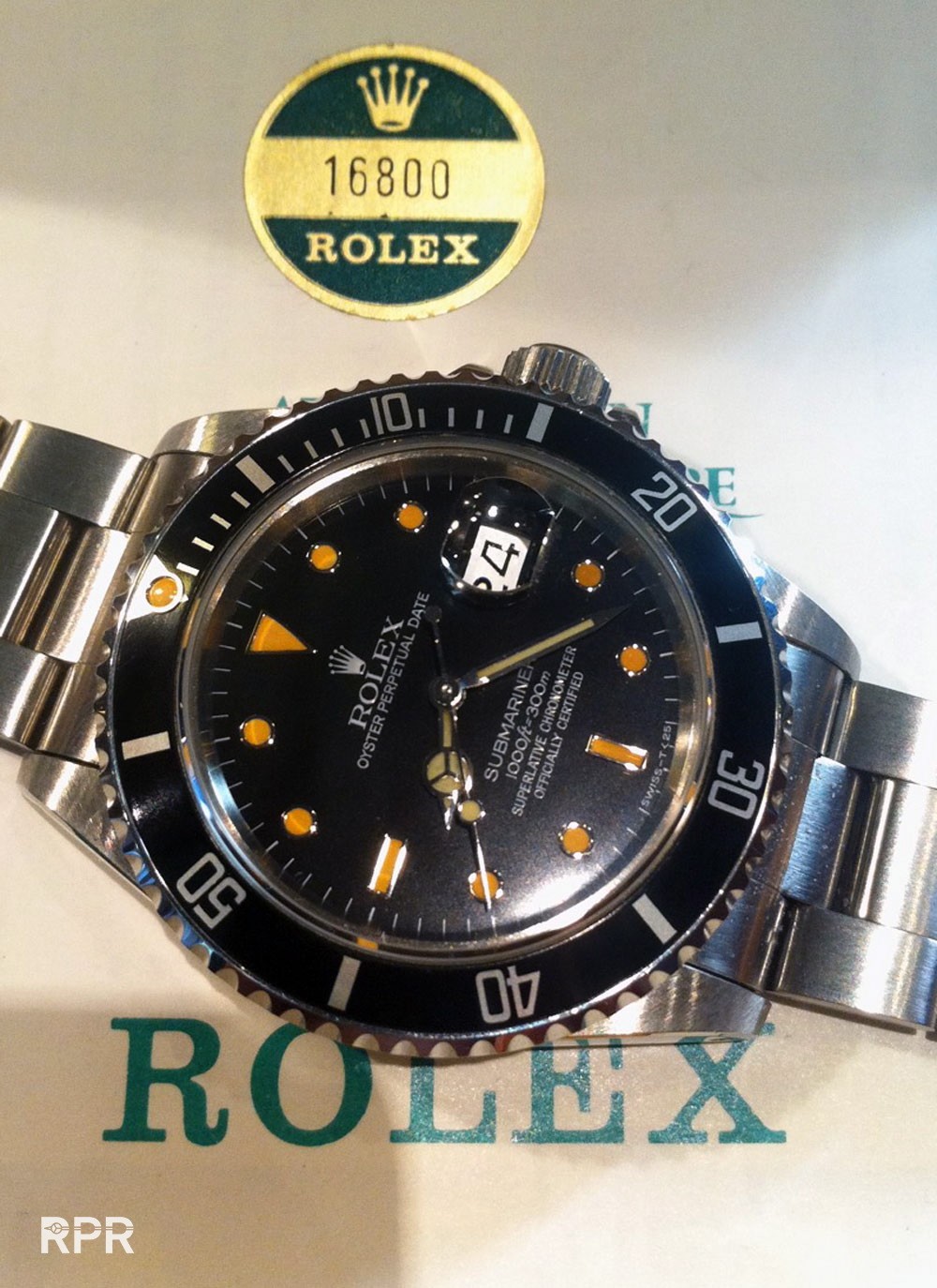
I hope you’ve enjoyed and learned from my “The Evolution of Vintage Rolex Luminous and Dial Production”. I will add more detailed information as collecting vintage Rolex is a never ending story. If you have any questions, please feel free to contact me directly: info at Rolex Passion Report .com
UPDATE: 19-02-2016
What is your vintage Rolex really worth now? What is the price of your vintage Rolex in current market??
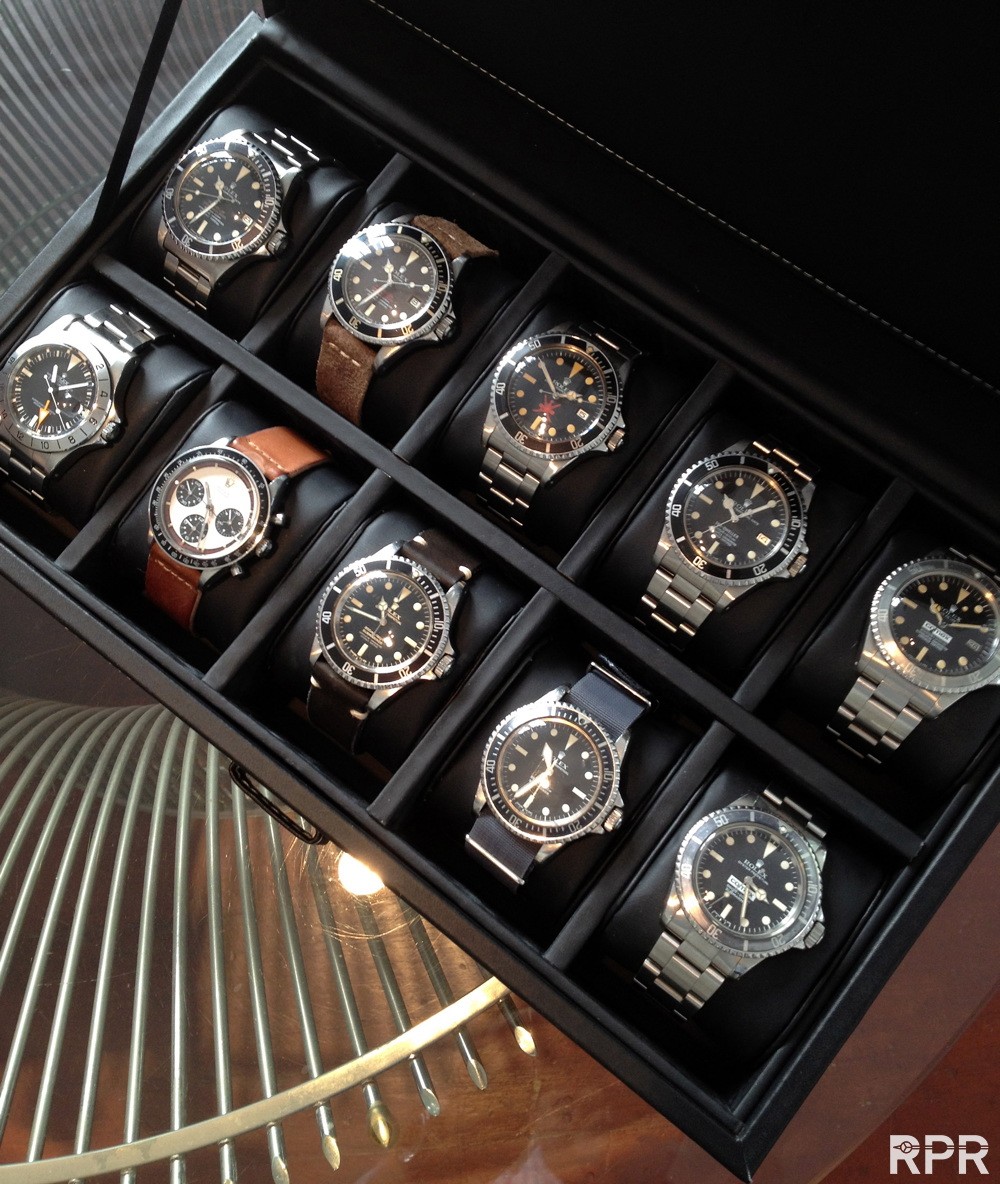

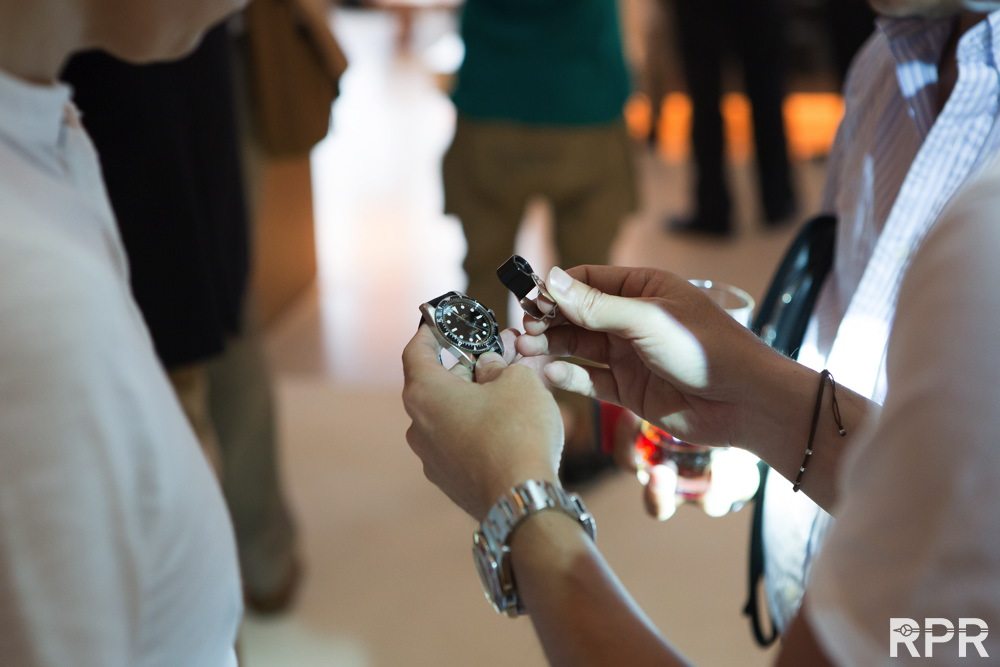
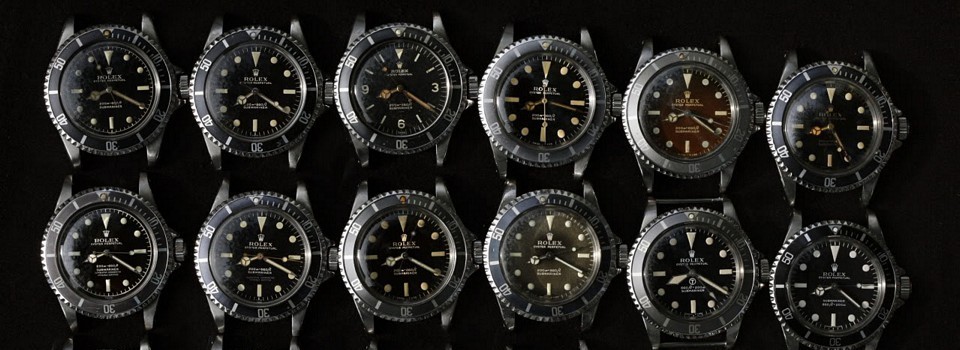
- The reference number or Rolex model.
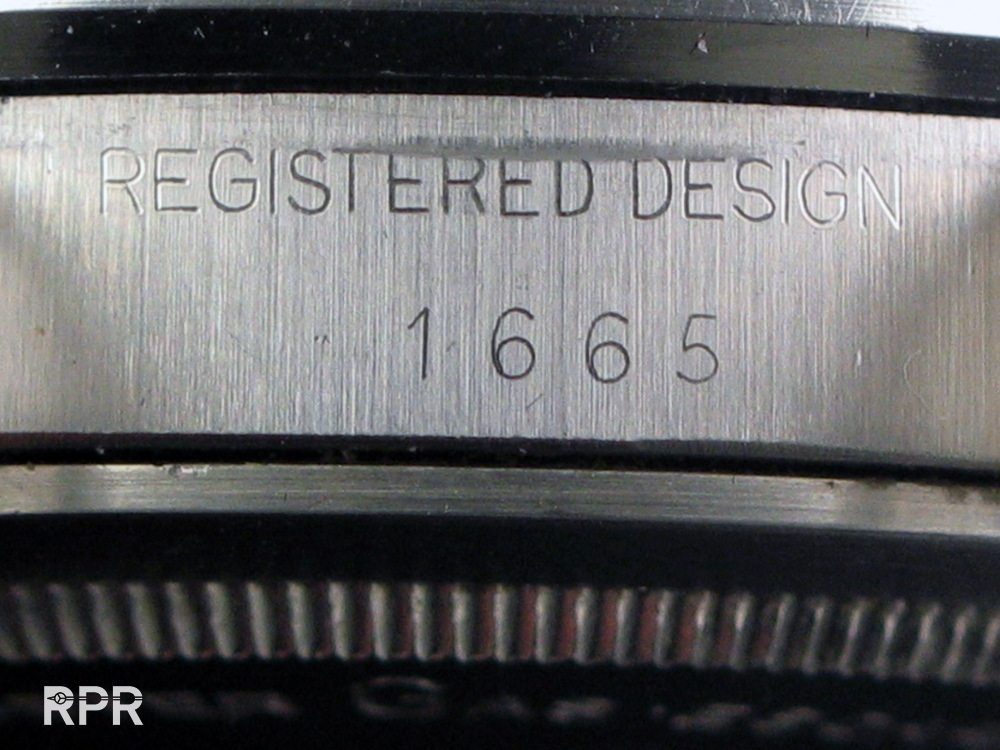
- The serial number or production number.
- Early SWISS markings at 6 o’clock telling us the luminous that was used is radium.
- The from 1964 introduced tritium stamp at 6 o’clock: “SWISS – T<25” print…
- Up close the “SWISS – T <25” print at 6 o’clock..
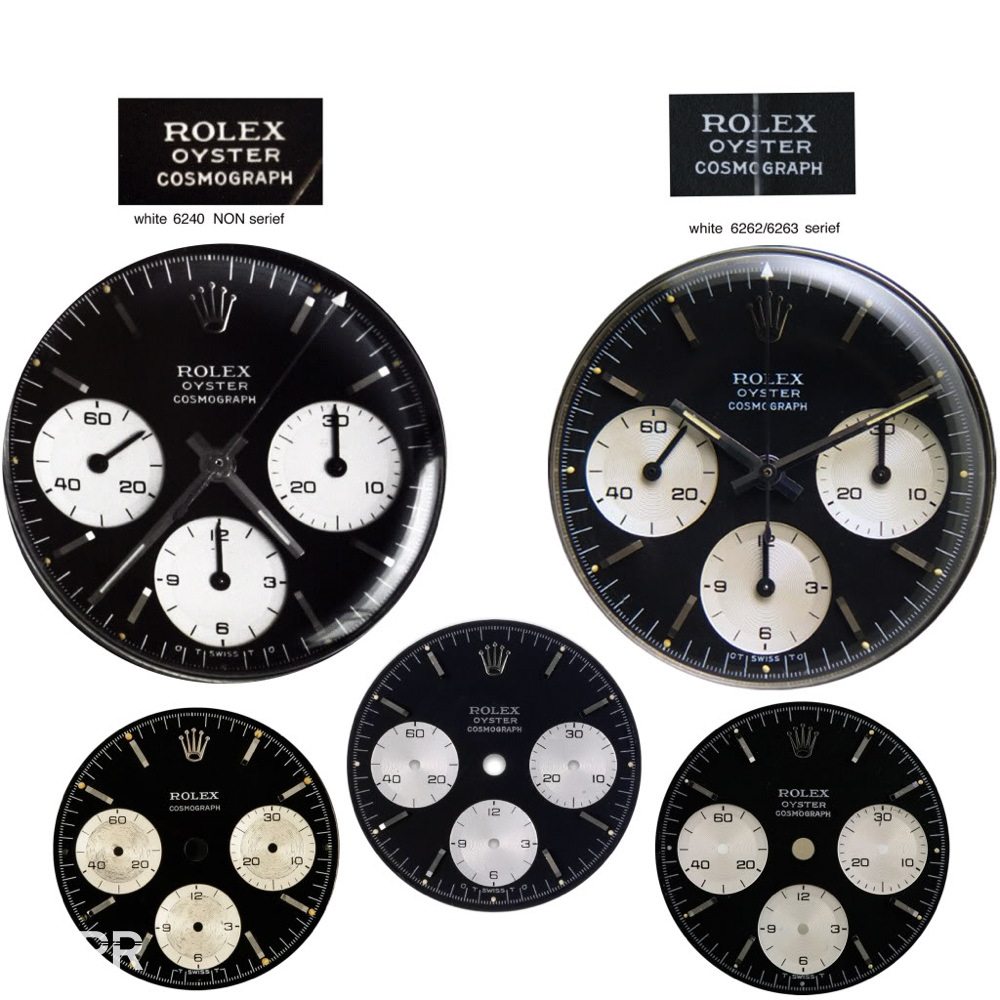
- First look at the Rolex coronet in detail. Every Rolex reference has it’s own coronet. Learn them to compare!
- Secondly you look very very closely at the rest of the Rolex print on the dial, do this carefully. To make it even more difficult and make you understand what to watch for, here’s a link to an RPR article about Fake vintage Rolex dials I warn collectors for!
- Then using simple techniques as a Geiger meter to see if there’s any radiation left on a Pre 1963 Rolex is very handy
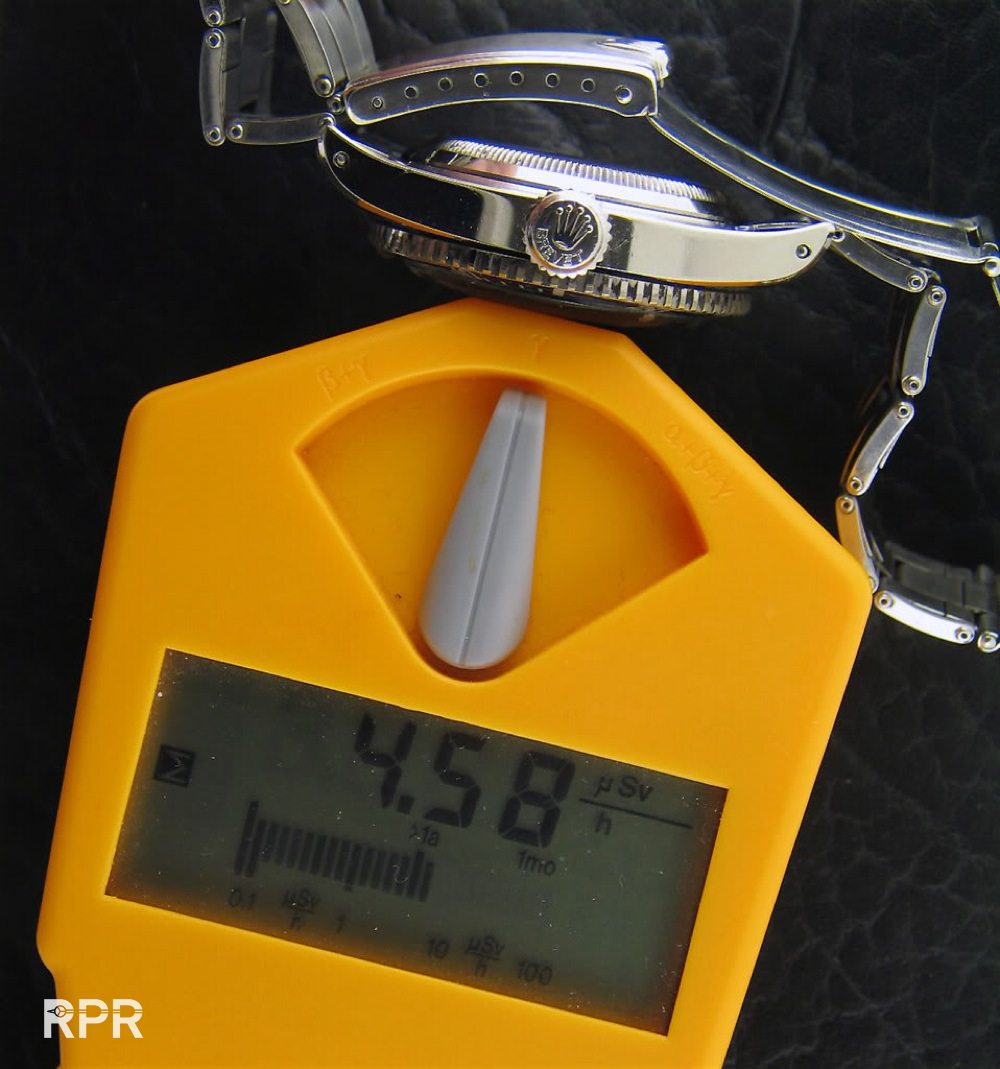
- If possible to open, the case back inside is giving you some extra info about the reference and in pre 1972 also the date stamp.

- Then please use “John Goldberger’s 100 superlative Rolex App” for any comparison between your Rolex and one that is still in all original detail. Investing less then $25,= you get tons of precious information you can use to compare your Rolex after you found out the most import an basic information I described above. Follow this link to the AppStore to download it on your device or if you prefer visit Goldberger’s website to acquire the book.
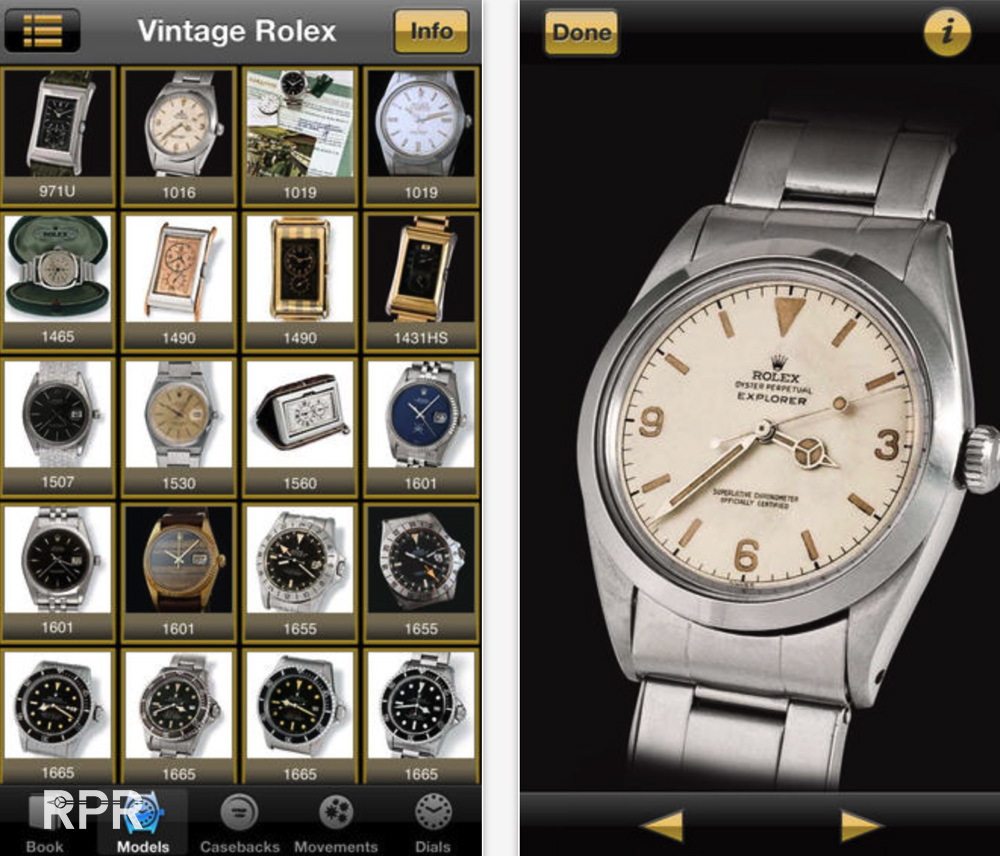
- You have a great overview of all models by reference, you see all case backs, movements and dials. There’s no better source!!!
- Very important information about the serial number and movement numbers are published for you to compare!
- Last but not least, check my –> “Vintage Rolex Buyers Guide” again with the new information you obtained and double check all details mentioned in my report to come to a final conclusion about the originality and condition of your vintage Rolex….
- Christie’s —> http://www.christies.com/results/
- Sothebys —> http://www.sothebys.com/en/auctions/results.html
- Phillips —> http://www.phillips.com/auctions/past
- Bonhams —> https://www.bonhams.com/results/
- Crott —> http://www.uhren-muser.de/archive.html?
- Antiquorum ->http://www.antiquorum.com/catalog/search
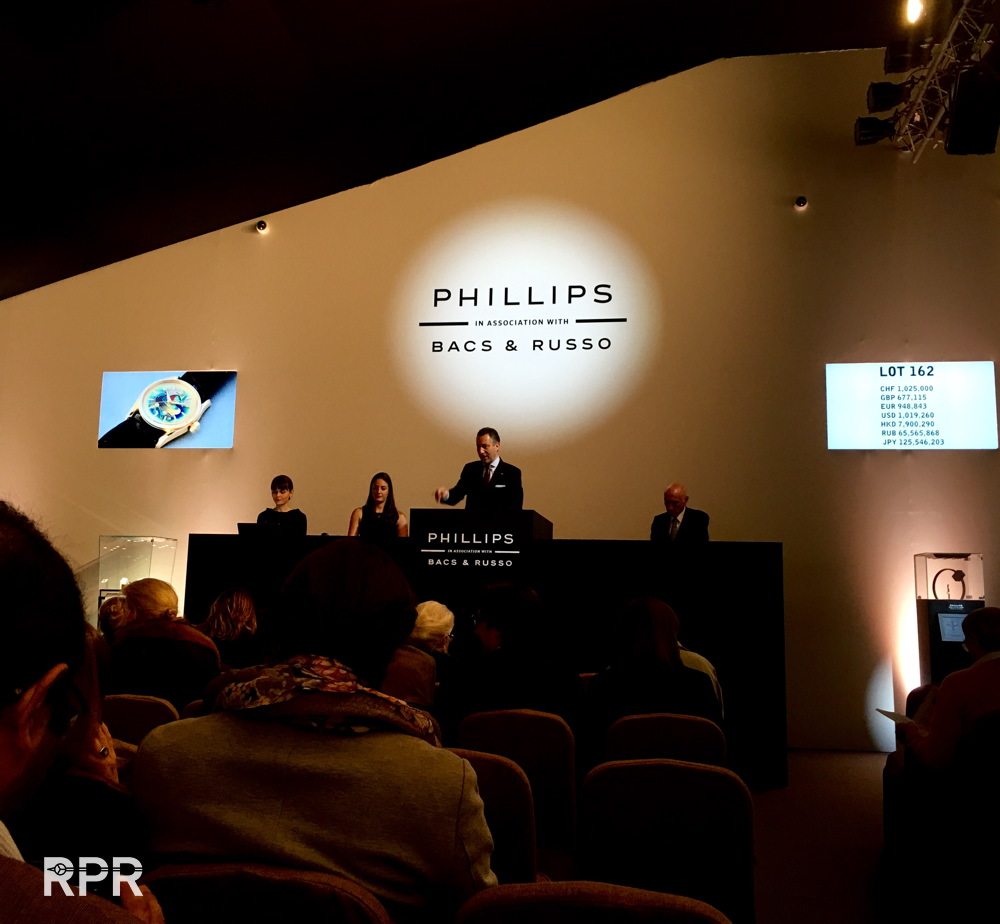
- a Million dollar baby, the RCO – alias “Rolex Cosmograph Oyster” Daytona
- A rare Albino Daytona ( recently sold for 1.3 million SFR ) on the left and a tropical RCO on the right, both from 1 collector!

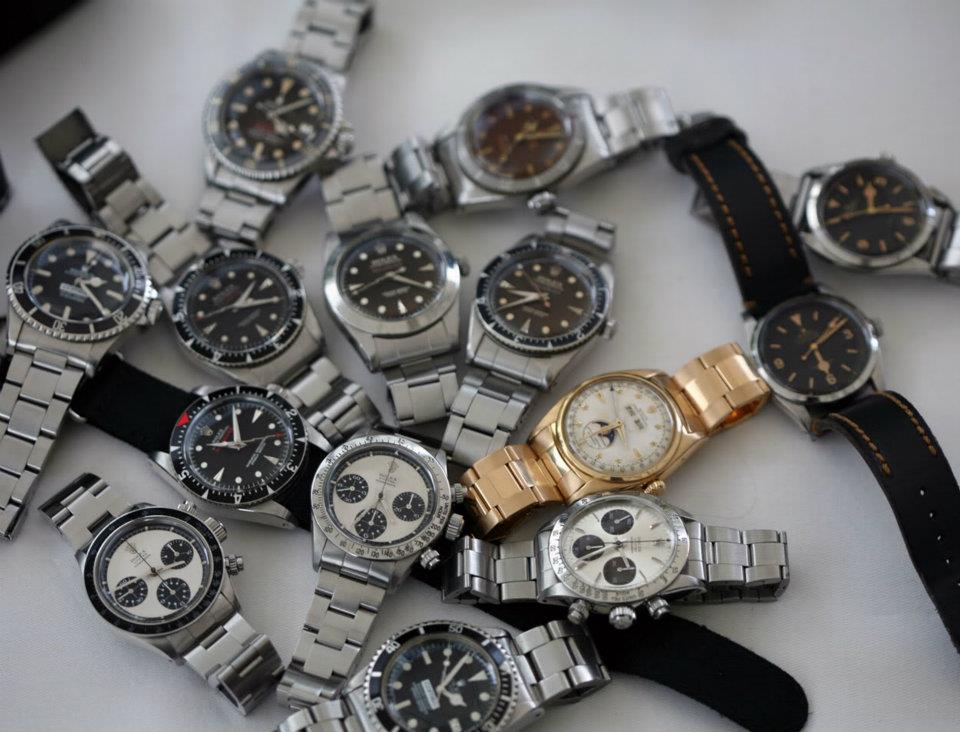
- I like to finish this report with a test to see if you understand what I tried to teach you in this post. Here’s a picture of a Rolex. Now before you scroll down to see my opinion, try to use the information I gave you in this report so you can come up yourself with the correct value of it. Good Luck!
.
.
.
.
.
.
.
.
OK, here we go. Once you would remove the pins on the side of the case using a pin, you will find the 7 digit Rolex serial number and the reference number. This will tell you it’s a Ref 1665 Sea Dweller. Then analyzing the dial, you will see that the graphics are different then the regular ones, specially the coronet and the lining of the SCOC text below on the dial. We collectors call this a “Rail Dial”. This dial has been produced by the Stern company (later owner of Patek Philippe) which also produced the Comex Seadweller dials for Rolex. This unusual dial we only see around 5.7 to 6.2 million serial making it when you study below serial number list from end 1978 – 1979. Next is to determine the condition, when you look closely to the finsih of the case and bracelet you’ll see the fine thin lines seems to be all original, smooth and steady, reflecting the light on a natural way. Specially the left corner lug seems to have some honest scratches on the chamfer of the bevel. The proportions are still looking nice and somehow sharp so the case looks to be in good condition.
As I always try to focus on the “all over matching patina” we now focus if the different parts are having the same aging. The tritium luminous on the dial is a bit toned and is the same as the tone of the hands. From this we can conclude that they still seem to be the original ones. Which also tells us that most likely this Sea Dweller has not been serviced by Rolex yet as then most likely the patinated hands (with little corrosion on top) would have been changed. The crystal is not having the sharp corner on the edge which we see with service crystals but still the domed. The bezel insert is period correct and the little tritium dot is showing us a warm patina which matches the aging of the rest of the tritium. The matte black dial seems to be undamaged, look carefully at the edge, where you often see chips from removing the movement from the case for a service.
Conclusion: All over this is a great looking Rolex Sea Dweller, from the “white” period with rare “Rail Dial” still in adorable original condition, hardly or not polished, having a matching all over patina of case, bezel, dial, hands and bracelet. When searching the auction results you will see these sell now for € 10-15K euro, this particular model I would rate more towards 15K due to it’s fine condition.
- The Rolex Serial Number List:
- The Rolex Reference List:
Rolex Bezel Codes:
0 = Smooth/Domed
1 = Rotating/Engine Turned (early)
2 = Engraved
3 = Fluted
4 = Bark
5 = Pyramie (Not Used)
6 = Turn-O-Graph
7 = Various
8 = Special (Not Currently Used)
9 = Open (Not Currently Used)
Rolex Metal Type:
0 = Stainless Steel
1 = Yellow gold Placor (Tudor)
22 = Stainless steel and Platinum (Yachtmaster)
3 = Stainless Steel and 18k Yellow gold (Yellow Rolesor)
4 = Stainless Steel and 18k White gold (White Rolesor)
5 = Gold Shell (early models – Rose Gold on newer models)
6 = Platinum
7 = 14k Yellow gold (No Longer Used)
8 = 18k Yellow gold
9 = 18k White gold
BIC = Bi-Color 18k Yellow and White gold combo
TRIDOR = 18k Yellow, White and Rose gold
Rolex Dial Codes:
– first digit:
1x = Silver
2x = Champagne
3x = Black
4x = Steel
5x = White
6x = Blue
7x = Bronze
8x = Pink
9x = Mother of Pearl
– second digit:
x0 = Index (Stick)
x1 = Unknown/Unused
x2 = Sunbeam (Roman)
x3 = Roman
x4 = Bi Color Dial (Index)
x5 = Jubilee (Roman)
x6 = Maxi Arabic
x7 = Index (3,6,9 Arabic)
x8 = Waves (Arabic)
x9 =Sunbeam (Roman)
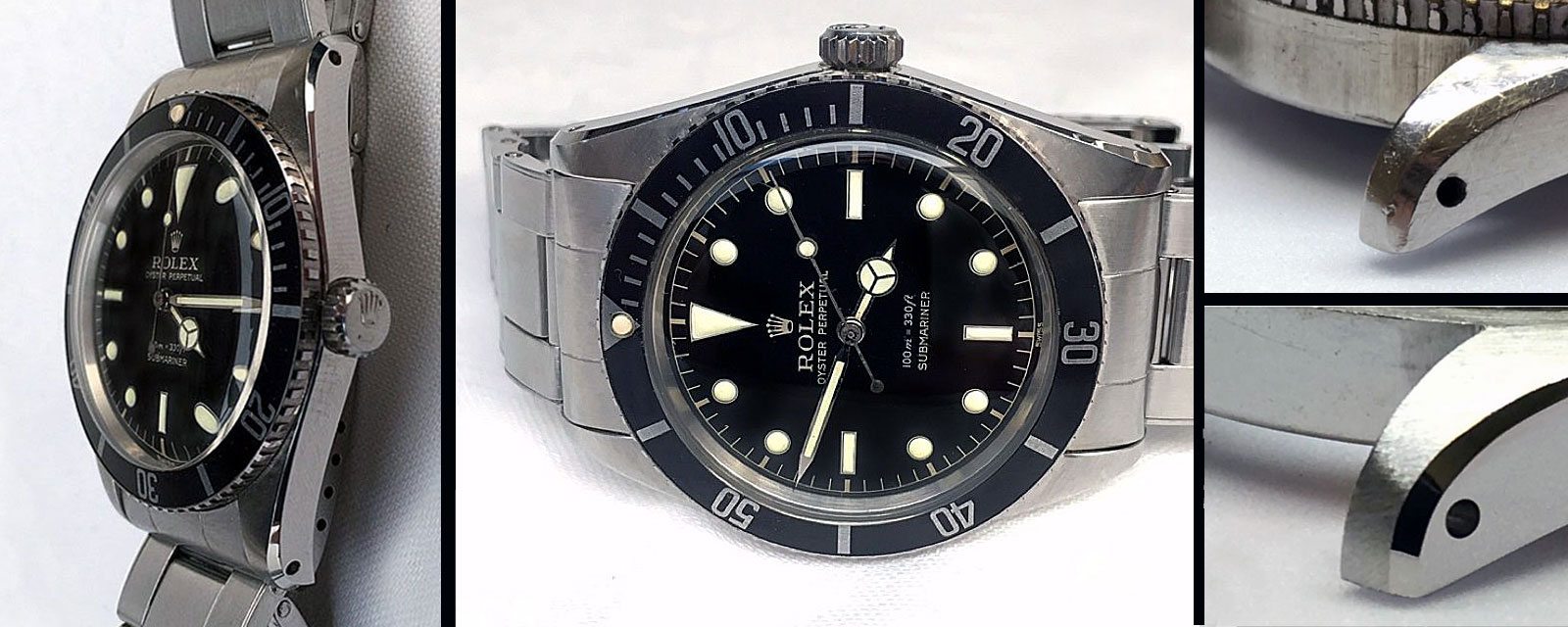
- Magnify the matt parts of the case
- Magnify lugs, font and back
- Magnify bevelled edges between matt part and middle case
- Case back engravings worn out
- Hallmarks on back of lugs worn out but fresh case
- Satin polish: difference case back inner circle and outer rim
- Missing straight fine lines
- Missing sharpness on edges of lug holes
Unpolished
In case you are not sure how a certain reference should look like unpolished, take a close look at the matte part of the watch with a suitable magnifier. The matte parts will tell you if a watch has been polished or not. Below I will post some pictures from unused vintage Rolex so you can compare yours with. Here’s a unpolished like new small crown Ref 5508. Focus on the edges…
Every angle is still sharp, the side from the bezel, no marks on the crown or side of the case and also not on chamfer of the bevel.
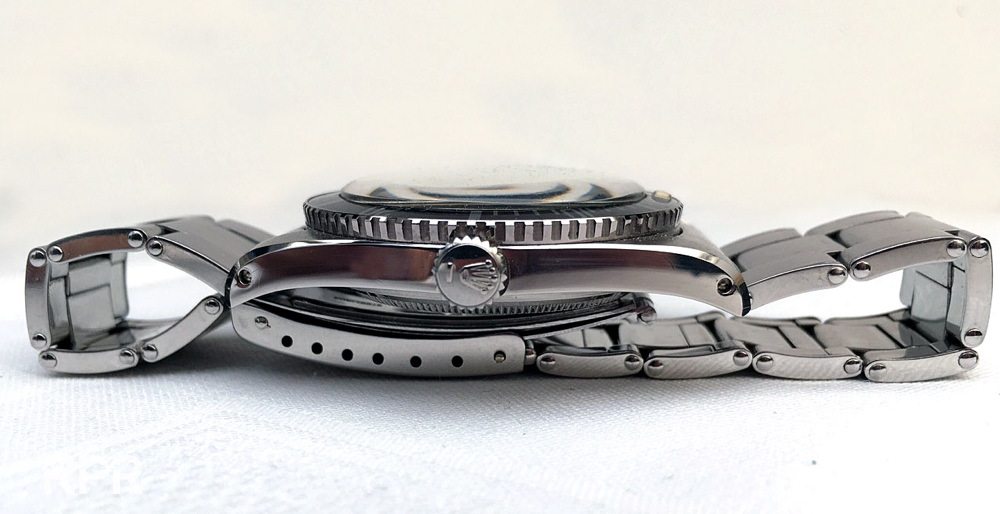 In case you are not sure how a certain reference should look like unpolished, take a close look at the matte part of the watch with a suitable magnifier. The matte parts will tell you if a watch has been polished or not…
In case you are not sure how a certain reference should look like unpolished, take a close look at the matte part of the watch with a suitable magnifier. The matte parts will tell you if a watch has been polished or not…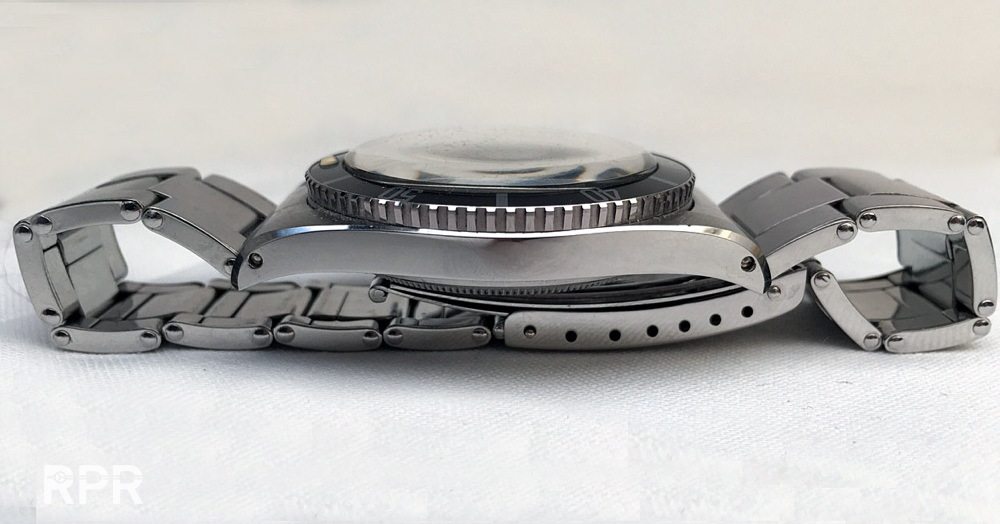
A unused bracelet is still stiff, you need to bend the links. When removing the band with the push pins before polishing, it will always leave trace marks on the case. That is why the lugs are often sealed with tape before band removal. A clear sign of a service polish are the drilled lug holes, or better yet the sharpness of the lug hole edges. Because once polished, these lug holes will lose the original sharp edges.
Following is a GMT Ref 6542 also unpolished and unused. Hard to believe that these almost 60 year old Rolex have been tucked away and now see the daylight. In a scale of impossible to find these unused miracles are listing top position. Collectors grail.
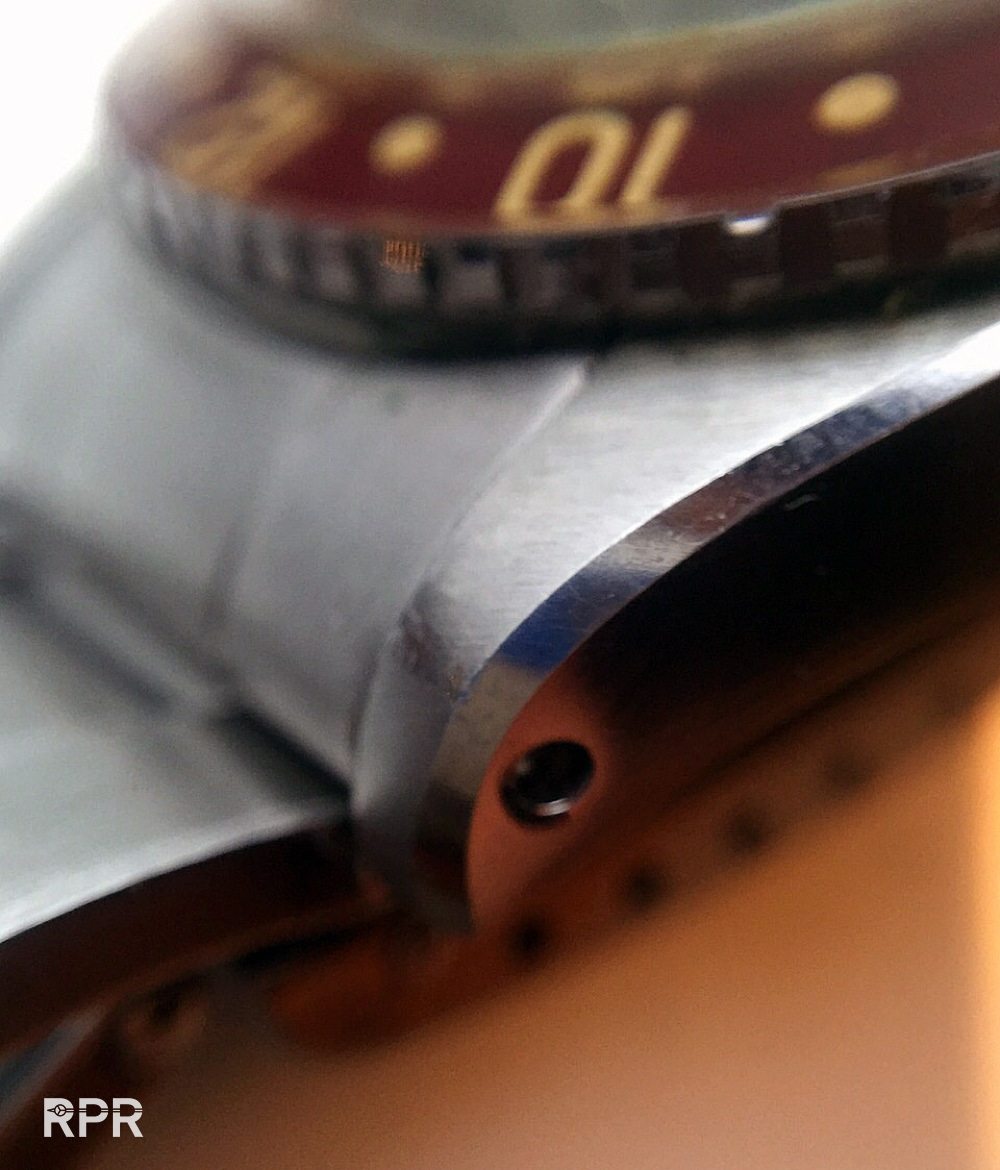 Another part to check if a watch has been polished are the chamfers, the bevelled edges between the matte part and the middle case. Tool watches like the Daytona or dresswatches like the DateJust and Daydate did not have chamfers. You will only find them on the Submariner , Milgaus, GMT-Master and Explorer II. Perhaps because of this rarity and value, bevels are particularly loved by vintage collectors. A bevel was merely for esthetical purposes. Each model had its own bevel, the bevel on the GMT-Master was a bit smaller than the Submariner one. This has to do with the fact that the Submariner model was thicker than the GMT-Master and the Submariner winding crown larger.
Another part to check if a watch has been polished are the chamfers, the bevelled edges between the matte part and the middle case. Tool watches like the Daytona or dresswatches like the DateJust and Daydate did not have chamfers. You will only find them on the Submariner , Milgaus, GMT-Master and Explorer II. Perhaps because of this rarity and value, bevels are particularly loved by vintage collectors. A bevel was merely for esthetical purposes. Each model had its own bevel, the bevel on the GMT-Master was a bit smaller than the Submariner one. This has to do with the fact that the Submariner model was thicker than the GMT-Master and the Submariner winding crown larger.
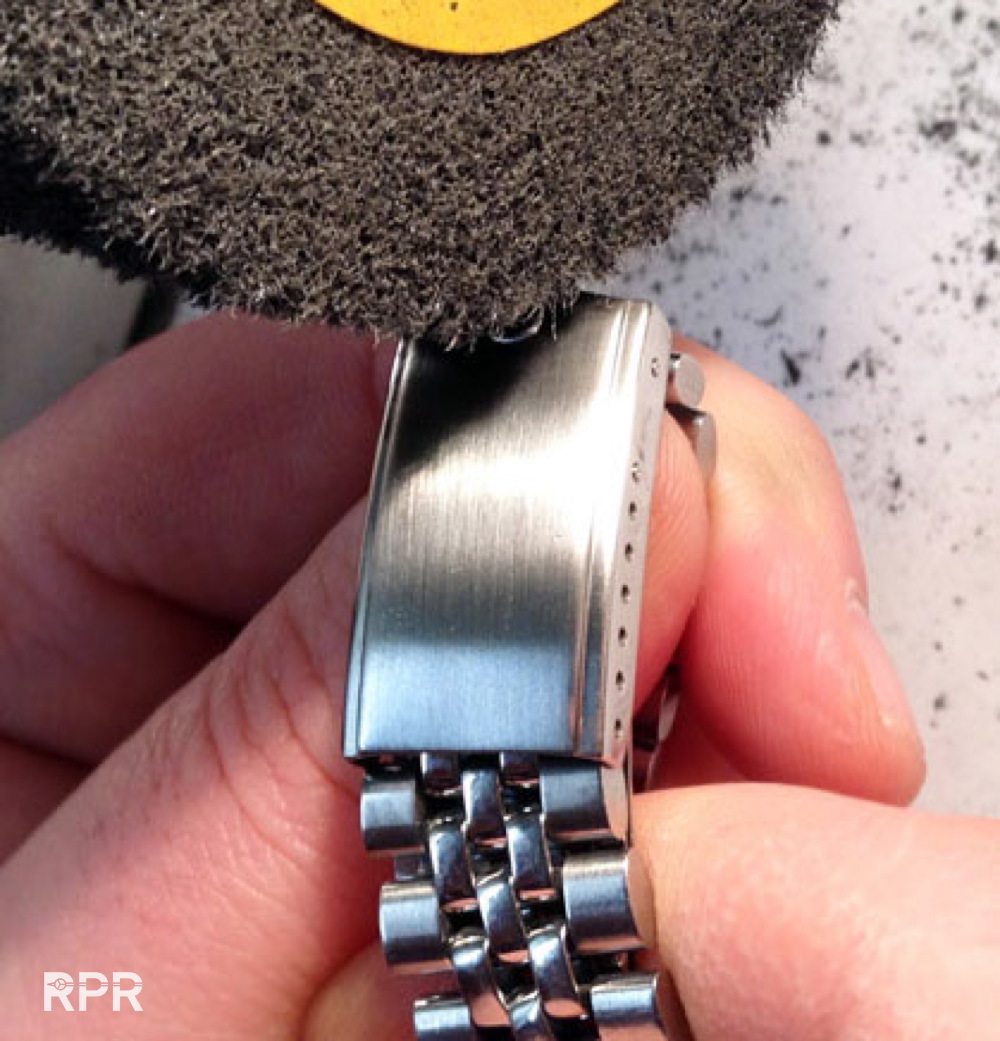 Little less rare are those unused, NOS (New Old Stock) Rolex from the 70-80-ids. Here’s a NOS Ref 6263 Daytona. Note the sharp bezel and all edges. There are professional polishers who take the whole watch apart when trying to polish it back to Rolex standard. This will inevitably cause loss of material, unless the polishing has been done very lightly. Not easy, as it requires highly developed polishing skills because you only get one shot. If it goes wrong, the transition in polish is clearly visible. But if you get it right, it is harder to detect with the naked eye.
Little less rare are those unused, NOS (New Old Stock) Rolex from the 70-80-ids. Here’s a NOS Ref 6263 Daytona. Note the sharp bezel and all edges. There are professional polishers who take the whole watch apart when trying to polish it back to Rolex standard. This will inevitably cause loss of material, unless the polishing has been done very lightly. Not easy, as it requires highly developed polishing skills because you only get one shot. If it goes wrong, the transition in polish is clearly visible. But if you get it right, it is harder to detect with the naked eye.
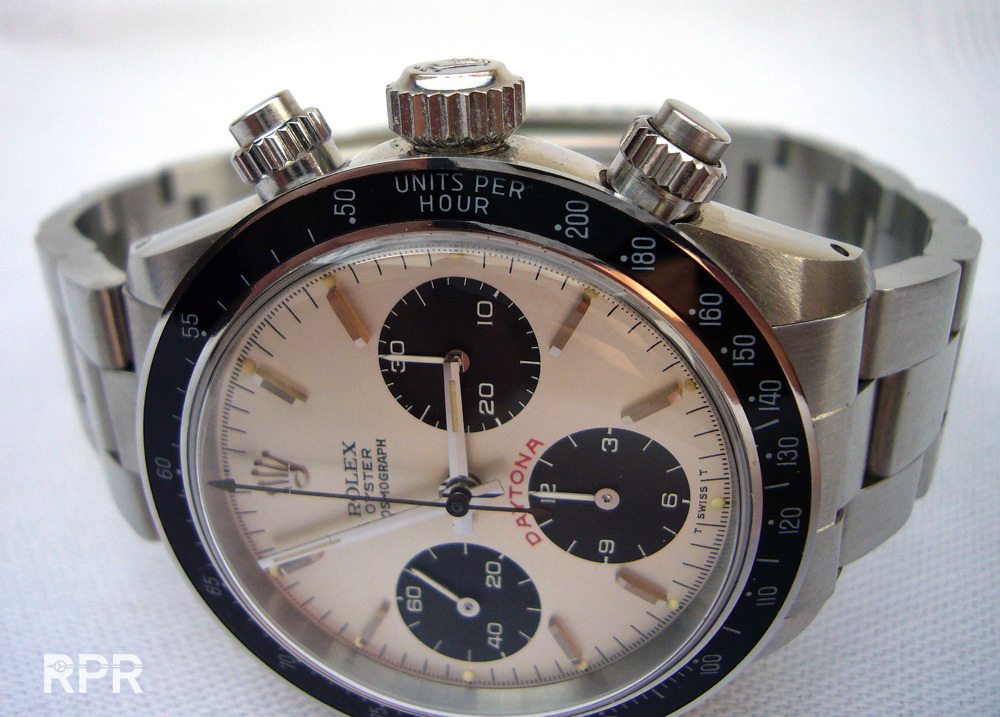 Another indicator if a watch has been polished or not, is by looking at the fine lines on a watch. If these are not straight, the polishing has been done by hand. Unpolished watches only have a manufacture polish, meaning the case has a satin polish that was done at the Rolex factory before all parts were assembled.
Another indicator if a watch has been polished or not, is by looking at the fine lines on a watch. If these are not straight, the polishing has been done by hand. Unpolished watches only have a manufacture polish, meaning the case has a satin polish that was done at the Rolex factory before all parts were assembled.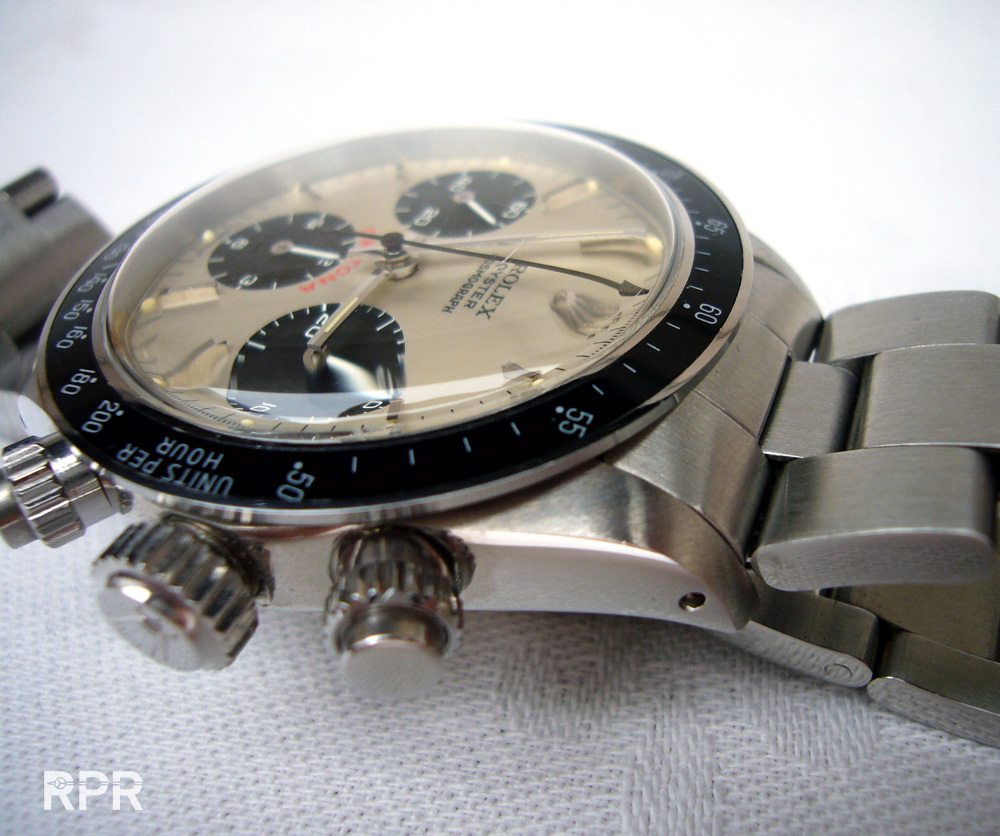 Every place where wear and tear could happen is still unused, the crowns, the case back, the lugs, the sides, bracelet, crystal. If you compare the case with the band, you will often see a difference in finish because the band is easier to polish than the case. The lugs are especially difficult to handle, so this is an area that requires extra attention with your magnifier. While attempting to make the case matte again, there will always be a 1mm spot against the edge, impossible for a polishing machine to reach. In fact, you could only do a proper polishing job by taking the whole watch apart.
Every place where wear and tear could happen is still unused, the crowns, the case back, the lugs, the sides, bracelet, crystal. If you compare the case with the band, you will often see a difference in finish because the band is easier to polish than the case. The lugs are especially difficult to handle, so this is an area that requires extra attention with your magnifier. While attempting to make the case matte again, there will always be a 1mm spot against the edge, impossible for a polishing machine to reach. In fact, you could only do a proper polishing job by taking the whole watch apart.
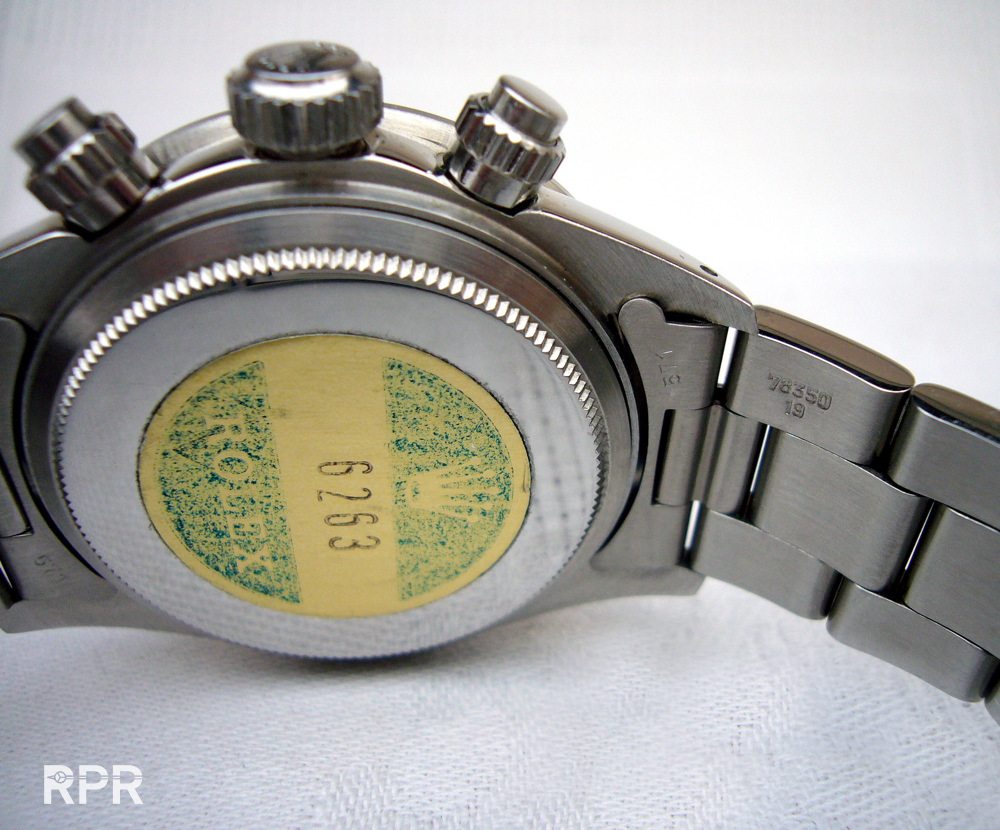 Wear indicators case side
Wear indicators case side
- Original crown or replacement
- Replacement crown periodically correct
- Magnify pushers if present
- Magnify top left lug for heaviest wear (left wrist watch wearers)
- Magnify below lugs for end link scratches
- Magnify below lugs for dirt/dust
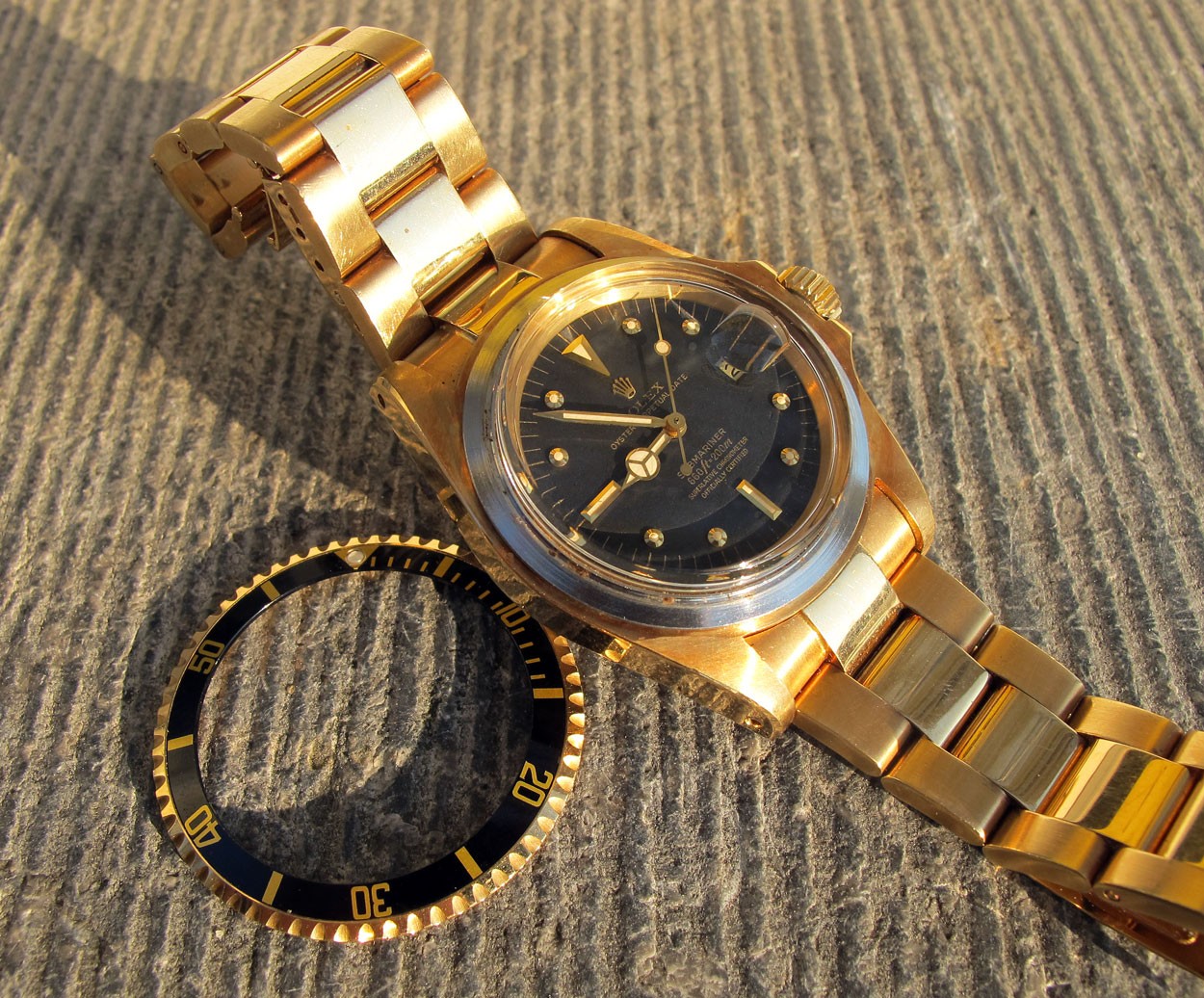 A used but unpolished gold Rolex Submariner Ref 1680 nipple dial. With gold cases it’s very easy to see if they are polished or not. One complicating factor in assessing the polishing of a case, is that the satin factory polish has become more coarse over the years, if you compare models of the 1950s/1960s/1970s. I believe this has to do with the fact that production numbers rose rapidly and less time was spent on the finish of a watch due to the introduction of machine polish and laser check.
A used but unpolished gold Rolex Submariner Ref 1680 nipple dial. With gold cases it’s very easy to see if they are polished or not. One complicating factor in assessing the polishing of a case, is that the satin factory polish has become more coarse over the years, if you compare models of the 1950s/1960s/1970s. I believe this has to do with the fact that production numbers rose rapidly and less time was spent on the finish of a watch due to the introduction of machine polish and laser check.
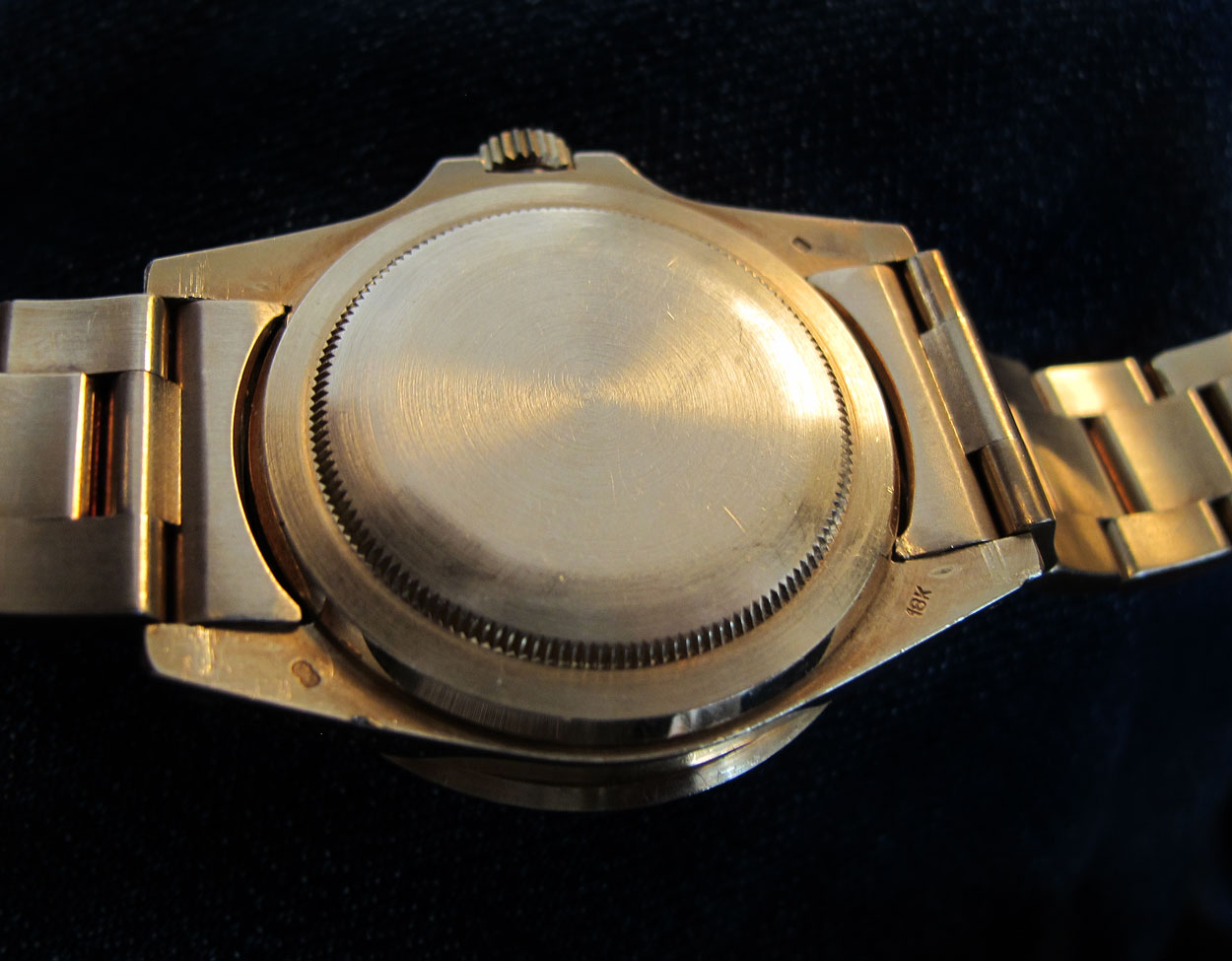 When polished, the back of the lugs will often have the same round finish as the case. You would expect this finish on the inner circle of the case back as well, but this will be sealed with tape during polishing. Still, you can always feel the difference between the factory satin polish and service polish if you go from the inner circle to the outer polished rim.
When polished, the back of the lugs will often have the same round finish as the case. You would expect this finish on the inner circle of the case back as well, but this will be sealed with tape during polishing. Still, you can always feel the difference between the factory satin polish and service polish if you go from the inner circle to the outer polished rim.
Wear indicators case back
-
-
- Magnify screw thread for frequent opening of case
- Original rubber sealing ring present
- Original rubber sealing ring or replacement
- Tarnish on screw thread
- Magnify case back for service codes
-
Wear indicators glass
-
-
- Original crystal?
- If original, is there any ‘icing” visible
- Is it a later service crystal with sharp edge
- Correct crystal type corresponds with model
-
 Above original Crystal on the left with lots of radium dust in there, be careful!
Above original Crystal on the left with lots of radium dust in there, be careful!
In below A/6538 Military Bg Crown you see the ‘icing’ in the crystal..
-
-
- Patina movement corresponds with patina watch
- Magnify screw near crown for damage, those are often used to get the movement out of the case
- Magnify the screws that hold the movement in it’s place, in below example at the edge in the middle of the lugs.
- Magnify small screws for tarnish and if they have been used. Often a used one will show you burr on the screw.
- Examine the screw thread. Often the rubber seal shows you wear. Also salt water will leave marks clearly visible.
-
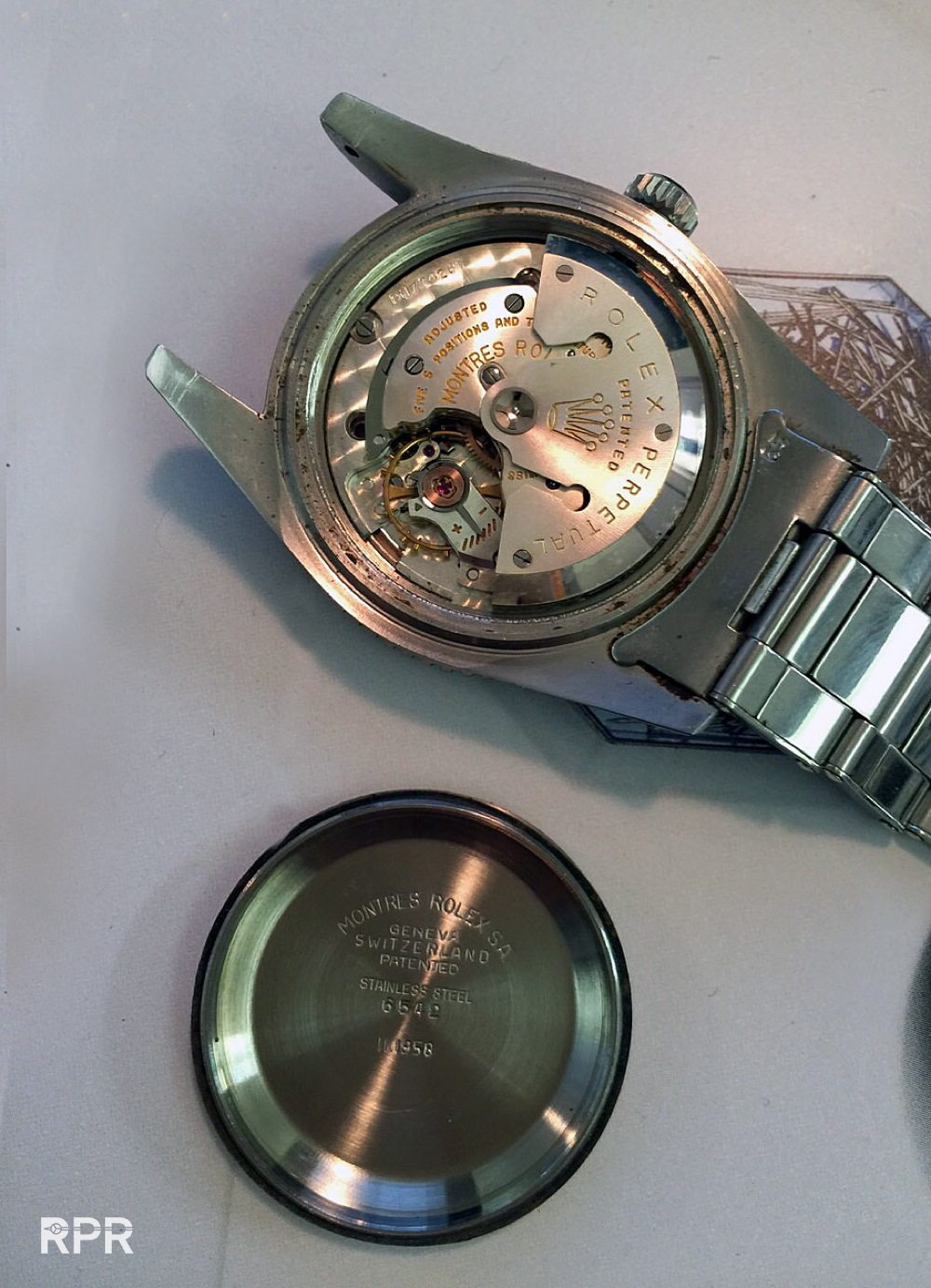 Above the unused Ref 6542 case back inside and movement, which still looks like new. Below a patinated and used movement..
Above the unused Ref 6542 case back inside and movement, which still looks like new. Below a patinated and used movement..
Serial Number
-
-
- Serial Number present
- Magnify Serial Number for clear engraving
- Worn out Serial Number corresponds with worn out case
- Serial Number matching with model
- Serial Number matching with production date inside case back
-
-
-
- Reference Number present
- Magnify Reference Number for clear engraving
- Worn out Reference Number corresponds with worn out case
- Reference Number inside case back matching with number in between lugs
- Reference Number matching with model
-
Luminous
-
-
- Type of luminous matching with period of model:
- Swiss print with Radium luminous
- Swiss + ! with lower Radium luminous
- Swiss + _ with Tritium luminous
- Magnify for Golden Swiss, white Swiss, double Swiss corresponds with period of model
- Swiss – T<25 / T-Swiss-T / T-Swiss-T<25 corresponds with period of model
- UV-lamp lest luminous glow for several minutes
- Overall matching luminous in colour and fluffiness on dial, hands and markers
- Colour of luminous matches period of model (<1964 cappuccino vs yellow)
- Colour of luminous greenish indication for water damage
- Stains on dial due to damage Radium luminous
- Luminous paint completely inside surrounds
- Type of luminous matching with period of model:
-
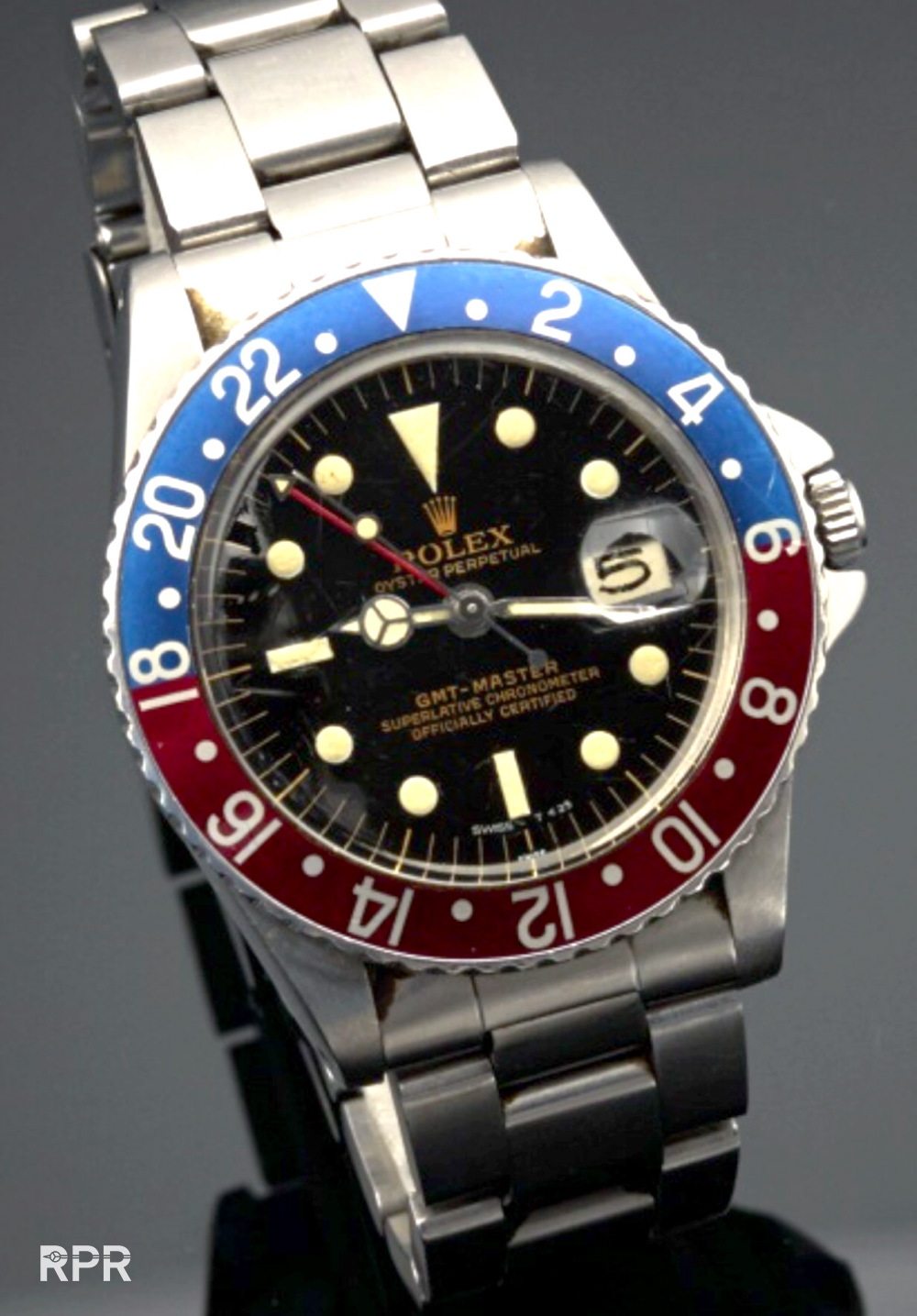
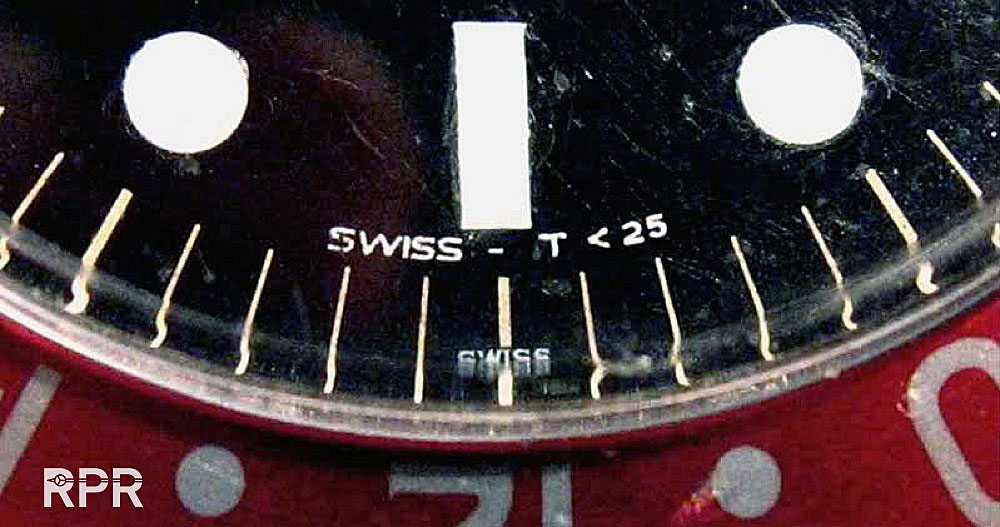 Above clearly visible are the 2 generation luminous stamps, the one below, swiss only and the one above, stating now that the luminous is of new generation, < 0.25MSv. Below interesting close up that shows the swiss has been reprinted over the lume.
Above clearly visible are the 2 generation luminous stamps, the one below, swiss only and the one above, stating now that the luminous is of new generation, < 0.25MSv. Below interesting close up that shows the swiss has been reprinted over the lume.
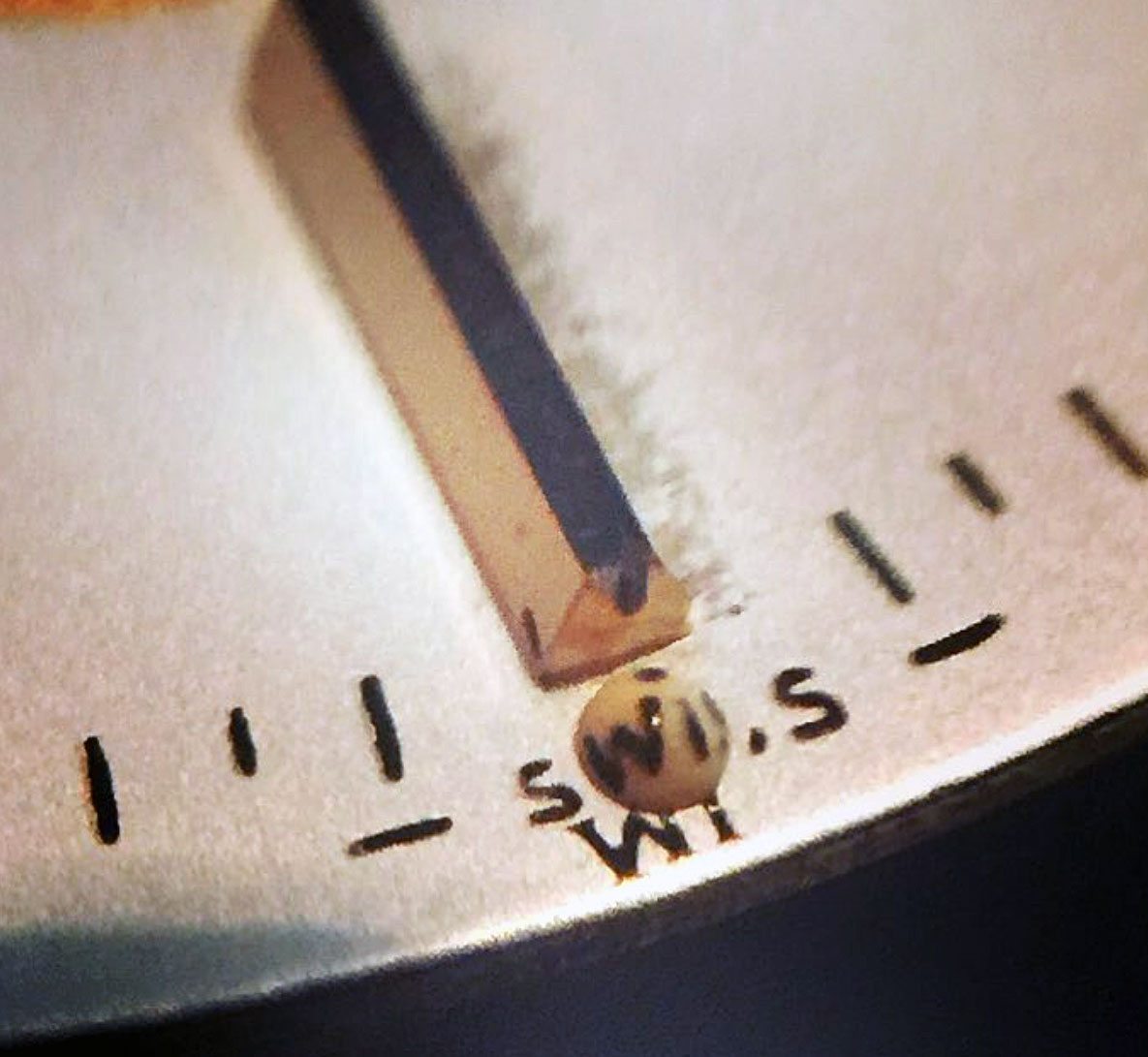 Then a close up of the compound of the luminous. It always make me feel like a cappuccino..
Then a close up of the compound of the luminous. It always make me feel like a cappuccino..
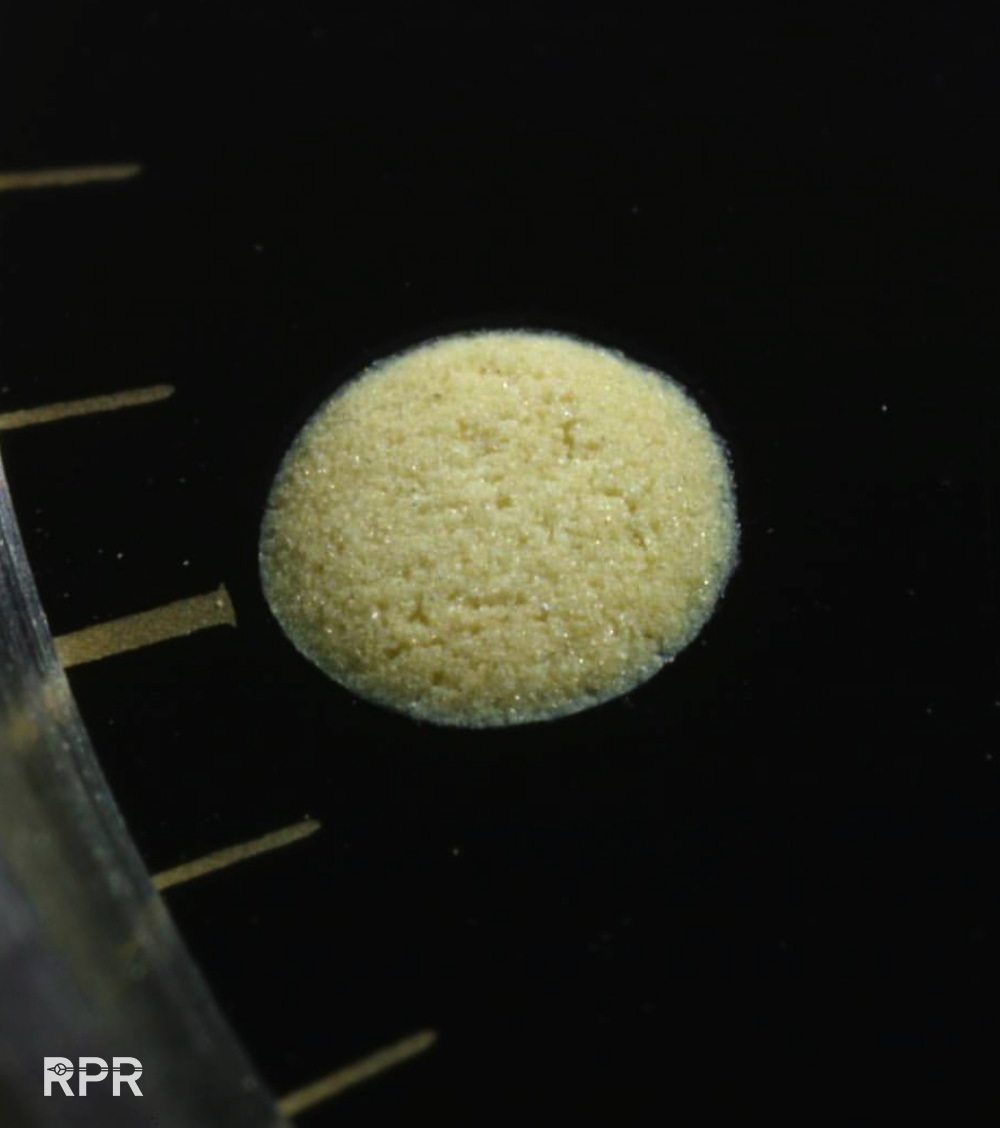 Composition
Composition
-
-
- Cracked dial when tilted in light
- Magnify gilt lettering for correct application
- Glossy dial corresponds with period of model
- Matte dial corresponds with period of model
- Tropical dial corresponds with period of model
- Tropical dial with intact luminous
- Rolex print under/over lacquer layer
-
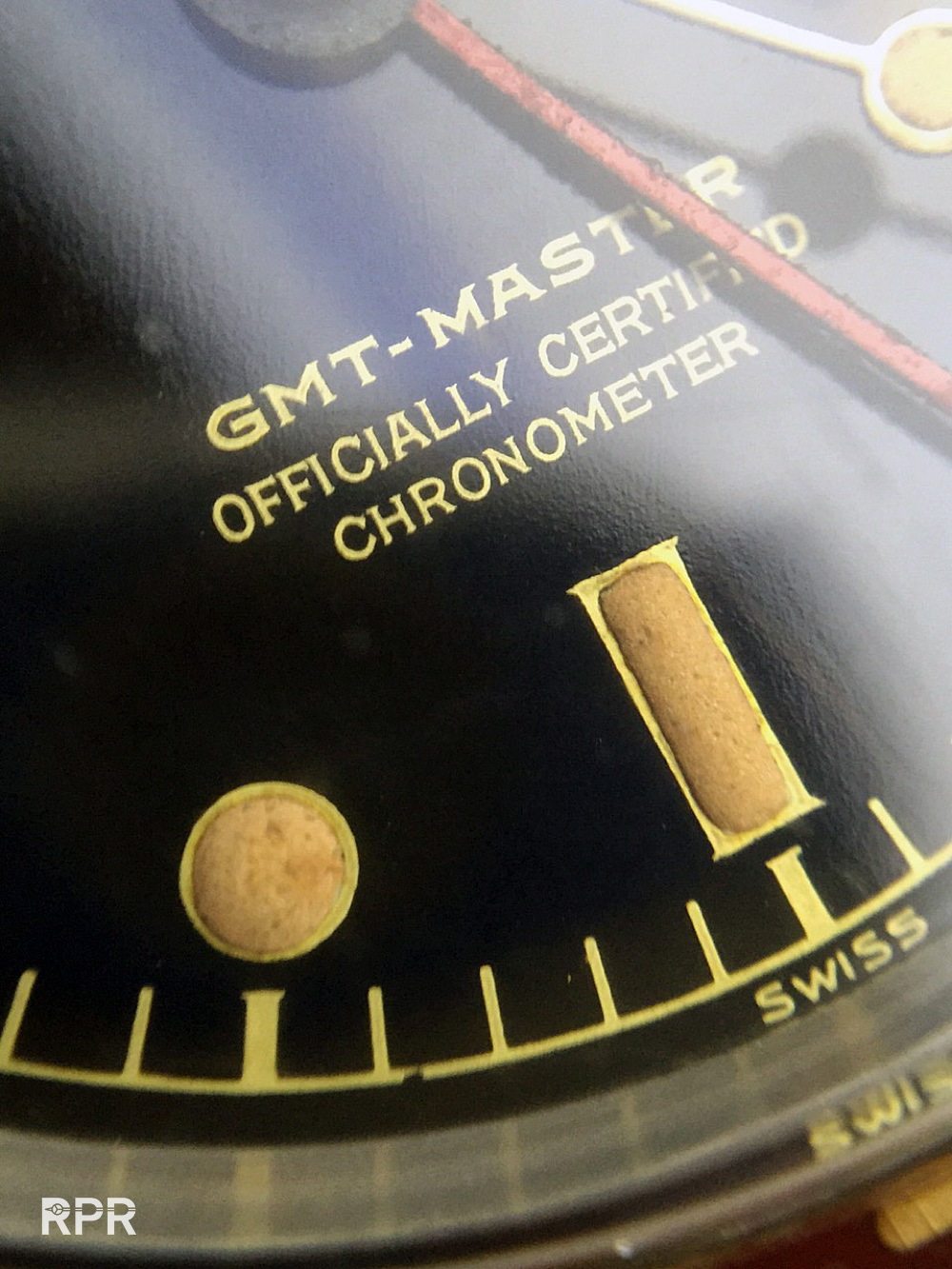 Above flawless glossy gilt radium dial and below a sunburned cracked spider dial…
Above flawless glossy gilt radium dial and below a sunburned cracked spider dial…
-
-
- Ribbed edge of fluted bezel matches period of model
- Is the inlay original and matching the all over patina.
- Faded inlay matches dial and luminous, often inlays get changed.
-
 Bezel, insert, red triangle, bevel, crown guards, big, small crown…
Bezel, insert, red triangle, bevel, crown guards, big, small crown…
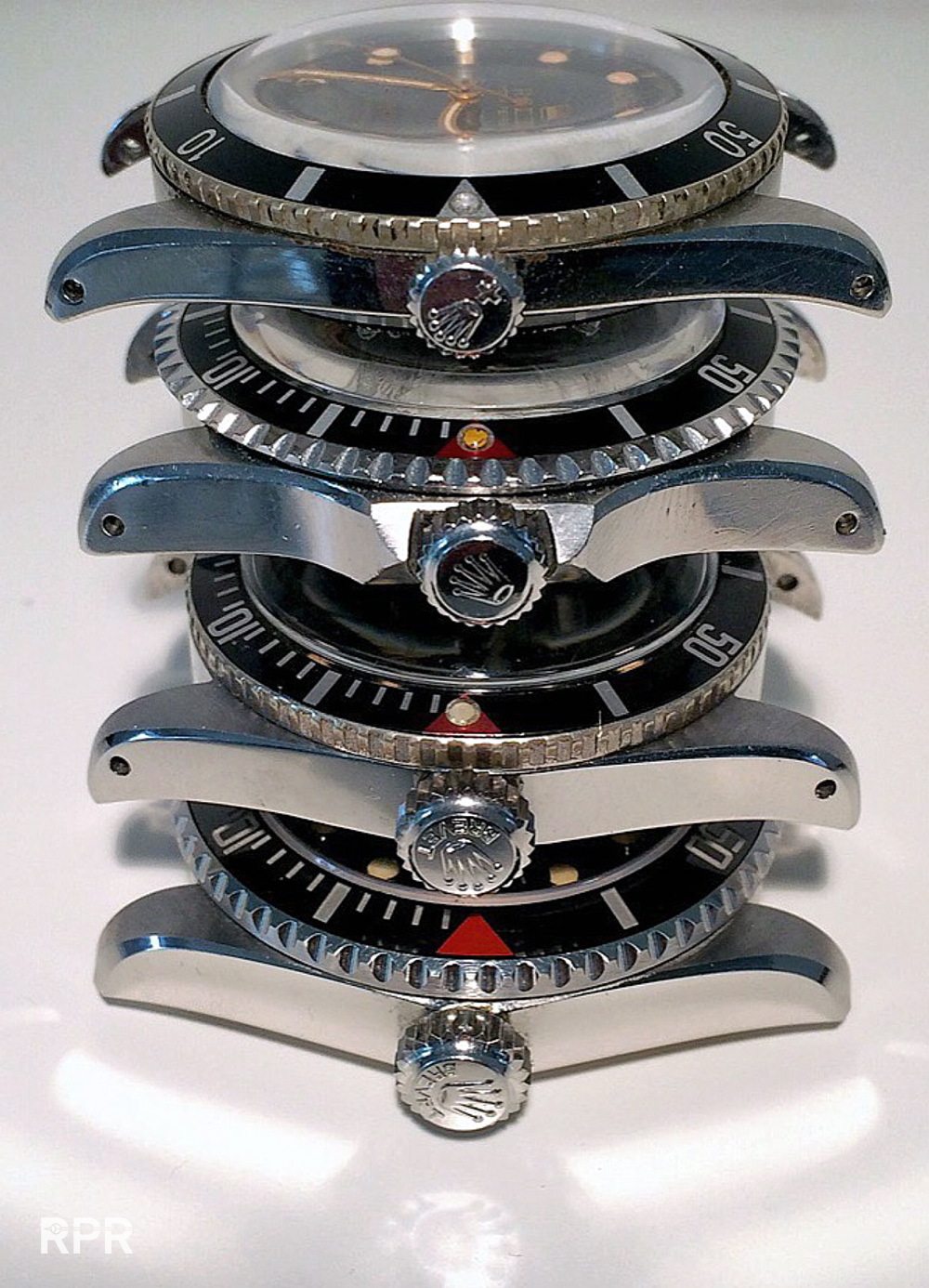 The flat bezel for the Ref 6541 has specially been made for the U.S. market
The flat bezel for the Ref 6541 has specially been made for the U.S. market
- Is the bracelet having any stretch?
- Have any links been removed?
- Is the inside of each rivet in the bracelet un bended?
- Are the screws used on the side to remove the link?
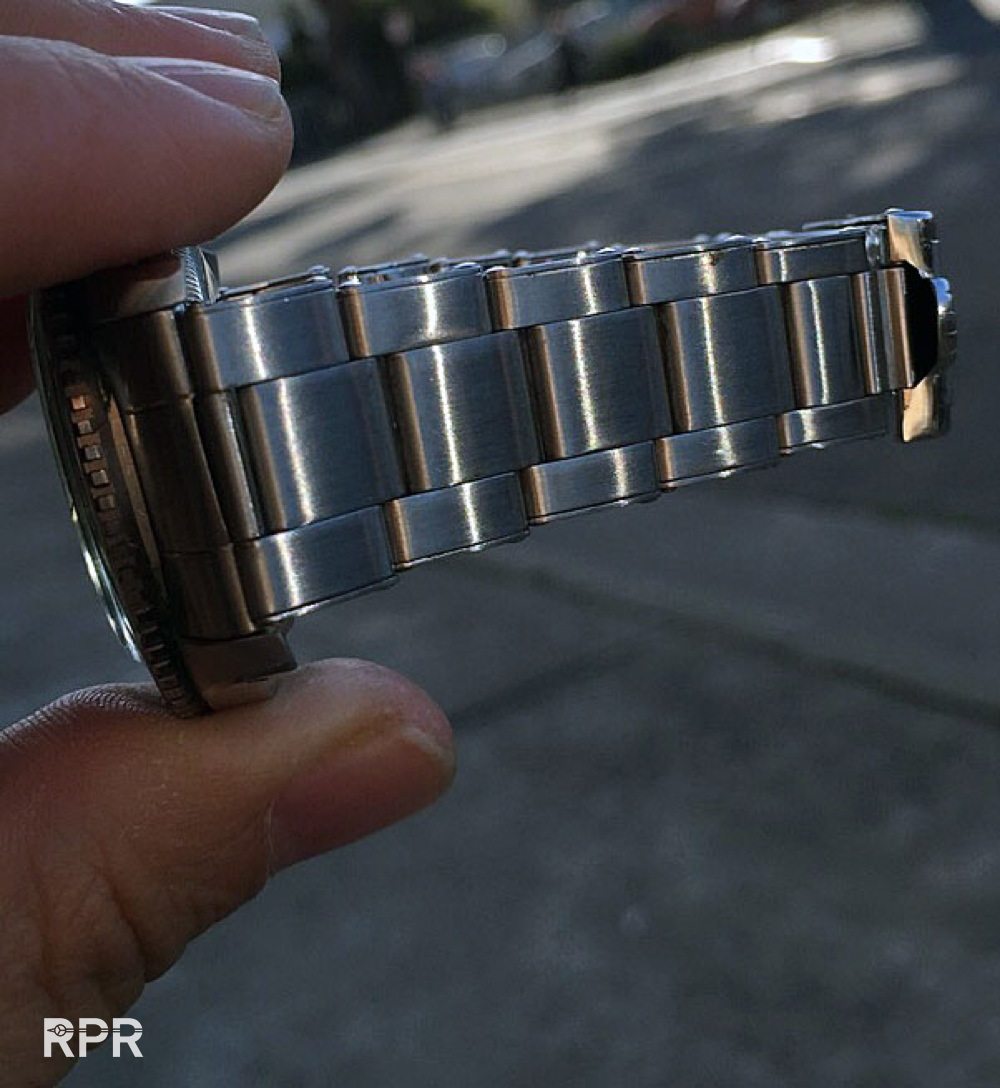
How do the bevels look? Round, worn, polished? If the bevel looks brand new, while the dial is not, something is wrong. If it is polished, then by whom? Rolex during service or an independent watchmaker? Certainly a trigger to look for replacement parts. Check below the stunning work LA Watch Works did…
 Here’s a summery from the checklist to determine the condition of your vintage Rolex:
Here’s a summery from the checklist to determine the condition of your vintage Rolex:
Case Condition
- Magnify the matt parts of the case
- Magnify lugs
- Magnify bevelled edges between matt part and middle case
- Case back engravings worn out
- Hallmarks on back of lugs worn out but fresh case
- Satin polish: difference case back inner circle and outer rim
- Missing straight fine lines
- Missing sharpness on edges of lug holes
Wear indicators case side
- Original crown or replacement
- Replacement crown periodically correct
- Magnify pushers if present
- Magnify top left lug for heaviest wear (left wrist watch wearers)
- Magnify below lugs for end link scratches
- Magnify below lugs for dirt/dust
Wear indicators case back
- Magnify screw thread for frequent opening of case
- Original rubber sealing ring present
- Original rubber sealing ring or replacement
- Tarnish on screw thread
- Magnify case back for service codes
Wear indicators glass
- Original crystal?
- If original, is there any ‘icing” visible
- Is it a later service crystal with sharp edge
- Correct crystal type corresponds with model
Wear indicators movement
- Patina movement corresponds with patina watch
- Magnify screw near crown for damage, those are often used to get the movement out of the case
- Magnify the screws that hold the movement in it’s place, in below example at the edge in the middle of the lugs.
- Magnify small screws for tarnish and if they have been used. Often a used one will show you burr on the screw.
- Examine the screw thread. Often the rubber seal shows you wear. Also salt water will leave marks clearly visible.
Serial Number
- Serial Number present
- Magnify Serial Number for clear engraving
- Worn out Serial Number corresponds with worn out case
- Serial Number matching with model
- Serial Number matching with production date inside case back
Reference Number
- Reference Number present
- Magnify Reference Number for clear engraving
- Worn out Reference Number corresponds with worn out case
- Reference Number inside case back matching with number in between lugs
- Reference Number matching with model
DIAL
Luminous
- Type of luminous matching with period of model:
- Swiss print with Radium luminous
- Swiss + ! with lower Radium luminous
- Swiss + _ with Tritium luminous
- Magnify for Golden Swiss, white Swiss, double Swiss corresponds with period of model
- Swiss – T<25 / T-Swiss-T / T-Swiss-T<25 corresponds with period of model
- UV-lamp lest luminous glow for several minutes
- Overall matching luminous in colour and fluffiness on dial, hands and markers
- Colour of luminous matches period of model (<1964 cappuccino vs yellow)
- Colour of luminous greenish indication for water damage
- Stains on dial due to damage Radium luminous
- Luminous paint completely inside surrounds
Composition
- Cracked dial when tilted in light
- Magnify gilt lettering for correct application
- Glossy dial corresponds with period of model
- Matte dial corresponds with period of model
- Tropical dial corresponds with period of model
- Tropical dial with intact luminous
- Rolex print under/over lacquer layer
BEZEL
- Ribbed edge of fluted bezel matches period of model
- Is the inlay original and matching the all over patina.
- Faded inlay matches dial and luminous, often inlays get changed.
Bracelet
- Is the bracelet having any stretch?
- Have any links been removed?
- Is the inside of each rivet in the bracelet un bended?
- Are the screws used on the side to remove the link?
I hope my checklist to determine the condition of your vintage Rolex has helped you. Check also following studies:
- My Vintage Rolex Buyers Guide
- The Evolution of the Daytona
- The Importance of the Vintage Rolex Dial
- The Evolution of Rolex Luminous
- What is your Vintage Rolex Worth?
- The Small and Big Crown Submariner Story
- The Ghost Daytona Oyster Paul Newman
- The Exclamation Mark
- The Story about the Rolex Prototype Dials
- The Rolex Sultan of Oman Story\
- The High Quality Fake Rolex Dials
Many more interesting articles I have shared with you in the past you find in my RPR Archive. If you have any questions, please send some pictures by my RPR Contact button.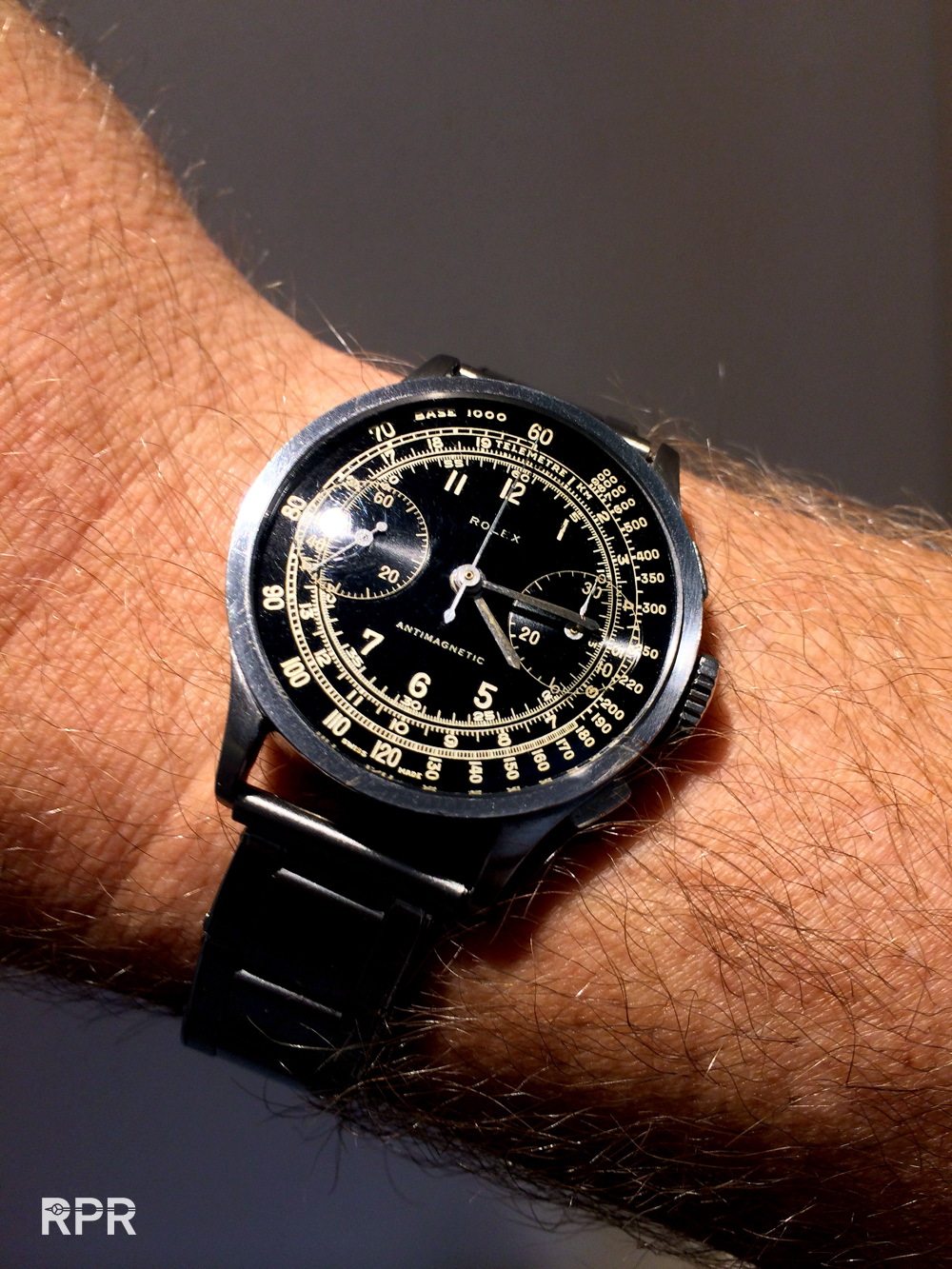 Cheers Philipp
Cheers Philipp
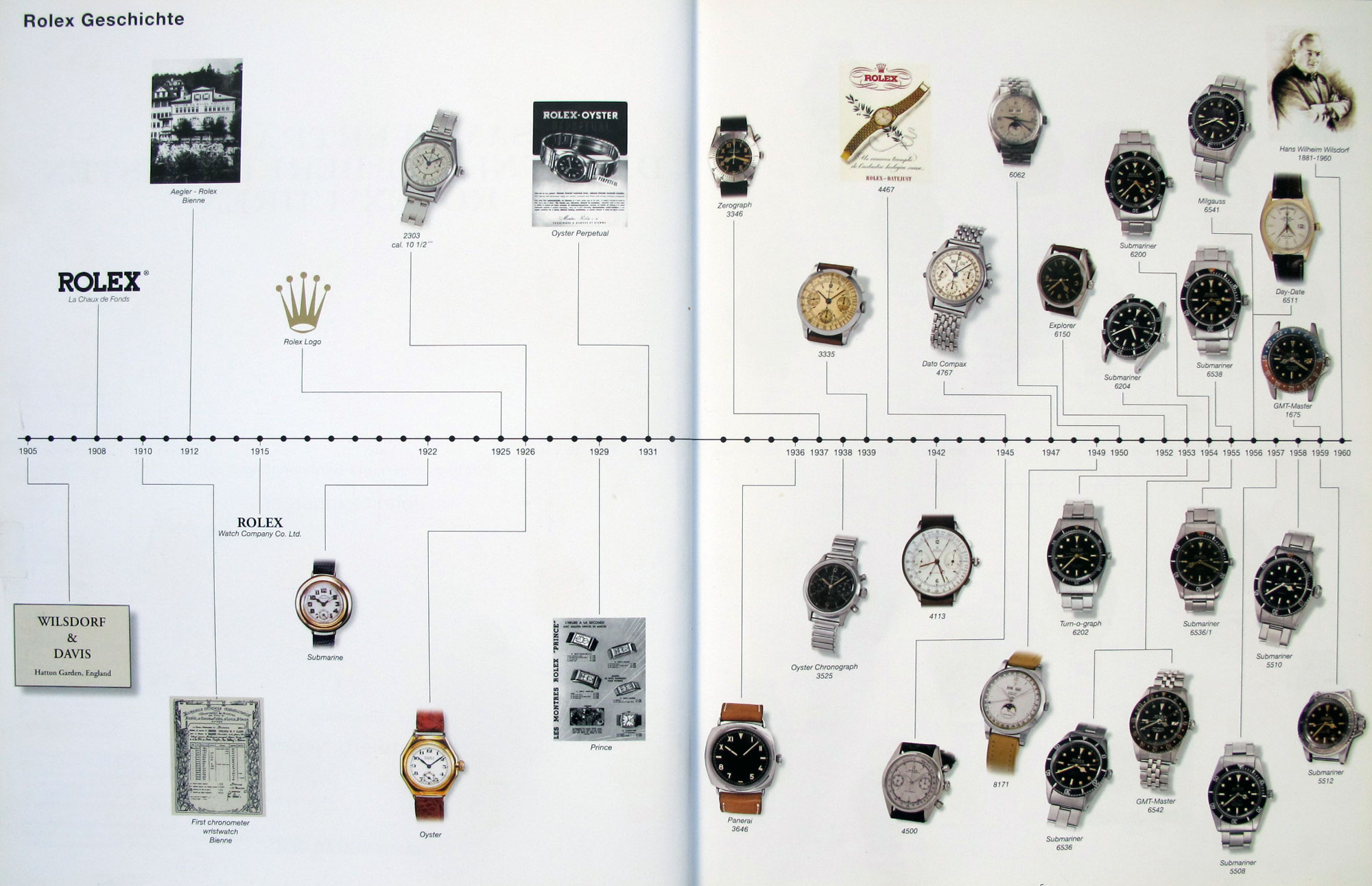
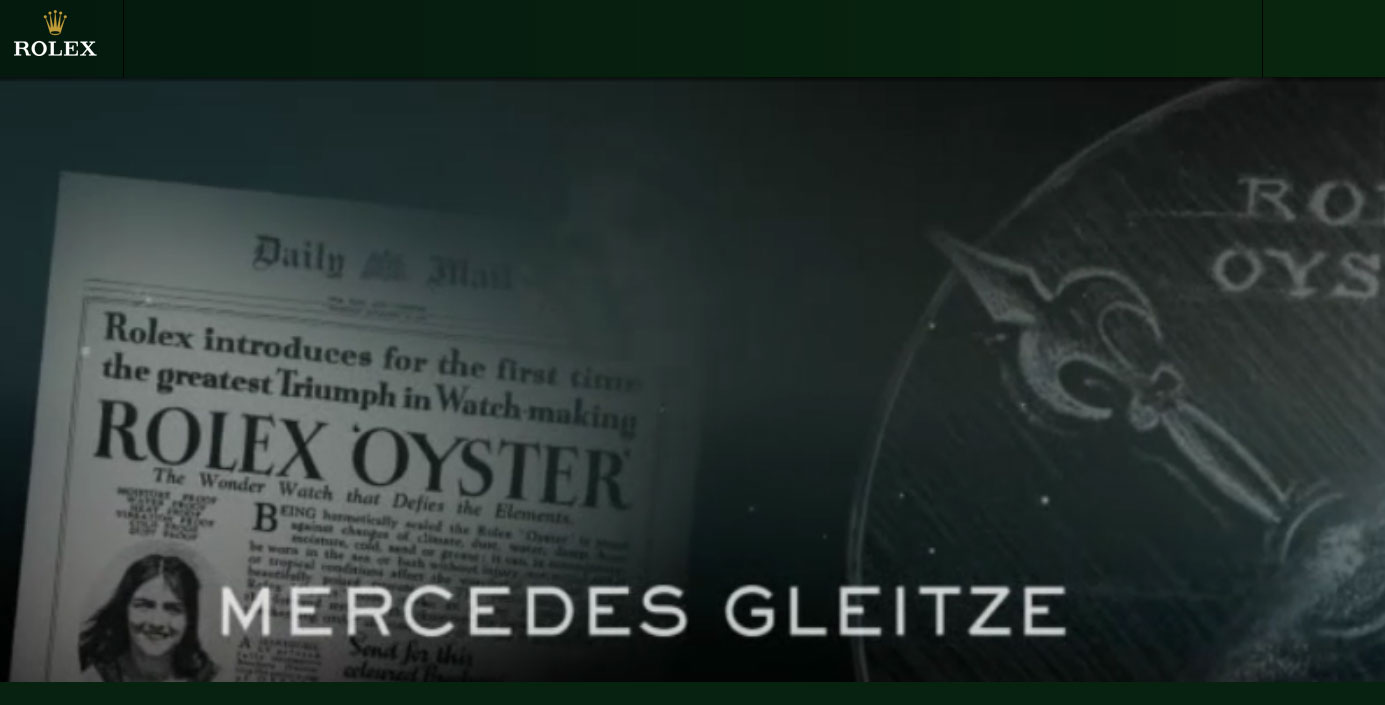
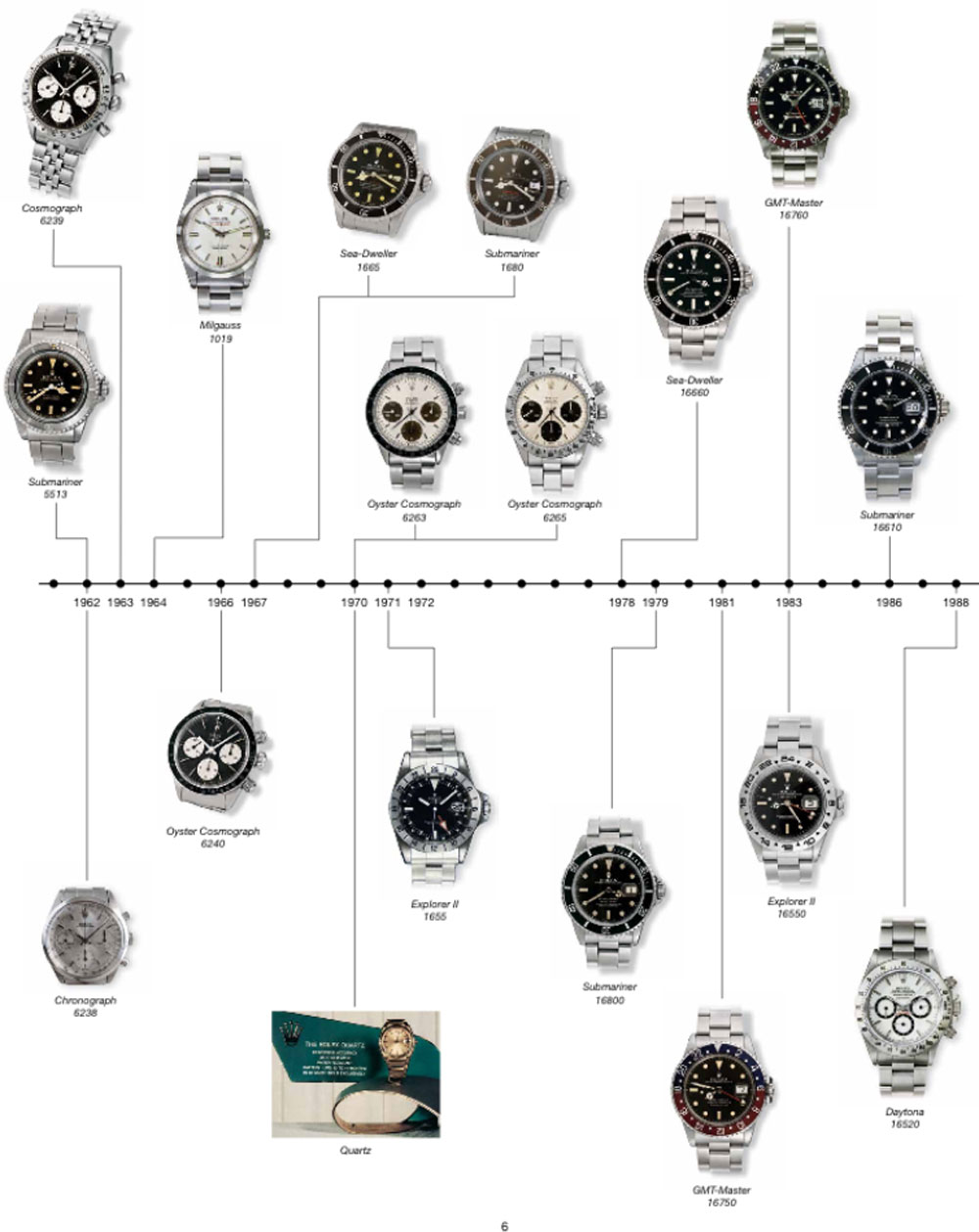
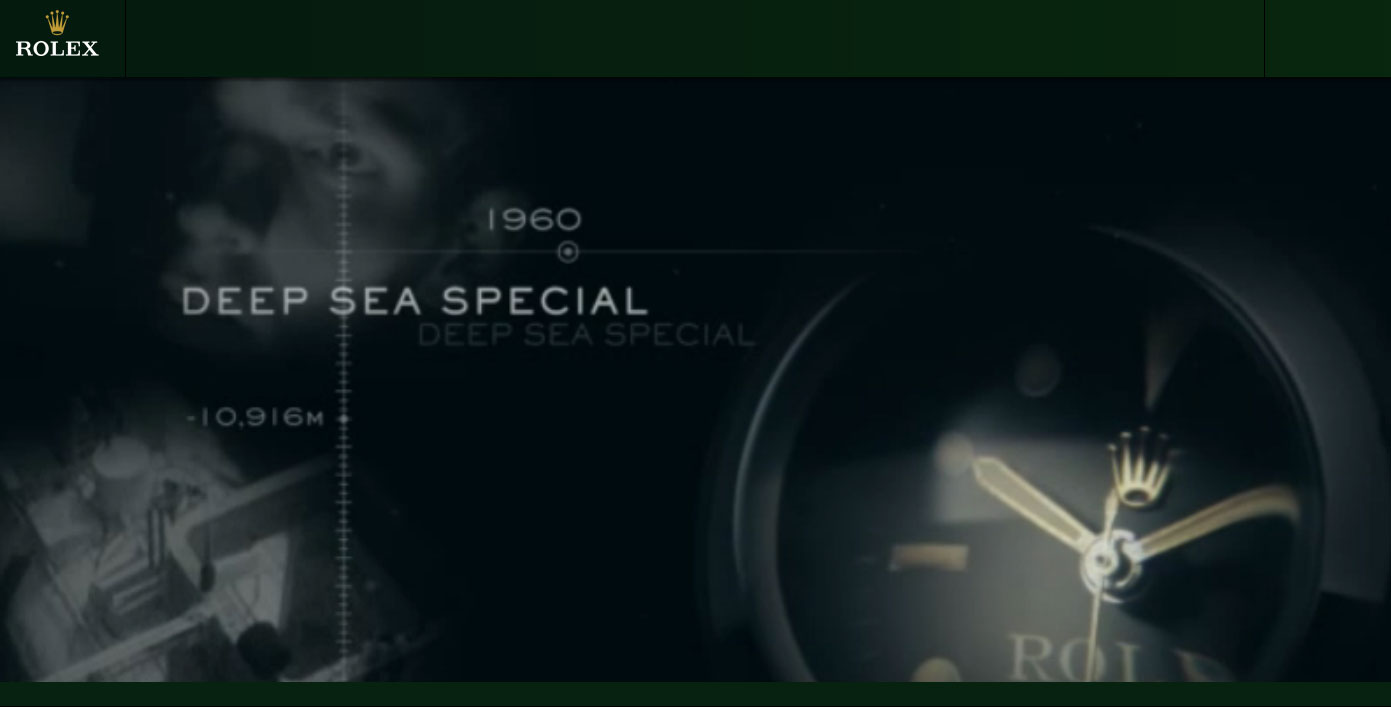
- See the trusted offers on RPM with some 500 vintage Rolex for sale, check them out to get an idea where important vintage Rolex dealers focus on….
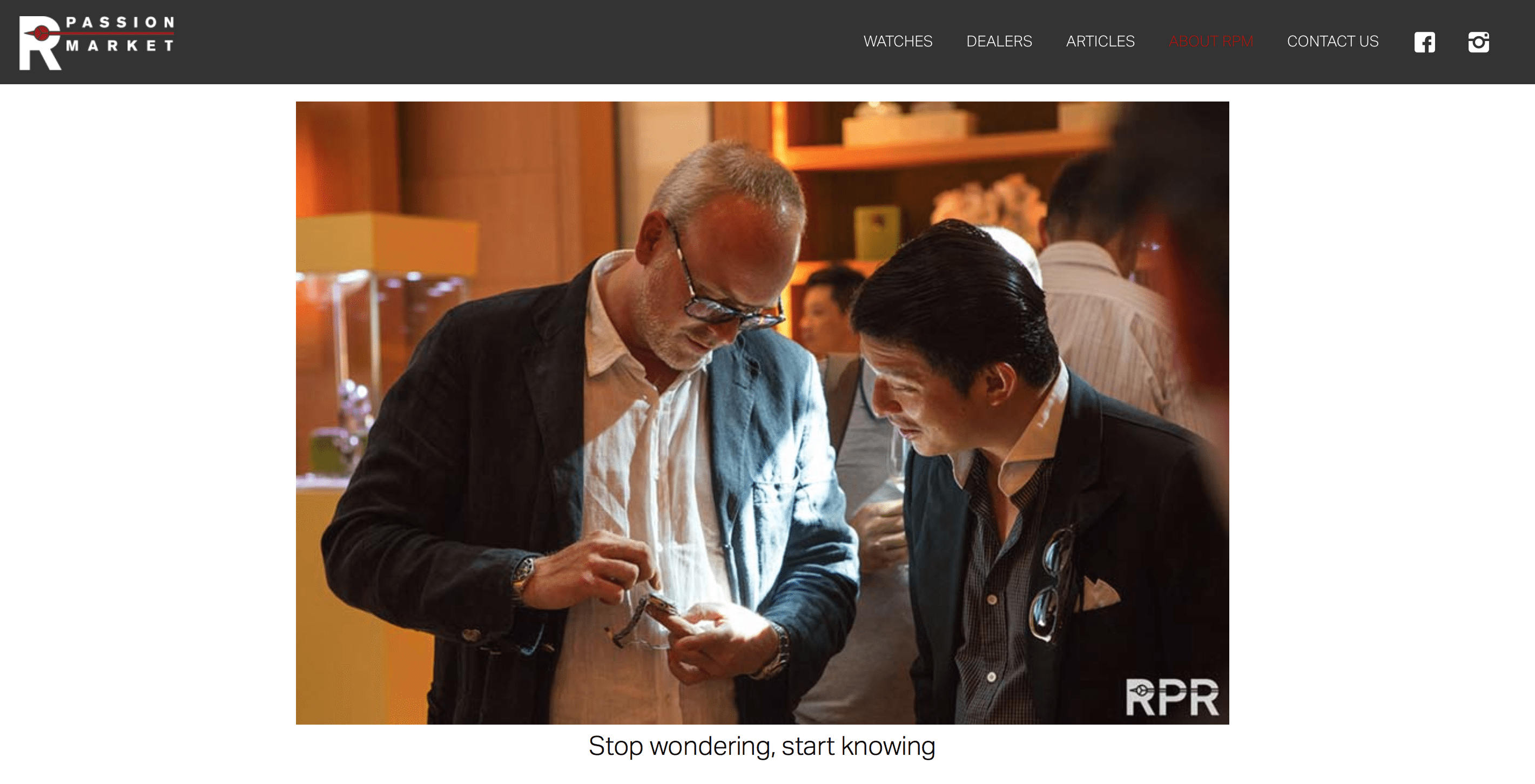 I do hope you enjoyed reading this report and the information was useful for you. If you have any questions about your vintage Rolex, feel free to use the CONTACT button on top of this page or follow this link to send me your questions. Every day I get many requests coming in, which I do my best sending you a respond as quick as possible. If I might have forgotten or overlooked your messages, please resend it so I can make sure you’ll get your answer!
I do hope you enjoyed reading this report and the information was useful for you. If you have any questions about your vintage Rolex, feel free to use the CONTACT button on top of this page or follow this link to send me your questions. Every day I get many requests coming in, which I do my best sending you a respond as quick as possible. If I might have forgotten or overlooked your messages, please resend it so I can make sure you’ll get your answer!



